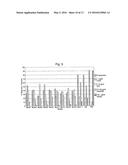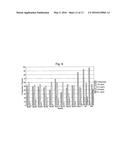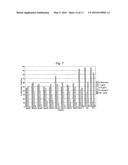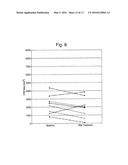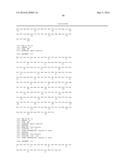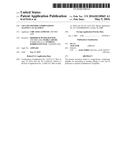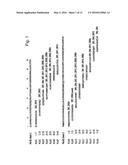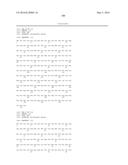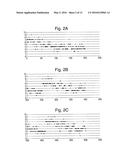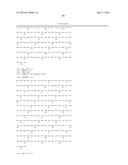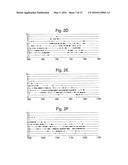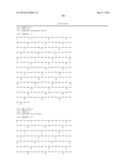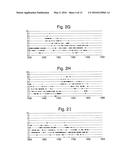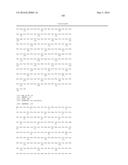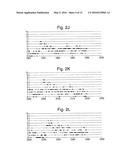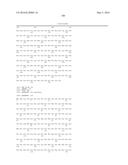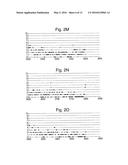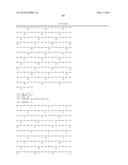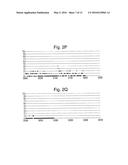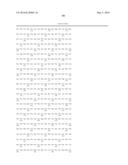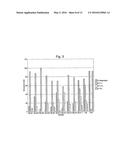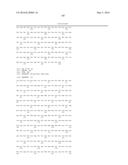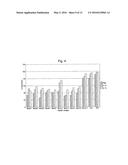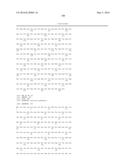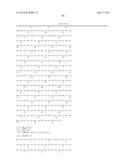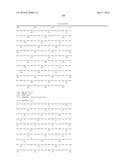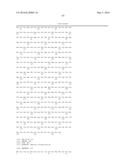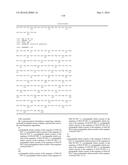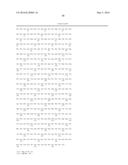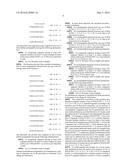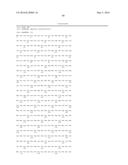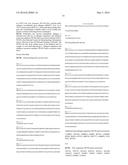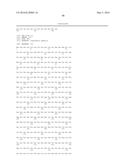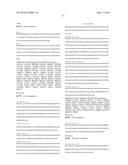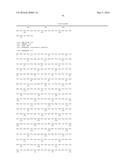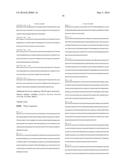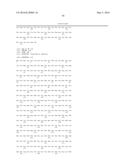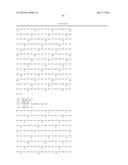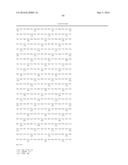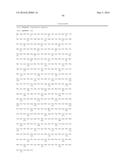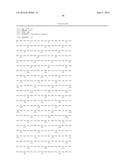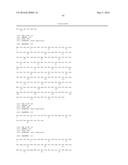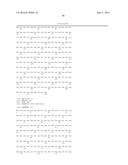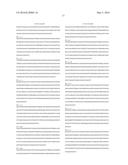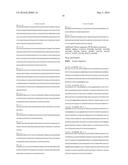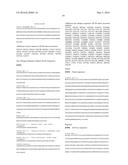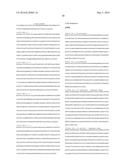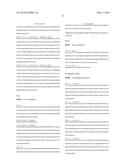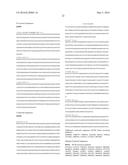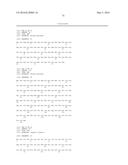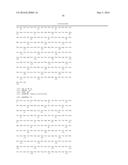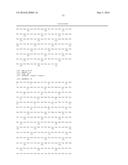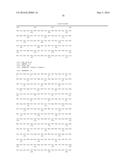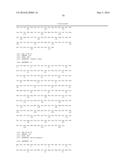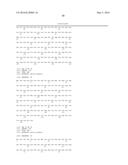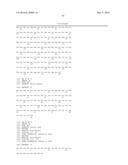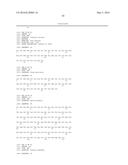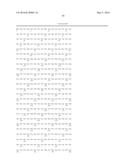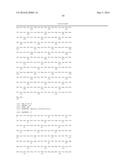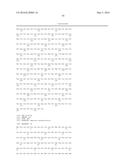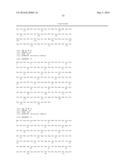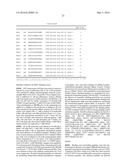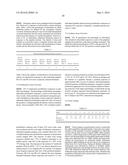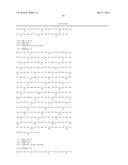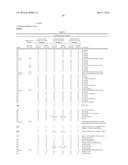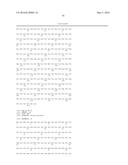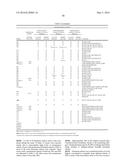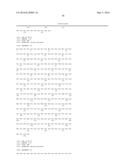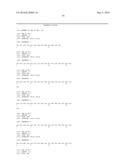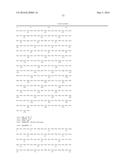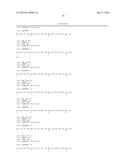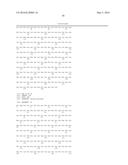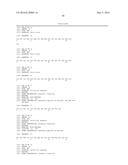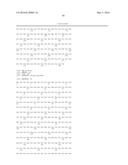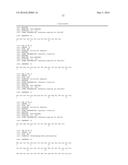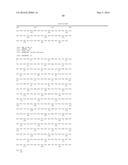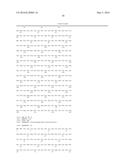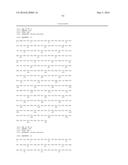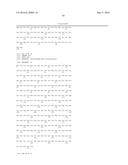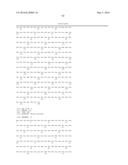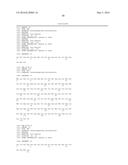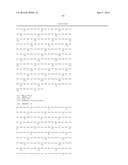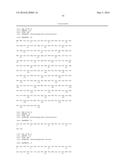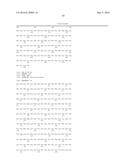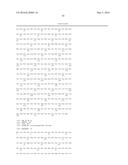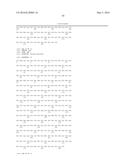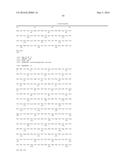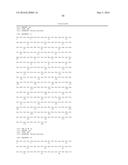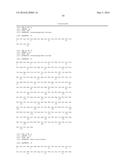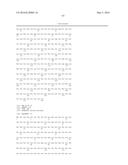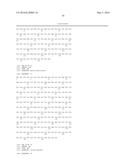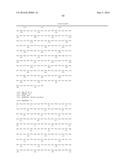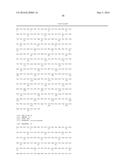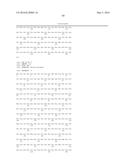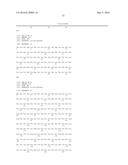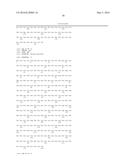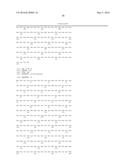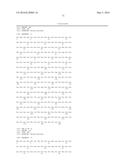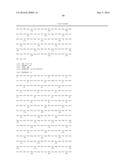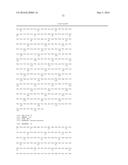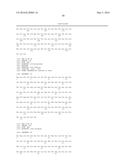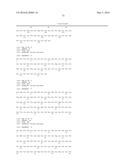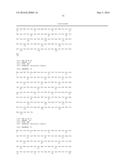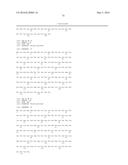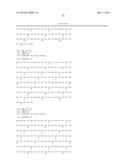Patent application title: VACCINE PEPTIDE COMBINATIONS AGAINST CAT ALLERGY
Inventors:
Roderick Peter Hafner (Oxford, GB)
Roderick Peter Hafner (Oxford, GB)
Mark Larche (Hamilton, CA)
Mark Larche (Hamilton, CA)
Anthony Barrington Kay (London, GB)
IPC8 Class: AA61K3900FI
USPC Class:
4241851
Class name: Drug, bio-affecting and body treating compositions antigen, epitope, or other immunospecific immunoeffector (e.g., immunospecific vaccine, immunospecific stimulator of cell-mediated immunity, immunospecific tolerogen, immunospecific immunosuppressor, etc.) amino acid sequence disclosed in whole or in part; or conjugate, complex, or fusion protein or fusion polypeptide including the same
Publication date: 2016-05-05
Patent application number: 20160120965
Abstract:
The present invention relates to compositions comprising peptides for
preventing or treating allergy to cats, and in particular to optimal
combinations of peptidesClaims:
1-23. (canceled)
24. A pharmaceutical formulation comprising a pharmaceutically acceptable carrier or diluent, a preservative, and, as the only therapeutic ingredients: (I) a polypeptide which consists of the sequence of SEQ ID NO: 1, a polypeptide which consists of the sequence of SEQ ID NO: 2, a polypeptide which consists of the sequence of SEQ ID NO: 3, a polypeptide which consists of the sequence of SEQ ID NO: 4, a polypeptide which consists of the sequence of SEQ ID NO: 5, a polypeptide which consists of the sequence of SEQ ID NO: 6 and a polypeptide which consists of the sequence of SEQ ID NO: 7 or (II) a polypeptide which consists of the sequence of SEQ ID NO: 8, a polypeptide which consists of the sequence of SEQ ID NO: 2, a polypeptide which consists of the sequence of SEQ ID NO: 3, a polypeptide which consists of the sequence of SEQ ID NO: 4, a polypeptide which consists of the sequence of SEQ ID NO: 10, a polypeptide which consists of the sequence of SEQ ID NO: 6 and a polypeptide which consists of the sequence of SEQ ID NO: 7; or (III) a polypeptide which consists of the sequence of SEQ ID NO: 2, a polypeptide which consists of the sequence of SEQ ID NO: 3, a polypeptide which consists of the sequence of SEQ ID NO: 4, a polypeptide which consists of the sequence of SEQ ID NO: 5, a polypeptide which consists of the sequence of SEQ ID NO: 6, a polypeptide which consists of the sequence of SEQ ID NO: 7 and a polypeptide which consists of the sequence of SEQ ID NO: 11; or (IV) a polypeptide which consists of the sequence of SEQ ID NO: 2, a polypeptide which consists of the sequence of SEQ ID NO: 3, a polypeptide which consists of the sequence of SEQ ID NO: 4, a polypeptide which consists of the sequence of SEQ ID NO: 5, a polypeptide which consists of the sequence of SEQ ID NO: 6, a polypeptide which consists of the sequence of SEQ ID NO: 7 and a polypeptide which consists of the sequence of SEQ ID NO: 12; or (V) a polypeptide which consists of the sequence of SEQ ID NO: 8, a polypeptide which consists of the sequence of SEQ ID NO: 2, a polypeptide which consists of the sequence of SEQ ID NO: 3, a polypeptide which consists of the sequence of SEQ ID NO: 4, a polypeptide which consists of the sequence of SEQ ID NO: 6 and a polypeptide which consists of the sequence of SEQ ID NO: 7; or (VI) a polypeptide which consists of the sequence of SEQ ID NO: 8, a polypeptide which consists of the sequence of SEQ ID NO: 2, a polypeptide which consists of the sequence of SEQ ID NO: 3, a polypeptide which consists of the sequence of SEQ ID NO: 4, a polypeptide which consists of the sequence of SEQ ID NO: 6, a polypeptide which consists of the sequence of SEQ ID NO: 7 and a polypeptide which consists of the sequence of SEQ ID NO: 1; (VII) a polypeptide which consists of the sequence of SEQ ID NO: 8, a polypeptide which consists of the sequence of SEQ ID NO: 2, a polypeptide which consists of the sequence of SEQ ID NO: 3, a polypeptide which consists of the sequence of SEQ ID NO: 4, a polypeptide which consists of the sequence of SEQ ID NO: 6, polypeptide which consists of the sequence of SEQ ID NO: 7 and a polypeptide which consists of the sequence of SEQ ID NO: 5; or (VIII) a polypeptide which consists of the sequence of SEQ ID NO: 8, a polypeptide which consists of the sequence of SEQ ID NO: 2, a polypeptide which consists of the sequence of SEQ ID NO: 3, a polypeptide which consists of the sequence of SEQ ID NO: 4, a polypeptide which consists of the sequence of SEQ ID NO: 6, a polypeptide which consists of the sequence of SEQ ID NO: 7 and a polypeptide which consists of the sequence of SEQ ID NO: 9; (IX) a polypeptide which consists of the sequence of SEQ ID NO: 8, a polypeptide which consists of the sequence of SEQ ID NO: 2, a polypeptide which consists of the sequence of SEQ ID NO: 3, a polypeptide which consists of the sequence of SEQ ID NO: 4, a polypeptide which consists of the sequence of SEQ ID NO: 6, a polypeptide which consists of the sequence of SEQ ID NO: 7 and a polypeptide which consists of the sequence of SEQ ID NO: 11; or (X) a polypeptide which consists of the sequence of SEQ ID NO: 8, a polypeptide which consists of the sequence of SEQ ID NO: 2, a polypeptide which consists of the sequence of SEQ ID NO: 3, a polypeptide which consists of the sequence of SEQ ID NO: 4, a polypeptide which consists of the sequence of SEQ ID NO: 6, a polypeptide which consists of the sequence of SEQ ID NO: 7 and a polypeptide which consists of the sequence of SEQ ID NO: 12; wherein: any polypeptide in each of (I) to (X) may be replaced by a variant or fragment of the replaced polypeptide, provided that at least four said polypeptides are not so replaced, wherein (i) a variant of a said polypeptide is up to 30 amino acids in length and comprises the sequence of the said polypeptide; or (ii) a variant of a said polypeptide is up to 30 amino acids in length and comprises or consists of the sequence of said polypeptide in which one, two, three or four amino acid substitutions have been made; and (iii) a fragment of a said polypeptide is at least 9 amino acids in length and comprises the sequence of the said polypeptide in which 1, 2 or 3 amino acids are deleted from the N and/or C terminal ends of the said sequence.
25. The formulation according to claim 24 in which any polypeptide in each of (I) to (X) may be replaced by a variant or fragment of the replaced polypeptide, provided that at least five or six said polypeptides are not so replaced.
26. The formulation according to claim 24 in which any polypeptide in each of (I) to (X) may be replaced by a variant or fragment of the replaced polypeptide, provided that the polypeptides of SEQ ID NOS: 2, 3, 4, 6 and 7 are not so replaced.
27. The formulation according to claim 24 in which no polypeptide is replaced by a variant or fragment.
28. The formulation according to claim 24 which comprises no further polypeptides.
29. The formulation according to claim 24 which is provided as an injectable solution, suspension or emulsion.
30. The formulation according to claim 24, wherein each polypeptide has a concentration in the range of 0.03 to 200 nmol/ml, 0.3 to 200 nmol/ml or 10 to 50 nmol/ml.
31. The formulation according to claim 24 which is provided in dry form for reconstitution.
32. A method of preparing a pharmaceutical formulation as defined in claim 24, comprising combining said polypeptides, variants or fragments with a pharmaceutically acceptable carrier or diluent.
33. A method according to claim 32 for preparing a composition for parenteral administration comprising providing said polypeptides, variants or fragments in dry form and reconstituting said polypeptides, variants or fragments with a said pharmaceutically acceptable carrier or diluent.
Description:
FIELD OF THE INVENTION
[0001] The present invention relates to compositions comprising peptides for preventing or treating allergy to cats, and in particular to optimal combinations of peptides
BACKGROUND OF THE INVENTION
[0002] T-cell antigen recognition requires antigen presenting cells (APCs) to present antigen fragments (peptides) on their cell surface in association with molecules of the major histocompatibility complex (MHC). T cells use their antigen specific T-cell receptors (TCRs) to recognise the antigen fragments presented by the APC. Such recognition acts as a trigger to the immune system to generate a range of responses to eradicate the antigen which has been recognised.
[0003] Recognition of external antigens by the immune system of an organism, such as man, can in some cases result in diseases, known as atopic conditions. Examples of the latter are the allergic diseases including asthma, atopic dermatitis and allergic rhinitis. In this group of diseases, B lymphocytes generate antibodies of the IgE class (in humans) which bind externally derived antigens, which are referred to in this context as allergens since these molecules elicit an allergic response. Production of allergen-specific IgE is dependent upon T lymphocytes which are also activated by (are specific for) the allergen. Allergen-specific IgE antibodies bind to the surface of cells such as basophils and mast cells by virtue of the expression by these cells of surface receptors for IgE.
[0004] Crosslinking of surface bound IgE molecules by allergen results in degranulation of these effector cells causing release of inflammatory mediators such as histamine, 5-hydroxtryptamine and lipid mediators such as the sulphidoleukotrienes. In addition to IgE-dependent events, certain allergic diseases such as asthma are characterised by IgE-independent events.
[0005] Allergic IgE-mediated diseases are currently treated with agents which provide symptomatic relief or prevention. Examples of such agents are anti-histamines, β2 agonists, and glucocorticosteroids. In addition, some IgE-mediated diseases are treated by desensitisation procedures that involve the periodic injection of allergen components or extracts. Desensitisation treatments may induce an IgG response that competes with IgE for allergen, or they may induce specific suppressor T cells that block the synthesis of IgE directed against allergen. This form of treatment is not always effective and poses the risk of provoking serious side effects, particularly general anaphylactic shock. This can be fatal unless recognised immediately and treated with adrenaline. A therapeutic treatment that would decrease or eliminate the unwanted allergic-immune response to a particular allergen, without altering the immune reactivity to other foreign antigens or triggering an allergic response itself would be of great benefit to allergic individuals.
[0006] Approximately 10% of the worlds human population are allergic to cats (Felis domesticus) and up to 67% of asthmatic patients are sensitive to cat allergens. The major allergen produced by cats is the glycoprotein Fel d1, which elicits a response in 90-95% of patients suffering from cat allergy. A therapeutic or preventative treatment would therefore be of great benefit to humans that suffer or are at risk of suffering from cat allergy.
SUMMARY OF THE INVENTION
[0007] The present inventors have discovered that certain combinations of peptide fragments of the Fel d1 protein are particularly useful in desensitising individuals to Fel d1 allergen. The polypeptide combinations of the invention have been selected for their ability to bind to many MHC Class II molecules, and cause T cell proliferation with minimal histamine release. The compositions, products, vectors and formulations of the invention may therefore be provided to individuals for preventing or treating allergy to cats by tolerisation.
[0008] The polypeptides of the invention were initially selected as potential T cell epitopes through use of peptide-MHC binding assays. See for example FIG. 1 which demonstrates the ability of a range of peptides derived from Fel d1 chains 1 and 2 to bind to multiple DR types in MHC class II binding assays These candidate polypeptides were then further screened for potential use in tolerisation.
[0009] A difficulty associated with approaches to desensitisation based on peptide immunisation lies in how to select an appropriate size and region of the allergen as the basis for the peptide to be used for immunisation. The size of the peptide of choice is crucial. If the peptide is too small, the vaccine would not be effective in inducing an immunological response. If the peptides are too large, or if the whole antigen is introduced into an individual, there is the risk of inducing adverse reactions, such as anaphylaxis, which may be fatal.
[0010] The polypeptides of the invention have been selected to retain T cell specificity whilst being small enough in size to not possess significant tertiary structure that would enable them to retain the conformation of an IgE-binding epitope of the whole molecule. The polypeptides of the invention therefore do not induce significant crosslinking of adjacent specific IgE molecules on cells such as mast cells and basophils and consequently do not cause significant histamine release.
[0011] The peptides of the invention are advantageous in that upon administration to a sample of T cells they result in T cell proliferation whilst causing minimal histamine release. This is demonstrated in Example 2. The polypeptides of the inventions are capable of inducing a late phase response in a cat allergic individual. The composition, products and formulations of the invention comprising these polypeptides or polynucleotides that are capable of expressing these polypeptides are therefore useful and effective in reducing hypersensitivity to Fel d1 allergen in individuals that are sensitised to this allergen.
[0012] A further advantage of the invention is the ability of the combinations of peptides to broadly target Major Histocompatibility Complex (MHC) molecules. T cell receptors (TCRs) are highly variable in their specificity. Variability is generated, as with antibody molecules, through gene recombination events within the cell. TCRs recognise antigen in the form of short peptides bound to molecules encoded by the genes of the Major Histocompatibility Complex (MHC). These gene products are the same molecules that give rise to "tissue types" used in transplantation and are also referred tows Human Leukocyte Antigen molecules (HLAs) which terms may be used interchangeably. Individual MHC molecules possess peptide binding grooves which, due to their shape and charge are only capable of binding a limited group of peptides. The peptides bound by one MHC molecule may not necessarily be bound by other MHC molecules.
[0013] When a protein molecule such as an antigen or allergen is taken up by antigen presenting cells such as B lymphocytes, dendritic cells, monocytes and macrophages, the molecule is enzymatically degraded within the cell. The process of degradation gives rise to peptide fragments of the molecule which, if they are of the appropriate size, charge and shape, may then bind within the peptide binding groove of certain MHC molecules and be subsequently displayed upon the surface of antigen presenting cells. If the peptide/MHC complexes are present upon the antigen presenting cell surface in sufficient numbers they may then activate T cells which bear the appropriate peptide/MHC-specific T cell receptors.
[0014] Due to the polymorphic nature of the MHC, individuals in an outbred population such as man will express different combinations of MHC molecules on their cell surfaces. Since different MHC molecules can bind different peptides from the same molecule based on the size, charge and shape of the peptide, different individuals will display a different repertoire of peptides bound to their MHC molecules. Identification of universal MHC-binding peptide epitopes in an outbred population such as man is more difficult than in inbred animals (such as certain strains of laboratory mice). On the basis of differential MHC expression between individuals and the inherent differences in peptide binding and presentation which this brings, it is unlikely that a single peptide can be identified which will be of use for desensitisation therapy in man.
[0015] The peptide combination of the invention, however, provides a broad coverage of efficacy over the human population by targeting the majority of the population's MHC. It would not, for example, be necessary to type the patient or individual to determine which MHC Class II molecules he or she possesses in order to determine what peptide or combination of peptides would be effective. A vaccine formulated with the peptides of the invention would therefore have broad utility.
[0016] The inventors' work has produced peptide combinations with the following characteristics:
[0017] the combination binds to many different MHC Class II molecules (see FIG. 2 which shows the large number of combinations that do not bind to many different MHC molecules)
[0018] the combinations produce the same or less histamine release than the whole allergen and/or have a cytokine release profile equivalent to the whole allergen
[0019] the peptides of the combinations are soluble.
[0020] Accordingly, the present invention provides a composition for use in preventing or treating allergy to cats by tolerisation comprising:
[0021] a) four or more polypeptides selected from any of SEQ ID NO: 1, 2, 3, 4, 5, 6, 7, 8, 9, 10, 11 or 12, and optionally
[0022] b) one, two or three polypeptides having the following characteristics:
[0023] (i) comprising sequence having at least 65% sequence identity to at least 9 or more contiguous amino acids in any of SEQ ID NO: 1, 2, 3, 4, 5, 6, 7, 8, 9, 10, 11 or 12 not selected in a); and
[0024] (ii) 9 to 30 amino acids in length.
[0025] Preferably, the composition of the invention comprises either:
[0026] (i) at least two peptides which exhibit strong binding and at least one peptide which exhibits moderate binding to each member of a panel of HLA molecules; or
[0027] (ii) at least one peptide which exhibits strong binding and at least two peptides which exhibit moderate binding to each member of said panel of HLA molecules; wherein the panel of HLA molecules comprises at least seven different HLA molecules encoded by different alleles which have a cumulative frequency in an outbred human population of at least 80%; and/or
[0028] (iii) wherein the composition is capable of inducing histamine release in a sample from a cat allergic individual at a level which is no higher than 5% above the histamine release induced in a sample from the same individual by whole Fel d 1 allergen; and/or
[0029] (iv) wherein the composition induces a cytokine release profile in a PBMC sample from a cat allergic individual which is equivalent to the cytokine release profile in a sample from the same individual induced by whole Fel d 1 allergen.
[0030] Typically the outbred human population is Caucasian, and/or the panel of HLA molecules comprises at least HLA-DR1, DR3, DR4, DR7, DR11, DR13 and DR15; and optionally also comprises HLA-DRB4 and DRB5.
DESCRIPTION OF THE DRAWINGS
[0031] FIG. 1--Peptides derived from Fel d1 chains 1 and 2 were tested for ability to bind to multiple DR types in MHC class II binding assays. Peptides that showed promiscuous binding characteristics were selected and combined to generate mixtures of peptides that bind to a broad population of MHC class II types.
[0032] FIGS. 2A-2Q--Graphical representations of peptide mixtures showing those which bind to a broad population of MHC class II types.
[0033] FIG. 3--Proliferation: percentage responders and quality of response. FIG. 3 summarises proliferative responses to peptides and antigens. The percentage of individuals mounting a detectable proliferative response is shown in the black bars. Grey (weak), white (moderate) and hashed (strong) bars provide a breakdown of the quality of these responses. Quality is arbitrarily defined by Stimulation Index (SI: ratio of counts in the presence of antigen/peptide divided by counts in medium alone). Thus for peptide 1 (MLA01), 12% of subjects made a proliferative response and of these 92% were weak, none were moderate and 8% were high. Proliferative responses to individual peptides/antigens were variable (black bar). 92% of subjects had positive proliferative responses to the positive control antigen PPD. The majority of these were strong responses (hashed bar). 75% of subjects responded to cat dander extract, with 59% of the responses (i.e. 59% of the 75%) being weak. The response to the mixture of 7 preferred peptides (SEQ ID NOS: 1 TO 7) was almost identical to cat dander extract (CAT).
[0034] FIG. 4--Percentage of responders by cytokine. FIG. 4 summarises the percentage of individuals who mounted a detectable response to each of the peptides/antigens by production of the three cytokines measured. The positive control antigen PPD elicited a cytokine production in almost all individuals (IFN-γ: 91%, IL-13: 97% and IL-10: 96%). Whole cat allergen and the mixture of 7 peptides elicited a cytokine response in approximately 80% or more of subjects. Individual peptides elicited responses of differing frequency. In general cytokine production appeared to be a more sensitive method of detecting responses with larger percentages of individuals giving positive cytokine responses than proliferative responses. In most cases, IL-10 secretion was detected in the largest number of subjects and IFN-γ detected least frequently.
[0035] FIG. 5--Percentage of individuals producing IFN-γ and strength of response following cell culture with peptide/antigen. IFN-γ responses were detected in 26-44% of subjects in response to individual peptides. These responses were predominantly very low to low to moderate. Complex antigens induced more frequent responses (peptide mixture 80%, cat dander 79%, PPD 91%). These responses were low to moderate to high. PPD responses were particularly high (89 of PPD responses were above 100 pg/ml).
[0036] FIG. 6--Percentage of individuals producing IL-13 and strength of response following cell culture with peptide/antigen. IL-13 responses were detected in between 33-68% of subjects in response to individual peptides. These responses were predominantly very low to low, although a significant number of moderate responses were detected. This may reflect the Th2 nature of allergic sensitisation in these subjects. Complex antigens induced more frequent responses (peptide mixture 85%, cat dander 93%, PPD 97%). These responses were low to moderate to high.
[0037] FIG. 7--Percentage of individuals producing IL-10 and strength of response following cell culture with peptide/antigen. IL-10 responses were detected in between 46-75% of subjects in response to individual peptides. These responses were predominantly very low to low. Complex antigens induced more frequent responses (peptide mixture 93%, cat dander 96%, PPD 96%). These responses were low to moderate. Very few "high" IL-10 responses were observed.
[0038] FIG. 8--A representative plot showing the average LPSR area before and after treatment for all eight patients in the 12.0 nmol cohort of the clinical trial of a preferred mixture of peptides of the invention.
DESCRIPTION OF THE SEQUENCES MENTIONED HEREIN
[0039] SEQ ID NO: 1 to 16 provide the polypeptide sequences of the invention. SEQ ID NOS: 1 to 16 correspond to peptides MLA01, MLA03, MLA04, MLA05, MLA07, MLA12, MLA14, MLA02, MLA06, MLA11, MLA15, MLA16, MLA08, MLA09, MLA10 and MLA13 respectively as shown in the Examples and FIG. 1.
DETAILED DESCRIPTION OF THE INVENTION
[0040] The invention provides a composition for use in preventing or treating allergy to cats by tolerisation comprising:
[0041] a) four or more polypeptides selected from any of SEQ ID NO: 1, 2, 3, 4, 5, 6, 7, 8, 9, 10, 11 or 12, and optionally
[0042] b) one, two or three polypeptides having the following characteristics:
[0043] (i) comprising sequence having at least 65% sequence identity to at least 9 contiguous amino acids in any of SEQ ID NO: 1, 2, 3, 4, 5, 6, 7, 8, 9, 10, 11 or 12 not selected in a); and
[0044] (ii) 9 to 30 amino acids in length.
[0045] The invention also provides products and formulations comprising the polypeptides of the invention and compositions, products and vectors comprising polynucleotides capable of expressing the polypeptides of the invention for use in preventing or treating cat allergy by tolerisation.
Peptide Fragments of Fel d1 Protein
[0046] The major allergen produced by the domestic cat Felis catus (Felis domesticus) is the glycoprotein Fel d1. This 39 kDa protein is formed from two 17 kDa subunits, each consisting of two disulphide-linked peptides (Fel d1 Chain 1 and Chain 2). The amino acid sequence of Fel d1 is disclosed in WO 91/06571. The major source of the Fel d1 protein is the sebaceous glands, although expression is also detected in salivary glands and the anal glands. The function of the Fel d1 protein is currently unknown, although it is possibly a pheromone binding protein.
[0047] The peptides of the invention are derived from Fel d1. The terms "peptide" and "polypeptide" are used interchangeably herein. Fel d1 is also referred to herein as "the allergen".
[0048] The composition of the invention comprises four or more polypeptides selected from any of SEQ ID NO: 1, 2, 3, 4, 5, 6, 7, 8, 9, 10, 11 or 12. Optionally, the composition may comprise one, two or three further polypeptides. These further polypeptides relate to (i.e. are typically homologues and/or fragments of) the other sequences, i.e. SEQ ID NO 1, 2, 3, 4, 5, 6, 7, 8, 9, 10, 11 or 12, that are not amongst the four or more polypeptides already selected. The one, two or three further polypeptides may be identical to any of SEQ ID NO: 1, 2, 3, 4, 5, 6, 7, 8, 9, 10, 11 or 12. The composition may therefore comprise four, five, six or seven different polypeptides as provided in any of SEQ ID NO: 1, 2, 3, 4, 5, 6, 7, 8, 9, 10, 11 or 12. However, the optional one, two or three further polypeptides do not need to be 100% identical to any of SEQ ID NO: 1, 2, 3, 4, 5, 6, 7, 8, 9, 10, 11 or 12. They are preferably at least 65% identical to at least 9 or more contiguous amino acids in any of SEQ ID NO 1, 2, 3, 4, 5, 6, 7, 8, 9, 10, 11 or 12, not already selected for the four or more polypeptides.
[0049] In other words, the invention provides a composition for use in the prevention or treatment of cat allergy by tolerisation comprising a) four or more polypeptides selected from any one of the following amino acid sequences:
TABLE-US-00001 (SEQ ID NO: 1) CPAVKRDVDLFLT; (SEQ ID NO: 2) EQVAQYKALPVVLENA; (SEQ ID NO: 3) KALPVVLENARILKNCV; (SEQ ID NO: 4) RILKNCVDAKMTEEDKE; (SEQ ID NO: 5) KENALSLLDKIYTSPL; (SEQ ID NO: 6) TAMKKIQDCYVENGLI; (SEQ ID NO: 7) SRVLDGLVMTTISSSK; (SEQ ID NO: 8) LFLTGTPDEYVEQVAQY; (SEQ ID NO: 9) KMTEEDKENALSLLDK; (SEQ ID NO: 10) LTKVNATEPERTAMKK; (SEQ ID NO: 11) ISSSKDCMGEAVQNTV; (SEQ ID NO: 12) AVQNTVEDLKLNTLGR
And optionally, the composition may comprise b) one, two or three further polypeptides having the following characteristics:
[0050] (i) comprising sequence having at least 65% sequence identity to at least 9 or more contiguous amino acids in any of SEQ ID NO: 1 to 12 above not selected in a); and
[0051] (ii) 9 to 30 amino acids in length.
[0052] The invention also provides a product containing a) four or more polypeptides selected from any one of the following amino acid sequences:
TABLE-US-00002 (SEQ ID NO: 1) CPAVKRDVDLFLT; (SEQ ID NO: 2) EQVAQYKALPVVLENA; (SEQ ID NO: 3) KALPVVLENARILKNCV; (SEQ ID NO: 4) RILKNCVDAKMTEEDKE; (SEQ ID NO: 5) KENALSLLDKIYTSPL; (SEQ ID NO: 6) TAMKKIQDCYVENGLI; (SEQ ID NO: 7) SRVLDGLVMTTISSSK; (SEQ ID NO: 8) LFLTGTPDEYVEQVAQY; (SEQ ID NO: 9) KMTEEDKENALSLLDK; (SEQ ID NO: 10) LTKVNATEPERTAMKK; (SEQ ID NO: 11) ISSSKDCMGEAVQNTV; (SEQ ID NO: 12) AVQNTVEDLKLNTLGR
and optionally, the product may comprise b) one or more further polypeptides having the following characteristics:
[0053] (i) comprising sequence having at least 65% sequence identity to at least 9 or more contiguous amino acids in any of SEQ ID NO: 1 to 12 above not selected in a); and
[0054] (ii) 9 to 30 amino acids in length, wherein each different polypeptide is for simultaneous, separate or sequential use in the prevention or treatment of cat allergy by tolerisation.
[0055] In more detail therefore, the invention provides a product containing:
[0056] (a) A polypeptide selected from any one of SEQ ID NO: 1, 2, 3, 4, 5, 6, 7, 8, 9, 10, 11 or 12;
[0057] (b) A polypeptide selected from any one of SEQ ID NO: 1, 2, 3, 4, 5, 6, 7, 8, 9, 10, 11 or 12, that is not selected in (a) above;
[0058] (c) A polypeptide selected from any one of SEQ ID NO: 1, 2, 3, 4, 5, 6, 7, 8, 9, 10, 11 or 12, that is not selected in (a) or (b) above;
[0059] (d) A polypeptide selected from any one of SEQ ID NO: 1, 2, 3, 4, 5, 6, 7, 8, 9, 10, 11 or 12, that is not selected in (a), (b) or (c) above; and optionally
[0060] (e) A polypeptide having the following characteristics:
[0061] (i) comprising sequence having at least 65% sequence identity to at least 9 or more contiguous amino acids in any of SEQ ID NO: 1 to 12 not selected in a), b), c) or d) above; and
[0062] (ii) 9 to 30 amino acids in length; and optionally
[0063] (f) A polypeptide fragment of Fel d1 protein having the following characteristics:
[0064] (i) comprising sequence having at least 65% sequence identity to at least 9 or more contiguous amino acids in any of SEQ ID NO: 1 to 12 not selected in a), b), c), d) or e) above; and
[0065] (ii) 9 to 30 amino acids in length; and optionally
[0066] (g) A polypeptide fragment of Fel d1 protein having the following characteristics:
[0067] (i) comprising sequence having at least 65% sequence identity to at least 9 or more contiguous amino acids in any of SEQ ID NO: 1 to 12 not selected in a), b), c), d), e) or f) above; and
[0068] (ii) 9 to 30 amino acids in length; for simultaneous, separate or sequential use in the prevention or treatment of cat allergy by tolerisation.
[0069] The composition or products of the invention may therefore comprise variants of any of SEQ ID NO: 1, 2, 3, 4, 5, 6, 7, 8, 9, 10, 11 or 12. Peptide fragments according to the invention may be derived by truncation, e.g. by removal of one or more amino acids from the N and/or C-terminal ends of a polypeptide. Fragments may also be generated by one or more internal deletions, provided that the core 9 amino acids that makes up the T cell epitope is not substantially disrupted.
[0070] For example, a variant of SEQ ID NO: 1 may comprise a fragment of SEQ ID NO: 1, i.e. a shorter sequence. This may include a deletion of one, two, three or four amino acids from the N-terminal end of SEQ ID NO: 1 or from the C-terminal end of SEQ ID NO: 1. Such deletions may be made from both ends of SEQ ID NO: 1. A variant of SEQ ID NO: 1 may include additional amino acids (for example from the cat Fel d1 protein sequence) extending beyond the end(s) of SEQ ID NO: 1. A variant may include a combination of the deletions and additions discussed above. For example, amino acids may be deleted from one end of SEQ ID NO: 1, but additional amino acids from the full length Fel d1 protein sequence may be added at the other end of SEQ ID NO: 1. The same discussion of variants above also applies to SEQ ID NO: 2, 3, 4, 5, 6, 7, 8, 9, 10, 11 and 12.
[0071] A variant peptide may include one or more amino acid substitutions from the amino acid sequence of any of SEQ ID NO: 1, 2, 3, 4, 5, 6, 7, 8, 9, 10, 11 or 12, or a fragment thereof. A variant peptide may comprise sequence having at least 65% sequence identity to at least 9 or more contiguous amino acids in any of SEQ ID NO: 1, 2, 3, 4, 5, 6, 7, 8, 9, 10, 11 or 12. More preferably a suitable variant may comprise at least 70%, at least 75%, at least 80%, at least 85%, at least 90%, at least 95%, or at least 98% amino acid identity to at least 9 contiguous amino acids of any of SEQ ID NO 1, 2, 3, 4, 5, 6, 7, 8, 9, 10, 11 or 12. This level of amino acid identity may be seen at any section of the peptide, although it is preferably the core region. The level of amino acid identity is over at least 9 contiguous amino acids but it may be at least 10, 11, 12, 13, 14, 15 or at least 16 or 17 amino acids, depending on the size of the peptides of comparison. Accordingly, any of the above-specified levels of identity may be across the entire length of sequence.
[0072] In connection with amino acid sequences, "sequence identity" refers to sequences which have the stated value when assessed using ClustalW (Thompson et al., 1994, supra) with the following parameters:
Pairwise alignment parameters--Method: accurate, Matrix: PAM, Gap open penalty: 10.00, Gap extension penalty: 0.10; Multiple alignment parameters--Matrix: PAM, Gap open penalty: 10.00, % identity for delay: 30, Penalize end gaps: on, Gap separation distance: 0, Negative matrix: no, Gap extension penalty: 0.20, Residue-specific gap penalties: on, Hydrophilic gap penalties: on, Hydrophilic residues: GPSNDQEKR. Sequence identity at a particular residue is intended to include identical residues which have simply been derivatized.
[0073] A variant peptide may comprise 1, 2, 3, 4, 5 or more, or up to 10 amino acid substitutions from any of SEQ ID NO: 1, 2, 3, 4, 5, 6, 7, 8, 9, 10, 11 or 12. Substitution variants preferably involve the replacement of one or more amino acids with the same number of amino acids and making conservative amino acid substitutions. For example, an amino acid may be substituted with an alternative amino acid having similar properties, for example, another basic amino acid, another acidic amino acid, another neutral amino acid, another charged amino acid, another hydrophilic amino acid, another hydrophobic amino acid, another polar amino acid, another aromatic amino acid or another aliphatic amino acid. Some properties of the 20 main amino acids which can be used to select suitable substituents are as follows:
TABLE-US-00003 Ala aliphatic, hydrophobic, neutral Met hydrophobic, neutral Cys polar, hydrophobic, neutral Asn polar, hydrophilic, Asp polar, hydrophilic, neutral charged (-) Pro hydrophobic, neutral Glu polar, hydrophilic, Gln polar, hydrophilic, charged (-) neutral Phe aromatic, hydrophobic, Arg polar, hydrophilic, neutral charged (+) Gly aliphatic, neutral Ser polar, hydrophilic, neutral His aromatic, polar, hydrophilic, Thr polar, hydrophilic, neutral charged (+) Val aliphatic, hydrophobic, Ile aliphatic, hydrophobic, neutral neutral Lys polar, hydrophilic, charged(+) Trp aromatic, hydrophobic, Leu aliphatic, hydrophobic, neutral neutral Tyr aromatic, polar, hydrophobic
[0074] Further variants include those in which instead of the naturally occurring amino acid the amino acid which appears in the sequence is a structural analog thereof. Amino acids used in the sequences may also be modified, e.g. labelled, providing the function of the peptide is not significantly adversely affected. Where the peptide has a sequence that varies from the sequence of any of SEQ ID NO: 1, 2, 3, 4, 5, 6, 7, 8, 9, 10, 11 or 12 or a fragment thereof, the substitutions may occur across the full length of the sequence, within the sequence of any of SEQ ID NO: 1, 2, 3, 4, 5, 6, 7, 8, 9, 10, 11 or 12, or outside the sequence of any of SEQ ID NO: 1, 2, 3, 4, 5, 6, 7, 8, 9, 10, 11 or 12. For example, the variations described herein, such as additions, deletions, substitutions and modifications, may occur within the sequence of any of SEQ ID NO: 1, 2, 3, 4, 5, 6, 7, 8, 9, 10, 11 or 12. A variant peptide may comprise or consist essentially of the amino acid sequence of any of SEQ ID NO: 1, 2, 3, 4, 5, 6, 7, 8, 9, 10, 11 or 12 in which one, two, three, four or more amino acid substitutions have been made. A variant peptide may comprise a fragment of Fel d1 that is larger than any of SEQ ID NO: 1, 2, 3, 4, 5, 6, 7, 8, 9, 10, 11 or 12. In this embodiment, the variations described herein, such as substitutions and modifications, may occur within and/or outside the sequence of any of SEQ ID NO: 1, 2, 3, 4, 5, 6, 7, 8, 9, 10, 11 or 12.
[0075] The variant peptides of the invention are 9 to 30 amino acids in length inclusive. Preferably, they may be from 9 to 20 or more preferably 13 to 17 amino acids in length. The peptides may be the same length as the peptide sequences in any one of SEQ ID NO: 1, 2, 3, 4, 5, 6, 7, 8, 9, 10, 11 or 12.
[0076] The peptides may be chemically derived from the polypeptide allergen, for example by proteolytic cleavage or can be derived in an intellectual sense from the polypeptide allergen, for example by making use of the amino acid sequence of the polypeptide allergen and synthesising peptides based on the sequence. Peptides may be synthesised using methods well known in the art.
[0077] The term "peptide" includes not only molecules in which amino acid residues are joined by peptide (--CO--NH--) linkages but also molecules in which the peptide bond is reversed. Such retro-inverso peptidomimetics may be made using methods known in the art, for example such as those described in Meziere et al (1997) J. Immunol. 159, 3230-3237. This approach involves making pseudopeptides containing changes involving the backbone, and not the orientation of side chains. Meziere et al (1997) show that, at least for MHC class II and T helper cell responses, these pseudopeptides are useful. Retro-inverse peptides, which contain NH--CO bonds instead of CO--NH peptide bonds, are much more resistant to proteolysis.
[0078] Similarly, the peptide bond may be dispensed with altogether provided that an appropriate linker moiety which retains the spacing between the carbon atoms of the amino acid residues is used; it is particularly preferred if the linker moiety has substantially the same charge distribution and substantially the same planarity as a peptide bond. It will also be appreciated that the peptide may conveniently be blocked at its N-or C-terminus so as to help reduce susceptibility to exoproteolytic digestion. For example, the N-terminal amino group of the peptides may be protected by reacting with a carboxylic acid and the C-terminal carboxyl group of the peptide may be protected by reacting with an amine. Other examples of modifications include glycosylation and phosphorylation. Another potential modification is that hydrogens on the side chain amines of R or K may be replaced with methylene groups (--NH2→--NH(Me) or --N(Me)2).
[0079] Analogues of peptides according to the invention may also include peptide variants that increase or decrease the peptide's half-life in vivo. Examples of analogues capable of increasing the half-life of peptides used according to the invention include peptoid analogues of the peptides, D-amino acid derivatives of the peptides, and peptide-peptoid hybrids. A further embodiment of the variant polypeptides used according to the invention comprises D-amino acid forms of the polypeptide. The preparation of polypeptides using D-amino acids rather than L-amino acids greatly decreases any unwanted breakdown of such an agent by normal metabolic processes, decreasing the amounts of agent which needs to be administered, along with the frequency of its administration.
[0080] The peptides provided by the present invention may be derived from splice variants of Fel d1 encoded by mRNA generated by alternative splicing of the primary transcripts encoding the Fel d1 chains. The peptides may also be derived from amino acid mutants, glycosylation variants and other covalent derivatives of Fel d1 which retain at least an MHC-binding property of the allergen. Exemplary derivatives include molecules wherein the peptides of the invention are covalently modified by substitution, chemical, enzymatic, or other appropriate means with a moiety other than a naturally occurring amino acid. Further included are naturally occurring variants of Fel d1 found in different cats. Such a variant may be encoded by an allelic variant or represent an alternative splicing variant.
[0081] Variants as described above may be prepared during synthesis of the peptide or by post-production modification, or when the peptide is in recombinant form using the known techniques of site-directed mutagenesis, random mutagenesis, or enzymatic cleavage and/or ligation of nucleic acids.
[0082] In accordance with the invention, the further one, two or three peptides that the composition may comprise are preferably functional variants of any of SEQ ID NO: 1, 2, 3, 4, 5, 6, 7, 8, 9, 10, 11 or 12. That is, the peptides are preferably capable of inducing an immune response. In particular, they are capable of inducing a late phase response in a cat allergic individual. This may be tested by the ability of the peptide to induce T cell proliferation in a sample of T cells. Methods of testing the induction of T cell proliferation are well known in the art and one such method is exemplified in Example 2. Preferably the one or more further peptides are capable of causing T cell proliferation in at least 20% of samples of T cells, wherein each sample is obtained from different cat allergic individuals in the population. The compositions of the invention are preferably capable of inducing T cell proliferation in 30% or more samples of T cells obtained from of a panel of cat allergic individuals. More preferably, the compositions are capable of inducing T cell proliferation in 35% or more, 40% or more, 45%, 50%, 55%, 60%, 65%, 70%, 75%, 80%, 85%, or 90% or more of samples obtained from sensitized individuals in a panel. The number of individuals in a panel of cat allergic individuals may be any number greater than one, for example at least 2, 3, 5, 10, 15, 20, 30, 50, 80, or at least 100 individuals. It is preferred if the peptides cause T cell proliferation, but do not lead to the release of histamine from enriched basophils or mast cell preparations from a sensitised individual. There may be some histamine release, but preferably the composition does not cause significantly more histamine release than a composition comprising the 7 different polypeptides shown in SEQ ID NO: 1 to 7.
[0083] Suitable variants capable of binding to TCRs may be derived empirically or selected according to known criteria. Within a single peptide there are certain residues which contribute to binding within the MHC antigen binding groove and other residues which interact with hypervariable regions of the T cell receptor (Allen et al (1987) Nature 327: 713-5).
[0084] Within the residues contributing to T cell receptor interaction, a hierarchy has been demonstrated which pertains to dependency of T cell activation upon substitution of a given peptide residue. Using peptides which have had one or more T cell receptor contact residues substituted with a different amino acid, several groups have demonstrated profound effects upon the process of T cell activation. Evavold & Allen (1991) Nature 252: 1308-10) demonstrated the dissociation of T cell proliferation and cytokine production. In this in vitro model, a T cell clone specific for residues 64-76 of haemoglobin (in the context of I-Ek), was challenged with a peptide analogue in which a conservative substitution of aspartic acid for glutamic acid had been made. This substitution did not significantly interfere with the capacity of the analogue to bind to I-Ek.
[0085] Following in vitro challenge of a T cell clone with this analogue, no proliferation was detected although IL-4 secretion was maintained, as was the capacity of the clone to help B cell responses. In a subsequent study the same group demonstrated the separation of T cell-mediated cytolysis from cytokine production. In this instance, the former remained unaltered while the latter was impaired. The efficacy of altered peptide ligands in vivo was initially demonstrated in a murine model of EAE (experimental allergic encephalomyelitis) by McDevitt and colleagues (Smilek et al (1991) Proc Natl Acad Sci USA 88: 9633-9637). In this model EAE is induced by immunisation with the encephalitogenic peptide Ac1-11 of MBP (myelin basic protein). Substitution at position four (lysine) with an alanine residue generated a peptide which bound well to its restricting element (AαuAβu), but which was non-immunogenic in the susceptible PL/JxSJLF1 strain and which, furthermore prevented the onset of EAE when administered either before or after immunisation with the encephalitogenic peptide. Thus, residues can be identified in peptides which affect the ability of the peptides to induce various functions of T-cells.
[0086] Advantageously, peptides may be designed to favour T-cell proliferation and induction of desensitisation. Metzler and Wraith have demonstrated improved tolerogenic capacity of peptides in which substitutions increasing peptide-MHC affinity have been made (Metzler & Wraith (1993) Int Immunol˜: 1159-65). That an altered peptide ligand can cause long-term and profound anergy in cloned T cells was demonstrated by Sloan-Lancaster et al (1993) Nature 363: 156-9.
[0087] The compositions of the invention are capable of inducing a late phase response in an individual that is sensitised to Fel d1 allergen. The term "late phase response" includes the meaning as set forth in Allergy and Allergic Diseases (1997) A. B. Kay (Ed.), Blackwell Science, pp 1113-1130. The late phase response may be any late phase response (LPR). Preferably, the peptides are capable of inducing a late asthmatic response (LAR) or a late rhinitic response, or a late phase skin response or a late phase ocular response. Whether or not a particular peptide can give rise to a LPR can be determined using methods well known in the art; a particularly preferred method is that described in Cromwell O, Durham S R, Shaw R J, Mackay J and Kay A B. Provocation tests and measurements of mediators from mast cells and basophils in asthma and allergic rhinitis. In: Handbook of Experimental Immunology (4) Chapter 127, Editor: Weir D M, Blackwell Scientific Publications, 1986.
[0088] Thus, preferably, the individual peptides of the invention are able to induce a LPR in an individual who has been sensitised to Fel d1 allergen. Whether or not an individual has been sensitised to the allergen may be determined by well known procedures such as skin prick testing with solutions of allergen extracts, induction of cutaneous LPRs, clinical history, allergen challenge and radioallergosorbent test (RAST) for measurement of allergen specific IgE. Whether or not a particular individual is expected to benefit from treatment may be determined by the physician based, for example, on such tests.
[0089] Desensitising or tolerising an individual to Fel d1 allergen means inhibition or dampening of allergic tissue reactions induced by Fel d1 in appropriately sensitised individuals. It has been shown that T cells can be selectively activated, and then rendered unresponsive. Moreover the anergising or elimination of these T-cells leads to desensitisation of the patient for a particular allergen. The desensitisation manifests itself as a reduction in response to an allergen or allergen-derived peptide, or preferably an elimination of such a response, on second and further administrations of the allergen or allergen-derived peptide. The second administration may be made after a suitable period of time has elapsed to allow desensitisation to occur; this is preferably any period between one day and several weeks. An interval of around two weeks is preferred.
[0090] Although the compositions of the invention are able to induce a LPR in a cat allergic individual, it should be appreciated that when a composition is used to treat a patient it is preferable that a sufficiently low concentration of the composition is used such that no observable LPR will occur but the response will be sufficient to partially desensitise the T cells such that the next (preferably higher) dose may be given, and so on. In this way the dose is built up to give full desensitisation but often without ever inducing a LPR in the patient. Although, the composition or peptide is able to do so at a higher concentration than is administered.
[0091] The compositions of the invention preferably are capable of inducing a late phase response in 50% or more of a panel of cat allergic individuals from the population. More preferably, the compositions are capable of inducing a LPR in 55% or more, 60% or more, 65% or more, 70% or more, 75% or more, 80% or more, 85% or more, or 90% or more of sensitized individuals in a panel. Whether or not the compositions are able to induce a LPR in a certain percentage of a panel of subjects can be determined by methods which are well known in the art.
Properties of Peptide Combinations
MHC Binding
[0092] Preferred combinations of peptides typically bind to a large number of different HLA molecules. This is advantageous in that a larger proportion of individuals in a population will be tolerised by the combination. Thus preferred combinations comprise either:
[0093] (iii) at least two peptides which exhibit strong binding and at least one peptide which exhibits moderate binding to each member of a panel of HLA molecules; or
[0094] (iv) at least one peptide which exhibits strong binding and at least two peptides which exhibit moderate binding to each member of said panel of HLA molecules; wherein the panel of HLA molecules comprises at least seven different HLA molecules encoded by different alleles which have a cumulative frequency in an outbred human population of at least 80%, or at least 85%, 90%, 95% or 99%.
[0095] Strength of MHC binding may be evaluated by any suitable method. Preferred methods include competitive inhibition assays wherein binding is measured relative to a reference peptide. The reference peptide is typically a peptide which is known to be a strong binder for a given MHC molecule. In such an assay, a peptide is a weak binder for a given HLA molecule if it has an IC50 more than 100 fold lower than the reference peptide for the given HLA molecule. A peptide is a moderate binder is it has an IC50 more than 20 fold lower but less than a 100 fold lower than the reference peptide for the given HLA molecule. A peptide is a strong binder if it has an IC50 less than 20 fold lower than the reference peptide for the given HLA molecule.
[0096] The outbred human population may be any population, typically a Caucasian population. The panel of HLA molecules typically comprises at least HLA-DR1, DR3, DR4, DR7, DR11, DR13 and DR15; and optionally also comprises HLA-DRB4 and DRB5. Suitable reference peptides for these HLA molecules are:
TABLE-US-00004 DR1 (DRB1*0101 allele): HA 306-318 (PKYVKQNTLKLAT); DR3 (DRB1*0301 allele): MT216 (AKTIAYDEEARRGLE); DR4 (DRB1*0401 allele): HA 306-318 (PKYVKQNTLKLAT); DR7 (DRB1*0701 allele): YKL (AAYAAAKAAALAA); DR 11 (DRB1*1101 allele): HA 306-318 (PKYVKQNTLKLAT); DR13 (DRB1*1301 allele): B1 21-36 (TERVRLVTRHIYNREE); DR15 (DRB1*1501 allele): A3 152-166 (EAEQLRRAYLDGTGVE); DRB4 (DRB4*0101 allele): E2/E7 (AGDLLAIETDKATT); and DRB5 (DRB5*0101 allele): HA 306-318 (PKYVKQNTLKLAT).
Histamine Release
[0097] Preferred combinations of peptides typically induce histamine release in a sample from a cat allergic individual containing basophils or mast cells, which is no higher than 5%, 6%, 7%, 8%, 9% or 10% greater than the histamine release induced in a sample from the same individual or population of individuals by the whole Fel d 1 allergen.
[0098] Most preferably, the combination induces histamine release which is no higher than 5%, 6%, 7%, 8%, 9% or 10% greater than the histamine release induced in a sample from the same individual or population of individuals by a composition comprising the 7 different polypeptides shown in SEQ ID NO: 1 to 7.
[0099] A sample from a cat allergic individual is typically a sample of peripheral blood mononuclear cells (PBMCs) which may be prepared as is standard in the art. An example of a suitable method involves isolation of PBMCs from a heparinised blood sample obtained from a subject. PBMC's are typically isolated from such a sample by density gradient separation.
[0100] Histamine release may be assessed by any suitable method, for example by ELISA. A number of suitable assay kits are commercially available to test levels of histamine release from cells in response to any given histamine release agent. Typically, a sample of approximately 5×105 to 5×106 PBMCs will be incubated with a given histamine release agent at a given concentration. Histamine concentration in the incubation medium or a sample of the incubation medium will measured at the end of the incubation. Incubation is typically for 30 minutes at 37° C.
[0101] Where the histamine release agent is a peptide or combination of peptides it will typically be administered at a number of different dilutions within a concentration range comparable to that which would be expected to be present in vivo. For example, a 10 mg dose of a single peptide entering a blood volume of 5 litres would result in a blood concentration of 2 ng/ml (2×10-6 mg/ml). Thus, a suitable concentration range for a peptide or combination of peptides is typically 10 mg/ml to 1 ng/ml. Single, duplicate or triplicate measurement may be made at each tested dilution within said range. Approximately 5×105 PBMCs are typically required for each measurement. Suitable positive controls will also be tested at appropriate concentrations which may be readily determined by the skilled person. Suitable positive controls include whole Fel d 1allergen or a suitable alternative such as commercially available whole cat dander extract. Spontaneous histamine release by a sample of cells which is not treated with a histamine release agent may also be measured as a negative control/indicator of background histamine release. Where two or more dilutions of a peptide/allergen preparation elicit 10% or more histamine release above background, or where a single value of 10% or more above background is achieved at the highest concentration tested, this will typically be considered a "positive histamine release".
[0102] The histamine concentration in the incubation medium of any sample will typically be measured by ELISA. Suitable ELISA assays typically involve adding a histamine acylation agent to a sample of the incubation medium together with a suitable buffer. Acylated histamine is more stable than histamine and samples treated in this way may be stored for longer prior to analysis. Analysis typically involves the addition of alkaline-phosphatase conjugated anti-acyl-histamine reagents, followed by the addition of a suitable chromogenic alkaline-phosphatase substrate. Histamine concentration is determined by measurement of absorbance and comparison to a standard curve calibrated against known histamine concentrations.
Cytokine Release
[0103] Preferred combinations of peptides typically induce a cytokine release profile in a sample from a cat allergic individual containing T cells, which is equivalent to the cytokine release profile induced in a sample from the same individual or population of individuals by the whole Fel d 1 allergen.
[0104] Most preferably, the combination induces a cytokine release profile in a sample from a cat allergic individual or population of individuals containing T cells, which is equivalent to the cytokine release profile induced in a sample from the same individual or population by a composition comprising the 7 different polypeptides shown in SEQ ID NO: 1 to 7.
[0105] A sample from a cat allergic individual or population is typically a sample of peripheral blood mononuclear cells (PBMCs) which may be prepared as is standard in the art. Cytokine release profile may be assessed by any suitable method. Suitable methods include measuring the level of one, two, three or more different cytokines released in a sample in independent assays. Suitable assays include ELISA and Luminex assays.
[0106] A cytokine release profile induced in one sample is considered to be equivalent to the cytokine release profile of a different sample when the level of certain specific cytokines produced is similar in both samples. More specifically, the cytokine release profiles of two different samples are considered to be equivalent when the levels of IL-10 and IL-13 produced in one sample differ by no more 5%, 6%, 7%, 8%, 9% or 10% from the levels of IL-10 and IL-13 produced in the second sample.
[0107] Thus, a preferred peptide combination induces production of IL-10 and IL-13 at levels which differ by no more than 10% from the levels of IL-10 and IL-13 induced in a sample from the same individual or population of individuals by the whole Fel d 1 allergen.
[0108] A typical cytokine release assay is as follows:
250 μl of a 200 μg/ml solution of the appropriate antigen or peptide concentration is distributed into the appropriate wells of, for example, 48 well plates. Plates are then incubated in a humidified 5% CO2 incubator at 37° C. for a maximum of 4 hours. 250 μl of a 5×106 cell/ml PBMC suspension is then added to each well and the plates returned to the incubator for 5 days. Samples of culture supernatant are then harvested as multiple aliquots for use in ELISA assays. The samples may be frozen and stored prior to analysis. One aliquot is tested for the presence of one cytokine. Typically the presence of a cytokine is established using an ELISA assay according to practices standard in the art. The cytokine concentrations in a sample are typically determined by interpolation from standard curves generated in the same assay.
Nucleic Acids and Vectors
[0109] The individual peptides that make up the compositions and products of the invention may be administered directly, or may be administered indirectly by expression from an encoding sequence. For example, a polynucleotide may be provided that encodes a peptide of the invention, such as any of the peptides described above. A peptide of the invention may thus be produced from or delivered in the form of a polynucleotide which encodes, and is capable of expressing, it. Any reference herein to the use, delivery or administration of a peptide of the invention is intended to include the indirect use, delivery or administration of such a peptide via expression from a polynucleotide that encodes it.
[0110] Accordingly, the invention provides a composition for use in preventing or treating allergy to cats by tolerisation comprising four or more different polynucleotide sequences which when expressed cause the production of a composition for use in preventing or treating allergy to cats by tolerisation comprising:
[0111] a) four or more polypeptides selected from any of SEQ ID NO: 1, 2, 3, 4, 5, 6, 7, 8, 9, 10, 11 or 12; and optionally
[0112] b) one, two or three polypeptides having the following characteristics:
[0113] (i) comprising sequence having at least 65% sequence identity to at least 9 or more contiguous amino acids in any of SEQ ID NO: 1, 2, 3, 4, 5, 6, 7, 8, 9, 10, 11 or 12 not selected in a); and
[0114] (ii) 9 to 30 amino acids in length.
[0115] The invention also provides a product for use in preventing or treating allergy to cats by tolerisation containing:
[0116] a) four or more polynucleotides capable of expressing a different polypeptide selected from SEQ ID NO: 1, 2, 3, 4, 5, 6, 7, 8, 9, 10, 11 or 12, and optionally
[0117] b) one, two or three polynucleotides capable of expressing different polypeptides having the following characteristics:
[0118] (i) comprising sequence having at least 65% sequence identity to at least 9 or more contiguous amino acids in any of SEQ ID NO: 1, 2, 3, 4, 5, 6, 7, 8, 9, 10, 11 or 12 not selected in a); and
[0119] (ii) 9 to 30 amino acids in length, wherein each different polypeptide is for simultaneous, separate of sequential use in the prevention or treatment of allergy to cats in a human.
[0120] The terms "nucleic acid molecule" and "polynucleotide" are used interchangeably herein and refer to a polymeric form of nucleotides of any length, either deoxyribonucleotides or ribonucleotides, or analogs thereof. Non-limiting examples of polynucleotides include a gene, a gene fragment, messenger RNA (mRNA), cDNA, recombinant polynucleotides, plasmids, vectors, isolated DNA of any sequence, isolated RNA of any sequence, nucleic acid probes, and primers. A polynucleotide of the invention may be provided in isolated or purified form. A nucleic acid sequence which "encodes" a selected polypeptide is a nucleic acid molecule which is transcribed (in the case of DNA) and translated (in the case of mRNA) into a polypeptide in vivo when placed under the control of appropriate regulatory sequences. The boundaries of the coding sequence are determined by a start codon at the 5' (amino) terminus and a translation stop codon at the 3' (carboxy) terminus. For the purposes of the invention, such nucleic acid sequences can include, but are not limited to, cDNA from viral, prokaryotic or eukaryotic mRNA, genomic sequences from viral or prokaryotic DNA or RNA, and even synthetic DNA sequences. A transcription termination sequence may be located 3' to the coding sequence.
[0121] Polynucleotides of the invention can be synthesised according to methods well known in the art, as described by way of example in Sambrook et al (1989, Molecular Cloning--a laboratory manual; Cold Spring Harbor Press).
[0122] The polynucleotide molecules of the present invention may be provided in the form of an expression cassette which includes control sequences operably linked to the inserted sequence, thus allowing for expression of the peptide of the invention in vivo in a targeted subject. These expression cassettes, in turn, are typically provided within vectors (e.g., plasmids or recombinant viral vectors) which are suitable for use as reagents for nucleic acid immunization. Such an expression cassette may be administered directly to a host subject. Alternatively, a vector comprising a polynucleotide of the invention may be administered to a host subject. Preferably the polynucleotide is prepared and/or administered using a genetic vector. A suitable vector may be any vector which is capable of carrying a sufficient amount of genetic information, and allowing expression of a peptide of the invention.
[0123] The present invention thus includes expression vectors that comprise such polynucleotide sequences. Thus, the present invention provides a vector for use in preventing or treating allergy to cats by tolerisation comprising four or more polynucleotide sequences which encode different polypeptides of the invention and optionally one or more further polynucleotide sequences which encode different polypeptides as defined herein. The vector may comprise 4, 5, 6, 7, 8, 9, 10, 11 or 12 polynucleotide sequences which encode different polypeptides of the invention.
[0124] Furthermore, it will be appreciated that the compositions and products of the invention may comprise a mixture of polypeptides and polynucleotides. Accordingly, the invention provides a composition or product as defined herein, wherein in place of any one of the polypeptide is a polynucleotide capable of expressing said polypeptide.
[0125] Expression vectors are routinely constructed in the art of molecular biology and may for example involve the use of plasmid DNA and appropriate initiators, promoters, enhancers and other elements, such as for example polyadenylation signals which may be necessary, and which are positioned in the correct orientation, in order to allow for expression of a peptide of the invention. Other suitable vectors would be apparent to persons skilled in the art. By way of further example in this regard we refer to Sambrook et al.
[0126] Thus, a polypeptide of the invention may be provided by delivering such a vector to a cell and allowing transcription from the vector to occur. Preferably, a polynucleotide of the invention or for use in the invention in a vector is operably linked to a control sequence which is capable of providing for the expression of the coding sequence by the host cell, i.e. the vector is an expression vector.
[0127] "Operably linked" refers to an arrangement of elements wherein the components so described are configured so as to perform their usual function. Thus, a given regulatory sequence, such as a promoter, operably linked to a nucleic acid sequence is capable of effecting the expression of that sequence when the proper enzymes are present. The promoter need not be contiguous with the sequence, so long as it functions to direct the expression thereof. Thus, for example, intervening untranslated yet transcribed sequences can be present between the promoter sequence and the nucleic acid sequence and the promoter sequence can still be considered "operably linked" to the coding sequence.
[0128] A number of expression systems have been described in the art, each of which typically consists of a vector containing a gene or nucleotide sequence of interest operably linked to expression control sequences. These control sequences include transcriptional promoter sequences and transcriptional start and termination sequences. The vectors of the invention may be for example, plasmid, virus or phage vectors provided with an origin of replication, optionally a promoter for the expression of the said polynucleotide and optionally a regulator of the promoter. A "plasmid" is a vector in the form of an extrachromosomal genetic element. The vectors may contain one or more selectable marker genes, for example an ampicillin resistance gene in the case of a bacterial plasmid or a resistance gene for a fungal vector. Vectors may be used in vitro, for example for the production of DNA or RNA or used to transfect or transform a host cell, for example, a mammalian host cell. The vectors may also be adapted to be used in vivo, for example to allow in vivo expression of the polypeptide.
[0129] A "promoter" is a nucleotide sequence which initiates and regulates transcription of a polypeptide-encoding polynucleotide. Promoters can include inducible promoters (where expression of a polynucleotide sequence operably linked to the promoter is induced by an analyte, cofactor, regulatory protein, etc.), repressible promoters (where expression of a polynucleotide sequence operably linked to the promoter is repressed by an analyte, cofactor, regulatory protein, etc.), and constitutive promoters. It is intended that the term "promoter" or "control element" includes full-length promoter regions and functional (e.g., controls transcription or translation) segments of these regions.
[0130] A polynucleotide, expression cassette or vector according to the present invention may additionally comprise a signal peptide sequence. The signal peptide sequence is generally inserted in operable linkage with the promoter such that the signal peptide is expressed and facilitates secretion of a polypeptide encoded by coding sequence also in operable linkage with the promoter.
[0131] Typically a signal peptide sequence encodes a peptide of 10 to 30 amino acids for example 15 to 20 amino acids. Often the amino acids are predominantly hydrophobic. In a typical situation, a signal peptide targets a growing polypeptide chain bearing the signal peptide to the endoplasmic reticulum of the expressing cell. The signal peptide is cleaved off in the endoplasmic reticulum, allowing for secretion of the polypeptide via the Golgi apparatus. Thus, a peptide of the invention may be provided to an individual by expression from cells within the individual, and secretion from those cells.
[0132] Alternatively, polynucleotides of the invention may be expressed in a suitable manner to allow presentation of a peptide of the invention by an MHC class II molecule at the surface of an antigen presenting cell. For example, a polynucleotide, expression cassette or vector of the invention may be targeted to antigen presenting cells, or the expression of encoded peptide may be preferentially stimulated or induced in such cells.
[0133] Polynucleotides of interest may be used in vitro, ex vivo or in vivo in the production of a peptide of the invention. Such polynucleotides may be administered or used in the prevention or treatment of allergy to cats by tolerisation.
[0134] Methods for gene delivery are known in the art. See, e.g., U.S. Pat. Nos. 5,399,346, 5,580,859 and 5,589,466. The nucleic acid molecule can be introduced directly into the recipient subject, such as by standard intramuscular or intradermal injection; transdermal particle delivery; inhalation; topically, or by oral, intranasal or mucosal modes of administration. The molecule alternatively can be introduced ex vivo into cells that have been removed from a subject. For example, a polynucleotide, expression cassette or vector of the invention may be introduced into APCs of an individual ex vivo. Cells containing the nucleic acid molecule of interest are re-introduced into the subject such that an immune response can be mounted against the peptide encoded by the nucleic acid molecule. The nucleic acid molecules used in such immunization are generally referred to herein as "nucleic acid vaccines."
[0135] The polypeptides, polynucleotides, vectors or cells of the invention may be present in a substantially isolated form. They may be mixed with carriers or diluents which will not interfere with their intended use and still be regarded as substantially isolated. They may also be in a substantially purified form, in which case they will generally comprise at least 90%, e.g. at least 95%, 98% or 99%, of the proteins, polynucleotides, cells or dry mass of the preparation.
Antigen Presenting Cells (APCs)
[0136] The invention encompasses the use in vitro of a method of producing a population of APCs that present the peptides of the invention on their surface, that may be subsequently used in therapy. Such a method may be carried out ex vivo on a sample of cells that have been obtained from a patient. The APCs produced in this way therefore form a pharmaceutical agent that can be used in the treatment or prevention of cat allergy by tolerisation. The cells should be accepted by the immune system of the individual because they derive from that individual. Delivery of cells that have been produced in this way to the individual from whom they were originally obtained, thus forms a therapeutic embodiment of the invention.
Formulations and Compositions
[0137] The peptides, polynucleotides, vectors and cells of the invention may be provided to an individual either singly or in combination. Each molecule or cell of the invention may be provided to an individual in an isolated, substantially isolated, purified or substantially purified form. For example, a peptide of the invention may be provided to an individual substantially free from the other peptides.
[0138] Whilst it may be possible for the peptides, polynucleotides or compositions according to the invention to be presented in raw form, it is preferable to present them as a pharmaceutical formulation. Thus, according to a further aspect of the invention, the present invention provides a pharmaceutical formulation for use in preventing or treating allergy to cats by tolerisation comprising a composition, vector or product according to the invention together with one or more pharmaceutically acceptable carriers or diluents and optionally one or more other therapeutic ingredients. The carrier (s) must be `acceptable` in the sense of being compatible with the other ingredients of the formulation and not deleterious to the recipient thereof. Typically, carriers for injection, and the final formulation, are sterile and pyrogen free. Formulation of a composition comprising the peptide, polynucleotides or cells of the invention can be carried out using standard pharmaceutical formulation chemistries and methodologies all of which are readily available to the reasonably skilled artisan.
[0139] For example, compositions containing one or more molecules or cells of the invention can be combined with one or more pharmaceutically acceptable excipients or vehicles. Auxiliary substances, such as wetting or emulsifying agents, pH buffering substances and the like, may be present in the excipient or vehicle. These excipients, vehicles and auxiliary substances are generally pharmaceutical agents that do not induce an immune response in the individual receiving the composition, and which may be administered without undue toxicity. Pharmaceutically acceptable excipients include, but are not limited to, liquids such as water, saline, polyethyleneglycol, hyaluronic acid, glycerol and ethanol. Pharmaceutically acceptable salts can also be included therein, for example, mineral acid salts such as hydrochlorides, hydrobromides, phosphates, sulfates, and the like; and the salts of organic acids such as acetates, propionates, malonates, benzoates, and the like. A thorough discussion of pharmaceutically acceptable excipients, vehicles and auxiliary substances is available in Remington's Pharmaceutical Sciences (Mack Pub. Co., N.J. 1991).
[0140] Such compositions may be prepared, packaged, or sold in a form suitable for bolus administration or for continuous administration. Injectable compositions may be prepared, packaged, or sold in unit dosage form, such as in ampoules or in multi-dose containers containing a preservative. Compositions include, but are not limited to, suspensions, solutions, emulsions in oily or aqueous vehicles, pastes, and implantable sustained-release or biodegradable formulations. Such compositions may further comprise one or more additional ingredients including, but not limited to, suspending, stabilizing, or dispersing agents. In one embodiment of a composition for parenteral administration, the active ingredient is provided in dry (for e.g., a powder or granules) form for reconstitution with a suitable vehicle (e.g., sterile pyrogen-free water) prior to parenteral administration of the reconstituted composition. The pharmaceutical compositions may be prepared, packaged, or sold in the form of a sterile injectable aqueous or oily suspension or solution. This suspension or solution may be formulated according to the known art, and may comprise, in addition to the active ingredient, additional ingredients such as the dispersing agents, wetting agents, or suspending agents described herein. Such sterile injectable formulations may be prepared using a non-toxic parenterally-acceptable diluent or solvent, such as water or 1,3-butane diol, for example. Other acceptable diluents and solvents include, but are not limited to, Ringer's solution, isotonic sodium chloride solution, and fixed oils such as synthetic mono-or di-glycerides. Other parentally-administrable compositions which are useful include those which comprise the active ingredient in microcrystalline form, in a liposomal preparation, or as a component of a biodegradable polymer systems. Compositions for sustained release or implantation may comprise pharmaceutically acceptable polymeric or hydrophobic materials such as an emulsion, an ion exchange resin, a sparingly soluble polymer, or a sparingly soluble salt.
[0141] Alternatively, the peptides or polynucleotides of the present invention may be encapsulated, adsorbed to, or associated with, particulate carriers. Suitable particulate carriers include those derived from polymethyl methacrylate polymers, as well as PLG microparticles derived from poly(lactides) and poly(lactide-co-glycolides). See, e.g., Jeffery et al. (1993) Pharm. Res. 10:362-368. Other particulate systems and polymers can also be used, for example, polymers such as polylysine, polyarginine, polyornithine, spermine, spermidine, as well as conjugates of these molecules.
[0142] The formulation of any of the peptides, polynucleotides or cells mentioned herein will depend upon factors such as the nature of the substance and the method of delivery. Any such substance may be administered in a variety of dosage forms. It may be administered orally (e.g. as tablets, troches, lozenges, aqueous or oily suspensions, dispersible powders or granules), parenterally, subcutaneously, by inhalation, intradermally, intravenously, intramuscularly, intrasternally, transdermally or by infusion techniques. The substance may also be administered as suppositories. A physician will be able to determine the required route of administration for each particular individual.
[0143] The compositions of formulations of the invention will comprise a suitable concentration of each peptide/polynucleotide/cell to be effective without causing adverse reaction. Typically, the concentration of each peptide in the composition will be in the range of 0.03 to 200 nmol/ml. More preferably in the range of 0.3 to 200 nmol/ml, 3 to 180 nmol/ml, 5 to 75 nmol/ml or 10 to 50 nmol/ml. The composition or formulations should have a purity of greater than 95% or 98% or a purity of at least 99%.
Therapeutic Methods and Individual to be Treated
[0144] The present invention relates to peptides, polynucleotides, vectors and cells that are capable of desensitising or tolerising human individuals to Fel d1 allergen and are therefore useful in the prevention or treatment of cat allergy. The invention provides compositions, products, vectors and formulations for use in preventing or treating allergy to cats by tolerisation. The invention also provides a method of tolerising or desensitizing a cat allergic individual comprising administering, either singly or in combination the polypeptides/polynucleotides/cells of the invention as described above.
[0145] The individual to be treated or provided with the composition or formulation of the invention is preferably human. It will be appreciated that the individual to be treated may be known to be sensitised to Fel d1 allergy, at risk of being sensitised or suspected of being sensitised. The individual can be tested for sensitisation using techniques well known in the art and as described herein. Alternatively, the individual may have a family history of allergy to cats. It may not be necessary to test an individual for sensitisation to Fel d1 because the individual may display symptoms of allergy when brought into proximity to a cat. By proximity is meant 10 metres or less, 5 metres or less, 2 metres or less, 1 metre or less, or 0 metres from the cat. Symptoms of allergy can include itchy eyes, runny nose, breathing difficulties, red itchy skin or rash.
[0146] The individual to be treated may be of any age. However, preferably, the individual may be in the age group of 1 to 90, 5 to 60, 10 to 40, or more preferably 18 to 35. Groups of individuals that are likely to benefit from the treatment are for example cat owners, veterinarians and other cat handlers.
[0147] Preferably, the individual to be treated is from a population that has MHC allele frequencies within the range of frequencies that are representative of the Caucasian population. Reference population allele frequencies for 11 common DRB1 allele families are shown in Table 3 of Example 2 (Data from HLA Facts Book, Parham and Barber). Reference frequencies were obtained by analysis of multiple studies reporting frequencies and the figures shown are mean values. Preferably therefore, the individual to be treated is from a population that has equivalent MHC allele frequencies as the reference population for the alleles referred to Table 3 (such as for at least 1, 2, 3, 4, 5 or all of the alleles), for example within the ranges of those figures plus or minus 1, 2, 3, 5, 10, 15 or 20%.
[0148] Preferably the individual is from a population where the allele frequencies of the following DRB1 alleles is
4--at least 9% 7--at least 10% 11--at least 8%.
[0149] The individual may have had allergy to cat for at least 2 weeks, 1 month, 6 months, 1 year or 5 years. The individual may suffer from a rash, nasal congestion, nasal discharge and/or coughing caused by the allergy. The individual may or may not have been administered with other compositions/compounds which treat cat allergy. The individual may live in a population comprising at least 0.1 cats per human habitant.
Diagnostic Method
[0150] The invention also provides a method of detecting whether an individual has or is at risk of developing a disorder, wherein the disorder comprises allergic symptoms in response to cat allergen.
[0151] The individual is typically a mammal, preferably a human. The individual to be tested in the method is preferably between the ages of 1 year and 80 years, more preferably between the ages of 1 year and 60, 50, 40, 30 or 20 years, and most preferably between the ages of 1 year and 16 years.
[0152] The individual may have been diagnosed or may be suspected of suffering from a disorder which is classified as intrinsic or non-allergic, for example, intrinsic or non-allergic asthma. The individual may lack a detectable antibody response to a cat allergen, in particular an IgE response to cat allergen. Suitable assays to detect IgE include the Pharmacia® CAP system. Using this system, the individual typically scores 0 or 0/1.
[0153] The individual may be a patient suffering from or diagnosed as suffering from symptoms which are typically associated with allergy such as itchy eyes, runny nose, breathing difficulties, red itchy skin or rash, in the absence of an identifiable trigger. The first occurrence or diagnosis of these symptoms may occur when the individual is older than 15 years of age. For example, the individual may be at least 15, 16, 17, 18, 20, 22, 24, 26, 28 or 30 years of age at the first occurrence or diagnosis of symptoms of allergy which are typically associated with allergy.
[0154] The method of the invention concerns determining whether an individual has a T cell response to a cat allergen, in particular the major cat allergen, Fel d 1. Such a T cell response will be present in cat allergic individuals. Without being bound by any hypothesis, the inventors consider that intrinsic or non-allergic disorders are also in fact caused by a T cell-driven, IgE independent immune response. Accordingly these disorders also have an allergen trigger, but it does not give rise to allergen-specific IgE. Rather, it gives rise to a T cell response which can be characterised by T cell proliferation or the release of cytokines. For example, the cytokines released may include IL-5, which is involved in the recruitment of eosinophils. Accordingly, the T cell response can drive the induction of eosinophilic reactions in an individual.
[0155] Whether an individual has a T cell response to Fel d 1 is determined by measuring whether or not the individual has a T cell response to a peptide or combination of peptides according to the invention. Whether or not the individual has such a response may be determined by any suitable method, typically a method which can be used to detect proliferation of allergen-experienced T cells or the presence of cytokine released by allergen-experienced T cells. A positive response by the patient's T cells to the peptide or combination of the invention indicates that the patient has or is more likely to develop allergy-like symptoms in response to the allergen. A negative response indicates that the patient has allergy-like symptoms which are not caused by the cat allergen, or is less likely to develop allergy-like symptoms in response to the cat allergen.
[0156] The T cells which respond to the peptide or combination in the method are generally T cells which have been pre-sensitised in vivo to allergen. These allergen-experienced T cells are generally present in the peripheral blood of a individual, i.e. within the population of peripheral blood mononuclear cells (PBMCs) in the individual. The T cells may be CD4 and/or CD8 T cells.
[0157] In the method the T cells can be contacted with the peptide or combination of the invention in vitro or in vivo, preferably in vitro in a sample from the individual.
[0158] Generally the T cells which are contacted in the method are taken from the individual in a blood sample, although other types of samples which contain T cells can be used. The sample may be added directly to the assay or may be processed first. Typically the processing may comprise standard techniques such as gradient centrifugation to separate the T cells, with resuspension in any suitable volume. Alternatively, the processing may comprise diluting of the sample, for example with water, buffer or media. The sample may be diluted from 1.5 to 100 fold, for example 2 to 50 or 5 to 10 fold.
[0159] The processing may comprise separation of components of the sample. Typically mononuclear cells (MCs) are separated from the samples. The MCs will comprise the T cells and antigen presenting cells (APCs). Thus in the method the APCs present in the separated MCs can present the peptide to the T cells. In another embodiment only T cells, such as only CD4 T cells, can be purified from the sample. PBMCs, MCs and T cells can be separated from the sample using techniques known in the art.
[0160] Preferably the T cells used in the assay are in the form of unprocessed or diluted samples, are freshly isolated T cells (such as in the form of freshly isolated MCs or PBMCs) which are used directly ex vivo, i.e. they are not cultured before being used in the method or are thawed cells (which were previously frozen). However the T cells can be cultured before use, for example in the presence of the allergen, and generally also exogenous growth promoting cytokines. During culturing the allergen is typically present on the surface of APCs, such as the APC used in the method. Pre-culturing of the T cells may lead to an increase in the sensitivity of the method. Thus the T cells can be converted into cell lines, such as short term cell lines.
[0161] The APC which is typically present in the method may come from the same individual as the T cell or from a different individual. The APC may be a naturally occurring APC or an artificial APC. The APC is a cell which is capable of presenting the antigen to a T cell. It is typically a B-cell, dendritic cell or macrophage. It is typically separated from the same sample as the T cell and is typically co-purified with the T cell. Thus the APC may be present in MCs or PBMCs. The APC is typically a freshly isolated ex vivo cell or a cultured cell. It may be in the form of a cell line, such as a short term or immortalised cell line. The APC may express empty MHC class II molecules on its surface.
[0162] In one embodiment the peptide or combination of the invention is added directly to an assay comprising T cells and APCs. As discussed above the T cells and APCs in such an assay could be in the form of MCs.
[0163] In one embodiment the peptide or combination of peptides is provided to the APC in the absence of the T cell. The APC is then provided to the T cell, typically after being allowed to present the allergen on its surface. The peptide or combination of peptides may have been taken up inside the APC and presented, or simply be taken up onto the surface without entering inside the APC.
[0164] Typically 105 to 107, preferably 2.5×105 to 106 PBMCs are added to each assay. In the case where the peptide or combination or peptides is added directly to the assay it is typically added as a peptide with a concentration from 10-1 to 103 μg/ml, preferably 0.5 to 50 μg/ml or 1 to 10 μg/ml.
[0165] Typically the length of time for which the T cells are incubated with the peptide or combination is from 4 to 24 hours (preferably 5 to 18 hours) for effector T cells or for more than 24 hours for central memory cells. When using ex vivo PBMCs it has been found that 5.0×106 PBMCs can be incubated in 10 μg/ml of peptide for 5 hours at 37° C.
[0166] Proliferation of the incubated T cells may be measured by any suitable method. For example by flow cytometric measurement of incorporation of the fluorescent compound CFSE following incubation with peptide, or by measuring incorporation of the radiolabelled compound 3H-thymidine following incubation with peptide. A typical example of the latter method is as follows:
[0167] 100 μl of the appropriate peptide concentration is distributed into the appropriate wells of 96 well plates. The plates are then placed into a humidified 5% CO2 incubator set at 37° C. for a maximum of 4 hours. PBMC's isolated as standard in the art are prepared to a concentration of 2×106 cells/ml in complete medium at room temperature. 100 μl of cell solution is then distributed into each of the wells of the 96 well plates containing antigen/peptide. The plates are then incubated for 6 to 8 days. The cultures are pulsed with tritiated thymidine solution by adding 10 μl of tritiated thymidine stock solution (1.85 MBq/ml in serum-free RPMI medium) to each well. The plates are then returned to the incubator for between 8 and 16 hours. Cultures are then harvested on to filter mats and dried filter mats are counted using an appropriate beta scintillation counter. Counts from wells containing peptide are compared statistically to wells containing media alone (12 wells per group). A statistically significant difference between media only wells and peptide-stimulated wells is considered a positive stimulation of PBMC's by the peptide or combination of peptides.
[0168] Cytokine release may be measured by any suitable method such as ELISA assay as described above. Such methods are well known in the art.
Combination Immunotherapy
[0169] Since many individuals are allergic, or may require desensitizing to several polypeptide antigens, the current invention also provides means of desensitizing individuals that are allergic to multiple antigens. "Tolerance" induced in an individual to a first polypeptide antigen or allergen can create in the individual a "tolergeneic environment" wherein inappropriate immune responses to other antigens can be downregulated in order to provide tolerance to other antigens.
[0170] This finding means that individuals allergic to multiple allergens can be treated in a greatly reduced time period, and that individuals seriously allergic to some allergens (e.g., peanuts) but more mildly allergic to other allergens (e.g., cat dander) can benefit from a therapy wherein tolerance to the milder allergen is established and then this tolergeneic environment is used to provide tolerance to the other, more extreme allergen. In addition, individuals suffering from an autoimmune disorder who are additionally sensitised (or otherwise immune) to an unrelated antigen or allergen can benefit from a treatment regime wherein tolerance to the unrelated antigen or allergen is first established and then this tolergeneic environment is used to provide tolerance to the autoantigen associated with the autoimmune disorder.
[0171] A method is therefore provided for desensitising a cat allergic individual to Feld1 antigen and one or more further different polypeptide antigens. The method entails, in a first step, administering to the individual a composition/product/formulation (primary composition) according to the invention as described herein and wherein the administration is carried out in a manner sufficient to generate a hyporesponsive state against the Feld1 antigen. Once a hyporesponsive state has been established toward Feld1 antigen, or at least a shift toward desensitisation has occurred, the method entails administration of a secondary composition comprising a second, different polypeptide antigen to which the individual is to be sensitised. Administration of the secondary composition is carried out in such a way as to take advantage of the tolergeneic environment established by use of the primary composition, where it is now possible to establish tolerance to the second, different polypeptide antigen. The secondary composition is coadministered with either the first primary composition or a larger fragment of Feld1. By "coadministered" it is meant either the simultaneous or concurrent administration, e.g., when the two are present in the same composition or administered in separate compositions at nearly the same time but at different sites, as well as the delivery of polypeptide antigens in separate compositions at different times. For example, the secondary composition may be delivered prior to or subsequent to delivery of the first composition (or a larger fragment of Feld1) at the same or a different site. The timing between deliveries can range from about several seconds apart to about several minutes apart, several hours apart, or even several days apart. Furthermore, different delivery methods can be employed.
[0172] The second polypeptide antigen is preferably an allergen different to Feld1 allergen. Suitable allergens for use in the methods of the invention can of course be obtained and/or produced using known methods. Classes of suitable allergens include, but are not limited to, pollens, animal dander other than cat dander, grasses, molds, dusts, antibiotics, stinging insect venoms, and a variety of environmental (including chemicals and metals), drug and food allergens. Common tree allergens include pollens from cottonwood, popular, ash, birch, maple, oak, elm, hickory, and pecan trees; common plant allergens include those from mugwort, ragweed, English plantain, sorrel-dock and pigweed; plant contact allergens include those from poison oak, poison ivy and nettles; common grass allergens include rye grass, Timothy, Johnson, Bermuda, fescue and bluegrass allergens; common allergens can also be obtained from molds or fungi such as Alternaria, Fusarium, Hormodendrum, Aspergillus, Micropolyspora, Mucor and thermophilic actinomycetes; epidermal allergens can be obtained from house or organic dusts (typically fungal in origin), from arthropods such as house mites (Dermatophagoides pteronyssinus), or from animal sources such as feathers, and dog dander; common food allergens include milk and cheese (diary), egg, wheat, nut (e.g., peanut), seafood (e.g., shellfish), pea, bean and gluten allergens; common environmental allergens include metals (nickel and gold), chemicals (formaldehyde, trinitrophenol and turpentine), Latex, rubber, fiber (cotton or wool), burlap, hair dye, cosmetic, detergent and perfume allergens; common drug allergens include local anesthetic and salicylate allergens; antibiotic allergens include penicillin, tetracycline and sulfonamide allergens; and common insect allergens include bee, wasp and ant venom, and cockroach calyx allergens. Particularly well characterized allergens include, but are not limited to, the major and cryptic epitopes of the Der p I allergen (Hoyne et al. (1994) Immunology 83190-195), bee venom phospholipase A2 (PLA) (Akdis et al. (1996) J. Clin. Invest. 98:1676-1683), birch pollen allergen Bet v 1 (Bauer et al. (1997) Clin. Exp. Immunol. 107:536-541), and the multi-epitopic recombinant grass allergen rKBG8.3 (Cao et al. (1997) Immunology 90:46-51). These and other suitable allergens are commercially available and/or can be readily prepared as extracts following known techniques.
[0173] Preferably, the second polypeptide allergen is selected from the list of allergen sequences and database accession numbers (NCBI Entrez accession numbers) below. NCBI is the National Center for Biotechnology information and is a division of the US National Institutes of Health. The NCBI web site, from which access to the database may be sought, is www.ncbi.nlm.nih.gov/. Allergen sequences and database accession numbers (NCBI Entrez accession numbers):
House Dust Mite
[0174] Dermatophagoides pteronyssinus
TABLE-US-00005 Der p 1 MKIVLAIASLLALSAVYARPSSIKTFEEYKKAFNKSYATFEDEEAARKNF LESVKYVQSNGGAINHLSDLSLDEFKNRFLMSAEAFEHLKTQFDLNAETN ACSINGNAPAEIDLRQMRTVTPIRMQGGCGSCWAFSGVAATESAYLAYRN QSLDLAEQELVDCASQHGCHGDTIPRGIEYIQHNGVVQESYYRYVAREQS CRRPNAQRFGISNYCQIYPPNVNKIREALAQTHSAIAVIIGIKDLDAFRH YDGRTIIQRDNGYQPNYHAVNIVGYSNAQGVDYWIVRNSWDTNWGDNGYG YFAANIDLMMIEEYPYVVIL Der p 2 MMYKILCLSLLVAAVARDQVDVKDCANHEIKKVLVPGCHGSEPCIIHRGK PFQLEAVFEANQNTKTAKIEIKASIDGLEVDVPGIDPNACHYMKCPLVKG QQYDIKYTWNVPKIAPKSENVVVTVKVMGDDGVLACAIATHAKIRD Der p 3 MIIYNILIVLLLAINTLANPILPASPNATIVGGEKALAGECPYQISLQSS SHFCGGTILDEYWILTAAHCVAGQTASKLSIRYNSLKHSLGGEKISVAKI FAHEKYDSYQIDNDIALIKLKSPMKLNQKNAKAVGLPAKGSDVKVGDQVR VSGWGYLEEGSYSLPSELRRVDIAVVSRKECNELYSKANAEVTDNMICGG DVANGGKDSCQGDSGGPVVDVKNNQVVGIVSWGYGCARKGYPGVYTRVGN FIDWIESKRSQ Der p 4 KYXNPHFIGXRSVITXLME Der p 5 MKFIIAFFVATLAVMTVSGEDKKHDYQNEFDFLLMERIHEQIKKGELALF YLQEQINHFEEKPTKEMKDKIVAEMDTIIAMIDGVRGVLDRLMQRKDLDI FEQYNLEMAKKSGDILERDLKKEEARVKKIEV Der p 6 AIGXQPAAEAEAPFQISLMK Der p 7 MMKLLLIAAAAFVAVSADPIHYDKITEEINKAVDEAVAAIEKSETFDPMK VPDHSDKFERHIGIIDLKGELDMRNIQVRGLKQMKRVGDANVKSEDGVVK AHLLVGVHDDVVSMEYDLAYKLGDLHPNTHVISDIQDFVVELSLEVSEEG NMTLTSFEVRQFANVVNHIGGLSILDPIFAVLSDVLTAIFQDTVRAEMTK VLAPAFKKELERNNQ Der p9 IVGGSNASPGDAVYQIAL
Dermatophagoides farinae
TABLE-US-00006 Der f 1 MKFVLAIASLLVLTVYARPASIKTFEFKKAFNKNYATVEEEEVARKNFLE SLKYVEANKGAINHLSDLSLDEFKNRYLMSAEAFEQLKTQFDLNAETSAC RINSVNVPSELDLRSLRTVTPIRMQGGCGSCWAFSGVAATESAYLAYRNT SLDLSEQELVDCASQHGCHGDTIPRGIEYIQQNGVVEERSYPYVAREQRC RRPNSQHYGISNYCQIYPPDVKQIREALTQTHTAIAVIIGIKDLRAFQHY DGRTIIQHDNGYQPNYHAVNIVGYGSTQGDDYWIVRNSWDTTWGDSGYGY FQAGNNLMMIEQYPYVVIM Der f 2 MISKILCLSLLVAAVVADQVDVKDCANNEIKKVMVDGCHGSDPCIIHRGK PFTLEALFDANQNTKTAKIEIKASLDGLEIDVPGIDTNACHFMKCPLVKG QQYDIKYTWNVPKIAPKSENVVVTVKLIGDNGVLACAIATHGKIRD Der f 3 MMILTIVVLLAANILATPILPSSPNATIVGGVKAQAGDCPYQISLQSSSH FCGGSILDEYWILTAAHCVNGQSAKKLSIRYNTLKHASGGEKIQVAEIYQ HENYDSMTIDNDVALIKLKTPMTLDQTNAKPVPLPAQGSDVKVGDKIRVS GWGYLQEGSYSLPSELQRVDIDVVSREQCDQLYSKAGADVSENMICGGDV ANGGVDSCQGDSGGPVVDVATKQIVGIVSWGYGCARKGYPGVYTRVGNFV DWIESKRSQ Der f 4 AVGGQDADLAEAPFQISLLK Der f 7 MMKFLLIAAVAFVAVSADPIHYDKITEEINKAIDDAIAAIEQSETIDPMK VPDHADKFERHVGIVDFKGELAMRNIEARGLKQMKRQGDANVKGEEGIVK AHLLIGVHDDIVSMEYDLAYKLGDLHPTTHVISDIQDFVVALSLEISDEG NITMTSFEVRQFANVVNHIGGLSILDPIFGVLSDVLTAIFQDTVRKEMTK VLAPAFKRELEKN
Additional mite allergen sequences (NCBI entrez accession): 1170095; 1359436; 2440053; 666007; 487661; 1545803; 84702; 84699; 625532; 404370; 1091577; 1460058; 7413; 9072; 387592.
Cat
[0175] Felis sequences (NCBI entrez accession): 539716; 539715; 423193; 423192; 423191; 423190; 1364213; 1364212; 395407; 163827; 163823; 163825; 1169665; 232086; 1169666.
Latex
[0176] Hevea sequences:
TABLE-US-00007 Hev b 1 MAEDEDNQQGQGEGLKYLGFVQDAATYAVTTFSNVYLFAKDKSGPLQPGV DIIEGPVKNVAVPLYNRFSYIPNGALKFVDSTVVASVTIIDRSLPPIVKD ASIQVVSAIRAAPEAARSLASSLPGQTKILAKVFYGEN Hev b 3 MAEEVEEERLKYLDFVRAAGVYAVDSFSTLYLYAKDISGPLKPGVDTIEN VVKTVVTPVYYIPLEAVKFVDKTVDVSVTSLDGVVPPVIKQVSAQTYSVA QDAPRIVLDVASSVFNTGVQEGAKALYANLEPKAEQYAVITWRALNKLPL VPQVANVVVPTAVYFSEKYNDVVRGTTEQGYRVSSYLPLLPTEKITKVFG DEAS
Additional Hevea sequences (NCBI entrez accession): 3319923; 3319921; 3087805; 1493836; 1480457; 1223884; 3452147; 3451147; 1916805; 232267; 123335; 2501578; 3319662; 3288200; 1942537; 2392631; 2392630; 1421554; 1311006; 494093; 3183706; 3172534; 283243; 1170248; 1708278; 1706547; 464775; 266892; 231586; 123337; 116359; 123062; 2213877; 542013; 2144920; 1070656; 2129914; 2129913; 2129912; 100135; 82026; 1076559; 82028; 82027; 282933; 280399; 100138; 1086972; 108697; 1086976; 1086978; 1086978; 1086976; 1086974; 1086972; 913758; 913757; 913756; 234388; 1092500; 228691; 1177405; 18839; 18837; 18835; 18833; 18831; 1209317; 1184668; 168217; 168215; 168213; 168211; 168209; 348137.
Rye Grass
[0177] Lolium sequences:
TABLE-US-00008 126385 Lol p 1 MASSSSVLLVVALFAVFLGSAHGIAKVPPGPNITAEYGDKWLDAKSTWYG KPTGAGPKDNGGACGYKNVDKAPFNGMTGCGNTPIFKDGRGCGSCFEIKC TKPESCSGEAVTVTITDDNEEPIAPYHFDLSGHAFGSMAKKGEEQNVRSA GELELQFRRVKCKYPDDTKPTFHVEKASNPNYLAILVKYVDGDGDVVAVD IKEKGKDKWIELKESWGAVWRIDTPDKLTGPFTVRYTTEGGTKSEFEDVI PEGWKADTSYSAK 126386 Lol p 2a AAPVEFTVEKGSDEKNLALSIKYNKEGDSMAEVELKEHGSNEWLALKKNG DGVWEIKSDKPLKGPFNFRFVSEKGMRNVFDDVVPADFKVGTTYKPE 126387 Lol p 3 TKVDLTVEKGSDAKTLVLNIKYTRPGDTLAEVELRQHGSEEWEPMTKKGN LWEVKSAKPLTGPMNFRFLSKGGMKNVFDEVIPTAFTVGKTYTPEYN 2498581 Lol p 5a MAVQKYTVALFLRRGPRGGPGRSYAADAGYTPAAAATPATPAATPAGGWR EGDDRRAEAAGGRQRLASRQPWPPLPTPLRRTSSRSSRPPSPSPPRASSP TSAAKAPGLIPKLDTAYDVAYKAAEAHPRGQVRRLRHCPHRSLRVIAGAL EVHAVKPATEEVLAAKIPTGELQIVDKIDAAFKIAATAANAAPTNDKFTV FESAFNKALNECTGGAMRPTSSSPPSRPRSSRPTPPPSPAAPEVKYAVFE AALTKAITAMTQAQKAGKPAAAAATAAATVATAAATAAAVLPPPLLVVQS LISLLIYY 2498582 Lol p 5b MAVQKHTVALFLAVALVAGPAASYAADAGYAPATPATPAAPATAATPATP ATPATPAAVPSGKATTEEQKLIEKINAGFKAAVAAAAVVPPADKYKTFVE TFGTATNKAFVEGLASGYADQSKNQLTSKLDAALKLAYEAAQGATPEAKY DAYVATLTEALRVIAGTLEVHAVKPAAEEVKVGAIPAAEVQLIDKVDAAY RTAATAANAAPANDKFTVFENTFNNAIKVSLGAAYDSYKFIPTLVAAVKQ AYAAKQATAPEVKYTVSETALKKAVTAMSEAEKEATPAAAATATPTPAAA TATATPAAAYATATPAAATATATPAAATATPAAAGGYKV 455288 Lol p isoform 9 MAVQKHTVALFLAVALVAGPAASYAADAGYAPATPATPAAPATAATPATP ATPATPAAVPSGKATTEEQKLIEKINAGFKAAVAAAAVVPPADKYKTFVE TFGTATNKAFVEGLASGYADQSKNQLTSKLDAALKLAYEAAQGATPEAKY DAYVATLTEALRVIAGTLEVHAVKPAAEEVKVGAIPAAEVQLIDKVDAAY RTAATAANAAPANDKFTVFENTFNNAIKVSLGAAYDSYKFIPTLVAAVKQ AYAAKQATAPEVKYTVSETALKKAVTAMSEAEKEATPAAAATATPTPAAA TATATPAAAYATATPAAATATATPAAATATPAAAGGYKV 1582249 Lol p 11 DKGPGFVVTGRVYCDPCRAGFETNVSHNVEGATVAVDCRPFDGGESKLKA EATTDKDGWYKIEIDQDHQEEICEVVLAKSPDKSCSEIEEFRDRARVPLT SNXGIKQQGIRYANPIAFFRKEPLKECGGILQAY
Additional Lolium sequences (NCBI entrez accession): 135480; 417103; 687261; 687259; 1771355; 2388662; 631955; 542131; 542130; 542129; 100636; 626029; 542132; 320616; 320615; 320614; 100638; 100634; 82450; 626028; 100639; 283345; 542133; 1771353; 1763163; 1040877; 1040875; 250525; 551047; 515377; 510911; 939932; 439950; 2718; 168316; 168314; 485371; 2388664; 2832717; 2828273; 548867.
Olive Tree
[0178] Olive sequences
TABLE-US-00009 416610 Ole e 1 EDIPQPPVSQFHIQGQVYCDTCRAGFITELSEFIPGASLRLQCKDKENGD VTFTEVGYTRAEGLYSMLVERDHKNEFCEITLISSGRKDCNEIPTEGWAK PSLKFKLNTVNGTTRTVNPLGFFKKEALPKCAQVYNKLGMYPPNM
Parietaria
[0179] Parietaria sequences:
TABLE-US-00010 2497750 Par j P2 MRTVSMAALVVIAAALAWTSSAEPAPAPAPGEEACGKVVQDIMPCLHFVK GEEKEPSKECCSGTKKLSEEVKTTEQKREACKCIVRATKGISGIKNELVA EVPKKCDIKTTLPPITADFDCSKIQSTIFRGYY 1352506 Par j P5 MVRALMPCLPFVQGKEKEPSKGCCSGAKRLDGETKTGPQRVHACECIQTA MKTYSDIDGKLVSEVPKHCGIVDSKLPPIDVNMDCKTVGVVPRQPQLPVS LRHGPVTGPSDPAHKARLERPQIRVPPPAPEKA 1532056 Par j P8 MRTVSMAALVVIAAALAWTSSAELASAPAPGEGPCGKVVHHIMPCLKFVK GEEKEPSKSCCSGTKKLSEEVKTTEQKREACKCIVAATKGISGIKNELVA EVPKKCGITTTLPPITADFDCSKIESTIFRGYY 1532058 Par j P9 MRTVSAPSAVALVVIVAAGLAWTSLASVAPPAPAPGSEETCGTVVRALMP CLPFVQGKEKEPSKGCCSGAKRLDGETKTGLQRVHACECIQTAMKTYSDI DGKLVSEVPKHCGIVDSKLPPIDVNMDCKTLGVVPRQPQLPVSLRHGPVT GPSDPAHKARLERPQIRVPPPAPEKA 2497749 Par j P9 MRTVSARSSVALVVIVAAVLVWTSSASVAPAPAPGSEETCGTVVGALMPC LPFVQGKEKEPSKGCCSGAKRLDGETKTGPQRVHACECIQTAMKTYSDID GKLVSEVPKHCGIVDSKLPPIDVNMDCKTLGVLHYKGN 1086003 Par j 1 MVRALMPCLPFVQGKEKEPSKGCCSGAKRLDGETKTGPQRVHACECIQTA MKTYSDIDGKLVSEVPKHCGIVDSKLPPIDVNMDCKTVGVVPRQPQLPVS LRHGPVTGPSRSRPPTKHGWRDPRLEFRPPHRKKPNPAFSTLG
Additional Parietaria sequences (NCBI entrez accession): 543659; 1836011; 1836010; 1311513; 1311512; 1311511; 1311510; 1311509; 240971.
Timothy Grass
[0180] Phleum sequences:
TABLE-US-00011 Phl p 1 MASSSSVLLVVVLFAVFLGSAYGIPKVPPGPNITATYGDKWLDAKSTWYG KPTGAGPKDNGGACGYKDVDKPPFSGMTGCGNTPIFKSGRGCGSCFEIKC TKPEACSGEPVVVHITDDNEEPIAPYHFDLSGHAFGAMAKKGDEQKLRSA GELELQFRRVKCKYPEGTKVTFHVEKGSNPNYLALLVKYVNGDGDVVAVD IKEKGKDKWIELKESWGAIWRIDTPDKLTGPFTVRYTTEGGIKTEAEDVI PEGWKADTSYESK Phl p 1 MASSSSVLLVVALFAVFLGSAHGIPKVPPGPNITATYGDKWLDAKSTWYG KPTAAGPKDNGGACGYICDVDKPPFSGMTGCGNTPIFKSGRGCGSCFEIK CTKPEACSGEPVVVHITDDNEEPIAAYHFDLSGIAFGSMAKKGDEQKLRS AGEVEIQFRRVKCKYPEGTKVTFHVEKGSNPNYLALLVKFSGDGDVVAVD IKEKGKDKWIALKESWGAIWRIDTPEVLKGPFTVRYTTEGGTKARAKDVI PEGWKADTAYESK Phlp 2 MSMASSSSSSLLAMAVLAALFAGAWCVPKVTFTVEKGSNEKHLAVLVKYE GDTMAEVELREHGSDEWVAMTKGEGGVWTFDSEEPLQGPFNFRFLTEKGM KNVFDDVVPEKYTIGATYAPEE Phl p 5 ADLGYGGPATPAAPAEAAPAGKATTEEQKLIEKINDGFKAALAAAAGVPP ADKYKTFVATFGAASNKAFAEGLSAEPKGAAESSSKAALTSKLDAAYKLA YKTAEGATPEAKYDAYVATLSEALRIIAGTLEVHAVKPAAEEVKVIPAGE LQVIEKVDSAFKVAATAANAAPANDKFTVFEAAFNNAIKASTGGAYESYK FIPALEAAVKQAYAATVATAPEVKYTVFETALKKAFTAMSEAQKAAKPAT EATATATAAVGAATGAATAATGGYKV Phl p 5 ADLGYGGPATPAAPAEAAPAGKATTEEQKLIEKINDGFKAALAAAAGVPP ADKYKTFVATFGAASNKAFAEGLSAEPKGAAESSSKAALTSKLDAAYKLA YKTAEGATPEAKYDAYVATLSEALRIIAGTLEVHAVKPAAEEVKVIPAGE LQVIEKVDSAFKVAATAANAAPANDKFTVFEAAFNNAIKASTGGAYESYK FIPALEAAVKQAYAATVATAPEVKYTVFETALKKAITAMSEAQKAAKPAT EATATATAAVGAATGAATAATGGYKV Phl p 5b AAAAVPRRGPRGGPGRSYTADAGYAPATPAAAGAAAGKATTEEQKLIEDI NVGFKAAVAAAASVPAADKFKTFEAAFTSSSKAAAAKAPGLVPKLDAAYS VAYKAAVGATPEAKFDSFVASLTEALRVIAGALEVHAVKPVTEEPGMAKI PAGELQIIDKIDAAFKVAATAAATAPADDKFTVFEAAFNKAIKESTGGAY DTYKCIPSLEAAVKQAYAATVAAAPQVKYAVFEAALTKAITAMSEVQKVS QPATGAATVAAGAATTAAGAASGAATVAAGGYKV Phl p 5a ADLGYGPATPAAPAAGYTPATPAAPAGADAAGKATTEEQKLIEKINAGFK AALAGAGVQPADKYRTFVATFGPASNKAFAEGLSGEPKGAAESSSKAALT SKLDAAYKLAYKTAEGATPEAKYDAYVATLSEALRIIAGTLEVHAVKPAA EEVKVIPAGELQVIEKVDAAFKVAATAANAAPANDKFTVFEAAFNDEIKA STGGAYESYKFIPALEAAVKQAYAATVATAPEVKYTVFETALKKAITAMS EAQKAAKPAAAATATATAAVGAATGAATAATGGYKV Phl p 5 MAVQKYTVALFLAVALVAGPAASYAADAGYAPATPAAAGAEAGKATTEEQ KLIEDINVGFKAAVAAAASVPAADKFKTFEAAFTSSSKAATAKAPGLVPK LDAAYSVSYKAAVGATPEAKFDSFVASLTEALRVIAGALEVHAVKPVTEE PGMAKIPAGELQIIDKIDAAFKVAATAAATAPADTVFEAAFNKAIKESTG GAYDTYKCIPSLEAAVKQAYAATVAAAPQVKYAVFEAALTKAITAMSEVQ KVSQPATGAATVAAGAATTAAGAASGAATVAAGGYKV Phl p 5 MAVQKYTVALFLAVALVAGPAASYAADAGYAPATPAAAGAEAGICATTEE QKLIEDINVGFKAAVAAAASVPAADKFKTFEAAFTSSSKAATAKAPGLVP KLDAAYSVAYKAAVGATPEAKFDSFVASLTEALRVIAGALEVHAVKPVTE DPAWPKIPAGELQIIDKIDAAFKVAATAAATAPADDKFTVFEAAFNKAIK ESTGGAYDTYKCIPSLEAAVKQAYAATVAAAPQVKYAVFEAALTKAITAM SEVQKVSQPATGAATVAAGAATTATGAASGAATVAAGGYKV Phl p 5 ADAGYAPATPAAAGAEAGKATTEEQKLIEDINVGFKAAVAAAASVPAADK FKTFEAAFTSSSKAATAKAPGLVPKLDAAYSVAYKAAVGATPEAKFDSFV ASLTEALRVIAGALEVHAVKPVTEEPGMAKIPAGELQIIDKIDAAFKVAA TAAATAPADDKFTVFEAAFNKAIKESTGGAYDTYKCIPSLEAAVKQAYAA TVAAAPQVKYAVFEAALTKAITAMSEVQKVSQPATGAATVAAGAATTAAG AASGAATVAAGGYKV Phl p 5 SVKRSNGSAEVHRGAVPRRGPRGGPGRSYAADAGYAPATPAAAGAEAGKA TTEEQKLIEDINVGFKAAVAAAASVPAADKFKTFEAAFTSSSKAATAKAP GLVPKLDAAYSVAYKAAVGATPEAKFDSFVASLTEALRVIAGALEVHAVK PVTEEPGMAKIPAGELQIIDKIDAAFKVAATAAATAPADDKFTVFEAAFN KAIKESTGGAYDTYKCIPSLEAAVKQAYAATVAAAPQVKYAVFEAALTKA ITAMSEVQKVSQPATGAATVAAGAATTAAGAASGAATVAAGGYKV Phl p 5 MAVHQYTVALFLAVALVAGPAGSYAADLGYGPATPAAPAAGYTPATPAAP AGAEPAGKATTEEQKLIEKINAGFKAALAAAAGVPPADKYRTFVATFGAA SNKAFAEGLSGEPKGAAESSSKAALTSKLDAAYKLAYKTAEGATPEAKYD AYVATVSEALRIIAGTLEVHAVKPAAEEVKVIPAGELQVIEKVDAAFKVA ATAANAAPANDKFTVFEAAFNDAIKASTGGAYESYKFIPALEAAVKQAYA ATVATAPEVKYTVFETALKKAITAMSEAQKAAKPAAAATATATAAVGAAT GAATAATGGYKV Phl p 5 ADLGYGGPATPAAPAEAAPAGKATTEEQKLIEKINDGFKAALAAAAGVPP ADKYKTFVATFGAASNKAFAEGLSAEPKGAAESSSKAALTSKLDAAYKLA YKTAEGATPEAKYDAYVATLSEALRIIAGTLEVHAVKPAAEEVKVIPAGE LQVIEKVDSAFKVAATAANAAPANDKFTVFEAAFNNAIKASTGGAYESYK FIPALEAAVKQAYAATVATAPEVKYTVFETALKKAFTAMSEAQKAAKPAT EATATATAAVGAATGAATAATGGYKV Phl p5b AAAAVPRRGPRGGPGRSYTADAGYAPATPAAAGAAAGKATTEEQKLIEDI NVGFKAAVAAAASVPAADKFKTFEAAFTSSSKAAAAKAPGLVPKLDAAYS VAYKAAVGATPEAKFDSFVASLTEALRVIAGALEVHAVKPVTEEPGMAKI PAGELQIIDKIDAAFKVAATAAATAPADDKFTVFEAAFNKAIKESTGGAY DTYKCIPSLEAAVKQAYAATVAAAPQVKYAVFEAALTKAITAMSEVQKVS QPATGAATVAAGAATTAAGAASGAATVAAGGYKV Phl p5a ADLGYGPATPAAPAAGYTPATPAAPAGADAAGKATTEEQKLIEKINAGFK AALAGAGVQPADKYRTFVATFGPASNKAFAEGLSGEPKGAAESSSKAALT SKLDAAYKLAYKTAEGATPEAKYDAYVATLSEALRIIAGTLEVHAVKPAA EEVKVIPAGELQVIEKVDAAFKVAATAANAAPANDKFTVFEAAFNDEIKA STGGAYESYKFIPALEAAVKQAYAATVATAPEVKYTVFETALKKAITAMS EAQKAAKPAAAATATATAAVGAATGAATAATGGYKV Phl p5 AVPRRGPRGGPGRSYAADAGYAPATPAAAGAEAGKATTEEQKLIEDINVG FKAAVAAAASVPAGDKFKTFEAAFTSSSKAATAKAPGLVPKLDAAYSVAY KAAVGATPEAKFDSFVASLTEALRVIAGALEVHAVKPVTEEPGMAKIPAG ELQIIDKIDAAFKVAATAAATAPADDKFTVFEAAFNKAIKESTGGAYDTY KCIPSLEAAVKQAYAATVAAAPQVKYAVFEAALTKAITAMSEVQKVSQPA TGAATVAAGAATTATGAASGAATVAAGGYKV Phl p 5b MAVPRRGPRGGPGRSYTADAGYAPATPAAAGAAAGKATTEEQKLIEDINV GFKAAVAARQRPAADKFKTFEAASPRHPRPLRQGAGLVPKLDAAYSVAYK AAVGATPEAKFDSFVASLTEALRVIAGALEVHAVKPVTEEPGMAKIPAGE LQIIDKIDAAFKVAATAAATAPADDKFTVFEAAFNKAIKESTGGAYDTYK CIPSLEAAVKQAYAATVAAAAEVKYAVFEAALTKAITAMSEVQKVSQPAT GAATVAAGAATTAAGAASGAATVAAGGYKV Phl p 5 MAVHQYTVALFLAVALVAGPAASYAADLGYGPATPAAPAAGYTPATPAAP AEAAPAGKATTEEQKLIEKINAGFKAALAAAAGVQPADKYRTFVATFGAA SNKAFAEGLSGEPKGAAESSSKAALTSKLDAAYKLAYKTAEGATPEAKYD AYVATLSEALRIIAGTLEVHAVKPAAEEVKVIPAGELQVIEKVDAAFKVA ATAANAAPANDKFTVFEAAENDAIKASTGGAYESYKFIPALEAAVKQAYA ATVATAPEVKYTVFETALKKAITAMSEAQKAAKPAAAATATATAAVGAAT GAATAATGGYKV Phl p 5 EAPAGKATTEEQKLIEKINAGFKAALARRLQPADKYRTFVATFGPASNKA FAEGLSGEPKGAAESSSKAALTSKLDAAYKLAYKTAEGATPEAKYDAYVA TLSEALRIIAGTLEVHAVKPAAEEVKVIPAAELQVIEKVDAAFKVAATAA NAAPANDKFTVFEAAFNDEIKASTGGAYESYKFIPALEAAVKQAYAATVA TAPEVKYTVFETALKKAITAMSEAQKAAKPPPLPPPPQPPPLAATGAATA ATGGYKV Phl p 5 MAVHQYTVALFLAVALVAGPAASYAADLGYGPATPAAPAAGYTPATPAAP AEAAPAGKATTEEQKLIEKINAGFKAALAAAAGVQPADKYRTFVATFGAA
SNKAFAEGLSGEPKGAAESSSKAALTSKLDAAYKLAYKTAEGATPEAKYD AYVATLSEALRIIAGTLEVHAVKPAAEEVKVIPAGELQVIEKVIDAAFKV AATAANAAPANDKFTVFEAAFNDAIKASTGGAYESYKFIPALEAAVKQAY AATVATAPEVKYTVFETALKKAITAMSEAQKAAKPAAAATATATAAVGAA TGAATAATGGYKV Phl p 5b MAVPRRGPRGGPGRSYTADAGYAPATPAAAGAAAGKATTEEQKLIEDINV GFKAAVAARQRPAADKFKTFEAASPRHPRPLRQGAGLVPKLDAAYSVAYK AAVGATPEAKFDSFVASLTEALRVIAGALEVHAVKPVTEEPGMAKIPAGE LQIIDKIDAAFKVAATAAATAPADDKFTVFEAAFNKAIKESTGGAYDTYK CIPSLEAAVKQAYAATVAAAAEVKYAVFEAALTKAITAMSEVQKVSQPAT GAATVAAGAATTAAGAASGAATVAAGGYKV Phl p 5a ADLGYGPATPAAPAAGYTPATPAAPAGADAAGKATTEEQKLIEKINAGFK AALAGAGVQPADKYRTFVATFGPASNKAFAEGLSGEPKGAAESSSKAALT SKLDAAYKLAYKTAEGATPEAKYDAYVATLSEALRIIAGTLEVHAVKPAA EEVKVIPAGELQVIEKVDAAFKVAATAANAAPANDKFTVFEAAFNDEIKA STGGAYESYKFIPALEAAVKQAYAATVATAPEVKYTVFETALKKAITAMS EAQKAAKPPPLPPPPQPPPLAATGAATAATGGYKV Phl p 5 MAVHQYTVALFLAVALVAGPAASYAADLGYGPATPAAPAAGYTPATPAAP AEAAPAGKATTEEQKLIEKINAGFKAALAAAAGVQPADKYRTFVATFGAA SNKAFAEGLSGEPKGAAESSSKAALTSKLDAAYKLAYKTAEGATPEAKYD AYVATLSEALRIIAGTLEVHAVKPAAEEVKVIPAGELQVIEKVDAAFKVA ATAANAAPANDKFTVFEAAFNDAIKASTGGAYESYKFIPALEAAVKQAYA ATVATAPEVKYTVFETALKKAITAMSEAQKAAKPAAAATATATAAVGAAT GAATAATGGYKV Phl p 6 MAAHKFMVAMFLAVAVVLGLATSPTAEGGKATTEEQKLIEDVNASFRAAM ATTANVPPADKYKTFEAAFTVSSKRNLADAVSKAPQLVPKLDEVYNAAYN AADHAAPEDKYEAFVLHFSEALRIIAGTPEVHAVKPGA Phl p 6 SKAPQLVPKLDEVYNAAYNAADHAAPEDKYEAFVLHFSEALHIIAGTPEV HAVKPGA Phl p 6 ADKYKTFEAAFTVSSKRNLADAVSKAPQLVPKLDEVYNAAYNAADHAAPE DKYEAFVLHFSEALHIIAGTPEVHAVKPGA Phl p 6 TEEQKLIEDVNASFRAAMATTANVPPADKYKTLEAAFTVSSKRNLADAVS KAPQLVPKLDEVYNAAYNAADHAAPEDKYEAFVLHFSEALRIIAGTPEVH AVKPGA Phl p 6 MAAHKFMVAMFLAVAVVLGLATSPTAEGGKATTEEQKLIEDINASFRAAM ATTANVPPADKYKTFEAAFTVSSKRNLADAVSKAPQLVPKLDEVYNAAYN AADHAAPEDKYEAFVLHFSEALHIIAGTPEVHAVKPGA Phl p6 MVAMFLAVAVVLGLATSPTAEGGKATTEEQKLIEDVNASFRAAMATTANV PPADKYKTFEAAFTVSSKRNLADAVSKAPQLVPKLDEVYNAAYNAADHAA PEDKYEAFVLHFSEALRIIAGTPEVHAVKPGA Phl p 7 MADDMERIFKRFDTNGDGKISLSELTDALRTLGSTSADEVQRMMAEIDTD GDGFIDFNEFISFCNANPGLMKDVAKVF Phl p 11 MSWQTYVDEHLMCEIEGHHLASAAILGHDGTVWAQSADFPQFKPEEITGI MKDFDEPGHLAPTGMFVAGAKYMVIQGEPGRVIRGKKGAGGITIKKTGQA LVVGIYDEPMTPGQCNMVVERLGDYLVEQGM
Additional Phleum sequences (NCBI entrez accession): 458878; 548863; 2529314; 2529308; 2415702; 2415700; 2415698; 542168; 542167; 626037; 542169; 541814; 542171; 253337; 253336; 453976; 439960.
Wasp (and Related)
[0181] Vespula sequences:
TABLE-US-00012 465054 ALLERGEN VES V 5 MEISGLVYLIIIVTIIDLPYGKANNYCKIKCLKGGVHTACKYGSLKPNCG NKVVVSYGLTKQEKQDLLKEHNDFRQKIARGLETRGNPGPQPPAKNMKNL VWNDELAYVAQVWANQCQYGHDTCRDVAKYQVGQNVALTGSTAAKYDDPV KLVKMWEDEVKDYNPKKKFSGNDFLKTGHYTQMVWANTKEVGCGSIKYIQ EKWHKHYLVCNYGPSGNFMNEELYQTK 1709545 ALLERGEN VES M 1 GPKCPFNSDTVSIIIETRENRNRDLYTLQTLQNHPEFKKKTITRPVVFIT HGFTSSASEKNFINLAKALVDKDNYMVISIDWQTAACTNEYPGLKYAYYP TAASNTRLVGQYIATITQKLVKDYKISMANIRLIGHSLGAHVSGFAGKRV QELKLGKYSEIIGLDPARPSFDSNHCSERLCETDAEYVQIIHTSNYLGTE KILGTVDFYMNNGKNNPGCGRFFSEVCSHTRAVIYMAECIKHECCLIGIP RSKSSQPISRCTKQECVCVGLNAKKYPSRGSFYVPVESTAPFCNNKGKII 1352699 ALLERGEN VES V 1 MEENMNLKYLLLFVYFVQVLNCCYGHGDPLSYELDRGPKCPFNSDTVSII IETRENRNRDLYTLQTLQNHPEFKKKTTIRPVVFITHGFTSSASETNFIN LAKALVDKDNYMVISIDWQTAACTNEAAGLKYLYYPTAARNTRLVGQYIA TITQKLVKHYKISMANIRLIGHSLGAHASGFAGKKVQELKLGKYSEIIGL DPARPSFDSNHCSERLCETDAEYVQIIHTSNYLGTEKTLGTVDFYMNNGK NQPGCGRFFSEVCSHSRAVIYMAECIKHECCLIGIPKSKSSQPISSCTKQ ECVCVGLNAKKYPSRGSFYVPVESTAPFCNNKGKII 1346323 ALLERGEN VES V 2 SERPKRVFNIYWNVPTFMCHQYDLYFDEVTNFNIKRNSKDDFQGDKIALF YDPGEFPALLSLKDGKYKKRNGGVPQEGNITIHLQKFIENLDKIYPNRNF SGIGVIDFERWRPIFRQNWGNMKIHKNFSIDLVRNEHPTWNKKMIELEAS KRFEKYARFFMEETLKLAKKTRKQADWGYYGYPYCFNMSPNNLVPECDVT AMHENDKMSWLFNNQNVLLPSVYVRQELTPDQRIGLVQGRVKEAVRISNN LKHSPKVLSYWWYVYQDETNTFLTETDVKKTFQEIVINGGDGIIIWGSSS DVNSLSKCKRLQDYLLTVLGPIAINVTEAVN 549194 ALLERGEN VES VI 5KVNYCKIKCLKGGVHTACKYGTSTKPNCGKMVVKAYGLTEAEKQEILKV HNDFRQKVAKGLETRGNPGPQPPAKNMNNLVWNDELANIAQVWASQCNYG HDTCKDTEKYPVGQNIAKRSTTAALFDSPGKLVKMWENEVKDFNPNIEWS KNNLKKTGHYTQMVWAKTKEIGCGSVKYVKDEWYTHYLVCNYGPSGNFRN EKLYEKK
Additional vespula sequences (NCBI entrez accession): 549193; 549192; 549191; 549190; 549189; 117414; 126761; 69576; 625255; 627189; 627188; 627187; 482382; 112561; 627186; 627185; 1923233; 897645; 897647; 745570; 225764; 162551.
Tree Allergen Sequences (Mainly Birch) Sequences:
TABLE-US-00013
[0182] 114922 Bet v 1 MGVFNYETETTSVIPAARLFKAFILDGDNLFPKVAPQAISSVENIEGNGG PGTIKKISFPEGFPFKYVKDRVDEVDHTNFKYNYSVIEGGPIGDTLEKIS NEIKIVATPDGGSILKISNKYHTKGDHEVKAEQVKASKEMGETLLRAVES YLLAHSDAYN 130975 Bet v 2 MSWQTYVDEHLMCDIDGQASNSLASAIVGHDGSVWAQSSSFPQFKPQEIT GIMKDFEEPGHLAPTGLHLGGIKYMVIQGEAGAVIRGKKGSGGITIKKTG QALVFGIYEEPVTPGQCNMVVERLGDYLIDQGL 1168696 Bet v 3 MPCSTEAMEKAGHGHASTPRKRSLSNSSFRLRSESLNTLRLRRIFDLFDK NSDGITTVDELSRALNLLGLETDLSELESTVKSFTREGNIGLQFEDFISL HQSLNDSYFAYGGEDEDDNEEDMRKSILSQEEADSFGGFKVFDEDGDGYI SARELQMVLGKLGFSEGSEIDRVEKMIVSVDSNRDGRVDFFEFKDMMRSV LVRSS 809536 Bet v 4 MADDHPQDKAERERIFKRFDANGDGKISAAELGEALKTLGSITPDEVKHM MAEIDTDGDGFISFQEFTDFGRANRGLLKDVAKIF 543675 Que a I - Quercus alba = oak trees (fragment) GVFTXESQETSVIAPAXLFKALFL 543509 Car b I - Carpinus betulus = hornbeam trees (fragment) GVFNYEAETPSVIPAARLFKSYVLDGDKLIPKVAPQAIXK 543491 Aln g I - Alnus glutinosa = alder trees (fragment) GVFNYEAETPSVIPAARLFKAFILDGDKLLPKVAPEAVSSVENI 1204056 Rubisco VQCMQVWPPLGLKKFETLSYLPPLSSEQLAKEVDYLLRKNLIPCLEFELE HGFVYREHNRSPGYYDGRYWTMWKLPMFGCNDSSQVLKELEECKKAYPSA FIRIIGFDDK
Additional tree allergen sequences (NCBI entrez accession number): 131919; 128193; 585564; 1942360; 2554672; 2392209; 2414158; 1321728; 1321726; 1321724; 1321722; 1321720; 1321718; 1321716; 1321714; 1321712; 3015520; 2935416; 464576; 1705843; 1168701; 1168710; 1168709; 1168708; 1168707; 1168706; 1168705; 1168704; 1168703; 1168702; 1842188; 2564228; 2564226; 2564224; 2564222; 2564220; 2051993; 1813891; 1536889; 534910; 534900; 534898; 1340000; 1339998; 2149808; 66207; 2129477; 1076249; 1076247; 629480; 481805; 81443; 1361968; 1361967; 1361966; 1361965; 1361964; 1361963; 1361962; 1361961; 1361960; 1361959; 320546; 629483; 629482; 629481; 541804; 320545; 81444; 541814; 629484; 474911; 452742; 1834387; 298737; 298736; 1584322; 1584321; 584320; 1542873; 1542871; 1542869; 1542867; 1542865; 1542863; 1542861; 1542859; 1542857; 1483232; 1483230; 1483228; 558561; 551640; 488605; 452746; 452744; 452740; 452738; 452736; 452734; 452732; 452730; 452728; 450885; 17938; 17927; 17925; 17921; 297538; 510951; 289331; 289329; 166953.
Peanut
[0183] Peanut sequences
TABLE-US-00014 1168391 Ara h 1 MRGRVSPLMLLLGILVLASVSATHAKSSPYQKKTENPCAQRCLQSCQQEP DDLKQKACESRCTKLEYDPRCVYDPRGHTGTTNQRSPPGERTRGRQPGDY DDDRRQPRREEGGRWGPAGPREREREEDWRQPREDWRRPSHQQPRKIRPE GREGEQEWGTPGSHVREETSRNNPFYFPSRRFSTRYGNQNGRIRVLQRFD QRSRQFQNLQNHRIVQIEAKPNTLVLPKHADADNILVIQQGQATVTVANG NNRKSFNLDEGHALRIPSGFISYILNRHDNQNLRVAKISMPVNTPGQFED EFPASSRDQSSYLQGFSRNTLEAAFNAEFNEIRRVLLEENAGGEQEERGQ RRWSTRSSENNEGVIVKVSKEHVEELTKHAKSVSKKGSEEEGDITNPINL REGEPDLSNNFGKLFEVKPDKKNPQLQDLDMMLTCVEIKEGALMLPHFNS KAMVIVVVNKGTGNLELVAVRKEQQQRGRREEEEDEDEEEEGSNREVRRY TARLKEGDVFIMPAAHPVAINASSELHLLGFGINAENNHRIFLAGDKDNV IDQIEKQAKDLAFPGSGEQVEKLIKNQKESHFVSARPQSQSQSPSSPEKE SPEKEDQEEENQGGKGPLLSILKAFN
Ragweed
[0184] Ambrosia sequences
TABLE-US-00015 113478 Amb a 1 MGIKHCCYILYFTLALVTLLQPVRSAEDLQQILPSANETRSLTTCGTYNI IDGCWRGKADWAENRKALADCAQGFAKGTIGGKDGDIYTVTSELDDDVAN PKEGTLRFGAAQNRPLWIIFARDMVIRLDRELAINNDKTIDGRGAKVEII NAGFAIYNVKNIIIHNIIMHDIVVNPGGLIKSHDGPPVPRKGSDGDAIGI SGGSQIWIDHCSLSKAVDGLIDAKHGSTHFTVSNCLFTQHQYLLLFWDFD ERGMLCTVAFNKFTDNVDQRMPNLRHGFVQVVNNNYERWGSYALGGSAGP TILSQGNRFLASDIKKEVVGRYGESAMSESINWNWRSYMDVFENGAIFVP SGVDPVLTPEQNAGMIPAEPGEAVLRLTSSAGVLSCQPGAPC 113479 Amb a 2 MGIKHCCYILYFTLALVTLVQAGRLGEEVDILPSPNDTRRSLQGCEAHNI IDKCWRCKPDWAENRQALGNCAQGFGKATHGGKWGDIYMVTSDQDDDVVN PKEGTLRFGATQDRPLWIIFQRDMIIYLQQEMVVTSDKTIDGRGAKVELV YGGITLMNVKNVIIHNIDIHDVRVLPGGRIKSNGGPAIPRHQSDGDAIHV TGSSDIWIDHCTLSKSFDGLVDVNWGSTGVTISNCKFTHHEKAVLLGASD THFQDLKMHVTLAYNIFTNTVHERMPRCRFGFFQIVNNFYDRWDKYAIGG SSNPTILSQGNKFVAPDFIYKKNVCLRTGAQEPEWMTWNWRTQNDVLENG AIFVASGSDPVLTAEQNAGMMQAEPGDMVPQLTMNAGVLTCSPGAPC 113477 Amb a 1.3 MGIKQCCYILYFTLALVALLQPVRSAEGVGEILPSVNETRSLQACEALNI IDKCWRGKADWENNRQALADCAQGFAKGTYGGKWGDVYTVTSNLDDDVAN PKEGTLRFAAAQNRPLWIIFKNDMVINLNQELVVNSDKTIDGRGVKVEII NGGLTLMNVKNIIIHNINIHDVKVLPGGMIKSNDGPPILRQASDGDTINV AGSSQIWIDHCSLSKSFDGLVDVTLGSTHVTISNCKFTQQSKAILLGADD TIIVQDKGMLATVAFNMFTDNVDQRMPRCRFGFFQVVNNNYDRWGTYAIG GSSAPTILCQGNRFLAPDDQIKKNVLARTGTGAAESMAWNWRSDKDLLEN GAIFVTSGSDPVLTPVQSAGMIPAEPGEAAIKLTSSAGVFSCHPGAPC 113476 Amb a 1.2 MGIKHCCYILYFTLALVTLLQPVRSAEDVEEFLPSANETRRSLKACEAHN IIDKCWRCKADWANNRQALADCAQGFAKGTYGGKHGDVYTVTSDKDDDVA NPKEGTLRFAAAQNRPLWIIFKRNMVIHLNQELVVNSDKTIDGRGVKVNI VNAGLTLMNVKNIIIHNINIHDIKVCPGGMIKSNDGPPILRQQSDGDAIN VAGSSQIWIDHCSLSKASDGLLDITLGSSHVTVSNCKFTQHQFVLLLGAD DTHYQDKGMLATVAFNMFTDHVDQRMPRCRFGFFQVVNNNYDRWGTYAIG GSSAPTILSQGNRFFAPDDIIKKNVLARTGTGNAESMSWNWRTDRDLLEN GAIFLPSGSDPVLTPEQKAGMIPAEPGEAVLRLTSSAGVLSCHQGAPC 113475 Amb a 1.1 MGIKHCCYILYFTLALVTLLQPVRSAEDLQEILPVNETRRLTTSGAYNII DGCWRGKADWAENRKALADCAQGFGKGTVGGKDGDIYTVTSELDDDVANP KEGTLRFGAAQNRPLWIIFERDMVIRLDKEMVVNSDKTIDGRGAKVEIIN AGFTLNGVKNVIIHNINMHDVKVNPGGLIKSNDGPAAPRAGSDGDAISIS GSSQIWIDHCSLSKSVDGLVDAKLGTTRLTVSNSLFTQHQFVLLFGAGDE NIEDRGMLATVAFNTFTDNVDQRMPRCRHGFFQVVNNNYDKWGSYAIGGS ASPTILSQGNRFCAPDERSKKNVLGRHGEAAAESMKWNWRTNKDVLENGA IFVASGVDPVLTPEQSAGMIPAEPGESALSLTSSAGVLSCQPGAPC
Cedar Sequences
TABLE-US-00016
[0185] 493634 Cry j IB precursor MDSPCLVALLVFSFVIGSCFSDNPIDSCWRGDSNWAQNRMKLADCAVGFG SSTMGGKGGDLYTVTNSDDDPVNPPGTLRYGATRDRPLWIIFSGNMNIKL KMPMYIAGYKTFDGRGAQVYIGNGGPCVFIKRVSNVIIHGLYLYGCSTSV LGNVLINESFGVEPVHPQDGDALTLRTATNIWIDHNSFSNSSDGLVDVTL TSTGVTISNNLFFNHHKVMSLGHDDAYSDDKSMKVTVAFNQFGPNCGQRM PRARYGLVHVANNNYDPWTTYAIGGSSNPTILSEGNSFTAPNESYKKQVT IRIGCKTSSSCSNWVWQSTQDVFYNGAYFVSSGKYEGGNIYTKKEAFNVE NGNATPHLTQNAGVLTCSLSKRC 493632 Cry j IA precursor MDSPCLVALLVLSFVIGSCFSDNPIDSCWRGDSNWAQNRMKLADCAVGFG SSTMGGKGGDLYTVTNSDDDPVNPAPGTLRYGATRDRPLWIIFSGNMNIK LKMPMYIAGYKTFDGRGAQVYIGNGGPCVFIKRVSNVIIHGLHLYGCSTS VLGNVLINESFGVEPVHPQDGDALTLRTATNIWIDHNSFSNSSDGLVDVT LSSTGVTISNNLFFNHHKVMLLGHDDAYSDDKSMKVTVAFNQFGPNCGQR MPRARYGLVHVANNNYDPWTTYAIGGSSNPTILSEGNSFTAPNESYKKQV TIRIGCKTSSSCSNWVWQSTQDVFYNGAYFVSSGKYEGGNIYTKKEAFNV ENGNATPQLTKNAGVLTCSLSKRC 1076242 Cry j II precursor - Japanese cedar MAMKLIAPMAFLAMQLIIMAAAEDQSAQIMLDSVVEKYLRSNRSLRKVEH SRHDAINIFNVEKYGAVGDGKHDCTEAFSTAWQAACKNPSAMLLVPGSKK FVVNNLFFNGPCQPHFTFKVDGIIAAYQNPASWKNNRIWLQFAKLTGFTL MGKGVIDGQGKQWWAGQCKWVNGREICNDRDRPTAIKFDFSTGLIIQGLK LMNSPEFHLVFGNCEGVKIIGISITAPRDSPNTDGIDIFASKNFHLQKNT IGTGDDCVAIGTGSSNIVIEDLICGPGHGISIGSLGRENSRAEVSYVHVN GAKFIDTQNGLRIKTWQGGSGMASHIIYENVEMINSENPILINQFYCTSA SACQNQRSAVQIQDVTYKNIRGTSATAAAIQLKCSDSMPCKDIKLSDISL KLTSGKIASCLNDNANGYFSGHVIPACKNLSPSAKRKESKSHKHPKTVMV ENMRAYDKGNRTRILLGSRPPNCTNKCHGCSPCKAKLVIVHRIMPQEYYP QRWICSCHGKIYHP 1076241 Cry j II protein - Japanese cedar MAMKFIAPMAFVAMQLIIMAAAEDQSAQIMLDSDIEQYLRSNRSLRKVEH SRHDAINIFNVEKYGAVGDGKHDCTEAFSTAWQAACKKPSAMLLVPGNKK FVVNNLFFNGPCQPHFTFKVDGIIAAYQNPASWKNNRIWLQFAKLTGFTL MGKGVIDGQGKQWWAGQCKWVNGREICNDRDRPTAIKFDFSTGLIIQGLK LMNSPEFHLVFGNCEGVKIIGISITAPRDSPNTDGIDIFASKNFHLQKNT IGTGDDCVAIGTGSSNIVIEDLICGPGHGISIGSLGRENSRAEVSYVHVN GAKFIDTQNGLRIKTWQGGSGMASHIIYENVEMINSENPILINQFYCTSA SACQNQRSAVQIQDVTYKNIRGTSATAAAIQLKCSDSMPCKDIKLSDISL KLTSGKIASCLNDNANGYFSGHVIPACKNLSPSAKRKESKSHKHPKTVMV KNMGAYDKGNRTRILLGSRPPNCTNKCHGCSPCKAKLVIVHRIMPQEYYP QRWMCSRHGKIYHP 541803 Cry j I precursor - Japanese cedar MDSPCLVALLVLSFVIGSCFSDNPIDSCWRGDSNWAQNRMKLADCAVGFG SSTMGGKGGDLYTVTNSDDDPVNPPGTLRYGATRDRPLWIIFSGNMNIKL KMPMYIAGYKTFDGRGAQVYIGNGGPCVFIKRVSNVIIHGLHLYGCSTSV LGNVLINESFGVEPVHPQDGDALTLRTATNIWIDHNSFSNSSDGLVDVTL SSTGVTISNNLFFNHHKVMLLGHDDAYSDDKSMKVTVAFNQFGPNCGQRM PRARYGLVHVANNNYDPWTTYAIGGSSNPTILSEGNSFTAPNESYKKQVT IRIGCKTSSSCSNWVWQSTQDVFYNGAYFVSSGKYEGGNIYTKKEAFNVE NGNATPQLTKNAGVLTCSLSKRC 541802 Cry j I precursor- Japanese cedar MDSPCLVALLVFSFVIGSCFSDNPIDSCWRGDSNWAQNRMKLADCAVGFG SSTMGGKGGDLYTVTNSDDDPVNPAPGTLRYGATRDRPLWIIFSGNMNIK LKMPMYIAGYKTFDGRGAQVYIGNGGPCVFIKRVSNVIIHGLYLYGCSTS VLGNVLINESFGVEPVHPQDGDALTLRTATNIWIDHNSFSNSSDGLVDVT LTSTGVTISNNLFFNHHKVMSLGHDDAYSDDKSMKVTVAFNQFGPNCGQR MPRARYGLVHVANNNYDPWTIYAIGGSSNPTILSEGNSFTAPNESYKKQV TIRIGCKTSSSCSNWVWQSTQDVFYNGAYFVSSGKYEGGNIYTKKEAFNV ENGNATPHLTQNAGVLTCSLSKRC
Dog
[0186] Canis sequences:
TABLE-US-00017 Can f 1 MKTLLLTIGFSLIAILQAQDTPALGKDTVAVSGKWYLKAMTADQEVPEKP DSVTPMILKAQKGGNLEAKITMLTNGQCQNITVVLHKTSEPGKYTAYEGQ RVVFIQPSPVRDHYILYCEGELHGRQIRMAKLLGRDPEQSQEALEDFREF SRAKGLNQEILELAQSETCSPGGQ Serum albumin fragment EAYKSEIAHRYNDLGEEHFRGLVL Serum albumin fragment LSSAKERFKCASLQKFGDRAFKAWSVARLSQRFPKADFAEISKVVTDLTK VHKECCHGDLLECADDRADLAKYMCENQDSISTKLKECCDKPVLEKSQCL AEVERDELPGDLPSLAADFVEDKEVCKNYQEAKDVFLGTFLYEYSRRHPE YSVSLLLRLAKEYEATLEKCCATDDPPTCYAKVLDEFKPLVDEPQNLVKT NCELFEKLGEYGFQNALLVRYTKKAPQVSTPTLVVEVSRKLGKVGTKCCK KPESERMSCADDFLS Can f 2 MQLLLLTVGLALICGLQAQEGNHEEPQGGLEELSGRWHSVALASNKSDLI KPWGHFRVFIHSMSAKDGNLHGDILIPQDGQCEKVSLTAFKTATSNKFDL EYWGHNDLYLAEVDPKSYLILYMINQYNDDTSLVAHLMVRDLSRQQDFLP AFESVCEDIGLHKDQIVVLSDDDRCQGSRD
Additional dog allergen protein (NCBI entrez accession): 1731859
Horse
[0187] Equus sequences:
TABLE-US-00018 1575778 Equ cl MKLLLLCLGLILVCAQQEENSDVAIRNFDISKISGEWYSIFLASDVKEKI EENGSMRVFVDVIRALDNSSLYAEYQTKVNGECTEFPMVFDKTEEDGVYS LNYDGYNVFRISEFENDEHIILYLVNFDKDRPFQLFEFYAREPDVSPEIK EEFVKIVQKRGIVKENIIDLTKIDRCFQLRGNGVAQA 3121755 Equ c 2 SQXPQSETDYSQLSGEWNTIYGAASNIXK
Euroglyphus (Mite)
[0188] Euroglyphus sequences:
TABLE-US-00019 Eur m 1 (variant) TYACSINSVSLPSELDLRSLRTVTPIRMQGGCGSCWAFSGVASTESAYLA YRNMSLDLAEQELVDCASQNGCHGDTIPRGIEYIQQNGVVQEHYYPYVAR EQSCHRPNAQRYGLKNYCQISPPDSNKIRQALTQTHTAVAVIIGIKDLNA FRHYDGRTIMQHDNGYQPNYHAVNIVGYGNTQGVDYWIVRNSWDTTWGDN GYGYFAANINL Eur m 1 (variant) TYACSINSVSLPSELDLRSLRTVTPIRMQGGCGSCWAFSGVASTESAYLA YRNMSLDLAEQELVDCASQNGCHGDTIPRGIEYIQQNGVVQEHYYPYVAR EQSCHRPNAQRYGLKNYCQISPPDSNKIRQALTQTHTAVAVIIGIKDLNA FRHYDGRTIMQHDNGYQPNYHAVNIVGYGNTQGVDYWIVRNSWDTTWGDN GYGYFAANINL Eur m 1 (variant) ETNACSINGNAPAEIDLRQMRTVTPIRMQGGCGSCWAFSGVAATESAYLA YRNQSLDLAEQELVDCASQHGCHGDTIPRGIEYIQHNGVVQESYYRYVAR EQSCRRPNAQRFGISNYCQIYPPNANKIREALAQTHSAIAVIIGIKDLDA FRHYDGRTIIQRDNGYQPNYHAVNIVGYSNAQGVDYWIVRNSWDTNWGDN GYGYFAANIDL Eur m 1 (variant) ETSACRINSVNVPSELDLRSLRTVTPIRMQGGCGSCWAFSGVAATESAYL AYRNTSLDLSEQELVDCASQHGCHGDTIPRGIEYIQQNGVVEERSYPYVA REQQCRRPNSQHYGISNYCQIYPPDVKQIREALTQTHTAIAVIIGIKDLR AFQHYDGRTIIQHDNGYQPNYHAVNIVGYGSTQGVDYWIVRNSWDTTWGD SGYGYFQAGNNL
Poa (Grass) Sequences
TABLE-US-00020
[0189] 113562 POLLEN ALLERGEN POA P 9 MAVQKYTVALFLVALVVGPAASYAADLSYGAPATPAAPAAGYTPAAPAGA APKATTDEQKMIEKINVGFKAAVAAAGGVPAANKYKTEVATFGAASNKAF AEALSTEPKGAAVDSSKAALTSKLDAAYKLAYKSAEGATPEAKYDDYVAT LSEALRIIAGTLEVHGVKPAAEEVKATPAGELQVIDKVDAAFKVAATAAN AAPANDKFTVFEAAFNDAIKASTGGAYQSYKFIPALEAAVKQSYAATVAT APAVKYTVFETALKKAITAMSQAQKAAKPAAAATGTATAAVGAATGAATA AAGGYKV 113561 POA P 9 MAVHQYTVALFLAVALVAGPAASYAADVGYGAPATLATPATPAAPAAGYT PAAPAGAAPKATTDEQKLIEKINAGFKAAVAAAAGVPAVDKYKTFVATFG TASNKAFAEALSTEPKGAAAASSNAVLTSKLDAAYKLAYKSAEGATPEAK YDAYVATLSEALRIIAGTLEVHAVKPAGEEVKAIPAGELQVIDKVDAAFK VAATAANAAPANDKFTVFEAAFNDAIKASTGGAYQSYKFIPALEAAVKQS YAATVATAPAVKYTVFETALKKAITAMSQAQKAAKPAAAVTATATGAVGA ATGAVGAATGAATAAAGGYKTGAATPTAGGYKV 113560 POA P 9 MDKANGAYKTALKAASAVAPAEKFPVFQATFDKNLKEGLSGPDAVGFAKK LDAFIQTSYLSTKAAEPKEKFDLFVLSLTEVLRFMAGAVKAPPASKEPAK PAPKVAAYTPAAPAGAAPKATTDEQKLIEKINVGFKAAVAAAAGVPAASK YKTFVATFGAASNKAFAEALSTEPKGAAVASSKAVLTSKLDAAYKLAYKS AEGATPEAKYDAYVATLSEALRIIAGTLEVHGVKPAAEEVKAIPAGELQV IDKVDAAFKVAATAANAAPANDKFTVFEAAFNDAIKASTGGAYQSYKFIP ALEAAVKQSYAATVATAPAVKYTVFETALKKAITAMSQAQKAAKPAAAVT GTATSAVGAATGAATAAAGGYKV
Cockroach Sequences
TABLE-US-00021
[0190] 2833325 Cr p1 MKTALVFAAVVAFVAARFPDHKDYKQLADKQFLAKQRDVLRLFHRVHQHN ILNDQVEVGIPMTSKQTSATTVPPSGEAVHGVLQEGHARPRGEPFSVNYE KHREQAIMLYDLLYFANDYDTFYKTACWARDRVNEGMFMYSFSIAVFHRD DMQGVMLPPPYEVYPYLFVDHDVIHMAQKYWMKNAGSGEHHSHVIPVNFT LRTQDHLLAYFTSDVNLNAFNTYYRYYYPSWYNTTLYGHNIDRRGEQFYY TYKQIYARYFLERLSNDLPDVYPFYYSKPVKSAYNPNLRYHNGEEMPVRP SNMYVTNFDLYYIADIKNYEKRVEDAIDFGYAFDEHMKPHSLYHDVHGME YLADMIEGNMDSPNFYFYGSIYHMYHSMIGHIVDPYHKMGLAPSLEHPET VLRDPVFYQLWKRVDHLFQKYKNRLPRYTHDELAFEGVKVENVDVGKLYT YFEQYDMSLDMAVYVNNVDQISNVDVQLAVRLNHKPFTYNIEVSSDKAQD VYVAVFLGPKYDYLGREYDLNDRRHYFVEMDRFPYHVGAGKTVIERNSHD SNIIAPERDSYRTFYKKVQEAYEGKSQYYVDKGHNYCGYPENLLIPKGKK GGQAYTFYVIVTPYVKQDEHDFEPYNYKAFSYCGVGSERKYPDNKPLGYP FDRKIYSNDFYTPNMYFKDVIIFHKKYDEVGVQGH 2231297 Cr p2 INEIHSIIGLPPFVPPSRRHARRGVGINGLIDDVIAILPVDELKALFQEK LETSPDFKALYDAIRSPEFQSIISTLNAMQRSEHHQNLRDKGVDVDHFIQ LIRALFGLSRAARNLQDDLNDFLHSLEPISPRHRHGLPRQRRRSARVSAY LHADDFHKIITTIEALPEFANFYNFLKEHGLDVVDYINEIHSIIGLPPFV PPSRRHARRGVGINGLIDDVIAILPVDELKALFQEKLETSPDFKALYDAI RSPEFQSIISTLNAMPEYQELLQNLRDKGVDVDHFIRVDQGTLRTLSSGQ RNLQDDLNDFLALIPTDQILAIAMDYLANDAEVQELVAYLQSDDFHKIIT TIEALPEFANFYNFLKEHGLDVVDYINEIHSIIGLPPFVPPSQRHARRGV GINGLIDDVIAILPVDELKALFQEKLETSPDFKALYDAIDLRSSRA 1703445 Bla g 2 MIGLKLVTVLFAVATITHAAELQRVPLYKLVHVFINTQYAGITKIGNQNF LTVFDSTSCNVVVASQECVGGACVCPNLQKYEKLKPKYISDGNVQVKFFD TGSAVGRGIEDSLTISNLTTSQQDIVLADELSQEVCILSADVVVGIAAPG CPNALKGKTVLENFVEENLIAPVFSIHHARFQDGEHFGEIIFGGSDWKYV DGEFTYVPLVGDDSWKFRLDGVKIGDTTVAPAGTQAIIDTSKAIIVGPKA YVNPINEAIGCVVEKTTTRRICKLDCSKIPSLPDVTFVINGRNFNISSQY YIQQNGNLCYSGFQPCGHSDHFFIGDFFVDHYYSEFNWENKTMGFGRSVE SV 1705483 Bla g 4 AVLALCATDTLANEDCFRHESLVPNLDYERFRGSWIIAAGTSEALTQYKC WIDRFSYDDALVSKYTDSQGKNRTTIRGRTKFEGNKFTIDYNDKGKAFSA PYSVLATDYENYAIVEGCPAAANGHVIYVQIRFSVRRFHPKLGDKEMIQH YTLDQVNQHKKAIEEDLKHFNLKYEDLHSTCH 2326190 Bla g 5 YKLTYCPVKALGEPIRFLLSYGEKDFEDYRFQEGDWPNLKPSMPFGKTPV LEIDGKQTHQSVAISRYLGKQFGLSGKDDWENLEIDMIVDTISDFRAAIA NYHYDADENSKQKKWDPLKKETIPYYTKKFDEVVKANGGYLAAGKLTWAD FYFVAILDYLNHMAKEDLVANQPNLKALREKVLGLPAIKAWVAKRPPTDL
Additional cockroach sequences (NCBI Entrez accession numbers): 2580504; 1580797; 1580794; 1362590; 544619; 544618; 1531589; 1580792; 1166573; 1176397; 2897849.
Allergen (General) Sequences:
[0191] NCBI accession numbers 2739154; 3719257; 3703107; 3687326; 3643813; 3087805; 1864024; 1493836; 1480457; 2598976; 2598974; 1575778; 763532; 746485; 163827; 163823; 3080761; 163825; 3608493; 3581965; 2253610; 2231297; 2897849; 3409499; 3409498; 3409497; 3409496; 3409495; 3409494; 3409493; 3409492; 3409491; 3409490; 3409489; 3409488; 3409487; 3409486; 3409485; 3409484; 3409483; 3409482; 3409481; 3409480; 3409479; 3409478; 3409477; 3409476; 3409475; 3409474; 3409473; 3409472; 3409471; 3409470; 3409469; 3409468; 3409467; 3409466; 3409465; 3409464; 3409463; 3409462; 3409461; 3409460; 3409459; 3409458; 3409457; 3409456; 3318885; 3396070; 3367732; 1916805; 3337403; 2851457; 2851456; 1351295; 549187; 136467; 1173367; 2499810; 2498582; 2498581; 1346478; 1171009; 126608; 114091; 2506771; 1706660; 1169665; 1169531; 232086; 416898; 114922; 2497701; 1703232; 1703233; 1703233; 1703232; 3287877; 3122132; 3182907; 3121758; 3121756; 3121755; 3121746; 3121745; 3319925; 3319923; 3319921; 3319651; 3318789; 3318779; 3309647; 3309047; 3309045; 3309043; 3309041; 3309039; 3288200; 3288068; 2924494; 3256212; 3256210; 3243234; 3210053; 3210052; 3210051; 3210050; 3210049; 3210048; 3210047; 3210046; 3210045; 3210044; 3210043; 3210042; 3210041; 3210040; 3210039; 3210038; 3210037; 3210036; 3210035; 3210034; 3210033; 3210032; 3210031; 3210030; 3210029; 3210028; 3210027; 3210026; 3210025; 3210024; 3210023; 3210022; 3210021; 3210020; 3210019; 3210018; 3210017; 3210016; 3210015; 3210014; 3210013; 3210012; 3210011; 3210010; 3210009; 3210008; 3210007; 3210006; 3210005; 3210004; 3210003; 3210002; 3210001; 3210000; 3209999; 3201547; 2781152; 2392605; 2392604; 2781014; 1942360; 2554672; 2392209; 3114481; 3114480; 2981657; 3183706; 3152922; 3135503; 3135501; 3135499; 3135497; 2414158; 1321733; 1321731; 1321728; 1321726; 1321724; 1321722; 1321720; 1321718; 1321716; 1321714; 1321712; 3095075; 3062795; 3062793; 3062791; 2266625; 2266623; 2182106; 3044216; 2154736; 3021324; 3004467; 3005841; 3005839; 3004485; 3004473; 3004471; 3004469; 3004465; 2440053; 1805730; 2970629; 2959898; 2935527; 2935416; 809536; 730091; 585279; 584968; 2498195; 2833325; 2498604; 2498317; 2498299; 2493414; 2498586; 2498585; 2498576; 2497749; 2493446; 2493445; 1513216; 729944; 2498099; 548449; 465054; 465053; 465052; 548671; 548670; 548660; 548658; 548657; 2832430; 232084; 2500822; 2498118; 2498119; 2498119; 2498118; 1708296; 1708793; 416607; 416608; 416608; 416607; 2499791; 2498580; 2498579; 2498578; 2498577; 2497750; 1705483; 1703445; 1709542; 1709545; 1710589; 1352699; 1346568; 1346323; 1346322; 2507248; 11352240; 1352239; 1352237; 1352229; 1351935; 1350779; 1346806; 1346804; 1346803; 1170095; 1168701; 1352506; 1171011; 1171008; 1171005; 1171004; 1171002; 1171001; 1168710; 1168709; 1168708; 1168707; 1168706; 1168705; 1168704; 1168703; 1168702; 1168696; 1168391; 1168390; 1168348; 1173075; 1173074; 1173071; 1169290; 1168970; 1168402; 729764; 729320; 729979; 729970; 729315; 730050; 730049; 730048; 549194; 549193; 549192; 549191; 549190; 549189; 549188; 549185; 549184; 549183; 549182; 549181; 549180; 549179; 464471; 585290; 416731; 1169666; 113478; 113479; 113477; 113476; 113475; 130975; 119656; 113562; 113561; 113560; 416610; 126387; 126386; 126385; 132270; 416611; 416612; 416612; 416611; 730035; 127205; 1352238; 125887; 549186; 137395; 730036; 133174; 114090; 131112; 126949; 129293; 124757; 129501; 416636; 2801531; 2796177; 2796175; 2677826; 2735118; 2735116; 2735114; 2735112; 2735110; 2735108; 2735106; 2735104; 2735102; 2735100; 2735098; 2735096; 2707295; 2154730; 2154728; 1684720; 2580504; 2465137; 2465135; 2465133; 2465131; 2465129; 2465127; 2564228; 2564226; 2564224; 2564222; 2564220; 2051993; 1313972; 1313970; 1313968; 1313966; 2443824; 2488684; 2488683; 2488682; 2488681; 2488680; 2488679; 2488678; 2326190; 2464905; 2415702; 2415700; 2415698; 2398759; 2398757; 2353266; 2338288; 1167836; 414703; 2276458; 1684718; 2293571; 1580797; 1580794; 2245508; 2245060; 1261972; 2190552; 1881574; 511953; 1532058; 1532056; 1532054; 1359436; 666007; 487661; 217308; 1731859; 217306; 217304; 1545803; 1514943; 577696; 516728; 506858; 493634; 493632; 2154734; 2154732; 543659; 1086046; 1086045; 2147643; 2147642; 1086003; 1086002; 1086001; 543675; 543623; 543509; 543491; 1364099; 2147108; 2147107; 1364001; 1085628; 631913; 631912; 631911; 2147092; 477301; 543482; 345521; 542131; 542130; 542129; 100636; 2146809; 480443; 2114497; 2144915; 72355; 71728; 319828; 1082946; 1082945; 1082944; 539716; 539715; 423193; 423192; 423191; 423190; 1079187; 627190; 627189; 627188; 627187; 482382; 1362656; 627186; 627185; 627182; 482381; 85299; 85298; 2133756; 2133755; 1079186; 627181; 321044; 321043; 112559; 112558; 1362590; 2133564; 1085122; 1078971; 627144; 627143; 627142; 627141; 280576; 102835; 102834; 102833; 102832; 84703; 84702; 84700; 84699; 84698; 84696; 477888; 477505; 102575; 102572; 478272; 2130094; 629813; 629812; 542172; 542168; 542167; 481432; 320620; 280414; 626029; 542132; 320615; 320614; 100638; 100637; 100635; 82449; 320611; 320610; 280409; 320607; 320606; 539051; 539050; 539049; 539048; 322803; 280407; 100501; 100498; 100497; 100496; 1362137; 1362136; 1362135; 1362134; 1362133; 1362132; 1362131; 1362130; 1362129; 1362128; 100478; 2129891; 1076531; 1362049; 1076486; 2129817; 2129816; 2129815; 2129814; 2129813; 2129812; 2129805; 2129804; 2129802; 2129801; 2129800; 2129799; 479902; 479901; 2129477; 1076247; 629480; 1076242; 1076241; 541803; 541802; 280372; 280371; 1361968; 1361967; 1361966; 1361965; 1361964; 1361963; 1361962; 1361961; 1361960; 1361959; 320546; 2119763; 543622; 541804; 478825; 478824; 478823; 421788; 320545; 81444; 626037; 626028; 539056; 483123; 481398; 481397; 100733; 100732; 100639; 625532; 1083651; 322674; 322673; 81719; 81718; 2118430; 2118429; 2118428; 2118427; 419801; 419800; 419799; 419798; 282991; 100691; 322995; 322994; 101824; 626077; 414553; 398830; 1311457; 1916292; 1911819; 1911818; 1911659; 1911582; 467629; 467627; 467619; 467617; 915347; 1871507; 1322185; 1322183; 897645; 897647; 1850544; 1850542; 1850540; 288917; 452742; 1842045; 1839305; 1836011; 1836010; 1829900; 1829899; 1829898; 1829897; 1829896; 1829895; 1829894; 1825459; 1808987; 159653; 1773369; 1769849; 1769847; 608690; 1040877; 1040875; 1438761; 1311513; 1311512; 1311511; 1311510; 1311509; 1311689; 1246120; 1246119; 1246118; 1246117; 1246116; 1478293; 1478292; 1311642; 1174278; 1174276; 1086972; 1086974; 1086976; 1086978; 1086978; 1086976; 1086974; 1086972; 999009; 999356; 999355; 994866; 994865; 913758; 913757; 913756; 913285; 913283; 926885; 807138; 632782; 601807; 546852; 633938; 544619; 544618; 453094; 451275; 451274; 407610; 407609; 404371; 409328; 299551; 299550; 264742; 261407; 255657; 250902; 250525; 1613674; 1613673; 1613672; 1613671; 1613670; 1613304; 1613303; 1613302; 1613240; 1613239; 1613238; 1612181; 1612180; 1612179; 1612178; 1612177; 1612176; 1612175; 1612174; 1612173; 1612172; 1612171; 1612170; 1612169; 1612169; 1612167; 1612166; 1612165; 1612164; 1612163; 1612162; 1612161; 1612160; 1612159; 1612158; 1612157; 1612156; 1612155; 1612154; 1612153; 1612152; 1612151; 1612150; 1612149; 1612148; 1612147; 1612146; 1612145; 1612144; 1612143; 1612142; 1612141; 1612140; 1612139; 1093120; 447712; 447711; 447710; 1587177; 158542; 1582223; 1582222; 1531589; 1580792; 886215; 1545897; 1545895; 1545893; 1545891; 1545889; 1545887; 1545885; 1545883; 1545881; 1545879; 1545877; 1545875; 166486; 1498496; 1460058; 972513; 1009442; 1009440; 1009438; 1009436; 1009434; 7413; 1421808; 551228; 452606; 32905; 1377859; 1364213; 1364212; 395407; 22690; 22688; 22686; 22684; 488605; 17680; 1052817; 1008445; 1008443; 992612; 706811; 886683; 747852; 939932; 19003; 1247377; 1247375; 1247373; 862307; 312284; 999462; 999460; 999458; 587450; 763064; 886209; 1176397; 1173557; 902012; 997915; 997914; 997913; 997912; 997911; 997910; 99790; 997908; 997907; 997906; 997905; 997904; 997903; 997902; 997901; 997900; 997899; 997898; 997897; 997896; 997895; 997894; 997893; 997892; 910984; 910983; 910982; 910981; 511604; 169631; 169629; 169627; 168316; 168314; 607633; 555616; 293902; 485371; 455288; 166447; 166445; 166443; 166435; 162551; 160780; 552080; 156719; 156715; 515957; 515956; 515955; 515954; 515953; 459163; 166953; 386678; 169865.
Delivery Methods
[0192] Once formulated the compositions of the invention can be delivered to a subject in vivo using a variety of known routes and techniques. For example, a composition can be provided as an injectable solution, suspension or emulsion and administered via parenteral, subcutaneous, epidermal, intradermal, intramuscular, intraarterial, intraperitoneal, intravenous injection using a conventional needle and syringe, or using a liquid jet injection system. Compositions can also be administered topically to skin or mucosal tissue, such as nasally, intratracheally, intestinal, rectally or vaginally, or provided as a finely divided spray suitable for respiratory or pulmonary administration. Other modes of administration include oral administration, suppositories, sublingual administration, and active or passive transdermal delivery techniques.
[0193] Where a peptide of the invention is to be administered, it is preferred to administer the peptide to a site in the body where it will have the ability to contact suitable antigen presenting cells, and where it, or they, will have the opportunity to contact T cells of the individual. Where an APC is to be administered, it is preferred to administer the APC to a site in the body where it will have the ability to contact, and activate, suitable T cells of the individual.
Delivery Regimes
[0194] Administration of the peptides/polynucleotides/cells (such as the composition containing a plurality of peptides) may be by any suitable method as described above. Suitable amounts of the peptide may be determined empirically, but typically are in the range given below. A single administration of each peptide may be sufficient to have a beneficial effect for the patient, but it will be appreciated that it may be beneficial if the peptide is administered more than once, in which case typical administration regimes may be, for example, once or twice a week for 2-4 weeks every 6 months, or once a day for a week every four to six months. As will be appreciated, each peptide or polynucleotide, or combination of peptides and/or polynucleotides may be administered to a patient singly or in combination.
[0195] Dosages for administration will depend upon a number of factors including the nature of the composition, the route of administration and the schedule and timing of the administration regime. Suitable doses of a molecule or a combination of molecules of the invention may be in the order of upto 10 μg, up to 15 μg, up to 20 μg, up to 25 μg, up to 30 μg, up to 35 μg, up to 50 μg, up to 100 μg, up to 500 μg or more per administration. Suitable doses may be less than 15 μg, but at least 1 ng, or at least 2 ng, or at least 5 ng, or at least 50 ng, or least 100 ng, or at least 500 ng, or at least 1 μg, or at least 10 μg. For some molecules or combinations of the invention, the dose used may be higher, for example, up to 1 mg, up to 2 mg, up to 3 mg, up to 4 mg, up to 5 mg or higher. Such doses may be provided in a liquid formulation, at a concentration suitable to allow an appropriate volume for administration by the selected route. It will be understood that the above doses refer to total dose in the case of a combination of molecules. For example, "up to 35 μg" refers to a total peptide concentration of up to 35 μg in a composition comprising a combination of more than one peptide.
Kits
[0196] The invention also relates to a combination of components described herein suitable for use in a treatment of the invention which are packaged in the form of a kit in a container. Such kits may comprise a series of components to allow for a treatment of the invention. For example, a kit may comprise four or more different peptides, polynucleotides and/or cells of the invention, or four or more peptides, polynucleotides or cells of the invention and one or more additional therapeutic agents suitable for simultaneous administration, or for sequential or separate administration. The kit may optionally contain other suitable reagent(s) or instructions and the like.
[0197] The invention is illustrated by the following Examples.
Example 1
Screening of Peptide Mixtures for MHC Binding Characteristics
Binding Assays
Peptides
[0198] The following peptides that encompass the sequences of Fel d1 were investigated for their capacity to bind the nine HLA-DR molecules: DR1, DR3, DR4, DR7, DR11, DR13, DR15, B4 and B5.
TABLE-US-00022 SEQ ID NO: MLA1 H2N EICPAVKRDVDLFLTGT COOH Derived from Fel d1 chain 1 Related to 1 MLA2 H2N LFLTGTPDEYVEQVAQY COOH Derived from Fel d1 chain 1 8 MLA3 H2N EQVAQYKALPVVLENA COOH Derived from Fel d1 chain 1 2 MLA4 H2N KALPVVLENARILKNCV COOH Derived from Fel d1 chain 1 3 MLA5 H2N RILKNCVDAKMTEEDKE COOH Derived from Fel d1 chain 1 4 MLA6 H2N KMTEEDKENALSLLDK COOH Derived from Fel d1 chain 1 9 MLA7 H2N KENALSVLDKIYTSPL COOH Derived from Fel d1 chain 1 5 MLA8* H2N VKMAETCPIFYDVFFA COOH Derived from Fel d1 chain 2 13 MLA9* H2N CPIFYDVFFAVANGNEL COOH Derived from Fel d1 chain 2 14 MLA10* H2N GNELLLKLSLTKVNAT COOH Derived from Fel d1 chain 2 15 MLA11 H2N LTKVNATEPERTAMKK COOH Derived from Fel d1 chain 2 10 MLA12 H2N TAMKKIQDCYVENGLI COOH Derived from Fel d1 chain 2 6 MLA13* H2N CYVENGLISRVLDGLV COOH Derived from Fel d1 chain 2 16 MLA14 H2N SRVLDGLVMTTISSSK COOH Derived from Fel d1 chain 2 7 MLA15 H2N ISSSKDCMGEAVQNTV COOH Derived from Fel d1 chain 2 11 MLA16 H2N AVQNTVEDLKLNTLGR COOH Derived from Fel d1 chain 2 12 *Peptides shown in italics were assessed for binding but not considered further in these experiments due to relatively poor solubility.
Binding Conditions for MHC Binding Assays
[0199] EBV homozygous cell lines were used as sources of human HLA class II molecules (Tab. 4). HLA-DR molecules were purified by affinity chromatography using the monomorphic Mab L243 (ATCC, Rockville, USA) coupled to protein A sepharose CL 4B gel (Pharmacia, France). Briefly, cells were lysed on ice at 5×108 cells/ml in 150 mM NaCl, 10 mM Tris HCl pH=8.3 buffer containing 1% Nonidet P40 (NP40), 10 mg/l aprotinin, 5 mM EDTA and 10 mM PMSF. After centrifugation at 100 000 g for 1 h, the supernatant was applied to a sepharose 4B and protein A-sepharose 4B columns and then to the specific affinity column. HLA-DR molecules were eluted with 1.1 mM n-dodecyl b-D-maltoside (DM), 500 mM NaCl and 500 mM Na2CO3 pH=11.5. Fractions were immediately neutralized to pH=7 with 2 M Tris HCl pH=6.8 buffer and extensively dialysed against 1 mM DM, 150 mM NaCl, 10 mM phosphate pH=7 buffer. For HLA-DR molecules beyond lot number 40 the 1 mM DM in dialysis buffer was replaced by 1 mM NOGP.
[0200] HLA-DR molecules were diluted in 10 mM phosphate, 150 mM NaCl, 1 mM DM, 10 mM citrate, 0.003% thimerosal buffer with an appropriate biotinylated peptide and serial dilutions of competitor peptides. Binding conditions of each molecule are detailed in Tab 4. Samples (100 μl per well) were incubated in 96-wells polypropylene plates (Nunc, Denmark) at 37° C. for 24 h to 72 h. After neutralization with 50 μl of 450 mM Tris HCl pH=7.5, 0.003% thimerosal, 0.3% BSA, 1 mM DM buffer, samples were applied to 96-well maxisorp ELISA plates (Nunc, Denmark) previously coated with 10 mg/ml L243 Mab and saturated with 100 mM Tris HCl pH=7.5, 0.3% BSA, 0.003% thimerosal buffer. They were allowed to bind to the antibody-coated plates for 2 h at room temperature. Bound biotinylated peptide was detected by incubating streptavidine-alkaline phosphatase conjugate (Amersham, U.K.), and after washings, by adding 4-methylumbelliferyl phosphate substrate (Sigma, France). Emitted fluorescence was measured at 450 nm upon excitation at 365 nm on a Wallac Victor2 1420 multilabel counter fluorimeter (Perkin Elmer). Maximal binding was determined by incubating the biotinylated peptide with the MHC II molecule in the absence of competitor. Binding specificity was assessed by adding an excess of non biotinylated peptide. Background did not significantly differ from that obtained by incubating the biotinylated peptide without MHC II molecules. Data were expressed as the peptide concentration that prevented binding of 50% of the labeled peptide (IC50). Binding ability was then evaluated relative to known strong binding control (reference) peptide. Suitable reference peptides for the HLA alleles tested in these experiments are: DR1 (DRB1*0101 allele): HA 306-318 (PKYVKQNTLKLAT); DR3 (DRB1*0301 allele): MT216 (AKTIAYDEEARRGLE); DR4 (DRB1*0401 allele): HA 306-318 (PKYVKQNTLKLAT); DR7 (DRB1*0701 allele): YKL (AAYAAAKAAALAA); DRB1*1101: HA 306-318 (PKYVKQNTLKLAT); DR13 (DRB1*1301 allele): B1 21-36 (TERVRLVTRHIYNREE); DR15 (DRB1*1501 allele): A3 152-166 (EAEQLRRAYLDGTGVE); DRB4 (DRB4*0101 allele): E2/E7 (AGDLLAIETDKATI); and DRB5 (DRB5*0101 allele): HA 306-318 (PKYVKQNTLKLAT).
Results
[0201] Binding and non-binding peptides were first discriminated on the basis of an upper 1000 nM threshold as it is generally described in the literature (Southwood et al (1998). J Immunol 160:3363; Geluk et al (1998) Proc Natl Acad Sci USA 95:10797), but are additionally assessed by comparison to reference peptides. The reference peptides are selected from among the best binding peptides of each given HLA molecule. Relative to the reference peptides, a peptide is a weak binder for a given HLA molecule if it has an IC50 more than 100 fold lower than the reference peptide for the given HLA molecule. A peptide is a moderate binder is it has an IC50 more than 20 fold lower but less than a 100 fold lower than the reference peptide for the given HLA molecule. A peptide is a strong binder if it has an IC50 less than 20 fold lower than the reference peptide for the given HLA molecule.
Analysis of Preferred Peptide Mixtures
[0202] The nine HLA alleles used for these experiments encompass a high proportion of the Caucasian population. (Reference frequencies of HLA alleles in the population are provided in Table 3 of Example 2). Accordingly, combinations of peptides were evaluated to determine which would give the broadest coverage of different HLA molecules. The target criteria for a mixture was therefore defined as follows: For a given HLA molecule, a mixture must comprise either 2 strong binding peptides and 1 moderate binding peptide, or 1 strong binding peptide and 3 moderate binding peptides. Preferred mixtures achieve these criteria for all nine tested HLA types. Only the peptides with sequences corresponding to SEQ ID NOS: 1 to 12 were considered in this analysis as peptides with sequences corresponding to SEQ ID NOS: 13 to 16 were found to be poorly soluble. From SEQ ID NOS: 1 to 12 there are over 3000 possible combinations of peptides which could potentially fulfill the target criteria set out above.
[0203] To enable visualization of these combinations, a binary scoring system was applied such that for each HLA type, where a combination of peptides achieves one of the above criteria a score of "1" was entered and where the criteria were not met a score of "0" is entered. The scores across all HLA types are then added up, such that a mixture which fulfills the criteria for none of the HLA types will score 0, whereas a mixture which fulfills the criteria for all nine HLA types scores 9. The scores for each peptide combination are plotted in FIG. 2 A to Q. The highest score of nine was achieved by the 10 mixtures shown below:
FIG. 2 A point 16 MLA 01, 02, 03, 04, 05, 12, 14 FIG. 2 B point 272 MLA 01, 03, 04, 05, 07, 12, 14 FIG. 2 C point 472 MLA 02, 03, 04, 05, 06, 12, 14 FIG. 2 C point 482 MLA 02, 03, 04, 05, 07, 12, 14 FIG. 2 C point 488 MLA 02, 03, 04, 05, 11, 12, 14 FIG. 2 C point 494 MLA 02, 03, 04, 05, 12, 14, 15 FIG. 2 C point 495 MLA 02, 03, 04, 05, 12, 14, 16 FIG. 2 D point 699 MLA 03, 04, 05, 07, 12, 14, 15 FIG. 2 D point 700 MLA 03, 04, 05, 07, 12, 14, 16 FIG. 2 G point 1271 MLA 02, 03, 04, 05, 12, 14
[0204] Thus theses mixtures are preferred combinations of peptides for use in vaccination.
Example 2
Cross-Sectional Screening of Cat Allergic Subjects for T Cell Responses and Basophil Histamine Release by Fel d 1-Derived, MHC Characterised T Cell Peptide Epitopes
1. INTRODUCTION
[0205] 1.1 Histamine release assay
[0206] The purpose of this assay was to identify individual peptides that are capable of activating blood basophils (as a surrogate for tissue mast cells) resulting in histamine release that may result in allergic reactions during therapy. Peptides or combinations of peptides that induce histamine release frequently may be considered unsuitable for inclusion in the peptide vaccine.
[0207] Histamine release requires the crosslinking of adjacent specific IgE molecules on the surface of the basophil. The peptides being evaluated were small (13 to 17 amino acids in length) and should not, therefore, possess significant tertiary structure that would enable them to retain the conformation of an IgE-binding epitope of the whole molecule. Furthermore, peptide monomers in solution, even if they are hound by IgE, should not be able to crosslink adjacent IgE molecules. It should be noted however, that some of the peptides contain cysteine residues that may result in disulphide bond formation between single peptides and also between different peptides in a mixture. Thus, dimers of peptides may be generated that may have IgE crosslinking potential In the present analysis, no excipients were used in peptide formulation to prevent or reduce dimer formation through disulphide linkage.
[0208] Histamine release from fresh peripheral whole blood from cat allergic subjects was evaluated. Peripheral blood basophils were used as a surrogate for tissue mast cells which were not practical to assay. Blood was incubated in vitro with 9 individual peptides from the sequence of the major cat allergen Fel d 1 (SEQ ID NOS: 1, 2, 3, 4, 5, 6, 7, 11 and 12). These peptides were selected as potential T cell epitopes following peptide-MHC binding assays as explained in Example 1. Additionally, responses to a preferred mixtures of a mixture of 7 peptides identified in Example 1 were analysed. The tested preferred mixture of 7 peptides consisted of the peptides of SEQ ID NOS: 1 to 7. Histamine release in response to whole cat dander allergen extract acted as a positive control.
1.2 Proliferation Assay
[0209] The purpose of the proliferation assay was to determine the percentage of the population that responded to each individual peptide/back-up peptide and the preferred mixture of 7 peptides.
1.3 Cytokine Assays
[0210] The purpose of the cytokine assays was two-fold; (1) to determine the percentage of the population that responded to each individual peptide and the preferred mixture of 7 peptides, and (2) to identify individual peptides possessing intrinsic Th2 (IL-13)-inducing characteristics which would be undesirable in a peptide vaccine for allergic disease, and also to identify individual peptides possessing intrinsic IL-10-inducing characteristics which may be beneficial for a peptide vaccine for allergic disease.
2. MATERIALS AND METHODS
2.1 Isolation of Peripheral Blood Mononuclear Cells
[0211] Peripheral blood mononuclear cells (PBMC) were isolated from the heparinised blood sample obtained from the subject. PBMC's were isolated by Ficoll-Hypaque density gradient separation. Once isolated, the cells were used in the cell proliferation assay, histamine release and ELISA assay and the cytokine release assay.
2.2 Histamine Release Assay and Histamine ELISA
[0212] Assays were performed on PBMC (which contain basophils). Each peptide and combinations of peptides was compared with whole allergen molecules in a histamine release assay. Histamine concentrations were measured by ELISA.
[0213] The assay required 3×106 PBMC's per subject. The assay was performed using the Immunotech Histamine Release Immunoassay kit according to the manufacturer's instructions. Following the histamine release assay, acylated samples were tested by histamine ELISA. The histamine ELISA used 50 μl of the 100 μl acylated sample generated by the histamine release assay. The remaining 50 μl of sample was retained, by freezing at -20° C. until the data analysis section of the ELISA has been completed. Once the results had been analysed and the ELISA performed in a satisfactory manner, the samples were discarded.
[0214] Peptides were assayed for their ability to induce histamine release over a 5 log10 range (10 μg/ml to 1 ng/ml). The concentration range assayed was selected based on theoretical in vivo doses of peptide that may be achieved during therapy. For example, a 10 μg dose of peptide entering a blood volume of 5 litres, would result in a blood concentration of 2 ng/ml (2×10-6 mg/ml), at the lower end of the histamine release assay dose range. Whole cat dander extract (C.B.F. LETI) was used as a positive control for release over a slightly higher concentration range (100 μg to 10 ng/ml). Single measurements (i.e. not duplicate or triplicate) were performed for each dilution. One duplicate blood sample was assayed for spontaneous histamine release and the mean value of these samples was subtracted from all peptide/allergen results.
[0215] After completion of the histamine ELISA, individual histamine levels were determined by interpolation for the standard curve generated in the ELISA assay. Results from samples were adjusted to allow for any dilution of the samples. Where two or more dilutions of a peptide/allergen preparation elicited 10% or more histamine release above background, or where a single value of 10% or more above background was achieved at the highest concentration tested, this was considered a "positive histamine release".
2.3 Cell Proliferation Assay
[0216] The cell proliferation assay was performed on PBMC's (140×106 cells required for all parameters to be tested). Proliferation was measured by the incorporation of the radiolabelled compound 3H-thymidine.
[0217] In more detail, 100 μl of the appropriate antigen or peptide concentration was distributed into the appropriate wells of 96 well plates. The plates were then placed into a humidified 5% CO2 incubator set at 37° C. for a maximum of 4 hours. PBMC's isolated as described above were prepared to a concentration of 2×106 cells/ml in complete medium at room temperature. 100 μl of cell solution was then distributed into each of the wells of the 96 well plates containing antigen/peptide. The plates were then incubated for 6 to 8 days. The cultures were pulsed with tritiated thymidine solution by adding 10 μl of tritiated thymidine stock solution (1.85 MBq/ml in serum-free RPMI medium) to each well. The plates were then returned to the incubator for between 8 and 16 hours. Cultures were then harvested using a Canberra Packard FilterMate 196 cell harvester. Dried filter mats were counted using an appropriate beta scintillation counter.
[0218] Counts from wells containing peptide were compared statistically to wells containing media alone (12 wells per group). The non-parametric Mann-Whitney test was used. The same statistical test was used for all subjects. A statistically significant difference between media only wells and peptide-stimulated wells was considered a positive stimulation of PBMC's by the peptide.
2.4 Cytokine Release Assay
[0219] Cytokine secretion profiles from PBMC's was analysed in response to the peptide stimulation. Supernatants from the cytokine release assay were tested for the presence of 3 cytokines, IFN-γ, IL-10 and IL-13, using ELISA assays.
[0220] The cytokine release assay required 40×106 PBMC's per subject. In more detail, 250 μl of a 200 μg/ml solution of the appropriate antigen or peptide concentration was distributed into the appropriate wells of 48 well plates. Plates were the incubated in a humidified 5% CO2 incubator at 37° C. for a maximum of 4 hours. 250 μl of a 5×106 cell/ml PBMC suspension was then added to each well and the plates returned to the incubator for 5 days.
[0221] Following stimulation, samples of culture supernatant were harvested into 3 aliquots and frozen until the ELISA assays could be performed. One aliquot was tested for the presence of one cytokine (therefore all 3 aliquots were required to test for the 3 cytokines). The cytokine levels in the samples were determined by interpolation from standard curves also generated in the assay.
3. RESULTS
Results Overview.
3.1 Histamine Release
TABLE-US-00023
[0222] TABLE 1 Histamine Release Overview Positive control Individual peptide Peptide mixture (release 10% (release 10% (release 10% above baseline) above baseline) above baseline) Highest Highest Highest 2 or more conc 2 or more conc 2 or more conc Subject dilutions only dilutions only dilutions only % age 70.4 7.4 17.3 18.5 2.5 2.5 of subjects showing release Total 77.8 30.9* 5 per- centage showing hista- mine release per group *in some subjects some peptides caused release at 2 or more concentrations and others at the highest dose only. Thus the two numbers cannot simply be added as they are for cat dander extract and the peptide mixture. Similarly, values for individual peptide release cannot be added to values for the mixture of peptides since 2 of the subjects with histamine release to the mixture also had release to individual peptides.
[0223] Histamine release from peripheral blood basophils was observed in response to both positive control and peptides. Table 1 shows the percentage of individuals in which histamine release (as defined by the acceptance criteria) occurred. Histamine release to one or more individual peptide occurred frequently but this rarely translated into histamine release from the mixture of 7 preferred peptides. However, a total of 5% of individuals displayed histamine release in response to the peptide mixture. The details of dose and number of consecutive doses of peptide mixture that elicit release of histamine are relevant to the interpretation of these results and are discussed in more detail below.
TABLE-US-00024 TABLE 2 Individual Peptide Histamine Release Overview MLA01 (Related MLA03 MLA04 MLA05 MLA07 MLA12 MLA14 to SEQ (SEQ ID (SEQ ID (SEQ ID (SEQ ID (SEQ ID (SEQ ID ID NO: 1) NO: 2) NO: 3) NO: 4) NO: 5) NO: 6) NO: 7) MLA15 MLA16 4 6 6 1 6 6 2 7 11
Table 2 shows the number of individuals in whom histamine release was detected in response to each individual peptide. MLA15 and MLA16 most commonly released histamine.
3.2 Proliferation Assay Overview
[0224] FIG. 3 summarises proliferative responses to peptides and antigens. The percentage of individuals mounting a detectable proliferative response is shown in the black bars. Grey (weak), white (moderate) and hashed (strong) bars provide a breakdown of the quality of these responses. Quality is arbitrarily defined by Stimulation Index (SI: ratio of counts in the presence of antigen/peptide divided by counts in medium alone). Thus for peptide 1 (MLA01), 12% of subjects made a proliferative response and of these 92% were weak, none were moderate and 8% were high. Proliferative responses to individual peptides/antigens were variable (black bar). 92% of subjects had positive proliferative responses to the positive control antigen PPD. The majority of these were strong responses (hashed bar). 75% of subjects responded to cat dander extract, with 59% of the responses (i.e. 59% of the 75%) being weak. The response to the mixture of 7 preferred peptides (SEQ ID NOS: 1 TO 7) was almost identical to cat dander extract (CAT). Peptides MLA15 and MLA16 induced more frequent responses that four of the preferred peptides. However, MLA15 and MLA16 induced the most frequent basophil histamine release responses (see section 3.1). Few individual peptides induced strong proliferative responses as expected (low precursor frequency of peptide-specific precursor T cells).
3.3 Cytokine Assay Overview
[0225] FIG. 4 summarises the percentage of individuals who mounted a detectable response to each of the peptides/antigens by production of the three cytokines measured. The black bars represent production of IFN-γ, the grey bars IL-13 and the white bars IL-10. The positive control antigen PPD elicited a cytokine production in almost all individuals (IFN-γ: 91%, IL-13: 97% and IL-10: 96%). Whole cat allergen and the mixture of 7 peptides elicited a cytokine response in approximately 80% or more of subjects. Individual peptides elicited responses of differing frequency. In general cytokine production appeared to be a more sensitive method of detecting responses with larger percentages of individuals giving positive cytokine responses than proliferative responses. In most cases, IL-10 secretion was detected in the largest number of subjects and IFN-γ detected least frequently.
3.4 Tissue Typing
TABLE-US-00025
[0226] TABLE 3 DRB1 1 3 4 7 8 11 12 13 14 15 16 % 6.4 14.7 15.7 8.8 3.4 8.3 3.9 14.7 2.9 17.6 2.5 Reference 9.4 11.1 12.8 13.2 3.7 13.4 2.3 10.2 3.2 10.7 3.6 population %
[0227] Tissue typing was performed in order to ensure that the study population (predominantly Caucasian) was representative of the general Caucasian population in which the vaccine will be used. Eleven common DRB1 allele families are shown. Allele frequencies in 102 typed study subjects are shown, not the percentage of individuals expressing an allele, since each individual has two DRB1 alleles and some individuals are homozygous for particular alleles. Reference population allele frequencies are also shown for comparison (Data from HLA Facts Book, Parham & Barber). Reference frequencies were obtained by analysis of multiple studies reporting frequencies and the figures shown are mean values. All of the frequencies detected in the current analysis were within the ranges reported in the reference data. Therefore the population examined in the current study is representative of a Caucasian population.
4. FIGS
4. Histamine Release Assay
TABLE-US-00026
[0228] TABLE 4 Individual Subject Profiles. Positive control Individual peptide Peptide mixture Spontaneous (release 10% above (release 10% above (release 10% above Release baseline) baseline) baseline) (between 2 or more Highest 2 or more Highest 2 or more Highest Subject 10%-20%) dilutions conc only dilutions conc only dilutions conc only Comments: 002 Y N N N N N No release 007 Y N Y N N N MLA16 008 Y N N N N N No release 009 Y N N N N N No release 010 Y N N N N N No release 011REJECT 30% HIGH SPONTANEOUS RELEASE 012 Y N N N N N No release 013 Y N N N N N No release 014 Y N N N N N No release 015 13% N Y Y N N N MLA01, MLA04, MLA07, MLA15 016 12% Y N N N N N No release 017 Y N N N N N No release 018 N Y N N N N No release 019REJECT 47% HIGH SPONTANEOUS RELEASE 020REJECT 77% HIGH SPONTANEOUS RELEASE 022 Y N Y N N N MLA01 023 Y N N N N N No release 024 N N N N N N No release (no positive) 026 Y N N N N N No release 027 Y N N N N N No release 028 Y N N N N N No release 029 N N N N N N No release (no positive) 030 Y N N N N N No release 031 Y N N Y N N MLA03, MLA12 032REJECT 32% HIGH SPONTANEOUS RELEASE 033 Y N N N N N No release 034 N N N N N N No release (no positive) 035 N Y N N N N No release 040 N Y N N N N No release 041 N N N N N N No release (no positive) 042 Y N N N N N No release 043 N N Y N N N MLA04 (no positive) ##STR00001## Y N N N N Y MIX 28% 046 N N Y N N N MLA16 (no positive) 047 Y N N N N N No release 049 N N N Y N N MLA03 MLA16 (no positive) 050 Y N N N N N No release 051 Y N YMLA12 YMLA16 N N MLA12, MLA16 052 N Y N Y N N MLA16 053 N Y N N N N 054REJECT 54% UNITERPRETABLE RESULT, HIGH BACKGROUND OF 40-50% RELEASE ##STR00002## Y N N N Y N MIX RELEASE AT 2 CONSECUTIVE MIDDLE CONCENTRATIONS ##STR00003## Y N Y.sub.MLA16 Y.sub.MLA03 Y N MIX RELEASE AT 4 CONSEC CONCS 057 N N Y N N N MLA15 JUST ABOVE THE 10% CUT OFF (no positive) 058 N N Y N N N MLA04 (no positive) 059 Y N Y N N N MLA12 AND MLA16 060 N N N N N N NO RELEASE ( NO POSITIVE) 061 Y N N N N N NO RELEASE 062 Y N Y.sub.MLA03 Y.sub.MLA01, MLA15 N N MLA03 MLA01 063 Y N N N N N NO RELEASE 064REJECT 33% HIGH SPONTANEOUS RELEASE 065 Y N N N N N NO RELEASE 066 Y N N N N N NO RELEASE 067 Y N N N N N NO RELEASE 068 N N N N N N NO RELEASE (NO POSITIVE) 069 Y N N Y N N MLA03, MLA05, MLA07 MLA12 070 Y N Y.sub.MLA04,14,15 Y.sub.MLA07,12,16 N N MLA04, MLA07, MLA12, MLA14, MLA15, MLA16 071 Y N N N N N NO RELEASE 072 Y N N N N N NO RELEASE 073 Y N N Y N N MLA03 076 N N N N N N NO RELEASE (NO POSITIVE) 080 Y N N N N N NO RELEASE 081 N N N N N N NO RELEASE (NO POSITIVE) 082 Y N N Y.sub.MLA16 N N MLA16 083REJECT 39% UNINTERPRETABLE ASSAY 084REJECT 37% UNINTERPRETABLE ASSAY (VERY HIGH BACKGROUND) 085 Y N N N N N NO RELEASE 086 N N N N N N NO RELEASE (NO POSITIVE) 087 N N N N N N NO RELEASE (NO POSITIVE) 088 Y N N N N N NO RELEASE 089 Y N N N N N NO RELEASE 090 Y N Y.sub.MLA03 Y.sub.MLA07 N N MLA03, MLA07 091 Y N N N N N NO RELEASE 092 10.6% Y N N N N N NO RELEASE 093REJECT 29% HIGH SPONTANEOUS RELEASE 094 Y N N N N N NO RELEASE 095 Y N N N N N NO RELEASE 096 Y N N N N N NO RELEASE 097REJECT UNINTERPRETABLE ASSAY (APPEARS TO BE A FALSELY LOW TOTAL RELEASE COUNT) 099 Y N N N N N NO RELEASE 100 11.5% Y N Y N N N MLA15 101 N N N Y N N MLA07, MLA14, MLA15, MLA16 NO POSITIVE ##STR00004## Y N N Y N Y MLA01, MLA04, MLA15, MIX 104 Y N N Y N N MLA012 105REJECT 28% HIGH SPONTANEOUS RELEASE 106REJECT 41% HIGH SPONTANEOUS RELEASE 107REJECT 35% HIGH SPONTANEOUS RELEASE 108 Y N N N N N NO RELEASE 109 Y N N N N N NO RELEASE 111 Y N N Y N N MLA07 112 Y N N Y N N MLA04, MLA16 113 N N N N N N NO RELEASE (NO POSITIVE) 117 N N N N N N NO RELEASE (NO POSITIVE) 118 Y N N N N N NO RELEASE % age of 70.4 7.4 17.3 18.5 2.5 2.5 subjects showing release MIX: mixture of 7 peptides (i.e. SEQ ID NOS: 1 to 7) ##STR00005## Comments: this column lists the individual peptides giving rise to histamine release/other relevant comments for each subject.
[0229] A total of 94 histamine release assays were completed during the study. Of these 13 assays were rejected, mainly due to unacceptably high levels of spontaneous release. Assays with spontaneous histamine release of 20% or more of the total histamine release were rejected. Those assays with a spontaneous release of between 10% and 20% are indicated in Table 4. All other assays had spontaneous release values of less than 10%.
[0230] Approximately 78% of the subjects assayed demonstrated positive histamine release to the sensitising allergen. Existing literature reports 10-20% of allergic individuals being resistant to allergen-induced basophil histamine release.
[0231] Histamine release was considered positive if (a) the highest concentration of peptide alone induced release of 10% or more of the total release value or (b) if two consecutive values were 10% or more of the total release. Approximately 31% (25/81) of subjects showed histamine release to one or more individual peptide. Of these, 6/81 (7.4%) had not positive control release to whole cat allergen extract.
[0232] In two individuals the mixture of 7 peptides also induced histamine release in addition to certain individual peptides. In two further individuals, only the mixture of 7 peptides induced release. Thus, 4/81 individuals (˜5%) displayed histamine release with the mixture of peptides.
[0233] Subject 044 showed release (28% of total release) at the highest concentration (10 ug/ml) of peptide only. Subject 055 showed release at 0.1 ug/ml (72% of total) and 1 ug/ml (47% of total) only. Subject 056 showed release at 0.01 ug/ml (11%), 0.1 ug/ml (12%), 1.0 ug/ml (17%) and 10 ug/ml (10 ug/ml). Subject 103 showed histamine release (33%) at the highest concentration (10 ug/ml) of peptide only.
4.2 Proliferation Assay
[0234] For the proliferation assay, individual proliferation data for all subjects and all peptide concentrations was analysed. Stimulation indices to each peptide/antigen were summarised for the entire population of 100 subjects.
[0235] Complex antigens such as cat dander extract and PPD induce significant proliferative responses in the population as a whole. The peptides that induce significant responses are those that elicit proliferative responses in a larger percentage of the population.
[0236] Stimulation indices of less than 1 arise when counts in wells containing peptides are lower than those containing culture medium alone. Such an effect may be attributable to slight changes in pH upon the addition of peptides which are prepared in acid solution. The absence of a proliferative response to the peptide would then result in counts slightly lower than those in the medium alone wells.
4.3 Cytokine Release Assay
[0237] FIGS. 4 to 7 show, for each peptide/antigen, the percentage of individuals who made a response of any detectable magnitude (i.e. production of detectable IFN-γ, IL-13 or IL-10). The strength of those responses is then split into four levels of cytokine production. For example, 35% of the study population may have made an IFN-γ response. Of that 35% of individuals, half (50%) made a very weak response, 20% a weak response, 15% a moderate response and 15% a strong response (giving a total of 100% of the responders). The boundaries of each cytokine level were arbitrarily assigned based on the detection range of the ELISA assay. The boundaries are different between IFN-γ/IL-10 and IL-13 since for IFN-γ and IL-10 the detection range was approximately 1-100 pg/ml whereas the range for the IL-13 assay was approximately 0.5-50 pg/ml.
4.3.1 Interferon-γProduction
[0238] FIG. 5 shows the percentage of individuals producing IFN-γ and the strength of the response following cell culture with peptide/antigen. IFN-γ responses were detected between 26-44% of subjects in response to individual peptides. These responses were predominantly very low to low to moderate. Complex antigens induced more frequent responses (peptide mixture 80%, cat dander 79%, PPD 91%). These responses were low to moderate to high. PPD responses were particularly high (89 of PPD responses were above 100 pg/ml).
4.3.2 IL-13 Production
[0239] FIG. 6 demonstrates the percentage of individuals producing IL-13 and strength of the response following cell culture with peptide/antigen. IL-13 responses were detected in between 33-68% of subjects in response to individual peptides. These responses were predominantly very low to low, although a significant number of moderate responses were detected. This may reflect the Th2 nature of allergic sensitisation in these subjects. Complex antigens induced more frequent responses (peptide mixture 85%, cat dander 93%, PPD 97%). These responses were low to moderate to high.
4.3.3 IL-10 Production
[0240] FIG. 7 demonstrates the percentage of individuals producing IL-10 and strength of the response following cell culture with peptide/antigen. IL-10 responses were detected in between 46-75% of subjects in response to individual peptides. These responses were predominantly very low to low. Complex antigens induced more frequent responses (peptide mixture 93%, cat dander 96%, PPD 96%). These responses were low to moderate. Very few "high" IL-10 responses were observed.
5. DISCUSSION
5.1 Histamine Release Assay
[0241] In interpreting the histamine release results it is important to consider several points relating to the assay design:
[0242] 1) The estimated blood dose of peptides that will be achieved during treatment lies towards the bottom of the dose response curve employed in the assay. For example, a 10 ug dose of peptide entering a blood volume of 5 litres, would result in a blood concentration of 2 ng/ml (2×10-6 mg/ml; this assumes that no peptide is degraded which is unlikely). This concentration is just above the lower dose limit of the assay (1 ng/ml). The 2 lowest concentrations of peptide used in the assay correspond approximately to injected doses of 5 μg (1 ng/ml) and 50 μg (10 ng/ml). Thus, the assay is designed to detect histamine release at or above doses of peptide used for therapy. In only 3 instances was histamine release associated with the lowest two (consecutive values above 10%) concentrations of peptide. In two of these cases values were less than 11%. The 7 peptide mixture did not show any release at the lowest 2 concentrations of peptide. Thus, although histamine release in response to individual peptides or the mixture was relatively common, it was generally not seen at the concentrations of peptide that will be achieved during therapy.
[0243] 2) For reasons of cost and complexity, only single wells were assayed for each concentration of peptide. This increases the risk that any one value may be spurious. This is particularly relevant to the second condition defined for a positive result; that the highest concentration alone of peptide/antigen shows release of 10% or more of the total release. Several cases of histamine release to individual peptides were only associated with the single highest concentration of peptide and this was also true for 2/4 individuals with histamine release triggered by the mixture of 7 peptides.
[0244] 3) In some cases, histamine release from peptides was not associated with histamine release from cat dander extract (absence of positive control).
[0245] 4) Peptides with cysteine residues (MLA01, MLA04, MLA05, MLA12 and MLA15) were previously shown to be capable of varying degrees of homo-dimerisation. Although not formally quantified, these peptides when mixed are likely to also form hetero-dimers (i.e. within the SEQ ID NOS: 1 TO 7 mixture). Dimers may be sufficient to crosslink IgE molecules on the surface of mast cells and basophils giving rise to histamine release. No excipients to reduce disulphide bond formation between homologous of heterologous peptides were used in this study. Clinical preparations of the vaccine will contain thioglycerol to block disulphide bond formation.
[0246] Approximately 78% of the subjects assayed demonstrated positive histamine release to the sensitising allergen. This is slightly lower than reports in the literature which suggest that 10-20% of allergic individuals are resistant to allergen-induced basophil histamine release.
[0247] 30.9% of subjects showed histamine release to one or more individual peptide. Histamine release was also detected in 5% of subjects (4/81) to the mixture of 7 peptides (SEQ ID NOS: 1 TO 7; likely vaccine candidates). Two of these 4 individuals displayed release to individual peptides and 2 did not. In several subjects showing histamine release to individual peptides (6/81; 7.4%), release only occurred with peptide MLA15 or MLA16, which are not included in the SEQ ID NOS: 1 TO 7 mixture. MLA16 was the peptide most frequently associated with histamine release. Adjusting values for individual peptide release to include only those peptides in the preferred 7 vaccine candidates, 23.5% of subjects displayed histamine release to individual components of the vaccine.
5.2 Proliferation Assay
[0248] Proliferation of PBMC was assayed in response to culture with 3 concentrations of individual peptides, a mixture of 7 peptides (selected by MHC binding assays) and whole cat dander allergen extract. Responses to PPD at a single concentration were also measured as a marker of a positive recall response.
[0249] PPD responses: 92% of subjects mounted a detectable proliferative response to PPD. The response is largely dependent upon prior vaccination with BCG. Non-responders may have originated from countries in which BCG is not mandatory (e.g. USA), or may not have received the immunisation for other reasons. The majority of responses (92%) resulted in an SI of greater than 10. These were arbitrarily assigned as "strong" responses.
[0250] Cat dander allergen extract responses: 75% of subjects mounted a detectable proliferative response to cat dander allergen extract. More frequent responses were detected through measurement of cytokines highlighting the importance of assaying multiple parameters of activation to determine reactivity. The majority of responses were weak (SI 2-5; 59%) although significant numbers of moderate (SI 5-10; 24%) and strong (SI 10+; 17%) were observed.
[0251] Peptide mixture (P1-7): 71% of subjects mounted a response to the peptide mixture, similar to cat dander allergen extract. A similar percentage of weak (52%), moderate (34%) and strong (14%) responses were observed. Proliferative responses to cat dander allergen extract and peptide mixture correlated closely indicating that the majority of T cell reactivity to cat dander can be accounted for by the epitopes contained within the peptide mixture.
[0252] Individual peptide responses: Proliferative responses to individual peptides were generally weak to moderate. Most peptides generated 70-80% of their responses in the weak category with 20-30% in the moderate category. Few peptide elicited strong responses. Weaker responses to individual peptides than to complex antigens or mixtures of peptides is an expected finding resulting from lower precursor frequencies of T cells specific for individual epitopes.
[0253] The strongest proliferative responses to an individual peptide were to P12 from Fel d 1 chain 2 (43%) and the weakest to P4 from chain 1 (6%). However, cytokine responses to all peptides were detected more frequently than proliferative responses.
5.3 Cytokine Assays
[0254] Cytokine measurement proved to be the most sensitive method of measuring responses to the peptides. Generally a higher percentage of subjects displayed measurable cytokine responses compared to measurable proliferative responses. Production of each of the three cytokines varied with IL-10 generally being produced by a greater proportion of subjects than IL-13 and IFN-γ. The lowest frequency of response was detected with IFN-γ. The atopic allergic status of these subjects is likely to mean that the memory T cell response to Fel d 1 and its epitopes will be dominated by Th2 responses which may account for the less frequent Th1 (IFN-γ) response. The high frequency of IL-10 responses was a surprise. IL-10 is considered to be a Th2 cytokine in the murine system but this is not well established in the human system. IL-10 is generally regarded as a regulatory/immunosuppressive cytokine. Previous reports have suggested that some peptide sequences may have intrinsic IL-10 inducing properties. Such peptides were not observed in this study. The detection of such responses in other systems may simply reflect the nature of T cell priming to whole allergen which is recalled by culture of memory T cells with peptide. Thus, production of IL-10 may be a recall response rather than the result of intrinsic IL-10-inducing characteristics of the peptide.
[0255] No single peptide induced the preferential production of a particular cytokine. Thus, none of the peptides screened induced a particularly unfavourable Th2 (IL-13) response which would have been considered undesirable for inclusion in the peptide vaccine.
5.4 Tissue Typing
[0256] Tissue typing results show that a representative population was assayed in this study.
6. CONCLUSION
6.1 Histamine Release Assay
[0257] Individual peptides induced histamine release in some individuals. The mixture of preferred peptides SEQ ID NOS: 1 TO 7 induced histamine release in 4 individuals although in 2 of these the release was detected at a single point (highest concentration). MLA16 caused most frequent release but is absent from SEQ ID NOS: 1 TO 7. Some positive release was observed with peptides in the absence of "positive control release" from whole cat dander. The assay was designed to detect histamine release at concentrations of peptide approximating to treatment doses and above. Histamine release at concentrations of peptide corresponding to treatment doses was extremely rare (only one clear example) and only occurred with individual peptides, not with SEQ ID NOS: 1 TO 7.
[0258] The results of the in vitro histamine release assay are likely to over-represent the histamine releasing potential of the vaccine since no steps were taken to minimise disulphide bond formation between peptides.
[0259] Histamine was released by basophils from the majority of individuals in the presence of whole cat dander extract. Histamine release occurred in a dose-dependent fashion in many subjects in contrast to release with peptides which frequently occurred at concentrations in the middle of the dose range. In individuals where histamine was released by peptides, sensitivity to cat dander extract was usually apparent at lower doses of extract.
6.2 Proliferation Assay
[0260] Proliferative responses to peptides were weaker than to peptide mixtures or complex protein antigens as expected. Most individual peptide elicited proliferative responses in less than 20% of individuals. Considerable variation was seen between peptides but no single peptide failed to elicit proliferative responses in at least some subjects, although one of the preferred 7 peptides MLA04 was poor at inducing proliferation. Peptides MLA15 and MLA16 were more potent in induction of proliferation than several of the preferred 7 peptides but gave the highest histamine release.
6.3 Cytokine Assays
[0261] Cytokine production was a more sensitive method than proliferation for detecting responses to peptides in this study. No evidence was obtained to support the idea that certain peptides may have an intrinsic ability to induce a particular pattern of cytokine production. No single peptide preferentially elicited a Th1, Th2 or Treg (IL-10) response. IFN-γ responses tended to be less common than IL-13 and IL-10. The cytokine assay data does not indicate that any of the preferred peptide mixture be substituted nor that any single peptide or the mixture will preferentially induce a Th2 response in vivo.
Example 3
Clinical Trial of Preferred Combination
[0262] A preferred mixture of 7 peptides consisting of the peptides of SEQ ID NOS: 1 to 7 has been tested in a randomised, placebo-controlled, blind clinical trial. The efficacy of this mixture in reducing allergic symptoms was evaluated. The study design of the clinical trial was in accordance with good clinical practice guidelines.
[0263] Baseline skin responses to cat allergen for all subjects were established using a Baseline Challenge which took place between 6 and 8 days prior to study medication administration. Two intradermal injections of 0.010 HEP (histamine equivalent prick) units of commercially available standard cat allergen (supplied by Laboratorios Leti, Spain) were administered, separated by a 30 minute time interval, into the volar surface of the left and right forearms respectively. Subjects were assessed to ensure that they experience a Late-Phase Skin Response (LPSR) to whole cat allergen, and the magnitude of the baseline reaction was recorded as follows:
[0264] Eight hours after each injection the outline of any late-phase response was drawn onto the skin with a ballpoint pen. The longest and orthogonal diameters were measured and recorded for each response, and the area of the response in each arm was calculated. The average area of response in both arms of each subject was then calculated to provide the baseline reaction. Subjects who produced a suitable baseline reaction were assigned to dosing groups, randomised and entered into the Treatment Phase.
[0265] The Treatment Phase consisted of a period of 21 days for each subject. During this period one group of subjects received a single intradermal injection of either the preferred mixture (0.03, 0.3, 3, 12 nmol of each peptide per dose) or diluent placebo at Treatment Phase Visit 1 on day one. A cohort of 8 subjects received treatment at each dose level (6 received the preferred mixture and 2 placebo). The first cohort of the intradermal group received 0.03 nmol of each peptide in the mixture and each subsequent cohort in the group received the next higher dose level.
[0266] Intradermal injections were made into the flexor surface of the left forearm. The total volume of the injection was 60 μL for all injections. After treatment, subjects had their skin response to whole allergen retested at Treatment Phase Visit 2 on day 21 (±3 days). Skin responses to cat allergen were assessed by measurement of the late-phase responses 8 hours following intradermal administration of 0.010 HEP (histamine equivalent prick) units of commercially available standard cat allergen (supplied by Laboratorios Leti, Spain) as described above. The average area of response for both arms of each subject was then calculated as described above.
[0267] This average LPSR area after treatment was then compared to the baseline LPSR area for each subject. The overall change in LPSR area for all eight patients in each cohort was then evaluated. The results of this analysis are shown in the table below. This analysis was performed without unblinding the data.
TABLE-US-00027 REDUCTION IN LPSR AREA DOSE (nmol) FOLLOWING TREATMENT 0.03 + 0.3 ++ 3.0 ++ 12.0 ++
FIG. 8 is a representative plot showing the average LPSR area before and after treatment for all eight patients in the 12.0 nmol cohort. Taken together, these data indicate that the preferred mixture of peptides is effective at reducing the LPSR to whole allergen in cat allergic individuals.
Sequence CWU
1
1
125113PRTFelis catus 1Cys Pro Ala Val Lys Arg Asp Val Asp Leu Phe Leu Thr
1 5 10 216PRTFelis catus
2Glu Gln Val Ala Gln Tyr Lys Ala Leu Pro Val Val Leu Glu Asn Ala 1
5 10 15 317PRTFelis catus
3Lys Ala Leu Pro Val Val Leu Glu Asn Ala Arg Ile Leu Lys Asn Cys 1
5 10 15 Val 417PRTFelis
catus 4Arg Ile Leu Lys Asn Cys Val Asp Ala Lys Met Thr Glu Glu Asp Lys 1
5 10 15 Glu
516PRTFelis catus 5Lys Glu Asn Ala Leu Ser Leu Leu Asp Lys Ile Tyr Thr
Ser Pro Leu 1 5 10 15
616PRTFelis catus 6Thr Ala Met Lys Lys Ile Gln Asp Cys Tyr Val Glu Asn
Gly Leu Ile 1 5 10 15
716PRTFelis catus 7Ser Arg Val Leu Asp Gly Leu Val Met Thr Thr Ile Ser
Ser Ser Lys 1 5 10 15
817PRTFelis catus 8Leu Phe Leu Thr Gly Thr Pro Asp Glu Tyr Val Glu Gln
Val Ala Gln 1 5 10 15
Tyr 916PRTFelis catus 9Lys Met Thr Glu Glu Asp Lys Glu Asn Ala Leu Ser
Leu Leu Asp Lys 1 5 10
15 1016PRTFelis catus 10Leu Thr Lys Val Asn Ala Thr Glu Pro Glu Arg
Thr Ala Met Lys Lys 1 5 10
15 1116PRTFelis catus 11Ile Ser Ser Ser Lys Asp Cys Met Gly Glu
Ala Val Gln Asn Thr Val 1 5 10
15 1216PRTFelis catus 12Ala Val Gln Asn Thr Val Glu Asp Leu
Lys Leu Asn Thr Leu Gly Arg 1 5 10
15 1316PRTFelis catus 13Val Lys Met Ala Glu Thr Cys Pro
Ile Phe Tyr Asp Val Phe Phe Ala 1 5 10
15 1417PRTFelis catus 14Cys Pro Ile Phe Tyr Asp Val
Phe Phe Ala Val Ala Asn Gly Asn Glu 1 5
10 15 Leu 1516PRTFelis catus 15Gly Asn Glu Leu Leu
Leu Lys Leu Ser Leu Thr Lys Val Asn Ala Thr 1 5
10 15 1616PRTFelis catus 16Cys Tyr Val Glu
Asn Gly Leu Ile Ser Arg Val Leu Asp Gly Leu Val 1 5
10 15 1713PRTArtificial SequenceSynthetic
Construct 17Pro Lys Tyr Val Lys Gln Asn Thr Leu Lys Leu Ala Thr 1
5 10 1815PRTArtificial
SequenceSynthetic Construct 18Ala Lys Thr Ile Ala Tyr Asp Glu Glu Ala Arg
Arg Gly Leu Glu 1 5 10
15 1913PRTArtificial SequenceSynthetic Construct 19Ala Ala Tyr Ala Ala
Ala Lys Ala Ala Ala Leu Ala Ala 1 5 10
2016PRTArtificial SequenceSynthetic Construct 20Thr Glu Arg Val
Arg Leu Val Thr Arg His Ile Tyr Asn Arg Glu Glu 1 5
10 15 2116PRTArtificial SequenceSynthetic
Construct 21Glu Ala Glu Gln Leu Arg Arg Ala Tyr Leu Asp Gly Thr Gly Val
Glu 1 5 10 15
2214PRTArtificial SequenceSynthetic Construct 22Ala Gly Asp Leu Leu Ala
Ile Glu Thr Asp Lys Ala Thr Ile 1 5 10
23320PRTDermatophagoides pteronyssinus 23Met Lys Ile Val
Leu Ala Ile Ala Ser Leu Leu Ala Leu Ser Ala Val 1 5
10 15 Tyr Ala Arg Pro Ser Ser Ile Lys Thr
Phe Glu Glu Tyr Lys Lys Ala 20 25
30 Phe Asn Lys Ser Tyr Ala Thr Phe Glu Asp Glu Glu Ala Ala
Arg Lys 35 40 45
Asn Phe Leu Glu Ser Val Lys Tyr Val Gln Ser Asn Gly Gly Ala Ile 50
55 60 Asn His Leu Ser Asp
Leu Ser Leu Asp Glu Phe Lys Asn Arg Phe Leu 65 70
75 80 Met Ser Ala Glu Ala Phe Glu His Leu Lys
Thr Gln Phe Asp Leu Asn 85 90
95 Ala Glu Thr Asn Ala Cys Ser Ile Asn Gly Asn Ala Pro Ala Glu
Ile 100 105 110 Asp
Leu Arg Gln Met Arg Thr Val Thr Pro Ile Arg Met Gln Gly Gly 115
120 125 Cys Gly Ser Cys Trp Ala
Phe Ser Gly Val Ala Ala Thr Glu Ser Ala 130 135
140 Tyr Leu Ala Tyr Arg Asn Gln Ser Leu Asp Leu
Ala Glu Gln Glu Leu 145 150 155
160 Val Asp Cys Ala Ser Gln His Gly Cys His Gly Asp Thr Ile Pro Arg
165 170 175 Gly Ile
Glu Tyr Ile Gln His Asn Gly Val Val Gln Glu Ser Tyr Tyr 180
185 190 Arg Tyr Val Ala Arg Glu Gln
Ser Cys Arg Arg Pro Asn Ala Gln Arg 195 200
205 Phe Gly Ile Ser Asn Tyr Cys Gln Ile Tyr Pro Pro
Asn Val Asn Lys 210 215 220
Ile Arg Glu Ala Leu Ala Gln Thr His Ser Ala Ile Ala Val Ile Ile 225
230 235 240 Gly Ile Lys
Asp Leu Asp Ala Phe Arg His Tyr Asp Gly Arg Thr Ile 245
250 255 Ile Gln Arg Asp Asn Gly Tyr Gln
Pro Asn Tyr His Ala Val Asn Ile 260 265
270 Val Gly Tyr Ser Asn Ala Gln Gly Val Asp Tyr Trp Ile
Val Arg Asn 275 280 285
Ser Trp Asp Thr Asn Trp Gly Asp Asn Gly Tyr Gly Tyr Phe Ala Ala 290
295 300 Asn Ile Asp Leu
Met Met Ile Glu Glu Tyr Pro Tyr Val Val Ile Leu 305 310
315 320 24146PRTDermatophagoides
pteronyssinus 24Met Met Tyr Lys Ile Leu Cys Leu Ser Leu Leu Val Ala Ala
Val Ala 1 5 10 15
Arg Asp Gln Val Asp Val Lys Asp Cys Ala Asn His Glu Ile Lys Lys
20 25 30 Val Leu Val Pro Gly
Cys His Gly Ser Glu Pro Cys Ile Ile His Arg 35
40 45 Gly Lys Pro Phe Gln Leu Glu Ala Val
Phe Glu Ala Asn Gln Asn Thr 50 55
60 Lys Thr Ala Lys Ile Glu Ile Lys Ala Ser Ile Asp Gly
Leu Glu Val 65 70 75
80 Asp Val Pro Gly Ile Asp Pro Asn Ala Cys His Tyr Met Lys Cys Pro
85 90 95 Leu Val Lys Gly
Gln Gln Tyr Asp Ile Lys Tyr Thr Trp Asn Val Pro 100
105 110 Lys Ile Ala Pro Lys Ser Glu Asn Val
Val Val Thr Val Lys Val Met 115 120
125 Gly Asp Asp Gly Val Leu Ala Cys Ala Ile Ala Thr His Ala
Lys Ile 130 135 140
Arg Asp 145 25261PRTDermatophagoides pteronyssinus 25Met Ile Ile Tyr
Asn Ile Leu Ile Val Leu Leu Leu Ala Ile Asn Thr 1 5
10 15 Leu Ala Asn Pro Ile Leu Pro Ala Ser
Pro Asn Ala Thr Ile Val Gly 20 25
30 Gly Glu Lys Ala Leu Ala Gly Glu Cys Pro Tyr Gln Ile Ser
Leu Gln 35 40 45
Ser Ser Ser His Phe Cys Gly Gly Thr Ile Leu Asp Glu Tyr Trp Ile 50
55 60 Leu Thr Ala Ala His
Cys Val Ala Gly Gln Thr Ala Ser Lys Leu Ser 65 70
75 80 Ile Arg Tyr Asn Ser Leu Lys His Ser Leu
Gly Gly Glu Lys Ile Ser 85 90
95 Val Ala Lys Ile Phe Ala His Glu Lys Tyr Asp Ser Tyr Gln Ile
Asp 100 105 110 Asn
Asp Ile Ala Leu Ile Lys Leu Lys Ser Pro Met Lys Leu Asn Gln 115
120 125 Lys Asn Ala Lys Ala Val
Gly Leu Pro Ala Lys Gly Ser Asp Val Lys 130 135
140 Val Gly Asp Gln Val Arg Val Ser Gly Trp Gly
Tyr Leu Glu Glu Gly 145 150 155
160 Ser Tyr Ser Leu Pro Ser Glu Leu Arg Arg Val Asp Ile Ala Val Val
165 170 175 Ser Arg
Lys Glu Cys Asn Glu Leu Tyr Ser Lys Ala Asn Ala Glu Val 180
185 190 Thr Asp Asn Met Ile Cys Gly
Gly Asp Val Ala Asn Gly Gly Lys Asp 195 200
205 Ser Cys Gln Gly Asp Ser Gly Gly Pro Val Val Asp
Val Lys Asn Asn 210 215 220
Gln Val Val Gly Ile Val Ser Trp Gly Tyr Gly Cys Ala Arg Lys Gly 225
230 235 240 Tyr Pro Gly
Val Tyr Thr Arg Val Gly Asn Phe Ile Asp Trp Ile Glu 245
250 255 Ser Lys Arg Ser Gln
260 2619PRTDermatophagoides pteronyssinusmisc_feature(3)..(3)unknown
or other 26Lys Tyr Xaa Asn Pro His Phe Ile Gly Xaa Arg Ser Val Ile Thr
Xaa 1 5 10 15 Leu
Met Glu 27132PRTDermatophagoides pteronyssinus 27Met Lys Phe Ile Ile Ala
Phe Phe Val Ala Thr Leu Ala Val Met Thr 1 5
10 15 Val Ser Gly Glu Asp Lys Lys His Asp Tyr Gln
Asn Glu Phe Asp Phe 20 25
30 Leu Leu Met Glu Arg Ile His Glu Gln Ile Lys Lys Gly Glu Leu
Ala 35 40 45 Leu
Phe Tyr Leu Gln Glu Gln Ile Asn His Phe Glu Glu Lys Pro Thr 50
55 60 Lys Glu Met Lys Asp Lys
Ile Val Ala Glu Met Asp Thr Ile Ile Ala 65 70
75 80 Met Ile Asp Gly Val Arg Gly Val Leu Asp Arg
Leu Met Gln Arg Lys 85 90
95 Asp Leu Asp Ile Phe Glu Gln Tyr Asn Leu Glu Met Ala Lys Lys Ser
100 105 110 Gly Asp
Ile Leu Glu Arg Asp Leu Lys Lys Glu Glu Ala Arg Val Lys 115
120 125 Lys Ile Glu Val 130
2820PRTDermatophagoides pteronyssinusmisc_feature(4)..(4)unknown or
other 28Ala Ile Gly Xaa Gln Pro Ala Ala Glu Ala Glu Ala Pro Phe Gln Ile 1
5 10 15 Ser Leu Met
Lys 20 29215PRTDermatophagoides pteronyssinus 29Met Met Lys
Leu Leu Leu Ile Ala Ala Ala Ala Phe Val Ala Val Ser 1 5
10 15 Ala Asp Pro Ile His Tyr Asp Lys
Ile Thr Glu Glu Ile Asn Lys Ala 20 25
30 Val Asp Glu Ala Val Ala Ala Ile Glu Lys Ser Glu Thr
Phe Asp Pro 35 40 45
Met Lys Val Pro Asp His Ser Asp Lys Phe Glu Arg His Ile Gly Ile 50
55 60 Ile Asp Leu Lys
Gly Glu Leu Asp Met Arg Asn Ile Gln Val Arg Gly 65 70
75 80 Leu Lys Gln Met Lys Arg Val Gly Asp
Ala Asn Val Lys Ser Glu Asp 85 90
95 Gly Val Val Lys Ala His Leu Leu Val Gly Val His Asp Asp
Val Val 100 105 110
Ser Met Glu Tyr Asp Leu Ala Tyr Lys Leu Gly Asp Leu His Pro Asn
115 120 125 Thr His Val Ile
Ser Asp Ile Gln Asp Phe Val Val Glu Leu Ser Leu 130
135 140 Glu Val Ser Glu Glu Gly Asn Met
Thr Leu Thr Ser Phe Glu Val Arg 145 150
155 160 Gln Phe Ala Asn Val Val Asn His Ile Gly Gly Leu
Ser Ile Leu Asp 165 170
175 Pro Ile Phe Ala Val Leu Ser Asp Val Leu Thr Ala Ile Phe Gln Asp
180 185 190 Thr Val Arg
Ala Glu Met Thr Lys Val Leu Ala Pro Ala Phe Lys Lys 195
200 205 Glu Leu Glu Arg Asn Asn Gln
210 215 3018PRTDermatophagoides pteronyssinus 30Ile Val
Gly Gly Ser Asn Ala Ser Pro Gly Asp Ala Val Tyr Gln Ile 1 5
10 15 Ala Leu
31319PRTDermatophagoides farinae 31Met Lys Phe Val Leu Ala Ile Ala Ser
Leu Leu Val Leu Thr Val Tyr 1 5 10
15 Ala Arg Pro Ala Ser Ile Lys Thr Phe Glu Phe Lys Lys Ala
Phe Asn 20 25 30
Lys Asn Tyr Ala Thr Val Glu Glu Glu Glu Val Ala Arg Lys Asn Phe
35 40 45 Leu Glu Ser Leu
Lys Tyr Val Glu Ala Asn Lys Gly Ala Ile Asn His 50
55 60 Leu Ser Asp Leu Ser Leu Asp Glu
Phe Lys Asn Arg Tyr Leu Met Ser 65 70
75 80 Ala Glu Ala Phe Glu Gln Leu Lys Thr Gln Phe Asp
Leu Asn Ala Glu 85 90
95 Thr Ser Ala Cys Arg Ile Asn Ser Val Asn Val Pro Ser Glu Leu Asp
100 105 110 Leu Arg Ser
Leu Arg Thr Val Thr Pro Ile Arg Met Gln Gly Gly Cys 115
120 125 Gly Ser Cys Trp Ala Phe Ser Gly
Val Ala Ala Thr Glu Ser Ala Tyr 130 135
140 Leu Ala Tyr Arg Asn Thr Ser Leu Asp Leu Ser Glu Gln
Glu Leu Val 145 150 155
160 Asp Cys Ala Ser Gln His Gly Cys His Gly Asp Thr Ile Pro Arg Gly
165 170 175 Ile Glu Tyr Ile
Gln Gln Asn Gly Val Val Glu Glu Arg Ser Tyr Pro 180
185 190 Tyr Val Ala Arg Glu Gln Arg Cys Arg
Arg Pro Asn Ser Gln His Tyr 195 200
205 Gly Ile Ser Asn Tyr Cys Gln Ile Tyr Pro Pro Asp Val Lys
Gln Ile 210 215 220
Arg Glu Ala Leu Thr Gln Thr His Thr Ala Ile Ala Val Ile Ile Gly 225
230 235 240 Ile Lys Asp Leu Arg
Ala Phe Gln His Tyr Asp Gly Arg Thr Ile Ile 245
250 255 Gln His Asp Asn Gly Tyr Gln Pro Asn Tyr
His Ala Val Asn Ile Val 260 265
270 Gly Tyr Gly Ser Thr Gln Gly Asp Asp Tyr Trp Ile Val Arg Asn
Ser 275 280 285 Trp
Asp Thr Thr Trp Gly Asp Ser Gly Tyr Gly Tyr Phe Gln Ala Gly 290
295 300 Asn Asn Leu Met Met Ile
Glu Gln Tyr Pro Tyr Val Val Ile Met 305 310
315 32146PRTDermatophagoides farinae 32Met Ile Ser Lys
Ile Leu Cys Leu Ser Leu Leu Val Ala Ala Val Val 1 5
10 15 Ala Asp Gln Val Asp Val Lys Asp Cys
Ala Asn Asn Glu Ile Lys Lys 20 25
30 Val Met Val Asp Gly Cys His Gly Ser Asp Pro Cys Ile Ile
His Arg 35 40 45
Gly Lys Pro Phe Thr Leu Glu Ala Leu Phe Asp Ala Asn Gln Asn Thr 50
55 60 Lys Thr Ala Lys Ile
Glu Ile Lys Ala Ser Leu Asp Gly Leu Glu Ile 65 70
75 80 Asp Val Pro Gly Ile Asp Thr Asn Ala Cys
His Phe Met Lys Cys Pro 85 90
95 Leu Val Lys Gly Gln Gln Tyr Asp Ile Lys Tyr Thr Trp Asn Val
Pro 100 105 110 Lys
Ile Ala Pro Lys Ser Glu Asn Val Val Val Thr Val Lys Leu Ile 115
120 125 Gly Asp Asn Gly Val Leu
Ala Cys Ala Ile Ala Thr His Gly Lys Ile 130 135
140 Arg Asp 145 33259PRTDermatophagoides
farinae 33Met Met Ile Leu Thr Ile Val Val Leu Leu Ala Ala Asn Ile Leu Ala
1 5 10 15 Thr Pro
Ile Leu Pro Ser Ser Pro Asn Ala Thr Ile Val Gly Gly Val 20
25 30 Lys Ala Gln Ala Gly Asp Cys
Pro Tyr Gln Ile Ser Leu Gln Ser Ser 35 40
45 Ser His Phe Cys Gly Gly Ser Ile Leu Asp Glu Tyr
Trp Ile Leu Thr 50 55 60
Ala Ala His Cys Val Asn Gly Gln Ser Ala Lys Lys Leu Ser Ile Arg 65
70 75 80 Tyr Asn Thr
Leu Lys His Ala Ser Gly Gly Glu Lys Ile Gln Val Ala 85
90 95 Glu Ile Tyr Gln His Glu Asn Tyr
Asp Ser Met Thr Ile Asp Asn Asp 100 105
110 Val Ala Leu Ile Lys Leu Lys Thr Pro Met Thr Leu Asp
Gln Thr Asn 115 120 125
Ala Lys Pro Val Pro Leu Pro Ala Gln Gly Ser Asp Val Lys Val Gly 130
135 140 Asp Lys Ile Arg
Val Ser Gly Trp Gly Tyr Leu Gln Glu Gly Ser Tyr 145 150
155 160 Ser Leu Pro Ser Glu Leu Gln Arg Val
Asp Ile Asp Val Val Ser Arg 165 170
175 Glu Gln Cys Asp Gln Leu Tyr Ser Lys Ala Gly Ala Asp Val
Ser Glu 180 185 190
Asn Met Ile Cys Gly Gly Asp Val Ala Asn Gly Gly Val Asp Ser Cys
195 200 205 Gln Gly Asp Ser
Gly Gly Pro Val Val Asp Val Ala Thr Lys Gln Ile 210
215 220 Val Gly Ile Val Ser Trp Gly Tyr
Gly Cys Ala Arg Lys Gly Tyr Pro 225 230
235 240 Gly Val Tyr Thr Arg Val Gly Asn Phe Val Asp Trp
Ile Glu Ser Lys 245 250
255 Arg Ser Gln 3420PRTDermatophagoides farinae 34Ala Val Gly Gly Gln
Asp Ala Asp Leu Ala Glu Ala Pro Phe Gln Ile 1 5
10 15 Ser Leu Leu Lys 20
35213PRTDermatophagoides farinae 35Met Met Lys Phe Leu Leu Ile Ala Ala
Val Ala Phe Val Ala Val Ser 1 5 10
15 Ala Asp Pro Ile His Tyr Asp Lys Ile Thr Glu Glu Ile Asn
Lys Ala 20 25 30
Ile Asp Asp Ala Ile Ala Ala Ile Glu Gln Ser Glu Thr Ile Asp Pro
35 40 45 Met Lys Val Pro
Asp His Ala Asp Lys Phe Glu Arg His Val Gly Ile 50
55 60 Val Asp Phe Lys Gly Glu Leu Ala
Met Arg Asn Ile Glu Ala Arg Gly 65 70
75 80 Leu Lys Gln Met Lys Arg Gln Gly Asp Ala Asn Val
Lys Gly Glu Glu 85 90
95 Gly Ile Val Lys Ala His Leu Leu Ile Gly Val His Asp Asp Ile Val
100 105 110 Ser Met Glu
Tyr Asp Leu Ala Tyr Lys Leu Gly Asp Leu His Pro Thr 115
120 125 Thr His Val Ile Ser Asp Ile Gln
Asp Phe Val Val Ala Leu Ser Leu 130 135
140 Glu Ile Ser Asp Glu Gly Asn Ile Thr Met Thr Ser Phe
Glu Val Arg 145 150 155
160 Gln Phe Ala Asn Val Val Asn His Ile Gly Gly Leu Ser Ile Leu Asp
165 170 175 Pro Ile Phe Gly
Val Leu Ser Asp Val Leu Thr Ala Ile Phe Gln Asp 180
185 190 Thr Val Arg Lys Glu Met Thr Lys Val
Leu Ala Pro Ala Phe Lys Arg 195 200
205 Glu Leu Glu Lys Asn 210 36138PRTHevea
brasiliensis 36Met Ala Glu Asp Glu Asp Asn Gln Gln Gly Gln Gly Glu Gly
Leu Lys 1 5 10 15
Tyr Leu Gly Phe Val Gln Asp Ala Ala Thr Tyr Ala Val Thr Thr Phe
20 25 30 Ser Asn Val Tyr Leu
Phe Ala Lys Asp Lys Ser Gly Pro Leu Gln Pro 35
40 45 Gly Val Asp Ile Ile Glu Gly Pro Val
Lys Asn Val Ala Val Pro Leu 50 55
60 Tyr Asn Arg Phe Ser Tyr Ile Pro Asn Gly Ala Leu Lys
Phe Val Asp 65 70 75
80 Ser Thr Val Val Ala Ser Val Thr Ile Ile Asp Arg Ser Leu Pro Pro
85 90 95 Ile Val Lys Asp
Ala Ser Ile Gln Val Val Ser Ala Ile Arg Ala Ala 100
105 110 Pro Glu Ala Ala Arg Ser Leu Ala Ser
Ser Leu Pro Gly Gln Thr Lys 115 120
125 Ile Leu Ala Lys Val Phe Tyr Gly Glu Asn 130
135 37204PRTHevea brasiliensis 37Met Ala Glu Glu Val
Glu Glu Glu Arg Leu Lys Tyr Leu Asp Phe Val 1 5
10 15 Arg Ala Ala Gly Val Tyr Ala Val Asp Ser
Phe Ser Thr Leu Tyr Leu 20 25
30 Tyr Ala Lys Asp Ile Ser Gly Pro Leu Lys Pro Gly Val Asp Thr
Ile 35 40 45 Glu
Asn Val Val Lys Thr Val Val Thr Pro Val Tyr Tyr Ile Pro Leu 50
55 60 Glu Ala Val Lys Phe Val
Asp Lys Thr Val Asp Val Ser Val Thr Ser 65 70
75 80 Leu Asp Gly Val Val Pro Pro Val Ile Lys Gln
Val Ser Ala Gln Thr 85 90
95 Tyr Ser Val Ala Gln Asp Ala Pro Arg Ile Val Leu Asp Val Ala Ser
100 105 110 Ser Val
Phe Asn Thr Gly Val Gln Glu Gly Ala Lys Ala Leu Tyr Ala 115
120 125 Asn Leu Glu Pro Lys Ala Glu
Gln Tyr Ala Val Ile Thr Trp Arg Ala 130 135
140 Leu Asn Lys Leu Pro Leu Val Pro Gln Val Ala Asn
Val Val Val Pro 145 150 155
160 Thr Ala Val Tyr Phe Ser Glu Lys Tyr Asn Asp Val Val Arg Gly Thr
165 170 175 Thr Glu Gln
Gly Tyr Arg Val Ser Ser Tyr Leu Pro Leu Leu Pro Thr 180
185 190 Glu Lys Ile Thr Lys Val Phe Gly
Asp Glu Ala Ser 195 200
38263PRTLolium perenne 38Met Ala Ser Ser Ser Ser Val Leu Leu Val Val Ala
Leu Phe Ala Val 1 5 10
15 Phe Leu Gly Ser Ala His Gly Ile Ala Lys Val Pro Pro Gly Pro Asn
20 25 30 Ile Thr Ala
Glu Tyr Gly Asp Lys Trp Leu Asp Ala Lys Ser Thr Trp 35
40 45 Tyr Gly Lys Pro Thr Gly Ala Gly
Pro Lys Asp Asn Gly Gly Ala Cys 50 55
60 Gly Tyr Lys Asn Val Asp Lys Ala Pro Phe Asn Gly Met
Thr Gly Cys 65 70 75
80 Gly Asn Thr Pro Ile Phe Lys Asp Gly Arg Gly Cys Gly Ser Cys Phe
85 90 95 Glu Ile Lys Cys
Thr Lys Pro Glu Ser Cys Ser Gly Glu Ala Val Thr 100
105 110 Val Thr Ile Thr Asp Asp Asn Glu Glu
Pro Ile Ala Pro Tyr His Phe 115 120
125 Asp Leu Ser Gly His Ala Phe Gly Ser Met Ala Lys Lys Gly
Glu Glu 130 135 140
Gln Asn Val Arg Ser Ala Gly Glu Leu Glu Leu Gln Phe Arg Arg Val 145
150 155 160 Lys Cys Lys Tyr Pro
Asp Asp Thr Lys Pro Thr Phe His Val Glu Lys 165
170 175 Ala Ser Asn Pro Asn Tyr Leu Ala Ile Leu
Val Lys Tyr Val Asp Gly 180 185
190 Asp Gly Asp Val Val Ala Val Asp Ile Lys Glu Lys Gly Lys Asp
Lys 195 200 205 Trp
Ile Glu Leu Lys Glu Ser Trp Gly Ala Val Trp Arg Ile Asp Thr 210
215 220 Pro Asp Lys Leu Thr Gly
Pro Phe Thr Val Arg Tyr Thr Thr Glu Gly 225 230
235 240 Gly Thr Lys Ser Glu Phe Glu Asp Val Ile Pro
Glu Gly Trp Lys Ala 245 250
255 Asp Thr Ser Tyr Ser Ala Lys 260
3997PRTLolium perenne 39Ala Ala Pro Val Glu Phe Thr Val Glu Lys Gly Ser
Asp Glu Lys Asn 1 5 10
15 Leu Ala Leu Ser Ile Lys Tyr Asn Lys Glu Gly Asp Ser Met Ala Glu
20 25 30 Val Glu Leu
Lys Glu His Gly Ser Asn Glu Trp Leu Ala Leu Lys Lys 35
40 45 Asn Gly Asp Gly Val Trp Glu Ile
Lys Ser Asp Lys Pro Leu Lys Gly 50 55
60 Pro Phe Asn Phe Arg Phe Val Ser Glu Lys Gly Met Arg
Asn Val Phe 65 70 75
80 Asp Asp Val Val Pro Ala Asp Phe Lys Val Gly Thr Thr Tyr Lys Pro
85 90 95 Glu
4097PRTLolium perenne 40Thr Lys Val Asp Leu Thr Val Glu Lys Gly Ser Asp
Ala Lys Thr Leu 1 5 10
15 Val Leu Asn Ile Lys Tyr Thr Arg Pro Gly Asp Thr Leu Ala Glu Val
20 25 30 Glu Leu Arg
Gln His Gly Ser Glu Glu Trp Glu Pro Met Thr Lys Lys 35
40 45 Gly Asn Leu Trp Glu Val Lys Ser
Ala Lys Pro Leu Thr Gly Pro Met 50 55
60 Asn Phe Arg Phe Leu Ser Lys Gly Gly Met Lys Asn Val
Phe Asp Glu 65 70 75
80 Val Ile Pro Thr Ala Phe Thr Val Gly Lys Thr Tyr Thr Pro Glu Tyr
85 90 95 Asn
41308PRTLolium perenne 41Met Ala Val Gln Lys Tyr Thr Val Ala Leu Phe Leu
Arg Arg Gly Pro 1 5 10
15 Arg Gly Gly Pro Gly Arg Ser Tyr Ala Ala Asp Ala Gly Tyr Thr Pro
20 25 30 Ala Ala Ala
Ala Thr Pro Ala Thr Pro Ala Ala Thr Pro Ala Gly Gly 35
40 45 Trp Arg Glu Gly Asp Asp Arg Arg
Ala Glu Ala Ala Gly Gly Arg Gln 50 55
60 Arg Leu Ala Ser Arg Gln Pro Trp Pro Pro Leu Pro Thr
Pro Leu Arg 65 70 75
80 Arg Thr Ser Ser Arg Ser Ser Arg Pro Pro Ser Pro Ser Pro Pro Arg
85 90 95 Ala Ser Ser Pro
Thr Ser Ala Ala Lys Ala Pro Gly Leu Ile Pro Lys 100
105 110 Leu Asp Thr Ala Tyr Asp Val Ala Tyr
Lys Ala Ala Glu Ala His Pro 115 120
125 Arg Gly Gln Val Arg Arg Leu Arg His Cys Pro His Arg Ser
Leu Arg 130 135 140
Val Ile Ala Gly Ala Leu Glu Val His Ala Val Lys Pro Ala Thr Glu 145
150 155 160 Glu Val Leu Ala Ala
Lys Ile Pro Thr Gly Glu Leu Gln Ile Val Asp 165
170 175 Lys Ile Asp Ala Ala Phe Lys Ile Ala Ala
Thr Ala Ala Asn Ala Ala 180 185
190 Pro Thr Asn Asp Lys Phe Thr Val Phe Glu Ser Ala Phe Asn Lys
Ala 195 200 205 Leu
Asn Glu Cys Thr Gly Gly Ala Met Arg Pro Thr Ser Ser Ser Pro 210
215 220 Pro Ser Arg Pro Arg Ser
Ser Arg Pro Thr Pro Pro Pro Ser Pro Ala 225 230
235 240 Ala Pro Glu Val Lys Tyr Ala Val Phe Glu Ala
Ala Leu Thr Lys Ala 245 250
255 Ile Thr Ala Met Thr Gln Ala Gln Lys Ala Gly Lys Pro Ala Ala Ala
260 265 270 Ala Ala
Thr Ala Ala Ala Thr Val Ala Thr Ala Ala Ala Thr Ala Ala 275
280 285 Ala Val Leu Pro Pro Pro Leu
Leu Val Val Gln Ser Leu Ile Ser Leu 290 295
300 Leu Ile Tyr Tyr 305 42339PRTLolium
perenne 42Met Ala Val Gln Lys His Thr Val Ala Leu Phe Leu Ala Val Ala Leu
1 5 10 15 Val Ala
Gly Pro Ala Ala Ser Tyr Ala Ala Asp Ala Gly Tyr Ala Pro 20
25 30 Ala Thr Pro Ala Thr Pro Ala
Ala Pro Ala Thr Ala Ala Thr Pro Ala 35 40
45 Thr Pro Ala Thr Pro Ala Thr Pro Ala Ala Val Pro
Ser Gly Lys Ala 50 55 60
Thr Thr Glu Glu Gln Lys Leu Ile Glu Lys Ile Asn Ala Gly Phe Lys 65
70 75 80 Ala Ala Val
Ala Ala Ala Ala Val Val Pro Pro Ala Asp Lys Tyr Lys 85
90 95 Thr Phe Val Glu Thr Phe Gly Thr
Ala Thr Asn Lys Ala Phe Val Glu 100 105
110 Gly Leu Ala Ser Gly Tyr Ala Asp Gln Ser Lys Asn Gln
Leu Thr Ser 115 120 125
Lys Leu Asp Ala Ala Leu Lys Leu Ala Tyr Glu Ala Ala Gln Gly Ala 130
135 140 Thr Pro Glu Ala
Lys Tyr Asp Ala Tyr Val Ala Thr Leu Thr Glu Ala 145 150
155 160 Leu Arg Val Ile Ala Gly Thr Leu Glu
Val His Ala Val Lys Pro Ala 165 170
175 Ala Glu Glu Val Lys Val Gly Ala Ile Pro Ala Ala Glu Val
Gln Leu 180 185 190
Ile Asp Lys Val Asp Ala Ala Tyr Arg Thr Ala Ala Thr Ala Ala Asn
195 200 205 Ala Ala Pro Ala
Asn Asp Lys Phe Thr Val Phe Glu Asn Thr Phe Asn 210
215 220 Asn Ala Ile Lys Val Ser Leu Gly
Ala Ala Tyr Asp Ser Tyr Lys Phe 225 230
235 240 Ile Pro Thr Leu Val Ala Ala Val Lys Gln Ala Tyr
Ala Ala Lys Gln 245 250
255 Ala Thr Ala Pro Glu Val Lys Tyr Thr Val Ser Glu Thr Ala Leu Lys
260 265 270 Lys Ala Val
Thr Ala Met Ser Glu Ala Glu Lys Glu Ala Thr Pro Ala 275
280 285 Ala Ala Ala Thr Ala Thr Pro Thr
Pro Ala Ala Ala Thr Ala Thr Ala 290 295
300 Thr Pro Ala Ala Ala Tyr Ala Thr Ala Thr Pro Ala Ala
Ala Thr Ala 305 310 315
320 Thr Ala Thr Pro Ala Ala Ala Thr Ala Thr Pro Ala Ala Ala Gly Gly
325 330 335 Tyr Lys Val
43339PRTLolium perenne 43Met Ala Val Gln Lys His Thr Val Ala Leu Phe Leu
Ala Val Ala Leu 1 5 10
15 Val Ala Gly Pro Ala Ala Ser Tyr Ala Ala Asp Ala Gly Tyr Ala Pro
20 25 30 Ala Thr Pro
Ala Thr Pro Ala Ala Pro Ala Thr Ala Ala Thr Pro Ala 35
40 45 Thr Pro Ala Thr Pro Ala Thr Pro
Ala Ala Val Pro Ser Gly Lys Ala 50 55
60 Thr Thr Glu Glu Gln Lys Leu Ile Glu Lys Ile Asn Ala
Gly Phe Lys 65 70 75
80 Ala Ala Val Ala Ala Ala Ala Val Val Pro Pro Ala Asp Lys Tyr Lys
85 90 95 Thr Phe Val Glu
Thr Phe Gly Thr Ala Thr Asn Lys Ala Phe Val Glu 100
105 110 Gly Leu Ala Ser Gly Tyr Ala Asp Gln
Ser Lys Asn Gln Leu Thr Ser 115 120
125 Lys Leu Asp Ala Ala Leu Lys Leu Ala Tyr Glu Ala Ala Gln
Gly Ala 130 135 140
Thr Pro Glu Ala Lys Tyr Asp Ala Tyr Val Ala Thr Leu Thr Glu Ala 145
150 155 160 Leu Arg Val Ile Ala
Gly Thr Leu Glu Val His Ala Val Lys Pro Ala 165
170 175 Ala Glu Glu Val Lys Val Gly Ala Ile Pro
Ala Ala Glu Val Gln Leu 180 185
190 Ile Asp Lys Val Asp Ala Ala Tyr Arg Thr Ala Ala Thr Ala Ala
Asn 195 200 205 Ala
Ala Pro Ala Asn Asp Lys Phe Thr Val Phe Glu Asn Thr Phe Asn 210
215 220 Asn Ala Ile Lys Val Ser
Leu Gly Ala Ala Tyr Asp Ser Tyr Lys Phe 225 230
235 240 Ile Pro Thr Leu Val Ala Ala Val Lys Gln Ala
Tyr Ala Ala Lys Gln 245 250
255 Ala Thr Ala Pro Glu Val Lys Tyr Thr Val Ser Glu Thr Ala Leu Lys
260 265 270 Lys Ala
Val Thr Ala Met Ser Glu Ala Glu Lys Glu Ala Thr Pro Ala 275
280 285 Ala Ala Ala Thr Ala Thr Pro
Thr Pro Ala Ala Ala Thr Ala Thr Ala 290 295
300 Thr Pro Ala Ala Ala Tyr Ala Thr Ala Thr Pro Ala
Ala Ala Thr Ala 305 310 315
320 Thr Ala Thr Pro Ala Ala Ala Thr Ala Thr Pro Ala Ala Ala Gly Gly
325 330 335 Tyr Lys Val
44134PRTLolium perennemisc_feature(103)..(103)unknown or other 44Asp Lys
Gly Pro Gly Phe Val Val Thr Gly Arg Val Tyr Cys Asp Pro 1 5
10 15 Cys Arg Ala Gly Phe Glu Thr
Asn Val Ser His Asn Val Glu Gly Ala 20 25
30 Thr Val Ala Val Asp Cys Arg Pro Phe Asp Gly Gly
Glu Ser Lys Leu 35 40 45
Lys Ala Glu Ala Thr Thr Asp Lys Asp Gly Trp Tyr Lys Ile Glu Ile
50 55 60 Asp Gln Asp
His Gln Glu Glu Ile Cys Glu Val Val Leu Ala Lys Ser 65
70 75 80 Pro Asp Lys Ser Cys Ser Glu
Ile Glu Glu Phe Arg Asp Arg Ala Arg 85
90 95 Val Pro Leu Thr Ser Asn Xaa Gly Ile Lys Gln
Gln Gly Ile Arg Tyr 100 105
110 Ala Asn Pro Ile Ala Phe Phe Arg Lys Glu Pro Leu Lys Glu Cys
Gly 115 120 125 Gly
Ile Leu Gln Ala Tyr 130 45145PRTOlea europaea 45Glu
Asp Ile Pro Gln Pro Pro Val Ser Gln Phe His Ile Gln Gly Gln 1
5 10 15 Val Tyr Cys Asp Thr Cys
Arg Ala Gly Phe Ile Thr Glu Leu Ser Glu 20
25 30 Phe Ile Pro Gly Ala Ser Leu Arg Leu Gln
Cys Lys Asp Lys Glu Asn 35 40
45 Gly Asp Val Thr Phe Thr Glu Val Gly Tyr Thr Arg Ala Glu
Gly Leu 50 55 60
Tyr Ser Met Leu Val Glu Arg Asp His Lys Asn Glu Phe Cys Glu Ile 65
70 75 80 Thr Leu Ile Ser Ser
Gly Arg Lys Asp Cys Asn Glu Ile Pro Thr Glu 85
90 95 Gly Trp Ala Lys Pro Ser Leu Lys Phe Lys
Leu Asn Thr Val Asn Gly 100 105
110 Thr Thr Arg Thr Val Asn Pro Leu Gly Phe Phe Lys Lys Glu Ala
Leu 115 120 125 Pro
Lys Cys Ala Gln Val Tyr Asn Lys Leu Gly Met Tyr Pro Pro Asn 130
135 140 Met 145
46133PRTParietaria judaica 46Met Arg Thr Val Ser Met Ala Ala Leu Val Val
Ile Ala Ala Ala Leu 1 5 10
15 Ala Trp Thr Ser Ser Ala Glu Pro Ala Pro Ala Pro Ala Pro Gly Glu
20 25 30 Glu Ala
Cys Gly Lys Val Val Gln Asp Ile Met Pro Cys Leu His Phe 35
40 45 Val Lys Gly Glu Glu Lys Glu
Pro Ser Lys Glu Cys Cys Ser Gly Thr 50 55
60 Lys Lys Leu Ser Glu Glu Val Lys Thr Thr Glu Gln
Lys Arg Glu Ala 65 70 75
80 Cys Lys Cys Ile Val Arg Ala Thr Lys Gly Ile Ser Gly Ile Lys Asn
85 90 95 Glu Leu Val
Ala Glu Val Pro Lys Lys Cys Asp Ile Lys Thr Thr Leu 100
105 110 Pro Pro Ile Thr Ala Asp Phe Asp
Cys Ser Lys Ile Gln Ser Thr Ile 115 120
125 Phe Arg Gly Tyr Tyr 130
47133PRTParietaria judaica 47Met Val Arg Ala Leu Met Pro Cys Leu Pro Phe
Val Gln Gly Lys Glu 1 5 10
15 Lys Glu Pro Ser Lys Gly Cys Cys Ser Gly Ala Lys Arg Leu Asp Gly
20 25 30 Glu Thr
Lys Thr Gly Pro Gln Arg Val His Ala Cys Glu Cys Ile Gln 35
40 45 Thr Ala Met Lys Thr Tyr Ser
Asp Ile Asp Gly Lys Leu Val Ser Glu 50 55
60 Val Pro Lys His Cys Gly Ile Val Asp Ser Lys Leu
Pro Pro Ile Asp 65 70 75
80 Val Asn Met Asp Cys Lys Thr Val Gly Val Val Pro Arg Gln Pro Gln
85 90 95 Leu Pro Val
Ser Leu Arg His Gly Pro Val Thr Gly Pro Ser Asp Pro 100
105 110 Ala His Lys Ala Arg Leu Glu Arg
Pro Gln Ile Arg Val Pro Pro Pro 115 120
125 Ala Pro Glu Lys Ala 130
48133PRTParietaria judaica 48Met Arg Thr Val Ser Met Ala Ala Leu Val Val
Ile Ala Ala Ala Leu 1 5 10
15 Ala Trp Thr Ser Ser Ala Glu Leu Ala Ser Ala Pro Ala Pro Gly Glu
20 25 30 Gly Pro
Cys Gly Lys Val Val His His Ile Met Pro Cys Leu Lys Phe 35
40 45 Val Lys Gly Glu Glu Lys Glu
Pro Ser Lys Ser Cys Cys Ser Gly Thr 50 55
60 Lys Lys Leu Ser Glu Glu Val Lys Thr Thr Glu Gln
Lys Arg Glu Ala 65 70 75
80 Cys Lys Cys Ile Val Ala Ala Thr Lys Gly Ile Ser Gly Ile Lys Asn
85 90 95 Glu Leu Val
Ala Glu Val Pro Lys Lys Cys Gly Ile Thr Thr Thr Leu 100
105 110 Pro Pro Ile Thr Ala Asp Phe Asp
Cys Ser Lys Ile Glu Ser Thr Ile 115 120
125 Phe Arg Gly Tyr Tyr 130
49176PRTParietaria judaica 49Met Arg Thr Val Ser Ala Pro Ser Ala Val Ala
Leu Val Val Ile Val 1 5 10
15 Ala Ala Gly Leu Ala Trp Thr Ser Leu Ala Ser Val Ala Pro Pro Ala
20 25 30 Pro Ala
Pro Gly Ser Glu Glu Thr Cys Gly Thr Val Val Arg Ala Leu 35
40 45 Met Pro Cys Leu Pro Phe Val
Gln Gly Lys Glu Lys Glu Pro Ser Lys 50 55
60 Gly Cys Cys Ser Gly Ala Lys Arg Leu Asp Gly Glu
Thr Lys Thr Gly 65 70 75
80 Leu Gln Arg Val His Ala Cys Glu Cys Ile Gln Thr Ala Met Lys Thr
85 90 95 Tyr Ser Asp
Ile Asp Gly Lys Leu Val Ser Glu Val Pro Lys His Cys 100
105 110 Gly Ile Val Asp Ser Lys Leu Pro
Pro Ile Asp Val Asn Met Asp Cys 115 120
125 Lys Thr Leu Gly Val Val Pro Arg Gln Pro Gln Leu Pro
Val Ser Leu 130 135 140
Arg His Gly Pro Val Thr Gly Pro Ser Asp Pro Ala His Lys Ala Arg 145
150 155 160 Leu Glu Arg Pro
Gln Ile Arg Val Pro Pro Pro Ala Pro Glu Lys Ala 165
170 175 50138PRTParietaria judaica 50Met
Arg Thr Val Ser Ala Arg Ser Ser Val Ala Leu Val Val Ile Val 1
5 10 15 Ala Ala Val Leu Val Trp
Thr Ser Ser Ala Ser Val Ala Pro Ala Pro 20
25 30 Ala Pro Gly Ser Glu Glu Thr Cys Gly Thr
Val Val Gly Ala Leu Met 35 40
45 Pro Cys Leu Pro Phe Val Gln Gly Lys Glu Lys Glu Pro Ser
Lys Gly 50 55 60
Cys Cys Ser Gly Ala Lys Arg Leu Asp Gly Glu Thr Lys Thr Gly Pro 65
70 75 80 Gln Arg Val His Ala
Cys Glu Cys Ile Gln Thr Ala Met Lys Thr Tyr 85
90 95 Ser Asp Ile Asp Gly Lys Leu Val Ser Glu
Val Pro Lys His Cys Gly 100 105
110 Ile Val Asp Ser Lys Leu Pro Pro Ile Asp Val Asn Met Asp Cys
Lys 115 120 125 Thr
Leu Gly Val Leu His Tyr Lys Gly Asn 130 135
51143PRTParietaria judaica 51Met Val Arg Ala Leu Met Pro Cys Leu Pro
Phe Val Gln Gly Lys Glu 1 5 10
15 Lys Glu Pro Ser Lys Gly Cys Cys Ser Gly Ala Lys Arg Leu Asp
Gly 20 25 30 Glu
Thr Lys Thr Gly Pro Gln Arg Val His Ala Cys Glu Cys Ile Gln 35
40 45 Thr Ala Met Lys Thr Tyr
Ser Asp Ile Asp Gly Lys Leu Val Ser Glu 50 55
60 Val Pro Lys His Cys Gly Ile Val Asp Ser Lys
Leu Pro Pro Ile Asp 65 70 75
80 Val Asn Met Asp Cys Lys Thr Val Gly Val Val Pro Arg Gln Pro Gln
85 90 95 Leu Pro
Val Ser Leu Arg His Gly Pro Val Thr Gly Pro Ser Arg Ser 100
105 110 Arg Pro Pro Thr Lys His Gly
Trp Arg Asp Pro Arg Leu Glu Phe Arg 115 120
125 Pro Pro His Arg Lys Lys Pro Asn Pro Ala Phe Ser
Thr Leu Gly 130 135 140
52263PRTPhleum pratense 52Met Ala Ser Ser Ser Ser Val Leu Leu Val Val Val
Leu Phe Ala Val 1 5 10
15 Phe Leu Gly Ser Ala Tyr Gly Ile Pro Lys Val Pro Pro Gly Pro Asn
20 25 30 Ile Thr Ala
Thr Tyr Gly Asp Lys Trp Leu Asp Ala Lys Ser Thr Trp 35
40 45 Tyr Gly Lys Pro Thr Gly Ala Gly
Pro Lys Asp Asn Gly Gly Ala Cys 50 55
60 Gly Tyr Lys Asp Val Asp Lys Pro Pro Phe Ser Gly Met
Thr Gly Cys 65 70 75
80 Gly Asn Thr Pro Ile Phe Lys Ser Gly Arg Gly Cys Gly Ser Cys Phe
85 90 95 Glu Ile Lys Cys
Thr Lys Pro Glu Ala Cys Ser Gly Glu Pro Val Val 100
105 110 Val His Ile Thr Asp Asp Asn Glu Glu
Pro Ile Ala Pro Tyr His Phe 115 120
125 Asp Leu Ser Gly His Ala Phe Gly Ala Met Ala Lys Lys Gly
Asp Glu 130 135 140
Gln Lys Leu Arg Ser Ala Gly Glu Leu Glu Leu Gln Phe Arg Arg Val 145
150 155 160 Lys Cys Lys Tyr Pro
Glu Gly Thr Lys Val Thr Phe His Val Glu Lys 165
170 175 Gly Ser Asn Pro Asn Tyr Leu Ala Leu Leu
Val Lys Tyr Val Asn Gly 180 185
190 Asp Gly Asp Val Val Ala Val Asp Ile Lys Glu Lys Gly Lys Asp
Lys 195 200 205 Trp
Ile Glu Leu Lys Glu Ser Trp Gly Ala Ile Trp Arg Ile Asp Thr 210
215 220 Pro Asp Lys Leu Thr Gly
Pro Phe Thr Val Arg Tyr Thr Thr Glu Gly 225 230
235 240 Gly Thr Lys Thr Glu Ala Glu Asp Val Ile Pro
Glu Gly Trp Lys Ala 245 250
255 Asp Thr Ser Tyr Glu Ser Lys 260
53262PRTPhleum pratense 53Met Ala Ser Ser Ser Ser Val Leu Leu Val Val Ala
Leu Phe Ala Val 1 5 10
15 Phe Leu Gly Ser Ala His Gly Ile Pro Lys Val Pro Pro Gly Pro Asn
20 25 30 Ile Thr Ala
Thr Tyr Gly Asp Lys Trp Leu Asp Ala Lys Ser Thr Trp 35
40 45 Tyr Gly Lys Pro Thr Ala Ala Gly
Pro Lys Asp Asn Gly Gly Ala Cys 50 55
60 Gly Tyr Lys Asp Val Asp Lys Pro Pro Phe Ser Gly Met
Thr Gly Cys 65 70 75
80 Gly Asn Thr Pro Ile Phe Lys Ser Gly Arg Gly Cys Gly Ser Cys Phe
85 90 95 Glu Ile Lys Cys
Thr Lys Pro Glu Ala Cys Ser Gly Glu Pro Val Val 100
105 110 Val His Ile Thr Asp Asp Asn Glu Glu
Pro Ile Ala Ala Tyr His Phe 115 120
125 Asp Leu Ser Gly Ile Ala Phe Gly Ser Met Ala Lys Lys Gly
Asp Glu 130 135 140
Gln Lys Leu Arg Ser Ala Gly Glu Val Glu Ile Gln Phe Arg Arg Val 145
150 155 160 Lys Cys Lys Tyr Pro
Glu Gly Thr Lys Val Thr Phe His Val Glu Lys 165
170 175 Gly Ser Asn Pro Asn Tyr Leu Ala Leu Leu
Val Lys Phe Ser Gly Asp 180 185
190 Gly Asp Val Val Ala Val Asp Ile Lys Glu Lys Gly Lys Asp Lys
Trp 195 200 205 Ile
Ala Leu Lys Glu Ser Trp Gly Ala Ile Trp Arg Ile Asp Thr Pro 210
215 220 Glu Val Leu Lys Gly Pro
Phe Thr Val Arg Tyr Thr Thr Glu Gly Gly 225 230
235 240 Thr Lys Ala Arg Ala Lys Asp Val Ile Pro Glu
Gly Trp Lys Ala Asp 245 250
255 Thr Ala Tyr Glu Ser Lys 260 54122PRTPhleum
pratense 54Met Ser Met Ala Ser Ser Ser Ser Ser Ser Leu Leu Ala Met Ala
Val 1 5 10 15 Leu
Ala Ala Leu Phe Ala Gly Ala Trp Cys Val Pro Lys Val Thr Phe
20 25 30 Thr Val Glu Lys Gly
Ser Asn Glu Lys His Leu Ala Val Leu Val Lys 35
40 45 Tyr Glu Gly Asp Thr Met Ala Glu Val
Glu Leu Arg Glu His Gly Ser 50 55
60 Asp Glu Trp Val Ala Met Thr Lys Gly Glu Gly Gly Val
Trp Thr Phe 65 70 75
80 Asp Ser Glu Glu Pro Leu Gln Gly Pro Phe Asn Phe Arg Phe Leu Thr
85 90 95 Glu Lys Gly Met
Lys Asn Val Phe Asp Asp Val Val Pro Glu Lys Tyr 100
105 110 Thr Ile Gly Ala Thr Tyr Ala Pro Glu
Glu 115 120 55276PRTPhleum pratense 55Ala
Asp Leu Gly Tyr Gly Gly Pro Ala Thr Pro Ala Ala Pro Ala Glu 1
5 10 15 Ala Ala Pro Ala Gly Lys
Ala Thr Thr Glu Glu Gln Lys Leu Ile Glu 20
25 30 Lys Ile Asn Asp Gly Phe Lys Ala Ala Leu
Ala Ala Ala Ala Gly Val 35 40
45 Pro Pro Ala Asp Lys Tyr Lys Thr Phe Val Ala Thr Phe Gly
Ala Ala 50 55 60
Ser Asn Lys Ala Phe Ala Glu Gly Leu Ser Ala Glu Pro Lys Gly Ala 65
70 75 80 Ala Glu Ser Ser Ser
Lys Ala Ala Leu Thr Ser Lys Leu Asp Ala Ala 85
90 95 Tyr Lys Leu Ala Tyr Lys Thr Ala Glu Gly
Ala Thr Pro Glu Ala Lys 100 105
110 Tyr Asp Ala Tyr Val Ala Thr Leu Ser Glu Ala Leu Arg Ile Ile
Ala 115 120 125 Gly
Thr Leu Glu Val His Ala Val Lys Pro Ala Ala Glu Glu Val Lys 130
135 140 Val Ile Pro Ala Gly Glu
Leu Gln Val Ile Glu Lys Val Asp Ser Ala 145 150
155 160 Phe Lys Val Ala Ala Thr Ala Ala Asn Ala Ala
Pro Ala Asn Asp Lys 165 170
175 Phe Thr Val Phe Glu Ala Ala Phe Asn Asn Ala Ile Lys Ala Ser Thr
180 185 190 Gly Gly
Ala Tyr Glu Ser Tyr Lys Phe Ile Pro Ala Leu Glu Ala Ala 195
200 205 Val Lys Gln Ala Tyr Ala Ala
Thr Val Ala Thr Ala Pro Glu Val Lys 210 215
220 Tyr Thr Val Phe Glu Thr Ala Leu Lys Lys Ala Phe
Thr Ala Met Ser 225 230 235
240 Glu Ala Gln Lys Ala Ala Lys Pro Ala Thr Glu Ala Thr Ala Thr Ala
245 250 255 Thr Ala Ala
Val Gly Ala Ala Thr Gly Ala Ala Thr Ala Ala Thr Gly 260
265 270 Gly Tyr Lys Val 275
56276PRTPhleum pratense 56Ala Asp Leu Gly Tyr Gly Gly Pro Ala Thr Pro Ala
Ala Pro Ala Glu 1 5 10
15 Ala Ala Pro Ala Gly Lys Ala Thr Thr Glu Glu Gln Lys Leu Ile Glu
20 25 30 Lys Ile Asn
Asp Gly Phe Lys Ala Ala Leu Ala Ala Ala Ala Gly Val 35
40 45 Pro Pro Ala Asp Lys Tyr Lys Thr
Phe Val Ala Thr Phe Gly Ala Ala 50 55
60 Ser Asn Lys Ala Phe Ala Glu Gly Leu Ser Ala Glu Pro
Lys Gly Ala 65 70 75
80 Ala Glu Ser Ser Ser Lys Ala Ala Leu Thr Ser Lys Leu Asp Ala Ala
85 90 95 Tyr Lys Leu Ala
Tyr Lys Thr Ala Glu Gly Ala Thr Pro Glu Ala Lys 100
105 110 Tyr Asp Ala Tyr Val Ala Thr Leu Ser
Glu Ala Leu Arg Ile Ile Ala 115 120
125 Gly Thr Leu Glu Val His Ala Val Lys Pro Ala Ala Glu Glu
Val Lys 130 135 140
Val Ile Pro Ala Gly Glu Leu Gln Val Ile Glu Lys Val Asp Ser Ala 145
150 155 160 Phe Lys Val Ala Ala
Thr Ala Ala Asn Ala Ala Pro Ala Asn Asp Lys 165
170 175 Phe Thr Val Phe Glu Ala Ala Phe Asn Asn
Ala Ile Lys Ala Ser Thr 180 185
190 Gly Gly Ala Tyr Glu Ser Tyr Lys Phe Ile Pro Ala Leu Glu Ala
Ala 195 200 205 Val
Lys Gln Ala Tyr Ala Ala Thr Val Ala Thr Ala Pro Glu Val Lys 210
215 220 Tyr Thr Val Phe Glu Thr
Ala Leu Lys Lys Ala Ile Thr Ala Met Ser 225 230
235 240 Glu Ala Gln Lys Ala Ala Lys Pro Ala Thr Glu
Ala Thr Ala Thr Ala 245 250
255 Thr Ala Ala Val Gly Ala Ala Thr Gly Ala Ala Thr Ala Ala Thr Gly
260 265 270 Gly Tyr
Lys Val 275 57284PRTPhleum pratense 57Ala Ala Ala Ala Val Pro
Arg Arg Gly Pro Arg Gly Gly Pro Gly Arg 1 5
10 15 Ser Tyr Thr Ala Asp Ala Gly Tyr Ala Pro Ala
Thr Pro Ala Ala Ala 20 25
30 Gly Ala Ala Ala Gly Lys Ala Thr Thr Glu Glu Gln Lys Leu Ile
Glu 35 40 45 Asp
Ile Asn Val Gly Phe Lys Ala Ala Val Ala Ala Ala Ala Ser Val 50
55 60 Pro Ala Ala Asp Lys Phe
Lys Thr Phe Glu Ala Ala Phe Thr Ser Ser 65 70
75 80 Ser Lys Ala Ala Ala Ala Lys Ala Pro Gly Leu
Val Pro Lys Leu Asp 85 90
95 Ala Ala Tyr Ser Val Ala Tyr Lys Ala Ala Val Gly Ala Thr Pro Glu
100 105 110 Ala Lys
Phe Asp Ser Phe Val Ala Ser Leu Thr Glu Ala Leu Arg Val 115
120 125 Ile Ala Gly Ala Leu Glu Val
His Ala Val Lys Pro Val Thr Glu Glu 130 135
140 Pro Gly Met Ala Lys Ile Pro Ala Gly Glu Leu Gln
Ile Ile Asp Lys 145 150 155
160 Ile Asp Ala Ala Phe Lys Val Ala Ala Thr Ala Ala Ala Thr Ala Pro
165 170 175 Ala Asp Asp
Lys Phe Thr Val Phe Glu Ala Ala Phe Asn Lys Ala Ile 180
185 190 Lys Glu Ser Thr Gly Gly Ala Tyr
Asp Thr Tyr Lys Cys Ile Pro Ser 195 200
205 Leu Glu Ala Ala Val Lys Gln Ala Tyr Ala Ala Thr Val
Ala Ala Ala 210 215 220
Pro Gln Val Lys Tyr Ala Val Phe Glu Ala Ala Leu Thr Lys Ala Ile 225
230 235 240 Thr Ala Met Ser
Glu Val Gln Lys Val Ser Gln Pro Ala Thr Gly Ala 245
250 255 Ala Thr Val Ala Ala Gly Ala Ala Thr
Thr Ala Ala Gly Ala Ala Ser 260 265
270 Gly Ala Ala Thr Val Ala Ala Gly Gly Tyr Lys Val
275 280 58286PRTPhleum pratense 58Ala Asp
Leu Gly Tyr Gly Pro Ala Thr Pro Ala Ala Pro Ala Ala Gly 1 5
10 15 Tyr Thr Pro Ala Thr Pro Ala
Ala Pro Ala Gly Ala Asp Ala Ala Gly 20 25
30 Lys Ala Thr Thr Glu Glu Gln Lys Leu Ile Glu Lys
Ile Asn Ala Gly 35 40 45
Phe Lys Ala Ala Leu Ala Gly Ala Gly Val Gln Pro Ala Asp Lys Tyr
50 55 60 Arg Thr Phe
Val Ala Thr Phe Gly Pro Ala Ser Asn Lys Ala Phe Ala 65
70 75 80 Glu Gly Leu Ser Gly Glu Pro
Lys Gly Ala Ala Glu Ser Ser Ser Lys 85
90 95 Ala Ala Leu Thr Ser Lys Leu Asp Ala Ala Tyr
Lys Leu Ala Tyr Lys 100 105
110 Thr Ala Glu Gly Ala Thr Pro Glu Ala Lys Tyr Asp Ala Tyr Val
Ala 115 120 125 Thr
Leu Ser Glu Ala Leu Arg Ile Ile Ala Gly Thr Leu Glu Val His 130
135 140 Ala Val Lys Pro Ala Ala
Glu Glu Val Lys Val Ile Pro Ala Gly Glu 145 150
155 160 Leu Gln Val Ile Glu Lys Val Asp Ala Ala Phe
Lys Val Ala Ala Thr 165 170
175 Ala Ala Asn Ala Ala Pro Ala Asn Asp Lys Phe Thr Val Phe Glu Ala
180 185 190 Ala Phe
Asn Asp Glu Ile Lys Ala Ser Thr Gly Gly Ala Tyr Glu Ser 195
200 205 Tyr Lys Phe Ile Pro Ala Leu
Glu Ala Ala Val Lys Gln Ala Tyr Ala 210 215
220 Ala Thr Val Ala Thr Ala Pro Glu Val Lys Tyr Thr
Val Phe Glu Thr 225 230 235
240 Ala Leu Lys Lys Ala Ile Thr Ala Met Ser Glu Ala Gln Lys Ala Ala
245 250 255 Lys Pro Ala
Ala Ala Ala Thr Ala Thr Ala Thr Ala Ala Val Gly Ala 260
265 270 Ala Thr Gly Ala Ala Thr Ala Ala
Thr Gly Gly Tyr Lys Val 275 280
285 59287PRTPhleum pratense 59Met Ala Val Gln Lys Tyr Thr Val Ala Leu
Phe Leu Ala Val Ala Leu 1 5 10
15 Val Ala Gly Pro Ala Ala Ser Tyr Ala Ala Asp Ala Gly Tyr Ala
Pro 20 25 30 Ala
Thr Pro Ala Ala Ala Gly Ala Glu Ala Gly Lys Ala Thr Thr Glu 35
40 45 Glu Gln Lys Leu Ile Glu
Asp Ile Asn Val Gly Phe Lys Ala Ala Val 50 55
60 Ala Ala Ala Ala Ser Val Pro Ala Ala Asp Lys
Phe Lys Thr Phe Glu 65 70 75
80 Ala Ala Phe Thr Ser Ser Ser Lys Ala Ala Thr Ala Lys Ala Pro Gly
85 90 95 Leu Val
Pro Lys Leu Asp Ala Ala Tyr Ser Val Ser Tyr Lys Ala Ala 100
105 110 Val Gly Ala Thr Pro Glu Ala
Lys Phe Asp Ser Phe Val Ala Ser Leu 115 120
125 Thr Glu Ala Leu Arg Val Ile Ala Gly Ala Leu Glu
Val His Ala Val 130 135 140
Lys Pro Val Thr Glu Glu Pro Gly Met Ala Lys Ile Pro Ala Gly Glu 145
150 155 160 Leu Gln Ile
Ile Asp Lys Ile Asp Ala Ala Phe Lys Val Ala Ala Thr 165
170 175 Ala Ala Ala Thr Ala Pro Ala Asp
Thr Val Phe Glu Ala Ala Phe Asn 180 185
190 Lys Ala Ile Lys Glu Ser Thr Gly Gly Ala Tyr Asp Thr
Tyr Lys Cys 195 200 205
Ile Pro Ser Leu Glu Ala Ala Val Lys Gln Ala Tyr Ala Ala Thr Val 210
215 220 Ala Ala Ala Pro
Gln Val Lys Tyr Ala Val Phe Glu Ala Ala Leu Thr 225 230
235 240 Lys Ala Ile Thr Ala Met Ser Glu Val
Gln Lys Val Ser Gln Pro Ala 245 250
255 Thr Gly Ala Ala Thr Val Ala Ala Gly Ala Ala Thr Thr Ala
Ala Gly 260 265 270
Ala Ala Ser Gly Ala Ala Thr Val Ala Ala Gly Gly Tyr Lys Val 275
280 285 60290PRTPhleum pratense
60Met Ala Val Gln Lys Tyr Thr Val Ala Leu Phe Leu Ala Val Ala Leu 1
5 10 15 Val Ala Gly Pro
Ala Ala Ser Tyr Ala Ala Asp Ala Gly Tyr Ala Pro 20
25 30 Ala Thr Pro Ala Ala Ala Gly Ala Glu
Ala Gly Lys Ala Thr Thr Glu 35 40
45 Glu Gln Lys Leu Ile Glu Asp Ile Asn Val Gly Phe Lys Ala
Ala Val 50 55 60
Ala Ala Ala Ala Ser Val Pro Ala Ala Asp Lys Phe Lys Thr Phe Glu 65
70 75 80 Ala Ala Phe Thr Ser
Ser Ser Lys Ala Ala Thr Ala Lys Ala Pro Gly 85
90 95 Leu Val Pro Lys Leu Asp Ala Ala Tyr Ser
Val Ala Tyr Lys Ala Ala 100 105
110 Val Gly Ala Thr Pro Glu Ala Lys Phe Asp Ser Phe Val Ala Ser
Leu 115 120 125 Thr
Glu Ala Leu Arg Val Ile Ala Gly Ala Leu Glu Val His Ala Val 130
135 140 Lys Pro Val Thr Glu Asp
Pro Ala Trp Pro Lys Ile Pro Ala Gly Glu 145 150
155 160 Leu Gln Ile Ile Asp Lys Ile Asp Ala Ala Phe
Lys Val Ala Ala Thr 165 170
175 Ala Ala Ala Thr Ala Pro Ala Asp Asp Lys Phe Thr Val Phe Glu Ala
180 185 190 Ala Phe
Asn Lys Ala Ile Lys Glu Ser Thr Gly Gly Ala Tyr Asp Thr 195
200 205 Tyr Lys Cys Ile Pro Ser Leu
Glu Ala Ala Val Lys Gln Ala Tyr Ala 210 215
220 Ala Thr Val Ala Ala Ala Pro Gln Val Lys Tyr Ala
Val Phe Glu Ala 225 230 235
240 Ala Leu Thr Lys Ala Ile Thr Ala Met Ser Glu Val Gln Lys Val Ser
245 250 255 Gln Pro Ala
Thr Gly Ala Ala Thr Val Ala Ala Gly Ala Ala Thr Thr 260
265 270 Ala Thr Gly Ala Ala Ser Gly Ala
Ala Thr Val Ala Ala Gly Gly Tyr 275 280
285 Lys Val 290 61265PRTPhleum pratense 61Ala Asp
Ala Gly Tyr Ala Pro Ala Thr Pro Ala Ala Ala Gly Ala Glu 1 5
10 15 Ala Gly Lys Ala Thr Thr Glu
Glu Gln Lys Leu Ile Glu Asp Ile Asn 20 25
30 Val Gly Phe Lys Ala Ala Val Ala Ala Ala Ala Ser
Val Pro Ala Ala 35 40 45
Asp Lys Phe Lys Thr Phe Glu Ala Ala Phe Thr Ser Ser Ser Lys Ala
50 55 60 Ala Thr Ala
Lys Ala Pro Gly Leu Val Pro Lys Leu Asp Ala Ala Tyr 65
70 75 80 Ser Val Ala Tyr Lys Ala Ala
Val Gly Ala Thr Pro Glu Ala Lys Phe 85
90 95 Asp Ser Phe Val Ala Ser Leu Thr Glu Ala Leu
Arg Val Ile Ala Gly 100 105
110 Ala Leu Glu Val His Ala Val Lys Pro Val Thr Glu Glu Pro Gly
Met 115 120 125 Ala
Lys Ile Pro Ala Gly Glu Leu Gln Ile Ile Asp Lys Ile Asp Ala 130
135 140 Ala Phe Lys Val Ala Ala
Thr Ala Ala Ala Thr Ala Pro Ala Asp Asp 145 150
155 160 Lys Phe Thr Val Phe Glu Ala Ala Phe Asn Lys
Ala Ile Lys Glu Ser 165 170
175 Thr Gly Gly Ala Tyr Asp Thr Tyr Lys Cys Ile Pro Ser Leu Glu Ala
180 185 190 Ala Val
Lys Gln Ala Tyr Ala Ala Thr Val Ala Ala Ala Pro Gln Val 195
200 205 Lys Tyr Ala Val Phe Glu Ala
Ala Leu Thr Lys Ala Ile Thr Ala Met 210 215
220 Ser Glu Val Gln Lys Val Ser Gln Pro Ala Thr Gly
Ala Ala Thr Val 225 230 235
240 Ala Ala Gly Ala Ala Thr Thr Ala Ala Gly Ala Ala Ser Gly Ala Ala
245 250 255 Thr Val Ala
Ala Gly Gly Tyr Lys Val 260 265
62295PRTPhleum pratense 62Ser Val Lys Arg Ser Asn Gly Ser Ala Glu Val His
Arg Gly Ala Val 1 5 10
15 Pro Arg Arg Gly Pro Arg Gly Gly Pro Gly Arg Ser Tyr Ala Ala Asp
20 25 30 Ala Gly Tyr
Ala Pro Ala Thr Pro Ala Ala Ala Gly Ala Glu Ala Gly 35
40 45 Lys Ala Thr Thr Glu Glu Gln Lys
Leu Ile Glu Asp Ile Asn Val Gly 50 55
60 Phe Lys Ala Ala Val Ala Ala Ala Ala Ser Val Pro Ala
Ala Asp Lys 65 70 75
80 Phe Lys Thr Phe Glu Ala Ala Phe Thr Ser Ser Ser Lys Ala Ala Thr
85 90 95 Ala Lys Ala Pro
Gly Leu Val Pro Lys Leu Asp Ala Ala Tyr Ser Val 100
105 110 Ala Tyr Lys Ala Ala Val Gly Ala Thr
Pro Glu Ala Lys Phe Asp Ser 115 120
125 Phe Val Ala Ser Leu Thr Glu Ala Leu Arg Val Ile Ala Gly
Ala Leu 130 135 140
Glu Val His Ala Val Lys Pro Val Thr Glu Glu Pro Gly Met Ala Lys 145
150 155 160 Ile Pro Ala Gly Glu
Leu Gln Ile Ile Asp Lys Ile Asp Ala Ala Phe 165
170 175 Lys Val Ala Ala Thr Ala Ala Ala Thr Ala
Pro Ala Asp Asp Lys Phe 180 185
190 Thr Val Phe Glu Ala Ala Phe Asn Lys Ala Ile Lys Glu Ser Thr
Gly 195 200 205 Gly
Ala Tyr Asp Thr Tyr Lys Cys Ile Pro Ser Leu Glu Ala Ala Val 210
215 220 Lys Gln Ala Tyr Ala Ala
Thr Val Ala Ala Ala Pro Gln Val Lys Tyr 225 230
235 240 Ala Val Phe Glu Ala Ala Leu Thr Lys Ala Ile
Thr Ala Met Ser Glu 245 250
255 Val Gln Lys Val Ser Gln Pro Ala Thr Gly Ala Ala Thr Val Ala Ala
260 265 270 Gly Ala
Ala Thr Thr Ala Ala Gly Ala Ala Ser Gly Ala Ala Thr Val 275
280 285 Ala Ala Gly Gly Tyr Lys Val
290 295 63312PRTPhleum pratense 63Met Ala Val His Gln
Tyr Thr Val Ala Leu Phe Leu Ala Val Ala Leu 1 5
10 15 Val Ala Gly Pro Ala Gly Ser Tyr Ala Ala
Asp Leu Gly Tyr Gly Pro 20 25
30 Ala Thr Pro Ala Ala Pro Ala Ala Gly Tyr Thr Pro Ala Thr Pro
Ala 35 40 45 Ala
Pro Ala Gly Ala Glu Pro Ala Gly Lys Ala Thr Thr Glu Glu Gln 50
55 60 Lys Leu Ile Glu Lys Ile
Asn Ala Gly Phe Lys Ala Ala Leu Ala Ala 65 70
75 80 Ala Ala Gly Val Pro Pro Ala Asp Lys Tyr Arg
Thr Phe Val Ala Thr 85 90
95 Phe Gly Ala Ala Ser Asn Lys Ala Phe Ala Glu Gly Leu Ser Gly Glu
100 105 110 Pro Lys
Gly Ala Ala Glu Ser Ser Ser Lys Ala Ala Leu Thr Ser Lys 115
120 125 Leu Asp Ala Ala Tyr Lys Leu
Ala Tyr Lys Thr Ala Glu Gly Ala Thr 130 135
140 Pro Glu Ala Lys Tyr Asp Ala Tyr Val Ala Thr Val
Ser Glu Ala Leu 145 150 155
160 Arg Ile Ile Ala Gly Thr Leu Glu Val His Ala Val Lys Pro Ala Ala
165 170 175 Glu Glu Val
Lys Val Ile Pro Ala Gly Glu Leu Gln Val Ile Glu Lys 180
185 190 Val Asp Ala Ala Phe Lys Val Ala
Ala Thr Ala Ala Asn Ala Ala Pro 195 200
205 Ala Asn Asp Lys Phe Thr Val Phe Glu Ala Ala Phe Asn
Asp Ala Ile 210 215 220
Lys Ala Ser Thr Gly Gly Ala Tyr Glu Ser Tyr Lys Phe Ile Pro Ala 225
230 235 240 Leu Glu Ala Ala
Val Lys Gln Ala Tyr Ala Ala Thr Val Ala Thr Ala 245
250 255 Pro Glu Val Lys Tyr Thr Val Phe Glu
Thr Ala Leu Lys Lys Ala Ile 260 265
270 Thr Ala Met Ser Glu Ala Gln Lys Ala Ala Lys Pro Ala Ala
Ala Ala 275 280 285
Thr Ala Thr Ala Thr Ala Ala Val Gly Ala Ala Thr Gly Ala Ala Thr 290
295 300 Ala Ala Thr Gly Gly
Tyr Lys Val 305 310 64276PRTPhleum pratense 64Ala
Asp Leu Gly Tyr Gly Gly Pro Ala Thr Pro Ala Ala Pro Ala Glu 1
5 10 15 Ala Ala Pro Ala Gly Lys
Ala Thr Thr Glu Glu Gln Lys Leu Ile Glu 20
25 30 Lys Ile Asn Asp Gly Phe Lys Ala Ala Leu
Ala Ala Ala Ala Gly Val 35 40
45 Pro Pro Ala Asp Lys Tyr Lys Thr Phe Val Ala Thr Phe Gly
Ala Ala 50 55 60
Ser Asn Lys Ala Phe Ala Glu Gly Leu Ser Ala Glu Pro Lys Gly Ala 65
70 75 80 Ala Glu Ser Ser Ser
Lys Ala Ala Leu Thr Ser Lys Leu Asp Ala Ala 85
90 95 Tyr Lys Leu Ala Tyr Lys Thr Ala Glu Gly
Ala Thr Pro Glu Ala Lys 100 105
110 Tyr Asp Ala Tyr Val Ala Thr Leu Ser Glu Ala Leu Arg Ile Ile
Ala 115 120 125 Gly
Thr Leu Glu Val His Ala Val Lys Pro Ala Ala Glu Glu Val Lys 130
135 140 Val Ile Pro Ala Gly Glu
Leu Gln Val Ile Glu Lys Val Asp Ser Ala 145 150
155 160 Phe Lys Val Ala Ala Thr Ala Ala Asn Ala Ala
Pro Ala Asn Asp Lys 165 170
175 Phe Thr Val Phe Glu Ala Ala Phe Asn Asn Ala Ile Lys Ala Ser Thr
180 185 190 Gly Gly
Ala Tyr Glu Ser Tyr Lys Phe Ile Pro Ala Leu Glu Ala Ala 195
200 205 Val Lys Gln Ala Tyr Ala Ala
Thr Val Ala Thr Ala Pro Glu Val Lys 210 215
220 Tyr Thr Val Phe Glu Thr Ala Leu Lys Lys Ala Phe
Thr Ala Met Ser 225 230 235
240 Glu Ala Gln Lys Ala Ala Lys Pro Ala Thr Glu Ala Thr Ala Thr Ala
245 250 255 Thr Ala Ala
Val Gly Ala Ala Thr Gly Ala Ala Thr Ala Ala Thr Gly 260
265 270 Gly Tyr Lys Val 275
65284PRTPhleum pratense 65Ala Ala Ala Ala Val Pro Arg Arg Gly Pro Arg Gly
Gly Pro Gly Arg 1 5 10
15 Ser Tyr Thr Ala Asp Ala Gly Tyr Ala Pro Ala Thr Pro Ala Ala Ala
20 25 30 Gly Ala Ala
Ala Gly Lys Ala Thr Thr Glu Glu Gln Lys Leu Ile Glu 35
40 45 Asp Ile Asn Val Gly Phe Lys Ala
Ala Val Ala Ala Ala Ala Ser Val 50 55
60 Pro Ala Ala Asp Lys Phe Lys Thr Phe Glu Ala Ala Phe
Thr Ser Ser 65 70 75
80 Ser Lys Ala Ala Ala Ala Lys Ala Pro Gly Leu Val Pro Lys Leu Asp
85 90 95 Ala Ala Tyr Ser
Val Ala Tyr Lys Ala Ala Val Gly Ala Thr Pro Glu 100
105 110 Ala Lys Phe Asp Ser Phe Val Ala Ser
Leu Thr Glu Ala Leu Arg Val 115 120
125 Ile Ala Gly Ala Leu Glu Val His Ala Val Lys Pro Val Thr
Glu Glu 130 135 140
Pro Gly Met Ala Lys Ile Pro Ala Gly Glu Leu Gln Ile Ile Asp Lys 145
150 155 160 Ile Asp Ala Ala Phe
Lys Val Ala Ala Thr Ala Ala Ala Thr Ala Pro 165
170 175 Ala Asp Asp Lys Phe Thr Val Phe Glu Ala
Ala Phe Asn Lys Ala Ile 180 185
190 Lys Glu Ser Thr Gly Gly Ala Tyr Asp Thr Tyr Lys Cys Ile Pro
Ser 195 200 205 Leu
Glu Ala Ala Val Lys Gln Ala Tyr Ala Ala Thr Val Ala Ala Ala 210
215 220 Pro Gln Val Lys Tyr Ala
Val Phe Glu Ala Ala Leu Thr Lys Ala Ile 225 230
235 240 Thr Ala Met Ser Glu Val Gln Lys Val Ser Gln
Pro Ala Thr Gly Ala 245 250
255 Ala Thr Val Ala Ala Gly Ala Ala Thr Thr Ala Ala Gly Ala Ala Ser
260 265 270 Gly Ala
Ala Thr Val Ala Ala Gly Gly Tyr Lys Val 275 280
66286PRTPhleum pratense 66Ala Asp Leu Gly Tyr Gly Pro Ala
Thr Pro Ala Ala Pro Ala Ala Gly 1 5 10
15 Tyr Thr Pro Ala Thr Pro Ala Ala Pro Ala Gly Ala Asp
Ala Ala Gly 20 25 30
Lys Ala Thr Thr Glu Glu Gln Lys Leu Ile Glu Lys Ile Asn Ala Gly
35 40 45 Phe Lys Ala Ala
Leu Ala Gly Ala Gly Val Gln Pro Ala Asp Lys Tyr 50
55 60 Arg Thr Phe Val Ala Thr Phe Gly
Pro Ala Ser Asn Lys Ala Phe Ala 65 70
75 80 Glu Gly Leu Ser Gly Glu Pro Lys Gly Ala Ala Glu
Ser Ser Ser Lys 85 90
95 Ala Ala Leu Thr Ser Lys Leu Asp Ala Ala Tyr Lys Leu Ala Tyr Lys
100 105 110 Thr Ala Glu
Gly Ala Thr Pro Glu Ala Lys Tyr Asp Ala Tyr Val Ala 115
120 125 Thr Leu Ser Glu Ala Leu Arg Ile
Ile Ala Gly Thr Leu Glu Val His 130 135
140 Ala Val Lys Pro Ala Ala Glu Glu Val Lys Val Ile Pro
Ala Gly Glu 145 150 155
160 Leu Gln Val Ile Glu Lys Val Asp Ala Ala Phe Lys Val Ala Ala Thr
165 170 175 Ala Ala Asn Ala
Ala Pro Ala Asn Asp Lys Phe Thr Val Phe Glu Ala 180
185 190 Ala Phe Asn Asp Glu Ile Lys Ala Ser
Thr Gly Gly Ala Tyr Glu Ser 195 200
205 Tyr Lys Phe Ile Pro Ala Leu Glu Ala Ala Val Lys Gln Ala
Tyr Ala 210 215 220
Ala Thr Val Ala Thr Ala Pro Glu Val Lys Tyr Thr Val Phe Glu Thr 225
230 235 240 Ala Leu Lys Lys Ala
Ile Thr Ala Met Ser Glu Ala Gln Lys Ala Ala 245
250 255 Lys Pro Ala Ala Ala Ala Thr Ala Thr Ala
Thr Ala Ala Val Gly Ala 260 265
270 Ala Thr Gly Ala Ala Thr Ala Ala Thr Gly Gly Tyr Lys Val
275 280 285 67281PRTPhleum
pratense 67Ala Val Pro Arg Arg Gly Pro Arg Gly Gly Pro Gly Arg Ser Tyr
Ala 1 5 10 15 Ala
Asp Ala Gly Tyr Ala Pro Ala Thr Pro Ala Ala Ala Gly Ala Glu
20 25 30 Ala Gly Lys Ala Thr
Thr Glu Glu Gln Lys Leu Ile Glu Asp Ile Asn 35
40 45 Val Gly Phe Lys Ala Ala Val Ala Ala
Ala Ala Ser Val Pro Ala Gly 50 55
60 Asp Lys Phe Lys Thr Phe Glu Ala Ala Phe Thr Ser Ser
Ser Lys Ala 65 70 75
80 Ala Thr Ala Lys Ala Pro Gly Leu Val Pro Lys Leu Asp Ala Ala Tyr
85 90 95 Ser Val Ala Tyr
Lys Ala Ala Val Gly Ala Thr Pro Glu Ala Lys Phe 100
105 110 Asp Ser Phe Val Ala Ser Leu Thr Glu
Ala Leu Arg Val Ile Ala Gly 115 120
125 Ala Leu Glu Val His Ala Val Lys Pro Val Thr Glu Glu Pro
Gly Met 130 135 140
Ala Lys Ile Pro Ala Gly Glu Leu Gln Ile Ile Asp Lys Ile Asp Ala 145
150 155 160 Ala Phe Lys Val Ala
Ala Thr Ala Ala Ala Thr Ala Pro Ala Asp Asp 165
170 175 Lys Phe Thr Val Phe Glu Ala Ala Phe Asn
Lys Ala Ile Lys Glu Ser 180 185
190 Thr Gly Gly Ala Tyr Asp Thr Tyr Lys Cys Ile Pro Ser Leu Glu
Ala 195 200 205 Ala
Val Lys Gln Ala Tyr Ala Ala Thr Val Ala Ala Ala Pro Gln Val 210
215 220 Lys Tyr Ala Val Phe Glu
Ala Ala Leu Thr Lys Ala Ile Thr Ala Met 225 230
235 240 Ser Glu Val Gln Lys Val Ser Gln Pro Ala Thr
Gly Ala Ala Thr Val 245 250
255 Ala Ala Gly Ala Ala Thr Thr Ala Thr Gly Ala Ala Ser Gly Ala Ala
260 265 270 Thr Val
Ala Ala Gly Gly Tyr Lys Val 275 280
68280PRTPhleum pratense 68Met Ala Val Pro Arg Arg Gly Pro Arg Gly Gly Pro
Gly Arg Ser Tyr 1 5 10
15 Thr Ala Asp Ala Gly Tyr Ala Pro Ala Thr Pro Ala Ala Ala Gly Ala
20 25 30 Ala Ala Gly
Lys Ala Thr Thr Glu Glu Gln Lys Leu Ile Glu Asp Ile 35
40 45 Asn Val Gly Phe Lys Ala Ala Val
Ala Ala Arg Gln Arg Pro Ala Ala 50 55
60 Asp Lys Phe Lys Thr Phe Glu Ala Ala Ser Pro Arg His
Pro Arg Pro 65 70 75
80 Leu Arg Gln Gly Ala Gly Leu Val Pro Lys Leu Asp Ala Ala Tyr Ser
85 90 95 Val Ala Tyr Lys
Ala Ala Val Gly Ala Thr Pro Glu Ala Lys Phe Asp 100
105 110 Ser Phe Val Ala Ser Leu Thr Glu Ala
Leu Arg Val Ile Ala Gly Ala 115 120
125 Leu Glu Val His Ala Val Lys Pro Val Thr Glu Glu Pro Gly
Met Ala 130 135 140
Lys Ile Pro Ala Gly Glu Leu Gln Ile Ile Asp Lys Ile Asp Ala Ala 145
150 155 160 Phe Lys Val Ala Ala
Thr Ala Ala Ala Thr Ala Pro Ala Asp Asp Lys 165
170 175 Phe Thr Val Phe Glu Ala Ala Phe Asn Lys
Ala Ile Lys Glu Ser Thr 180 185
190 Gly Gly Ala Tyr Asp Thr Tyr Lys Cys Ile Pro Ser Leu Glu Ala
Ala 195 200 205 Val
Lys Gln Ala Tyr Ala Ala Thr Val Ala Ala Ala Ala Glu Val Lys 210
215 220 Tyr Ala Val Phe Glu Ala
Ala Leu Thr Lys Ala Ile Thr Ala Met Ser 225 230
235 240 Glu Val Gln Lys Val Ser Gln Pro Ala Thr Gly
Ala Ala Thr Val Ala 245 250
255 Ala Gly Ala Ala Thr Thr Ala Ala Gly Ala Ala Ser Gly Ala Ala Thr
260 265 270 Val Ala
Ala Gly Gly Tyr Lys Val 275 280 69312PRTPhleum
pratense 69Met Ala Val His Gln Tyr Thr Val Ala Leu Phe Leu Ala Val Ala
Leu 1 5 10 15 Val
Ala Gly Pro Ala Ala Ser Tyr Ala Ala Asp Leu Gly Tyr Gly Pro
20 25 30 Ala Thr Pro Ala Ala
Pro Ala Ala Gly Tyr Thr Pro Ala Thr Pro Ala 35
40 45 Ala Pro Ala Glu Ala Ala Pro Ala Gly
Lys Ala Thr Thr Glu Glu Gln 50 55
60 Lys Leu Ile Glu Lys Ile Asn Ala Gly Phe Lys Ala Ala
Leu Ala Ala 65 70 75
80 Ala Ala Gly Val Gln Pro Ala Asp Lys Tyr Arg Thr Phe Val Ala Thr
85 90 95 Phe Gly Ala Ala
Ser Asn Lys Ala Phe Ala Glu Gly Leu Ser Gly Glu 100
105 110 Pro Lys Gly Ala Ala Glu Ser Ser Ser
Lys Ala Ala Leu Thr Ser Lys 115 120
125 Leu Asp Ala Ala Tyr Lys Leu Ala Tyr Lys Thr Ala Glu Gly
Ala Thr 130 135 140
Pro Glu Ala Lys Tyr Asp Ala Tyr Val Ala Thr Leu Ser Glu Ala Leu 145
150 155 160 Arg Ile Ile Ala Gly
Thr Leu Glu Val His Ala Val Lys Pro Ala Ala 165
170 175 Glu Glu Val Lys Val Ile Pro Ala Gly Glu
Leu Gln Val Ile Glu Lys 180 185
190 Val Asp Ala Ala Phe Lys Val Ala Ala Thr Ala Ala Asn Ala Ala
Pro 195 200 205 Ala
Asn Asp Lys Phe Thr Val Phe Glu Ala Ala Phe Asn Asp Ala Ile 210
215 220 Lys Ala Ser Thr Gly Gly
Ala Tyr Glu Ser Tyr Lys Phe Ile Pro Ala 225 230
235 240 Leu Glu Ala Ala Val Lys Gln Ala Tyr Ala Ala
Thr Val Ala Thr Ala 245 250
255 Pro Glu Val Lys Tyr Thr Val Phe Glu Thr Ala Leu Lys Lys Ala Ile
260 265 270 Thr Ala
Met Ser Glu Ala Gln Lys Ala Ala Lys Pro Ala Ala Ala Ala 275
280 285 Thr Ala Thr Ala Thr Ala Ala
Val Gly Ala Ala Thr Gly Ala Ala Thr 290 295
300 Ala Ala Thr Gly Gly Tyr Lys Val 305
310 70257PRTPhleum pratense 70Glu Ala Pro Ala Gly Lys Ala Thr
Thr Glu Glu Gln Lys Leu Ile Glu 1 5 10
15 Lys Ile Asn Ala Gly Phe Lys Ala Ala Leu Ala Arg Arg
Leu Gln Pro 20 25 30
Ala Asp Lys Tyr Arg Thr Phe Val Ala Thr Phe Gly Pro Ala Ser Asn
35 40 45 Lys Ala Phe Ala
Glu Gly Leu Ser Gly Glu Pro Lys Gly Ala Ala Glu 50
55 60 Ser Ser Ser Lys Ala Ala Leu Thr
Ser Lys Leu Asp Ala Ala Tyr Lys 65 70
75 80 Leu Ala Tyr Lys Thr Ala Glu Gly Ala Thr Pro Glu
Ala Lys Tyr Asp 85 90
95 Ala Tyr Val Ala Thr Leu Ser Glu Ala Leu Arg Ile Ile Ala Gly Thr
100 105 110 Leu Glu Val
His Ala Val Lys Pro Ala Ala Glu Glu Val Lys Val Ile 115
120 125 Pro Ala Ala Glu Leu Gln Val Ile
Glu Lys Val Asp Ala Ala Phe Lys 130 135
140 Val Ala Ala Thr Ala Ala Asn Ala Ala Pro Ala Asn Asp
Lys Phe Thr 145 150 155
160 Val Phe Glu Ala Ala Phe Asn Asp Glu Ile Lys Ala Ser Thr Gly Gly
165 170 175 Ala Tyr Glu Ser
Tyr Lys Phe Ile Pro Ala Leu Glu Ala Ala Val Lys 180
185 190 Gln Ala Tyr Ala Ala Thr Val Ala Thr
Ala Pro Glu Val Lys Tyr Thr 195 200
205 Val Phe Glu Thr Ala Leu Lys Lys Ala Ile Thr Ala Met Ser
Glu Ala 210 215 220
Gln Lys Ala Ala Lys Pro Pro Pro Leu Pro Pro Pro Pro Gln Pro Pro 225
230 235 240 Pro Leu Ala Ala Thr
Gly Ala Ala Thr Ala Ala Thr Gly Gly Tyr Lys 245
250 255 Val 71312PRTPhleum pratense 71Met Ala
Val His Gln Tyr Thr Val Ala Leu Phe Leu Ala Val Ala Leu 1 5
10 15 Val Ala Gly Pro Ala Ala Ser
Tyr Ala Ala Asp Leu Gly Tyr Gly Pro 20 25
30 Ala Thr Pro Ala Ala Pro Ala Ala Gly Tyr Thr Pro
Ala Thr Pro Ala 35 40 45
Ala Pro Ala Glu Ala Ala Pro Ala Gly Lys Ala Thr Thr Glu Glu Gln
50 55 60 Lys Leu Ile
Glu Lys Ile Asn Ala Gly Phe Lys Ala Ala Leu Ala Ala 65
70 75 80 Ala Ala Gly Val Gln Pro Ala
Asp Lys Tyr Arg Thr Phe Val Ala Thr 85
90 95 Phe Gly Ala Ala Ser Asn Lys Ala Phe Ala Glu
Gly Leu Ser Gly Glu 100 105
110 Pro Lys Gly Ala Ala Glu Ser Ser Ser Lys Ala Ala Leu Thr Ser
Lys 115 120 125 Leu
Asp Ala Ala Tyr Lys Leu Ala Tyr Lys Thr Ala Glu Gly Ala Thr 130
135 140 Pro Glu Ala Lys Tyr Asp
Ala Tyr Val Ala Thr Leu Ser Glu Ala Leu 145 150
155 160 Arg Ile Ile Ala Gly Thr Leu Glu Val His Ala
Val Lys Pro Ala Ala 165 170
175 Glu Glu Val Lys Val Ile Pro Ala Gly Glu Leu Gln Val Ile Glu Lys
180 185 190 Val Asp
Ala Ala Phe Lys Val Ala Ala Thr Ala Ala Asn Ala Ala Pro 195
200 205 Ala Asn Asp Lys Phe Thr Val
Phe Glu Ala Ala Phe Asn Asp Ala Ile 210 215
220 Lys Ala Ser Thr Gly Gly Ala Tyr Glu Ser Tyr Lys
Phe Ile Pro Ala 225 230 235
240 Leu Glu Ala Ala Val Lys Gln Ala Tyr Ala Ala Thr Val Ala Thr Ala
245 250 255 Pro Glu Val
Lys Tyr Thr Val Phe Glu Thr Ala Leu Lys Lys Ala Ile 260
265 270 Thr Ala Met Ser Glu Ala Gln Lys
Ala Ala Lys Pro Ala Ala Ala Ala 275 280
285 Thr Ala Thr Ala Thr Ala Ala Val Gly Ala Ala Thr Gly
Ala Ala Thr 290 295 300
Ala Ala Thr Gly Gly Tyr Lys Val 305 310
72280PRTPhleum pratense 72Met Ala Val Pro Arg Arg Gly Pro Arg Gly Gly Pro
Gly Arg Ser Tyr 1 5 10
15 Thr Ala Asp Ala Gly Tyr Ala Pro Ala Thr Pro Ala Ala Ala Gly Ala
20 25 30 Ala Ala Gly
Lys Ala Thr Thr Glu Glu Gln Lys Leu Ile Glu Asp Ile 35
40 45 Asn Val Gly Phe Lys Ala Ala Val
Ala Ala Arg Gln Arg Pro Ala Ala 50 55
60 Asp Lys Phe Lys Thr Phe Glu Ala Ala Ser Pro Arg His
Pro Arg Pro 65 70 75
80 Leu Arg Gln Gly Ala Gly Leu Val Pro Lys Leu Asp Ala Ala Tyr Ser
85 90 95 Val Ala Tyr Lys
Ala Ala Val Gly Ala Thr Pro Glu Ala Lys Phe Asp 100
105 110 Ser Phe Val Ala Ser Leu Thr Glu Ala
Leu Arg Val Ile Ala Gly Ala 115 120
125 Leu Glu Val His Ala Val Lys Pro Val Thr Glu Glu Pro Gly
Met Ala 130 135 140
Lys Ile Pro Ala Gly Glu Leu Gln Ile Ile Asp Lys Ile Asp Ala Ala 145
150 155 160 Phe Lys Val Ala Ala
Thr Ala Ala Ala Thr Ala Pro Ala Asp Asp Lys 165
170 175 Phe Thr Val Phe Glu Ala Ala Phe Asn Lys
Ala Ile Lys Glu Ser Thr 180 185
190 Gly Gly Ala Tyr Asp Thr Tyr Lys Cys Ile Pro Ser Leu Glu Ala
Ala 195 200 205 Val
Lys Gln Ala Tyr Ala Ala Thr Val Ala Ala Ala Ala Glu Val Lys 210
215 220 Tyr Ala Val Phe Glu Ala
Ala Leu Thr Lys Ala Ile Thr Ala Met Ser 225 230
235 240 Glu Val Gln Lys Val Ser Gln Pro Ala Thr Gly
Ala Ala Thr Val Ala 245 250
255 Ala Gly Ala Ala Thr Thr Ala Ala Gly Ala Ala Ser Gly Ala Ala Thr
260 265 270 Val Ala
Ala Gly Gly Tyr Lys Val 275 280 73285PRTPhleum
pratense 73Ala Asp Leu Gly Tyr Gly Pro Ala Thr Pro Ala Ala Pro Ala Ala
Gly 1 5 10 15 Tyr
Thr Pro Ala Thr Pro Ala Ala Pro Ala Gly Ala Asp Ala Ala Gly
20 25 30 Lys Ala Thr Thr Glu
Glu Gln Lys Leu Ile Glu Lys Ile Asn Ala Gly 35
40 45 Phe Lys Ala Ala Leu Ala Gly Ala Gly
Val Gln Pro Ala Asp Lys Tyr 50 55
60 Arg Thr Phe Val Ala Thr Phe Gly Pro Ala Ser Asn Lys
Ala Phe Ala 65 70 75
80 Glu Gly Leu Ser Gly Glu Pro Lys Gly Ala Ala Glu Ser Ser Ser Lys
85 90 95 Ala Ala Leu Thr
Ser Lys Leu Asp Ala Ala Tyr Lys Leu Ala Tyr Lys 100
105 110 Thr Ala Glu Gly Ala Thr Pro Glu Ala
Lys Tyr Asp Ala Tyr Val Ala 115 120
125 Thr Leu Ser Glu Ala Leu Arg Ile Ile Ala Gly Thr Leu Glu
Val His 130 135 140
Ala Val Lys Pro Ala Ala Glu Glu Val Lys Val Ile Pro Ala Gly Glu 145
150 155 160 Leu Gln Val Ile Glu
Lys Val Asp Ala Ala Phe Lys Val Ala Ala Thr 165
170 175 Ala Ala Asn Ala Ala Pro Ala Asn Asp Lys
Phe Thr Val Phe Glu Ala 180 185
190 Ala Phe Asn Asp Glu Ile Lys Ala Ser Thr Gly Gly Ala Tyr Glu
Ser 195 200 205 Tyr
Lys Phe Ile Pro Ala Leu Glu Ala Ala Val Lys Gln Ala Tyr Ala 210
215 220 Ala Thr Val Ala Thr Ala
Pro Glu Val Lys Tyr Thr Val Phe Glu Thr 225 230
235 240 Ala Leu Lys Lys Ala Ile Thr Ala Met Ser Glu
Ala Gln Lys Ala Ala 245 250
255 Lys Pro Pro Pro Leu Pro Pro Pro Pro Gln Pro Pro Pro Leu Ala Ala
260 265 270 Thr Gly
Ala Ala Thr Ala Ala Thr Gly Gly Tyr Lys Val 275
280 285 74312PRTPhleum pratense 74Met Ala Val His Gln Tyr
Thr Val Ala Leu Phe Leu Ala Val Ala Leu 1 5
10 15 Val Ala Gly Pro Ala Ala Ser Tyr Ala Ala Asp
Leu Gly Tyr Gly Pro 20 25
30 Ala Thr Pro Ala Ala Pro Ala Ala Gly Tyr Thr Pro Ala Thr Pro
Ala 35 40 45 Ala
Pro Ala Glu Ala Ala Pro Ala Gly Lys Ala Thr Thr Glu Glu Gln 50
55 60 Lys Leu Ile Glu Lys Ile
Asn Ala Gly Phe Lys Ala Ala Leu Ala Ala 65 70
75 80 Ala Ala Gly Val Gln Pro Ala Asp Lys Tyr Arg
Thr Phe Val Ala Thr 85 90
95 Phe Gly Ala Ala Ser Asn Lys Ala Phe Ala Glu Gly Leu Ser Gly Glu
100 105 110 Pro Lys
Gly Ala Ala Glu Ser Ser Ser Lys Ala Ala Leu Thr Ser Lys 115
120 125 Leu Asp Ala Ala Tyr Lys Leu
Ala Tyr Lys Thr Ala Glu Gly Ala Thr 130 135
140 Pro Glu Ala Lys Tyr Asp Ala Tyr Val Ala Thr Leu
Ser Glu Ala Leu 145 150 155
160 Arg Ile Ile Ala Gly Thr Leu Glu Val His Ala Val Lys Pro Ala Ala
165 170 175 Glu Glu Val
Lys Val Ile Pro Ala Gly Glu Leu Gln Val Ile Glu Lys 180
185 190 Val Asp Ala Ala Phe Lys Val Ala
Ala Thr Ala Ala Asn Ala Ala Pro 195 200
205 Ala Asn Asp Lys Phe Thr Val Phe Glu Ala Ala Phe Asn
Asp Ala Ile 210 215 220
Lys Ala Ser Thr Gly Gly Ala Tyr Glu Ser Tyr Lys Phe Ile Pro Ala 225
230 235 240 Leu Glu Ala Ala
Val Lys Gln Ala Tyr Ala Ala Thr Val Ala Thr Ala 245
250 255 Pro Glu Val Lys Tyr Thr Val Phe Glu
Thr Ala Leu Lys Lys Ala Ile 260 265
270 Thr Ala Met Ser Glu Ala Gln Lys Ala Ala Lys Pro Ala Ala
Ala Ala 275 280 285
Thr Ala Thr Ala Thr Ala Ala Val Gly Ala Ala Thr Gly Ala Ala Thr 290
295 300 Ala Ala Thr Gly Gly
Tyr Lys Val 305 310 75138PRTPhleum pratense 75Met
Ala Ala His Lys Phe Met Val Ala Met Phe Leu Ala Val Ala Val 1
5 10 15 Val Leu Gly Leu Ala Thr
Ser Pro Thr Ala Glu Gly Gly Lys Ala Thr 20
25 30 Thr Glu Glu Gln Lys Leu Ile Glu Asp Val
Asn Ala Ser Phe Arg Ala 35 40
45 Ala Met Ala Thr Thr Ala Asn Val Pro Pro Ala Asp Lys Tyr
Lys Thr 50 55 60
Phe Glu Ala Ala Phe Thr Val Ser Ser Lys Arg Asn Leu Ala Asp Ala 65
70 75 80 Val Ser Lys Ala Pro
Gln Leu Val Pro Lys Leu Asp Glu Val Tyr Asn 85
90 95 Ala Ala Tyr Asn Ala Ala Asp His Ala Ala
Pro Glu Asp Lys Tyr Glu 100 105
110 Ala Phe Val Leu His Phe Ser Glu Ala Leu Arg Ile Ile Ala Gly
Thr 115 120 125 Pro
Glu Val His Ala Val Lys Pro Gly Ala 130 135
7657PRTPhleum pratense 76Ser Lys Ala Pro Gln Leu Val Pro Lys Leu Asp
Glu Val Tyr Asn Ala 1 5 10
15 Ala Tyr Asn Ala Ala Asp His Ala Ala Pro Glu Asp Lys Tyr Glu Ala
20 25 30 Phe Val
Leu His Phe Ser Glu Ala Leu His Ile Ile Ala Gly Thr Pro 35
40 45 Glu Val His Ala Val Lys Pro
Gly Ala 50 55 7780PRTPhleum pratense 77Ala
Asp Lys Tyr Lys Thr Phe Glu Ala Ala Phe Thr Val Ser Ser Lys 1
5 10 15 Arg Asn Leu Ala Asp Ala
Val Ser Lys Ala Pro Gln Leu Val Pro Lys 20
25 30 Leu Asp Glu Val Tyr Asn Ala Ala Tyr Asn
Ala Ala Asp His Ala Ala 35 40
45 Pro Glu Asp Lys Tyr Glu Ala Phe Val Leu His Phe Ser Glu
Ala Leu 50 55 60
His Ile Ile Ala Gly Thr Pro Glu Val His Ala Val Lys Pro Gly Ala 65
70 75 80 78106PRTPhleum
pratense 78Thr Glu Glu Gln Lys Leu Ile Glu Asp Val Asn Ala Ser Phe Arg
Ala 1 5 10 15 Ala
Met Ala Thr Thr Ala Asn Val Pro Pro Ala Asp Lys Tyr Lys Thr
20 25 30 Leu Glu Ala Ala Phe
Thr Val Ser Ser Lys Arg Asn Leu Ala Asp Ala 35
40 45 Val Ser Lys Ala Pro Gln Leu Val Pro
Lys Leu Asp Glu Val Tyr Asn 50 55
60 Ala Ala Tyr Asn Ala Ala Asp His Ala Ala Pro Glu Asp
Lys Tyr Glu 65 70 75
80 Ala Phe Val Leu His Phe Ser Glu Ala Leu Arg Ile Ile Ala Gly Thr
85 90 95 Pro Glu Val His
Ala Val Lys Pro Gly Ala 100 105
79138PRTPhleum pratense 79Met Ala Ala His Lys Phe Met Val Ala Met Phe Leu
Ala Val Ala Val 1 5 10
15 Val Leu Gly Leu Ala Thr Ser Pro Thr Ala Glu Gly Gly Lys Ala Thr
20 25 30 Thr Glu Glu
Gln Lys Leu Ile Glu Asp Ile Asn Ala Ser Phe Arg Ala 35
40 45 Ala Met Ala Thr Thr Ala Asn Val
Pro Pro Ala Asp Lys Tyr Lys Thr 50 55
60 Phe Glu Ala Ala Phe Thr Val Ser Ser Lys Arg Asn Leu
Ala Asp Ala 65 70 75
80 Val Ser Lys Ala Pro Gln Leu Val Pro Lys Leu Asp Glu Val Tyr Asn
85 90 95 Ala Ala Tyr Asn
Ala Ala Asp His Ala Ala Pro Glu Asp Lys Tyr Glu 100
105 110 Ala Phe Val Leu His Phe Ser Glu Ala
Leu His Ile Ile Ala Gly Thr 115 120
125 Pro Glu Val His Ala Val Lys Pro Gly Ala 130
135 80132PRTPhleum pratense 80Met Val Ala Met Phe Leu
Ala Val Ala Val Val Leu Gly Leu Ala Thr 1 5
10 15 Ser Pro Thr Ala Glu Gly Gly Lys Ala Thr Thr
Glu Glu Gln Lys Leu 20 25
30 Ile Glu Asp Val Asn Ala Ser Phe Arg Ala Ala Met Ala Thr Thr
Ala 35 40 45 Asn
Val Pro Pro Ala Asp Lys Tyr Lys Thr Phe Glu Ala Ala Phe Thr 50
55 60 Val Ser Ser Lys Arg Asn
Leu Ala Asp Ala Val Ser Lys Ala Pro Gln 65 70
75 80 Leu Val Pro Lys Leu Asp Glu Val Tyr Asn Ala
Ala Tyr Asn Ala Ala 85 90
95 Asp His Ala Ala Pro Glu Asp Lys Tyr Glu Ala Phe Val Leu His Phe
100 105 110 Ser Glu
Ala Leu Arg Ile Ile Ala Gly Thr Pro Glu Val His Ala Val 115
120 125 Lys Pro Gly Ala 130
8178PRTPhleum pratense 81Met Ala Asp Asp Met Glu Arg Ile Phe Lys Arg
Phe Asp Thr Asn Gly 1 5 10
15 Asp Gly Lys Ile Ser Leu Ser Glu Leu Thr Asp Ala Leu Arg Thr Leu
20 25 30 Gly Ser
Thr Ser Ala Asp Glu Val Gln Arg Met Met Ala Glu Ile Asp 35
40 45 Thr Asp Gly Asp Gly Phe Ile
Asp Phe Asn Glu Phe Ile Ser Phe Cys 50 55
60 Asn Ala Asn Pro Gly Leu Met Lys Asp Val Ala Lys
Val Phe 65 70 75
82131PRTPhleum pratense 82Met Ser Trp Gln Thr Tyr Val Asp Glu His Leu Met
Cys Glu Ile Glu 1 5 10
15 Gly His His Leu Ala Ser Ala Ala Ile Leu Gly His Asp Gly Thr Val
20 25 30 Trp Ala Gln
Ser Ala Asp Phe Pro Gln Phe Lys Pro Glu Glu Ile Thr 35
40 45 Gly Ile Met Lys Asp Phe Asp Glu
Pro Gly His Leu Ala Pro Thr Gly 50 55
60 Met Phe Val Ala Gly Ala Lys Tyr Met Val Ile Gln Gly
Glu Pro Gly 65 70 75
80 Arg Val Ile Arg Gly Lys Lys Gly Ala Gly Gly Ile Thr Ile Lys Lys
85 90 95 Thr Gly Gln Ala
Leu Val Val Gly Ile Tyr Asp Glu Pro Met Thr Pro 100
105 110 Gly Gln Cys Asn Met Val Val Glu Arg
Leu Gly Asp Tyr Leu Val Glu 115 120
125 Gln Gly Met 130 83227PRTVespula vulgaris 83Met
Glu Ile Ser Gly Leu Val Tyr Leu Ile Ile Ile Val Thr Ile Ile 1
5 10 15 Asp Leu Pro Tyr Gly Lys
Ala Asn Asn Tyr Cys Lys Ile Lys Cys Leu 20
25 30 Lys Gly Gly Val His Thr Ala Cys Lys Tyr
Gly Ser Leu Lys Pro Asn 35 40
45 Cys Gly Asn Lys Val Val Val Ser Tyr Gly Leu Thr Lys Gln
Glu Lys 50 55 60
Gln Asp Ile Leu Lys Glu His Asn Asp Phe Arg Gln Lys Ile Ala Arg 65
70 75 80 Gly Leu Glu Thr Arg
Gly Asn Pro Gly Pro Gln Pro Pro Ala Lys Asn 85
90 95 Met Lys Asn Leu Val Trp Asn Asp Glu Leu
Ala Tyr Val Ala Gln Val 100 105
110 Trp Ala Asn Gln Cys Gln Tyr Gly His Asp Thr Cys Arg Asp Val
Ala 115 120 125 Lys
Tyr Gln Val Gly Gln Asn Val Ala Leu Thr Gly Ser Thr Ala Ala 130
135 140 Lys Tyr Asp Asp Pro Val
Lys Leu Val Lys Met Trp Glu Asp Glu Val 145 150
155 160 Lys Asp Tyr Asn Pro Lys Lys Lys Phe Ser Gly
Asn Asp Phe Leu Lys 165 170
175 Thr Gly His Tyr Thr Gln Met Val Trp Ala Asn Thr Lys Glu Val Gly
180 185 190 Cys Gly
Ser Ile Lys Tyr Ile Gln Glu Lys Trp His Lys His Tyr Leu 195
200 205 Val Cys Asn Tyr Gly Pro Ser
Gly Asn Phe Met Asn Glu Glu Leu Tyr 210 215
220 Gln Thr Lys 225 84300PRTVespula
maculifrons 84Gly Pro Lys Cys Pro Phe Asn Ser Asp Thr Val Ser Ile Ile Ile
Glu 1 5 10 15 Thr
Arg Glu Asn Arg Asn Arg Asp Leu Tyr Thr Leu Gln Thr Leu Gln
20 25 30 Asn His Pro Glu Phe
Lys Lys Lys Thr Ile Thr Arg Pro Val Val Phe 35
40 45 Ile Thr His Gly Phe Thr Ser Ser Ala
Ser Glu Lys Asn Phe Ile Asn 50 55
60 Leu Ala Lys Ala Leu Val Asp Lys Asp Asn Tyr Met Val
Ile Ser Ile 65 70 75
80 Asp Trp Gln Thr Ala Ala Cys Thr Asn Glu Tyr Pro Gly Leu Lys Tyr
85 90 95 Ala Tyr Tyr Pro
Thr Ala Ala Ser Asn Thr Arg Leu Val Gly Gln Tyr 100
105 110 Ile Ala Thr Ile Thr Gln Lys Leu Val
Lys Asp Tyr Lys Ile Ser Met 115 120
125 Ala Asn Ile Arg Leu Ile Gly His Ser Leu Gly Ala His Val
Ser Gly 130 135 140
Phe Ala Gly Lys Arg Val Gln Glu Leu Lys Leu Gly Lys Tyr Ser Glu 145
150 155 160 Ile Ile Gly Leu Asp
Pro Ala Arg Pro Ser Phe Asp Ser Asn His Cys 165
170 175 Ser Glu Arg Leu Cys Glu Thr Asp Ala Glu
Tyr Val Gln Ile Ile His 180 185
190 Thr Ser Asn Tyr Leu Gly Thr Glu Lys Ile Leu Gly Thr Val Asp
Phe 195 200 205 Tyr
Met Asn Asn Gly Lys Asn Asn Pro Gly Cys Gly Arg Phe Phe Ser 210
215 220 Glu Val Cys Ser His Thr
Arg Ala Val Ile Tyr Met Ala Glu Cys Ile 225 230
235 240 Lys His Glu Cys Cys Leu Ile Gly Ile Pro Arg
Ser Lys Ser Ser Gln 245 250
255 Pro Ile Ser Arg Cys Thr Lys Gln Glu Cys Val Cys Val Gly Leu Asn
260 265 270 Ala Lys
Lys Tyr Pro Ser Arg Gly Ser Phe Tyr Val Pro Val Glu Ser 275
280 285 Thr Ala Pro Phe Cys Asn Asn
Lys Gly Lys Ile Ile 290 295 300
85336PRTVespula vulgaris 85Met Glu Glu Asn Met Asn Leu Lys Tyr Leu Leu
Leu Phe Val Tyr Phe 1 5 10
15 Val Gln Val Leu Asn Cys Cys Tyr Gly His Gly Asp Pro Leu Ser Tyr
20 25 30 Glu Leu
Asp Arg Gly Pro Lys Cys Pro Phe Asn Ser Asp Thr Val Ser 35
40 45 Ile Ile Ile Glu Thr Arg Glu
Asn Arg Asn Arg Asp Leu Tyr Thr Leu 50 55
60 Gln Thr Leu Gln Asn His Pro Glu Phe Lys Lys Lys
Thr Ile Thr Arg 65 70 75
80 Pro Val Val Phe Ile Thr His Gly Phe Thr Ser Ser Ala Ser Glu Thr
85 90 95 Asn Phe Ile
Asn Leu Ala Lys Ala Leu Val Asp Lys Asp Asn Tyr Met 100
105 110 Val Ile Ser Ile Asp Trp Gln Thr
Ala Ala Cys Thr Asn Glu Ala Ala 115 120
125 Gly Leu Lys Tyr Leu Tyr Tyr Pro Thr Ala Ala Arg Asn
Thr Arg Leu 130 135 140
Val Gly Gln Tyr Ile Ala Thr Ile Thr Gln Lys Leu Val Lys His Tyr 145
150 155 160 Lys Ile Ser Met
Ala Asn Ile Arg Leu Ile Gly His Ser Leu Gly Ala 165
170 175 His Ala Ser Gly Phe Ala Gly Lys Lys
Val Gln Glu Leu Lys Leu Gly 180 185
190 Lys Tyr Ser Glu Ile Ile Gly Leu Asp Pro Ala Arg Pro Ser
Phe Asp 195 200 205
Ser Asn His Cys Ser Glu Arg Leu Cys Glu Thr Asp Ala Glu Tyr Val 210
215 220 Gln Ile Ile His Thr
Ser Asn Tyr Leu Gly Thr Glu Lys Thr Leu Gly 225 230
235 240 Thr Val Asp Phe Tyr Met Asn Asn Gly Lys
Asn Gln Pro Gly Cys Gly 245 250
255 Arg Phe Phe Ser Glu Val Cys Ser His Ser Arg Ala Val Ile Tyr
Met 260 265 270 Ala
Glu Cys Ile Lys His Glu Cys Cys Leu Ile Gly Ile Pro Lys Ser 275
280 285 Lys Ser Ser Gln Pro Ile
Ser Ser Cys Thr Lys Gln Glu Cys Val Cys 290 295
300 Val Gly Leu Asn Ala Lys Lys Tyr Pro Ser Arg
Gly Ser Phe Tyr Val 305 310 315
320 Pro Val Glu Ser Thr Ala Pro Phe Cys Asn Asn Lys Gly Lys Ile Ile
325 330 335
86331PRTVespula vulgaris 86Ser Glu Arg Pro Lys Arg Val Phe Asn Ile Tyr
Trp Asn Val Pro Thr 1 5 10
15 Phe Met Cys His Gln Tyr Asp Leu Tyr Phe Asp Glu Val Thr Asn Phe
20 25 30 Asn Ile
Lys Arg Asn Ser Lys Asp Asp Phe Gln Gly Asp Lys Ile Ala 35
40 45 Ile Phe Tyr Asp Pro Gly Glu
Phe Pro Ala Leu Leu Ser Leu Lys Asp 50 55
60 Gly Lys Tyr Lys Lys Arg Asn Gly Gly Val Pro Gln
Glu Gly Asn Ile 65 70 75
80 Thr Ile His Leu Gln Lys Phe Ile Glu Asn Leu Asp Lys Ile Tyr Pro
85 90 95 Asn Arg Asn
Phe Ser Gly Ile Gly Val Ile Asp Phe Glu Arg Trp Arg 100
105 110 Pro Ile Phe Arg Gln Asn Trp Gly
Asn Met Lys Ile His Lys Asn Phe 115 120
125 Ser Ile Asp Leu Val Arg Asn Glu His Pro Thr Trp Asn
Lys Lys Met 130 135 140
Ile Glu Leu Glu Ala Ser Lys Arg Phe Glu Lys Tyr Ala Arg Phe Phe 145
150 155 160 Met Glu Glu Thr
Leu Lys Leu Ala Lys Lys Thr Arg Lys Gln Ala Asp 165
170 175 Trp Gly Tyr Tyr Gly Tyr Pro Tyr Cys
Phe Asn Met Ser Pro Asn Asn 180 185
190 Leu Val Pro Glu Cys Asp Val Thr Ala Met His Glu Asn Asp
Lys Met 195 200 205
Ser Trp Leu Phe Asn Asn Gln Asn Val Leu Leu Pro Ser Val Tyr Val 210
215 220 Arg Gln Glu Leu Thr
Pro Asp Gln Arg Ile Gly Leu Val Gln Gly Arg 225 230
235 240 Val Lys Glu Ala Val Arg Ile Ser Asn Asn
Leu Lys His Ser Pro Lys 245 250
255 Val Leu Ser Tyr Trp Trp Tyr Val Tyr Gln Asp Glu Thr Asn Thr
Phe 260 265 270 Leu
Thr Glu Thr Asp Val Lys Lys Thr Phe Gln Glu Ile Val Ile Asn 275
280 285 Gly Gly Asp Gly Ile Ile
Ile Trp Gly Ser Ser Ser Asp Val Asn Ser 290 295
300 Leu Ser Lys Cys Lys Arg Leu Gln Asp Tyr Leu
Leu Thr Val Leu Gly 305 310 315
320 Pro Ile Ala Ile Asn Val Thr Glu Ala Val Asn 325
330 87206PRTVespula vidua 87Lys Val Asn Tyr Cys Lys
Ile Lys Cys Leu Lys Gly Gly Val His Thr 1 5
10 15 Ala Cys Lys Tyr Gly Thr Ser Thr Lys Pro Asn
Cys Gly Lys Met Val 20 25
30 Val Lys Ala Tyr Gly Leu Thr Glu Ala Glu Lys Gln Glu Ile Leu
Lys 35 40 45 Val
His Asn Asp Phe Arg Gln Lys Val Ala Lys Gly Leu Glu Thr Arg 50
55 60 Gly Asn Pro Gly Pro Gln
Pro Pro Ala Lys Asn Met Asn Asn Leu Val 65 70
75 80 Trp Asn Asp Glu Leu Ala Asn Ile Ala Gln Val
Trp Ala Ser Gln Cys 85 90
95 Asn Tyr Gly His Asp Thr Cys Lys Asp Thr Glu Lys Tyr Pro Val Gly
100 105 110 Gln Asn
Ile Ala Lys Arg Ser Thr Thr Ala Ala Leu Phe Asp Ser Pro 115
120 125 Gly Lys Leu Val Lys Met Trp
Glu Asn Glu Val Lys Asp Phe Asn Pro 130 135
140 Asn Ile Glu Trp Ser Lys Asn Asn Leu Lys Lys Thr
Gly His Tyr Thr 145 150 155
160 Gln Met Val Trp Ala Lys Thr Lys Glu Ile Gly Cys Gly Ser Val Lys
165 170 175 Tyr Val Lys
Asp Glu Trp Tyr Thr His Tyr Leu Val Cys Asn Tyr Gly 180
185 190 Pro Ser Gly Asn Phe Arg Asn Glu
Lys Leu Tyr Glu Lys Lys 195 200
205 88160PRTBetula pendula 88Met Gly Val Phe Asn Tyr Glu Thr Glu Thr
Thr Ser Val Ile Pro Ala 1 5 10
15 Ala Arg Leu Phe Lys Ala Phe Ile Leu Asp Gly Asp Asn Leu Phe
Pro 20 25 30 Lys
Val Ala Pro Gln Ala Ile Ser Ser Val Glu Asn Ile Glu Gly Asn 35
40 45 Gly Gly Pro Gly Thr Ile
Lys Lys Ile Ser Phe Pro Glu Gly Phe Pro 50 55
60 Phe Lys Tyr Val Lys Asp Arg Val Asp Glu Val
Asp His Thr Asn Phe 65 70 75
80 Lys Tyr Asn Tyr Ser Val Ile Glu Gly Gly Pro Ile Gly Asp Thr Leu
85 90 95 Glu Lys
Ile Ser Asn Glu Ile Lys Ile Val Ala Thr Pro Asp Gly Gly 100
105 110 Ser Ile Leu Lys Ile Ser Asn
Lys Tyr His Thr Lys Gly Asp His Glu 115 120
125 Val Lys Ala Glu Gln Val Lys Ala Ser Lys Glu Met
Gly Glu Thr Leu 130 135 140
Leu Arg Ala Val Glu Ser Tyr Leu Leu Ala His Ser Asp Ala Tyr Asn 145
150 155 160
89133PRTBetula pendula 89Met Ser Trp Gln Thr Tyr Val Asp Glu His Leu Met
Cys Asp Ile Asp 1 5 10
15 Gly Gln Ala Ser Asn Ser Leu Ala Ser Ala Ile Val Gly His Asp Gly
20 25 30 Ser Val Trp
Ala Gln Ser Ser Ser Phe Pro Gln Phe Lys Pro Gln Glu 35
40 45 Ile Thr Gly Ile Met Lys Asp Phe
Glu Glu Pro Gly His Leu Ala Pro 50 55
60 Thr Gly Leu His Leu Gly Gly Ile Lys Tyr Met Val Ile
Gln Gly Glu 65 70 75
80 Ala Gly Ala Val Ile Arg Gly Lys Lys Gly Ser Gly Gly Ile Thr Ile
85 90 95 Lys Lys Thr Gly
Gln Ala Leu Val Phe Gly Ile Tyr Glu Glu Pro Val 100
105 110 Thr Pro Gly Gln Cys Asn Met Val Val
Glu Arg Leu Gly Asp Tyr Leu 115 120
125 Ile Asp Gln Gly Leu 130 90205PRTBetula
pendula 90Met Pro Cys Ser Thr Glu Ala Met Glu Lys Ala Gly His Gly His Ala
1 5 10 15 Ser Thr
Pro Arg Lys Arg Ser Leu Ser Asn Ser Ser Phe Arg Leu Arg 20
25 30 Ser Glu Ser Leu Asn Thr Leu
Arg Leu Arg Arg Ile Phe Asp Leu Phe 35 40
45 Asp Lys Asn Ser Asp Gly Ile Ile Thr Val Asp Glu
Leu Ser Arg Ala 50 55 60
Leu Asn Leu Leu Gly Leu Glu Thr Asp Leu Ser Glu Leu Glu Ser Thr 65
70 75 80 Val Lys Ser
Phe Thr Arg Glu Gly Asn Ile Gly Leu Gln Phe Glu Asp 85
90 95 Phe Ile Ser Leu His Gln Ser Leu
Asn Asp Ser Tyr Phe Ala Tyr Gly 100 105
110 Gly Glu Asp Glu Asp Asp Asn Glu Glu Asp Met Arg Lys
Ser Ile Leu 115 120 125
Ser Gln Glu Glu Ala Asp Ser Phe Gly Gly Phe Lys Val Phe Asp Glu 130
135 140 Asp Gly Asp Gly
Tyr Ile Ser Ala Arg Glu Leu Gln Met Val Leu Gly 145 150
155 160 Lys Leu Gly Phe Ser Glu Gly Ser Glu
Ile Asp Arg Val Glu Lys Met 165 170
175 Ile Val Ser Val Asp Ser Asn Arg Asp Gly Arg Val Asp Phe
Phe Glu 180 185 190
Phe Lys Asp Met Met Arg Ser Val Leu Val Arg Ser Ser 195
200 205 9185PRTBetula pendula 91Met Ala Asp Asp His
Pro Gln Asp Lys Ala Glu Arg Glu Arg Ile Phe 1 5
10 15 Lys Arg Phe Asp Ala Asn Gly Asp Gly Lys
Ile Ser Ala Ala Glu Leu 20 25
30 Gly Glu Ala Leu Lys Thr Leu Gly Ser Ile Thr Pro Asp Glu Val
Lys 35 40 45 His
Met Met Ala Glu Ile Asp Thr Asp Gly Asp Gly Phe Ile Ser Phe 50
55 60 Gln Glu Phe Thr Asp Phe
Gly Arg Ala Asn Arg Gly Leu Leu Lys Asp 65 70
75 80 Val Ala Lys Ile Phe 85
9224PRTQuercus albamisc_feature(5)..(5)unknown or other 92Gly Val Phe Thr
Xaa Glu Ser Gln Glu Thr Ser Val Ile Ala Pro Ala 1 5
10 15 Xaa Leu Phe Lys Ala Leu Phe Leu
20 9340PRTCarpinus
betulusmisc_feature(39)..(39)unknown or other 93Gly Val Phe Asn Tyr Glu
Ala Glu Thr Pro Ser Val Ile Pro Ala Ala 1 5
10 15 Arg Leu Phe Lys Ser Tyr Val Leu Asp Gly Asp
Lys Leu Ile Pro Lys 20 25
30 Val Ala Pro Gln Ala Ile Xaa Lys 35
40 9444PRTAlnus glutinosa 94Gly Val Phe Asn Tyr Glu Ala Glu Thr Pro Ser
Val Ile Pro Ala Ala 1 5 10
15 Arg Leu Phe Lys Ala Phe Ile Leu Asp Gly Asp Lys Leu Leu Pro Lys
20 25 30 Val Ala
Pro Glu Ala Val Ser Ser Val Glu Asn Ile 35 40
95110PRTBetula pendula 95Val Gln Cys Met Gln Val Trp Pro
Pro Leu Gly Leu Lys Lys Phe Glu 1 5 10
15 Thr Leu Ser Tyr Leu Pro Pro Leu Ser Ser Glu Gln Leu
Ala Lys Glu 20 25 30
Val Asp Tyr Leu Leu Arg Lys Asn Leu Ile Pro Cys Leu Glu Phe Glu
35 40 45 Leu Glu His Gly
Phe Val Tyr Arg Glu His Asn Arg Ser Pro Gly Tyr 50
55 60 Tyr Asp Gly Arg Tyr Trp Thr Met
Trp Lys Leu Pro Met Phe Gly Cys 65 70
75 80 Asn Asp Ser Ser Gln Val Leu Lys Glu Leu Glu Glu
Cys Lys Lys Ala 85 90
95 Tyr Pro Ser Ala Phe Ile Arg Ile Ile Gly Phe Asp Asp Lys
100 105 110 96626PRTArachis hypogaea
96Met Arg Gly Arg Val Ser Pro Leu Met Leu Leu Leu Gly Ile Leu Val 1
5 10 15 Leu Ala Ser Val
Ser Ala Thr His Ala Lys Ser Ser Pro Tyr Gln Lys 20
25 30 Lys Thr Glu Asn Pro Cys Ala Gln Arg
Cys Leu Gln Ser Cys Gln Gln 35 40
45 Glu Pro Asp Asp Leu Lys Gln Lys Ala Cys Glu Ser Arg Cys
Thr Lys 50 55 60
Leu Glu Tyr Asp Pro Arg Cys Val Tyr Asp Pro Arg Gly His Thr Gly 65
70 75 80 Thr Thr Asn Gln Arg
Ser Pro Pro Gly Glu Arg Thr Arg Gly Arg Gln 85
90 95 Pro Gly Asp Tyr Asp Asp Asp Arg Arg Gln
Pro Arg Arg Glu Glu Gly 100 105
110 Gly Arg Trp Gly Pro Ala Gly Pro Arg Glu Arg Glu Arg Glu Glu
Asp 115 120 125 Trp
Arg Gln Pro Arg Glu Asp Trp Arg Arg Pro Ser His Gln Gln Pro 130
135 140 Arg Lys Ile Arg Pro Glu
Gly Arg Glu Gly Glu Gln Glu Trp Gly Thr 145 150
155 160 Pro Gly Ser His Val Arg Glu Glu Thr Ser Arg
Asn Asn Pro Phe Tyr 165 170
175 Phe Pro Ser Arg Arg Phe Ser Thr Arg Tyr Gly Asn Gln Asn Gly Arg
180 185 190 Ile Arg
Val Leu Gln Arg Phe Asp Gln Arg Ser Arg Gln Phe Gln Asn 195
200 205 Leu Gln Asn His Arg Ile Val
Gln Ile Glu Ala Lys Pro Asn Thr Leu 210 215
220 Val Leu Pro Lys His Ala Asp Ala Asp Asn Ile Leu
Val Ile Gln Gln 225 230 235
240 Gly Gln Ala Thr Val Thr Val Ala Asn Gly Asn Asn Arg Lys Ser Phe
245 250 255 Asn Leu Asp
Glu Gly His Ala Leu Arg Ile Pro Ser Gly Phe Ile Ser 260
265 270 Tyr Ile Leu Asn Arg His Asp Asn
Gln Asn Leu Arg Val Ala Lys Ile 275 280
285 Ser Met Pro Val Asn Thr Pro Gly Gln Phe Glu Asp Phe
Phe Pro Ala 290 295 300
Ser Ser Arg Asp Gln Ser Ser Tyr Leu Gln Gly Phe Ser Arg Asn Thr 305
310 315 320 Leu Glu Ala Ala
Phe Asn Ala Glu Phe Asn Glu Ile Arg Arg Val Leu 325
330 335 Leu Glu Glu Asn Ala Gly Gly Glu Gln
Glu Glu Arg Gly Gln Arg Arg 340 345
350 Trp Ser Thr Arg Ser Ser Glu Asn Asn Glu Gly Val Ile Val
Lys Val 355 360 365
Ser Lys Glu His Val Glu Glu Leu Thr Lys His Ala Lys Ser Val Ser 370
375 380 Lys Lys Gly Ser Glu
Glu Glu Gly Asp Ile Thr Asn Pro Ile Asn Leu 385 390
395 400 Arg Glu Gly Glu Pro Asp Leu Ser Asn Asn
Phe Gly Lys Leu Phe Glu 405 410
415 Val Lys Pro Asp Lys Lys Asn Pro Gln Leu Gln Asp Leu Asp Met
Met 420 425 430 Leu
Thr Cys Val Glu Ile Lys Glu Gly Ala Leu Met Leu Pro His Phe 435
440 445 Asn Ser Lys Ala Met Val
Ile Val Val Val Asn Lys Gly Thr Gly Asn 450 455
460 Leu Glu Leu Val Ala Val Arg Lys Glu Gln Gln
Gln Arg Gly Arg Arg 465 470 475
480 Glu Glu Glu Glu Asp Glu Asp Glu Glu Glu Glu Gly Ser Asn Arg Glu
485 490 495 Val Arg
Arg Tyr Thr Ala Arg Leu Lys Glu Gly Asp Val Phe Ile Met 500
505 510 Pro Ala Ala His Pro Val Ala
Ile Asn Ala Ser Ser Glu Leu His Leu 515 520
525 Leu Gly Phe Gly Ile Asn Ala Glu Asn Asn His Arg
Ile Phe Leu Ala 530 535 540
Gly Asp Lys Asp Asn Val Ile Asp Gln Ile Glu Lys Gln Ala Lys Asp 545
550 555 560 Leu Ala Phe
Pro Gly Ser Gly Glu Gln Val Glu Lys Leu Ile Lys Asn 565
570 575 Gln Lys Glu Ser His Phe Val Ser
Ala Arg Pro Gln Ser Gln Ser Gln 580 585
590 Ser Pro Ser Ser Pro Glu Lys Glu Ser Pro Glu Lys Glu
Asp Gln Glu 595 600 605
Glu Glu Asn Gln Gly Gly Lys Gly Pro Leu Leu Ser Ile Leu Lys Ala 610
615 620 Phe Asn 625
97392PRTAmbrosia artemisiifolia 97Met Gly Ile Lys His Cys Cys Tyr Ile Leu
Tyr Phe Thr Leu Ala Leu 1 5 10
15 Val Thr Leu Leu Gln Pro Val Arg Ser Ala Glu Asp Leu Gln Gln
Ile 20 25 30 Leu
Pro Ser Ala Asn Glu Thr Arg Ser Leu Thr Thr Cys Gly Thr Tyr 35
40 45 Asn Ile Ile Asp Gly Cys
Trp Arg Gly Lys Ala Asp Trp Ala Glu Asn 50 55
60 Arg Lys Ala Leu Ala Asp Cys Ala Gln Gly Phe
Ala Lys Gly Thr Ile 65 70 75
80 Gly Gly Lys Asp Gly Asp Ile Tyr Thr Val Thr Ser Glu Leu Asp Asp
85 90 95 Asp Val
Ala Asn Pro Lys Glu Gly Thr Leu Arg Phe Gly Ala Ala Gln 100
105 110 Asn Arg Pro Leu Trp Ile Ile
Phe Ala Arg Asp Met Val Ile Arg Leu 115 120
125 Asp Arg Glu Leu Ala Ile Asn Asn Asp Lys Thr Ile
Asp Gly Arg Gly 130 135 140
Ala Lys Val Glu Ile Ile Asn Ala Gly Phe Ala Ile Tyr Asn Val Lys 145
150 155 160 Asn Ile Ile
Ile His Asn Ile Ile Met His Asp Ile Val Val Asn Pro 165
170 175 Gly Gly Leu Ile Lys Ser His Asp
Gly Pro Pro Val Pro Arg Lys Gly 180 185
190 Ser Asp Gly Asp Ala Ile Gly Ile Ser Gly Gly Ser Gln
Ile Trp Ile 195 200 205
Asp His Cys Ser Leu Ser Lys Ala Val Asp Gly Leu Ile Asp Ala Lys 210
215 220 His Gly Ser Thr
His Phe Thr Val Ser Asn Cys Leu Phe Thr Gln His 225 230
235 240 Gln Tyr Leu Leu Leu Phe Trp Asp Phe
Asp Glu Arg Gly Met Leu Cys 245 250
255 Thr Val Ala Phe Asn Lys Phe Thr Asp Asn Val Asp Gln Arg
Met Pro 260 265 270
Asn Leu Arg His Gly Phe Val Gln Val Val Asn Asn Asn Tyr Glu Arg
275 280 285 Trp Gly Ser Tyr
Ala Leu Gly Gly Ser Ala Gly Pro Thr Ile Leu Ser 290
295 300 Gln Gly Asn Arg Phe Leu Ala Ser
Asp Ile Lys Lys Glu Val Val Gly 305 310
315 320 Arg Tyr Gly Glu Ser Ala Met Ser Glu Ser Ile Asn
Trp Asn Trp Arg 325 330
335 Ser Tyr Met Asp Val Phe Glu Asn Gly Ala Ile Phe Val Pro Ser Gly
340 345 350 Val Asp Pro
Val Leu Thr Pro Glu Gln Asn Ala Gly Met Ile Pro Ala 355
360 365 Glu Pro Gly Glu Ala Val Leu Arg
Leu Thr Ser Ser Ala Gly Val Leu 370 375
380 Ser Cys Gln Pro Gly Ala Pro Cys 385
390 98397PRTAmbrosia artemisiifolia 98Met Gly Ile Lys His Cys Cys
Tyr Ile Leu Tyr Phe Thr Leu Ala Leu 1 5
10 15 Val Thr Leu Val Gln Ala Gly Arg Leu Gly Glu
Glu Val Asp Ile Leu 20 25
30 Pro Ser Pro Asn Asp Thr Arg Arg Ser Leu Gln Gly Cys Glu Ala
His 35 40 45 Asn
Ile Ile Asp Lys Cys Trp Arg Cys Lys Pro Asp Trp Ala Glu Asn 50
55 60 Arg Gln Ala Leu Gly Asn
Cys Ala Gln Gly Phe Gly Lys Ala Thr His 65 70
75 80 Gly Gly Lys Trp Gly Asp Ile Tyr Met Val Thr
Ser Asp Gln Asp Asp 85 90
95 Asp Val Val Asn Pro Lys Glu Gly Thr Leu Arg Phe Gly Ala Thr Gln
100 105 110 Asp Arg
Pro Leu Trp Ile Ile Phe Gln Arg Asp Met Ile Ile Tyr Leu 115
120 125 Gln Gln Glu Met Val Val Thr
Ser Asp Lys Thr Ile Asp Gly Arg Gly 130 135
140 Ala Lys Val Glu Leu Val Tyr Gly Gly Ile Thr Leu
Met Asn Val Lys 145 150 155
160 Asn Val Ile Ile His Asn Ile Asp Ile His Asp Val Arg Val Leu Pro
165 170 175 Gly Gly Arg
Ile Lys Ser Asn Gly Gly Pro Ala Ile Pro Arg His Gln 180
185 190 Ser Asp Gly Asp Ala Ile His Val
Thr Gly Ser Ser Asp Ile Trp Ile 195 200
205 Asp His Cys Thr Leu Ser Lys Ser Phe Asp Gly Leu Val
Asp Val Asn 210 215 220
Trp Gly Ser Thr Gly Val Thr Ile Ser Asn Cys Lys Phe Thr His His 225
230 235 240 Glu Lys Ala Val
Leu Leu Gly Ala Ser Asp Thr His Phe Gln Asp Leu 245
250 255 Lys Met His Val Thr Leu Ala Tyr Asn
Ile Phe Thr Asn Thr Val His 260 265
270 Glu Arg Met Pro Arg Cys Arg Phe Gly Phe Phe Gln Ile Val
Asn Asn 275 280 285
Phe Tyr Asp Arg Trp Asp Lys Tyr Ala Ile Gly Gly Ser Ser Asn Pro 290
295 300 Thr Ile Leu Ser Gln
Gly Asn Lys Phe Val Ala Pro Asp Phe Ile Tyr 305 310
315 320 Lys Lys Asn Val Cys Leu Arg Thr Gly Ala
Gln Glu Pro Glu Trp Met 325 330
335 Thr Trp Asn Trp Arg Thr Gln Asn Asp Val Leu Glu Asn Gly Ala
Ile 340 345 350 Phe
Val Ala Ser Gly Ser Asp Pro Val Leu Thr Ala Glu Gln Asn Ala 355
360 365 Gly Met Met Gln Ala Glu
Pro Gly Asp Met Val Pro Gln Leu Thr Met 370 375
380 Asn Ala Gly Val Leu Thr Cys Ser Pro Gly Ala
Pro Cys 385 390 395
99397PRTAmbrosia artemisiifolia 99Met Gly Ile Lys Gln Cys Cys Tyr Ile Leu
Tyr Phe Thr Leu Ala Leu 1 5 10
15 Val Ala Leu Leu Gln Pro Val Arg Ser Ala Glu Gly Val Gly Glu
Ile 20 25 30 Leu
Pro Ser Val Asn Glu Thr Arg Ser Leu Gln Ala Cys Glu Ala Leu 35
40 45 Asn Ile Ile Asp Lys Cys
Trp Arg Gly Lys Ala Asp Trp Glu Asn Asn 50 55
60 Arg Gln Ala Leu Ala Asp Cys Ala Gln Gly Phe
Ala Lys Gly Thr Tyr 65 70 75
80 Gly Gly Lys Trp Gly Asp Val Tyr Thr Val Thr Ser Asn Leu Asp Asp
85 90 95 Asp Val
Ala Asn Pro Lys Glu Gly Thr Leu Arg Phe Ala Ala Ala Gln 100
105 110 Asn Arg Pro Leu Trp Ile Ile
Phe Lys Asn Asp Met Val Ile Asn Leu 115 120
125 Asn Gln Glu Leu Val Val Asn Ser Asp Lys Thr Ile
Asp Gly Arg Gly 130 135 140
Val Lys Val Glu Ile Ile Asn Gly Gly Leu Thr Leu Met Asn Val Lys 145
150 155 160 Asn Ile Ile
Ile His Asn Ile Asn Ile His Asp Val Lys Val Leu Pro 165
170 175 Gly Gly Met Ile Lys Ser Asn Asp
Gly Pro Pro Ile Leu Arg Gln Ala 180 185
190 Ser Asp Gly Asp Thr Ile Asn Val Ala Gly Ser Ser Gln
Ile Trp Ile 195 200 205
Asp His Cys Ser Leu Ser Lys Ser Phe Asp Gly Leu Val Asp Val Thr 210
215 220 Leu Gly Ser Thr
His Val Thr Ile Ser Asn Cys Lys Phe Thr Gln Gln 225 230
235 240 Ser Lys Ala Ile Leu Leu Gly Ala Asp
Asp Thr His Val Gln Asp Lys 245 250
255 Gly Met Leu Ala Thr Val Ala Phe Asn Met Phe Thr Asp Asn
Val Asp 260 265 270
Gln Arg Met Pro Arg Cys Arg Phe Gly Phe Phe Gln Val Val Asn Asn
275 280 285 Asn Tyr Asp Arg
Trp Gly Thr Tyr Ala Ile Gly Gly Ser Ser Ala Pro 290
295 300 Thr Ile Leu Cys Gln Gly Asn Arg
Phe Leu Ala Pro Asp Asp Gln Ile 305 310
315 320 Lys Lys Asn Val Leu Ala Arg Thr Gly Thr Gly Ala
Ala Glu Ser Met 325 330
335 Ala Trp Asn Trp Arg Ser Asp Lys Asp Leu Leu Glu Asn Gly Ala Ile
340 345 350 Phe Val Thr
Ser Gly Ser Asp Pro Val Leu Thr Pro Val Gln Ser Ala 355
360 365 Gly Met Ile Pro Ala Glu Pro Gly
Glu Ala Ala Ile Lys Leu Thr Ser 370 375
380 Ser Ala Gly Val Phe Ser Cys His Pro Gly Ala Pro Cys
385 390 395 100398PRTAmbrosia
artemisiifolia 100Met Gly Ile Lys His Cys Cys Tyr Ile Leu Tyr Phe Thr Leu
Ala Leu 1 5 10 15
Val Thr Leu Leu Gln Pro Val Arg Ser Ala Glu Asp Val Glu Glu Phe
20 25 30 Leu Pro Ser Ala Asn
Glu Thr Arg Arg Ser Leu Lys Ala Cys Glu Ala 35
40 45 His Asn Ile Ile Asp Lys Cys Trp Arg
Cys Lys Ala Asp Trp Ala Asn 50 55
60 Asn Arg Gln Ala Leu Ala Asp Cys Ala Gln Gly Phe Ala
Lys Gly Thr 65 70 75
80 Tyr Gly Gly Lys His Gly Asp Val Tyr Thr Val Thr Ser Asp Lys Asp
85 90 95 Asp Asp Val Ala
Asn Pro Lys Glu Gly Thr Leu Arg Phe Ala Ala Ala 100
105 110 Gln Asn Arg Pro Leu Trp Ile Ile Phe
Lys Arg Asn Met Val Ile His 115 120
125 Leu Asn Gln Glu Leu Val Val Asn Ser Asp Lys Thr Ile Asp
Gly Arg 130 135 140
Gly Val Lys Val Asn Ile Val Asn Ala Gly Leu Thr Leu Met Asn Val 145
150 155 160 Lys Asn Ile Ile Ile
His Asn Ile Asn Ile His Asp Ile Lys Val Cys 165
170 175 Pro Gly Gly Met Ile Lys Ser Asn Asp Gly
Pro Pro Ile Leu Arg Gln 180 185
190 Gln Ser Asp Gly Asp Ala Ile Asn Val Ala Gly Ser Ser Gln Ile
Trp 195 200 205 Ile
Asp His Cys Ser Leu Ser Lys Ala Ser Asp Gly Leu Leu Asp Ile 210
215 220 Thr Leu Gly Ser Ser His
Val Thr Val Ser Asn Cys Lys Phe Thr Gln 225 230
235 240 His Gln Phe Val Leu Leu Leu Gly Ala Asp Asp
Thr His Tyr Gln Asp 245 250
255 Lys Gly Met Leu Ala Thr Val Ala Phe Asn Met Phe Thr Asp His Val
260 265 270 Asp Gln
Arg Met Pro Arg Cys Arg Phe Gly Phe Phe Gln Val Val Asn 275
280 285 Asn Asn Tyr Asp Arg Trp Gly
Thr Tyr Ala Ile Gly Gly Ser Ser Ala 290 295
300 Pro Thr Ile Leu Ser Gln Gly Asn Arg Phe Phe Ala
Pro Asp Asp Ile 305 310 315
320 Ile Lys Lys Asn Val Leu Ala Arg Thr Gly Thr Gly Asn Ala Glu Ser
325 330 335 Met Ser Trp
Asn Trp Arg Thr Asp Arg Asp Leu Leu Glu Asn Gly Ala 340
345 350 Ile Phe Leu Pro Ser Gly Ser Asp
Pro Val Leu Thr Pro Glu Gln Lys 355 360
365 Ala Gly Met Ile Pro Ala Glu Pro Gly Glu Ala Val Leu
Arg Leu Thr 370 375 380
Ser Ser Ala Gly Val Leu Ser Cys His Gln Gly Ala Pro Cys 385
390 395 101396PRTAmbrosia artemisiifolia
101Met Gly Ile Lys His Cys Cys Tyr Ile Leu Tyr Phe Thr Leu Ala Leu 1
5 10 15 Val Thr Leu Leu
Gln Pro Val Arg Ser Ala Glu Asp Leu Gln Glu Ile 20
25 30 Leu Pro Val Asn Glu Thr Arg Arg Leu
Thr Thr Ser Gly Ala Tyr Asn 35 40
45 Ile Ile Asp Gly Cys Trp Arg Gly Lys Ala Asp Trp Ala Glu
Asn Arg 50 55 60
Lys Ala Leu Ala Asp Cys Ala Gln Gly Phe Gly Lys Gly Thr Val Gly 65
70 75 80 Gly Lys Asp Gly Asp
Ile Tyr Thr Val Thr Ser Glu Leu Asp Asp Asp 85
90 95 Val Ala Asn Pro Lys Glu Gly Thr Leu Arg
Phe Gly Ala Ala Gln Asn 100 105
110 Arg Pro Leu Trp Ile Ile Phe Glu Arg Asp Met Val Ile Arg Leu
Asp 115 120 125 Lys
Glu Met Val Val Asn Ser Asp Lys Thr Ile Asp Gly Arg Gly Ala 130
135 140 Lys Val Glu Ile Ile Asn
Ala Gly Phe Thr Leu Asn Gly Val Lys Asn 145 150
155 160 Val Ile Ile His Asn Ile Asn Met His Asp Val
Lys Val Asn Pro Gly 165 170
175 Gly Leu Ile Lys Ser Asn Asp Gly Pro Ala Ala Pro Arg Ala Gly Ser
180 185 190 Asp Gly
Asp Ala Ile Ser Ile Ser Gly Ser Ser Gln Ile Trp Ile Asp 195
200 205 His Cys Ser Leu Ser Lys Ser
Val Asp Gly Leu Val Asp Ala Lys Leu 210 215
220 Gly Thr Thr Arg Leu Thr Val Ser Asn Ser Leu Phe
Thr Gln His Gln 225 230 235
240 Phe Val Leu Leu Phe Gly Ala Gly Asp Glu Asn Ile Glu Asp Arg Gly
245 250 255 Met Leu Ala
Thr Val Ala Phe Asn Thr Phe Thr Asp Asn Val Asp Gln 260
265 270 Arg Met Pro Arg Cys Arg His Gly
Phe Phe Gln Val Val Asn Asn Asn 275 280
285 Tyr Asp Lys Trp Gly Ser Tyr Ala Ile Gly Gly Ser Ala
Ser Pro Thr 290 295 300
Ile Leu Ser Gln Gly Asn Arg Phe Cys Ala Pro Asp Glu Arg Ser Lys 305
310 315 320 Lys Asn Val Leu
Gly Arg His Gly Glu Ala Ala Ala Glu Ser Met Lys 325
330 335 Trp Asn Trp Arg Thr Asn Lys Asp Val
Leu Glu Asn Gly Ala Ile Phe 340 345
350 Val Ala Ser Gly Val Asp Pro Val Leu Thr Pro Glu Gln Ser
Ala Gly 355 360 365
Met Ile Pro Ala Glu Pro Gly Glu Ser Ala Leu Ser Leu Thr Ser Ser 370
375 380 Ala Gly Val Leu Ser
Cys Gln Pro Gly Ala Pro Cys 385 390 395
102373PRTCryptomeria japonica 102Met Asp Ser Pro Cys Leu Val Ala Leu
Leu Val Phe Ser Phe Val Ile 1 5 10
15 Gly Ser Cys Phe Ser Asp Asn Pro Ile Asp Ser Cys Trp Arg
Gly Asp 20 25 30
Ser Asn Trp Ala Gln Asn Arg Met Lys Leu Ala Asp Cys Ala Val Gly
35 40 45 Phe Gly Ser Ser
Thr Met Gly Gly Lys Gly Gly Asp Leu Tyr Thr Val 50
55 60 Thr Asn Ser Asp Asp Asp Pro Val
Asn Pro Pro Gly Thr Leu Arg Tyr 65 70
75 80 Gly Ala Thr Arg Asp Arg Pro Leu Trp Ile Ile Phe
Ser Gly Asn Met 85 90
95 Asn Ile Lys Leu Lys Met Pro Met Tyr Ile Ala Gly Tyr Lys Thr Phe
100 105 110 Asp Gly Arg
Gly Ala Gln Val Tyr Ile Gly Asn Gly Gly Pro Cys Val 115
120 125 Phe Ile Lys Arg Val Ser Asn Val
Ile Ile His Gly Leu Tyr Leu Tyr 130 135
140 Gly Cys Ser Thr Ser Val Leu Gly Asn Val Leu Ile Asn
Glu Ser Phe 145 150 155
160 Gly Val Glu Pro Val His Pro Gln Asp Gly Asp Ala Leu Thr Leu Arg
165 170 175 Thr Ala Thr Asn
Ile Trp Ile Asp His Asn Ser Phe Ser Asn Ser Ser 180
185 190 Asp Gly Leu Val Asp Val Thr Leu Thr
Ser Thr Gly Val Thr Ile Ser 195 200
205 Asn Asn Leu Phe Phe Asn His His Lys Val Met Ser Leu Gly
His Asp 210 215 220
Asp Ala Tyr Ser Asp Asp Lys Ser Met Lys Val Thr Val Ala Phe Asn 225
230 235 240 Gln Phe Gly Pro Asn
Cys Gly Gln Arg Met Pro Arg Ala Arg Tyr Gly 245
250 255 Leu Val His Val Ala Asn Asn Asn Tyr Asp
Pro Trp Thr Ile Tyr Ala 260 265
270 Ile Gly Gly Ser Ser Asn Pro Thr Ile Leu Ser Glu Gly Asn Ser
Phe 275 280 285 Thr
Ala Pro Asn Glu Ser Tyr Lys Lys Gln Val Thr Ile Arg Ile Gly 290
295 300 Cys Lys Thr Ser Ser Ser
Cys Ser Asn Trp Val Trp Gln Ser Thr Gln 305 310
315 320 Asp Val Phe Tyr Asn Gly Ala Tyr Phe Val Ser
Ser Gly Lys Tyr Glu 325 330
335 Gly Gly Asn Ile Tyr Thr Lys Lys Glu Ala Phe Asn Val Glu Asn Gly
340 345 350 Asn Ala
Thr Pro His Leu Thr Gln Asn Ala Gly Val Leu Thr Cys Ser 355
360 365 Leu Ser Lys Arg Cys 370
103374PRTCryptomeria japonica 103Met Asp Ser Pro Cys Leu Val
Ala Leu Leu Val Leu Ser Phe Val Ile 1 5
10 15 Gly Ser Cys Phe Ser Asp Asn Pro Ile Asp Ser
Cys Trp Arg Gly Asp 20 25
30 Ser Asn Trp Ala Gln Asn Arg Met Lys Leu Ala Asp Cys Ala Val
Gly 35 40 45 Phe
Gly Ser Ser Thr Met Gly Gly Lys Gly Gly Asp Leu Tyr Thr Val 50
55 60 Thr Asn Ser Asp Asp Asp
Pro Val Asn Pro Ala Pro Gly Thr Leu Arg 65 70
75 80 Tyr Gly Ala Thr Arg Asp Arg Pro Leu Trp Ile
Ile Phe Ser Gly Asn 85 90
95 Met Asn Ile Lys Leu Lys Met Pro Met Tyr Ile Ala Gly Tyr Lys Thr
100 105 110 Phe Asp
Gly Arg Gly Ala Gln Val Tyr Ile Gly Asn Gly Gly Pro Cys 115
120 125 Val Phe Ile Lys Arg Val Ser
Asn Val Ile Ile His Gly Leu His Leu 130 135
140 Tyr Gly Cys Ser Thr Ser Val Leu Gly Asn Val Leu
Ile Asn Glu Ser 145 150 155
160 Phe Gly Val Glu Pro Val His Pro Gln Asp Gly Asp Ala Leu Thr Leu
165 170 175 Arg Thr Ala
Thr Asn Ile Trp Ile Asp His Asn Ser Phe Ser Asn Ser 180
185 190 Ser Asp Gly Leu Val Asp Val Thr
Leu Ser Ser Thr Gly Val Thr Ile 195 200
205 Ser Asn Asn Leu Phe Phe Asn His His Lys Val Met Leu
Leu Gly His 210 215 220
Asp Asp Ala Tyr Ser Asp Asp Lys Ser Met Lys Val Thr Val Ala Phe 225
230 235 240 Asn Gln Phe Gly
Pro Asn Cys Gly Gln Arg Met Pro Arg Ala Arg Tyr 245
250 255 Gly Leu Val His Val Ala Asn Asn Asn
Tyr Asp Pro Trp Thr Ile Tyr 260 265
270 Ala Ile Gly Gly Ser Ser Asn Pro Thr Ile Leu Ser Glu Gly
Asn Ser 275 280 285
Phe Thr Ala Pro Asn Glu Ser Tyr Lys Lys Gln Val Thr Ile Arg Ile 290
295 300 Gly Cys Lys Thr Ser
Ser Ser Cys Ser Asn Trp Val Trp Gln Ser Thr 305 310
315 320 Gln Asp Val Phe Tyr Asn Gly Ala Tyr Phe
Val Ser Ser Gly Lys Tyr 325 330
335 Glu Gly Gly Asn Ile Tyr Thr Lys Lys Glu Ala Phe Asn Val Glu
Asn 340 345 350 Gly
Asn Ala Thr Pro Gln Leu Thr Lys Asn Ala Gly Val Leu Thr Cys 355
360 365 Ser Leu Ser Lys Arg Cys
370 104514PRTCryptomeria japonica 104Met Ala Met Lys
Leu Ile Ala Pro Met Ala Phe Leu Ala Met Gln Leu 1 5
10 15 Ile Ile Met Ala Ala Ala Glu Asp Gln
Ser Ala Gln Ile Met Leu Asp 20 25
30 Ser Val Val Glu Lys Tyr Leu Arg Ser Asn Arg Ser Leu Arg
Lys Val 35 40 45
Glu His Ser Arg His Asp Ala Ile Asn Ile Phe Asn Val Glu Lys Tyr 50
55 60 Gly Ala Val Gly Asp
Gly Lys His Asp Cys Thr Glu Ala Phe Ser Thr 65 70
75 80 Ala Trp Gln Ala Ala Cys Lys Asn Pro Ser
Ala Met Leu Leu Val Pro 85 90
95 Gly Ser Lys Lys Phe Val Val Asn Asn Leu Phe Phe Asn Gly Pro
Cys 100 105 110 Gln
Pro His Phe Thr Phe Lys Val Asp Gly Ile Ile Ala Ala Tyr Gln 115
120 125 Asn Pro Ala Ser Trp Lys
Asn Asn Arg Ile Trp Leu Gln Phe Ala Lys 130 135
140 Leu Thr Gly Phe Thr Leu Met Gly Lys Gly Val
Ile Asp Gly Gln Gly 145 150 155
160 Lys Gln Trp Trp Ala Gly Gln Cys Lys Trp Val Asn Gly Arg Glu Ile
165 170 175 Cys Asn
Asp Arg Asp Arg Pro Thr Ala Ile Lys Phe Asp Phe Ser Thr 180
185 190 Gly Leu Ile Ile Gln Gly Leu
Lys Leu Met Asn Ser Pro Glu Phe His 195 200
205 Leu Val Phe Gly Asn Cys Glu Gly Val Lys Ile Ile
Gly Ile Ser Ile 210 215 220
Thr Ala Pro Arg Asp Ser Pro Asn Thr Asp Gly Ile Asp Ile Phe Ala 225
230 235 240 Ser Lys Asn
Phe His Leu Gln Lys Asn Thr Ile Gly Thr Gly Asp Asp 245
250 255 Cys Val Ala Ile Gly Thr Gly Ser
Ser Asn Ile Val Ile Glu Asp Leu 260 265
270 Ile Cys Gly Pro Gly His Gly Ile Ser Ile Gly Ser Leu
Gly Arg Glu 275 280 285
Asn Ser Arg Ala Glu Val Ser Tyr Val His Val Asn Gly Ala Lys Phe 290
295 300 Ile Asp Thr Gln
Asn Gly Leu Arg Ile Lys Thr Trp Gln Gly Gly Ser 305 310
315 320 Gly Met Ala Ser His Ile Ile Tyr Glu
Asn Val Glu Met Ile Asn Ser 325 330
335 Glu Asn Pro Ile Leu Ile Asn Gln Phe Tyr Cys Thr Ser Ala
Ser Ala 340 345 350
Cys Gln Asn Gln Arg Ser Ala Val Gln Ile Gln Asp Val Thr Tyr Lys
355 360 365 Asn Ile Arg Gly
Thr Ser Ala Thr Ala Ala Ala Ile Gln Leu Lys Cys 370
375 380 Ser Asp Ser Met Pro Cys Lys Asp
Ile Lys Leu Ser Asp Ile Ser Leu 385 390
395 400 Lys Leu Thr Ser Gly Lys Ile Ala Ser Cys Leu Asn
Asp Asn Ala Asn 405 410
415 Gly Tyr Phe Ser Gly His Val Ile Pro Ala Cys Lys Asn Leu Ser Pro
420 425 430 Ser Ala Lys
Arg Lys Glu Ser Lys Ser His Lys His Pro Lys Thr Val 435
440 445 Met Val Glu Asn Met Arg Ala Tyr
Asp Lys Gly Asn Arg Thr Arg Ile 450 455
460 Leu Leu Gly Ser Arg Pro Pro Asn Cys Thr Asn Lys Cys
His Gly Cys 465 470 475
480 Ser Pro Cys Lys Ala Lys Leu Val Ile Val His Arg Ile Met Pro Gln
485 490 495 Glu Tyr Tyr Pro
Gln Arg Trp Ile Cys Ser Cys His Gly Lys Ile Tyr 500
505 510 His Pro 105514PRTCryptomeria
japonica 105Met Ala Met Lys Phe Ile Ala Pro Met Ala Phe Val Ala Met Gln
Leu 1 5 10 15 Ile
Ile Met Ala Ala Ala Glu Asp Gln Ser Ala Gln Ile Met Leu Asp
20 25 30 Ser Asp Ile Glu Gln
Tyr Leu Arg Ser Asn Arg Ser Leu Arg Lys Val 35
40 45 Glu His Ser Arg His Asp Ala Ile Asn
Ile Phe Asn Val Glu Lys Tyr 50 55
60 Gly Ala Val Gly Asp Gly Lys His Asp Cys Thr Glu Ala
Phe Ser Thr 65 70 75
80 Ala Trp Gln Ala Ala Cys Lys Lys Pro Ser Ala Met Leu Leu Val Pro
85 90 95 Gly Asn Lys Lys
Phe Val Val Asn Asn Leu Phe Phe Asn Gly Pro Cys 100
105 110 Gln Pro His Phe Thr Phe Lys Val Asp
Gly Ile Ile Ala Ala Tyr Gln 115 120
125 Asn Pro Ala Ser Trp Lys Asn Asn Arg Ile Trp Leu Gln Phe
Ala Lys 130 135 140
Leu Thr Gly Phe Thr Leu Met Gly Lys Gly Val Ile Asp Gly Gln Gly 145
150 155 160 Lys Gln Trp Trp Ala
Gly Gln Cys Lys Trp Val Asn Gly Arg Glu Ile 165
170 175 Cys Asn Asp Arg Asp Arg Pro Thr Ala Ile
Lys Phe Asp Phe Ser Thr 180 185
190 Gly Leu Ile Ile Gln Gly Leu Lys Leu Met Asn Ser Pro Glu Phe
His 195 200 205 Leu
Val Phe Gly Asn Cys Glu Gly Val Lys Ile Ile Gly Ile Ser Ile 210
215 220 Thr Ala Pro Arg Asp Ser
Pro Asn Thr Asp Gly Ile Asp Ile Phe Ala 225 230
235 240 Ser Lys Asn Phe His Leu Gln Lys Asn Thr Ile
Gly Thr Gly Asp Asp 245 250
255 Cys Val Ala Ile Gly Thr Gly Ser Ser Asn Ile Val Ile Glu Asp Leu
260 265 270 Ile Cys
Gly Pro Gly His Gly Ile Ser Ile Gly Ser Leu Gly Arg Glu 275
280 285 Asn Ser Arg Ala Glu Val Ser
Tyr Val His Val Asn Gly Ala Lys Phe 290 295
300 Ile Asp Thr Gln Asn Gly Leu Arg Ile Lys Thr Trp
Gln Gly Gly Ser 305 310 315
320 Gly Met Ala Ser His Ile Ile Tyr Glu Asn Val Glu Met Ile Asn Ser
325 330 335 Glu Asn Pro
Ile Leu Ile Asn Gln Phe Tyr Cys Thr Ser Ala Ser Ala 340
345 350 Cys Gln Asn Gln Arg Ser Ala Val
Gln Ile Gln Asp Val Thr Tyr Lys 355 360
365 Asn Ile Arg Gly Thr Ser Ala Thr Ala Ala Ala Ile Gln
Leu Lys Cys 370 375 380
Ser Asp Ser Met Pro Cys Lys Asp Ile Lys Leu Ser Asp Ile Ser Leu 385
390 395 400 Lys Leu Thr Ser
Gly Lys Ile Ala Ser Cys Leu Asn Asp Asn Ala Asn 405
410 415 Gly Tyr Phe Ser Gly His Val Ile Pro
Ala Cys Lys Asn Leu Ser Pro 420 425
430 Ser Ala Lys Arg Lys Glu Ser Lys Ser His Lys His Pro Lys
Thr Val 435 440 445
Met Val Lys Asn Met Gly Ala Tyr Asp Lys Gly Asn Arg Thr Arg Ile 450
455 460 Leu Leu Gly Ser Arg
Pro Pro Asn Cys Thr Asn Lys Cys His Gly Cys 465 470
475 480 Ser Pro Cys Lys Ala Lys Leu Val Ile Val
His Arg Ile Met Pro Gln 485 490
495 Glu Tyr Tyr Pro Gln Arg Trp Met Cys Ser Arg His Gly Lys Ile
Tyr 500 505 510 His
Pro 106373PRTCryptomeria japonica 106Met Asp Ser Pro Cys Leu Val Ala Leu
Leu Val Leu Ser Phe Val Ile 1 5 10
15 Gly Ser Cys Phe Ser Asp Asn Pro Ile Asp Ser Cys Trp Arg
Gly Asp 20 25 30
Ser Asn Trp Ala Gln Asn Arg Met Lys Leu Ala Asp Cys Ala Val Gly
35 40 45 Phe Gly Ser Ser
Thr Met Gly Gly Lys Gly Gly Asp Leu Tyr Thr Val 50
55 60 Thr Asn Ser Asp Asp Asp Pro Val
Asn Pro Pro Gly Thr Leu Arg Tyr 65 70
75 80 Gly Ala Thr Arg Asp Arg Pro Leu Trp Ile Ile Phe
Ser Gly Asn Met 85 90
95 Asn Ile Lys Leu Lys Met Pro Met Tyr Ile Ala Gly Tyr Lys Thr Phe
100 105 110 Asp Gly Arg
Gly Ala Gln Val Tyr Ile Gly Asn Gly Gly Pro Cys Val 115
120 125 Phe Ile Lys Arg Val Ser Asn Val
Ile Ile His Gly Leu His Leu Tyr 130 135
140 Gly Cys Ser Thr Ser Val Leu Gly Asn Val Leu Ile Asn
Glu Ser Phe 145 150 155
160 Gly Val Glu Pro Val His Pro Gln Asp Gly Asp Ala Leu Thr Leu Arg
165 170 175 Thr Ala Thr Asn
Ile Trp Ile Asp His Asn Ser Phe Ser Asn Ser Ser 180
185 190 Asp Gly Leu Val Asp Val Thr Leu Ser
Ser Thr Gly Val Thr Ile Ser 195 200
205 Asn Asn Leu Phe Phe Asn His His Lys Val Met Leu Leu Gly
His Asp 210 215 220
Asp Ala Tyr Ser Asp Asp Lys Ser Met Lys Val Thr Val Ala Phe Asn 225
230 235 240 Gln Phe Gly Pro Asn
Cys Gly Gln Arg Met Pro Arg Ala Arg Tyr Gly 245
250 255 Leu Val His Val Ala Asn Asn Asn Tyr Asp
Pro Trp Thr Ile Tyr Ala 260 265
270 Ile Gly Gly Ser Ser Asn Pro Thr Ile Leu Ser Glu Gly Asn Ser
Phe 275 280 285 Thr
Ala Pro Asn Glu Ser Tyr Lys Lys Gln Val Thr Ile Arg Ile Gly 290
295 300 Cys Lys Thr Ser Ser Ser
Cys Ser Asn Trp Val Trp Gln Ser Thr Gln 305 310
315 320 Asp Val Phe Tyr Asn Gly Ala Tyr Phe Val Ser
Ser Gly Lys Tyr Glu 325 330
335 Gly Gly Asn Ile Tyr Thr Lys Lys Glu Ala Phe Asn Val Glu Asn Gly
340 345 350 Asn Ala
Thr Pro Gln Leu Thr Lys Asn Ala Gly Val Leu Thr Cys Ser 355
360 365 Leu Ser Lys Arg Cys 370
107374PRTCryptomeria japonica 107Met Asp Ser Pro Cys Leu Val
Ala Leu Leu Val Phe Ser Phe Val Ile 1 5
10 15 Gly Ser Cys Phe Ser Asp Asn Pro Ile Asp Ser
Cys Trp Arg Gly Asp 20 25
30 Ser Asn Trp Ala Gln Asn Arg Met Lys Leu Ala Asp Cys Ala Val
Gly 35 40 45 Phe
Gly Ser Ser Thr Met Gly Gly Lys Gly Gly Asp Leu Tyr Thr Val 50
55 60 Thr Asn Ser Asp Asp Asp
Pro Val Asn Pro Ala Pro Gly Thr Leu Arg 65 70
75 80 Tyr Gly Ala Thr Arg Asp Arg Pro Leu Trp Ile
Ile Phe Ser Gly Asn 85 90
95 Met Asn Ile Lys Leu Lys Met Pro Met Tyr Ile Ala Gly Tyr Lys Thr
100 105 110 Phe Asp
Gly Arg Gly Ala Gln Val Tyr Ile Gly Asn Gly Gly Pro Cys 115
120 125 Val Phe Ile Lys Arg Val Ser
Asn Val Ile Ile His Gly Leu Tyr Leu 130 135
140 Tyr Gly Cys Ser Thr Ser Val Leu Gly Asn Val Leu
Ile Asn Glu Ser 145 150 155
160 Phe Gly Val Glu Pro Val His Pro Gln Asp Gly Asp Ala Leu Thr Leu
165 170 175 Arg Thr Ala
Thr Asn Ile Trp Ile Asp His Asn Ser Phe Ser Asn Ser 180
185 190 Ser Asp Gly Leu Val Asp Val Thr
Leu Thr Ser Thr Gly Val Thr Ile 195 200
205 Ser Asn Asn Leu Phe Phe Asn His His Lys Val Met Ser
Leu Gly His 210 215 220
Asp Asp Ala Tyr Ser Asp Asp Lys Ser Met Lys Val Thr Val Ala Phe 225
230 235 240 Asn Gln Phe Gly
Pro Asn Cys Gly Gln Arg Met Pro Arg Ala Arg Tyr 245
250 255 Gly Leu Val His Val Ala Asn Asn Asn
Tyr Asp Pro Trp Thr Ile Tyr 260 265
270 Ala Ile Gly Gly Ser Ser Asn Pro Thr Ile Leu Ser Glu Gly
Asn Ser 275 280 285
Phe Thr Ala Pro Asn Glu Ser Tyr Lys Lys Gln Val Thr Ile Arg Ile 290
295 300 Gly Cys Lys Thr Ser
Ser Ser Cys Ser Asn Trp Val Trp Gln Ser Thr 305 310
315 320 Gln Asp Val Phe Tyr Asn Gly Ala Tyr Phe
Val Ser Ser Gly Lys Tyr 325 330
335 Glu Gly Gly Asn Ile Tyr Thr Lys Lys Glu Ala Phe Asn Val Glu
Asn 340 345 350 Gly
Asn Ala Thr Pro His Leu Thr Gln Asn Ala Gly Val Leu Thr Cys 355
360 365 Ser Leu Ser Lys Arg Cys
370 108174PRTCanis familiaris 108Met Lys Thr Leu Leu
Leu Thr Ile Gly Phe Ser Leu Ile Ala Ile Leu 1 5
10 15 Gln Ala Gln Asp Thr Pro Ala Leu Gly Lys
Asp Thr Val Ala Val Ser 20 25
30 Gly Lys Trp Tyr Leu Lys Ala Met Thr Ala Asp Gln Glu Val Pro
Glu 35 40 45 Lys
Pro Asp Ser Val Thr Pro Met Ile Leu Lys Ala Gln Lys Gly Gly 50
55 60 Asn Leu Glu Ala Lys Ile
Thr Met Leu Thr Asn Gly Gln Cys Gln Asn 65 70
75 80 Ile Thr Val Val Leu His Lys Thr Ser Glu Pro
Gly Lys Tyr Thr Ala 85 90
95 Tyr Glu Gly Gln Arg Val Val Phe Ile Gln Pro Ser Pro Val Arg Asp
100 105 110 His Tyr
Ile Leu Tyr Cys Glu Gly Glu Leu His Gly Arg Gln Ile Arg 115
120 125 Met Ala Lys Leu Leu Gly Arg
Asp Pro Glu Gln Ser Gln Glu Ala Leu 130 135
140 Glu Asp Phe Arg Glu Phe Ser Arg Ala Lys Gly Leu
Asn Gln Glu Ile 145 150 155
160 Leu Glu Leu Ala Gln Ser Glu Thr Cys Ser Pro Gly Gly Gln
165 170 10924PRTCanis familiaris
109Glu Ala Tyr Lys Ser Glu Ile Ala His Arg Tyr Asn Asp Leu Gly Glu 1
5 10 15 Glu His Phe Arg
Gly Leu Val Leu 20 110265PRTCanis familiaris
110Leu Ser Ser Ala Lys Glu Arg Phe Lys Cys Ala Ser Leu Gln Lys Phe 1
5 10 15 Gly Asp Arg Ala
Phe Lys Ala Trp Ser Val Ala Arg Leu Ser Gln Arg 20
25 30 Phe Pro Lys Ala Asp Phe Ala Glu Ile
Ser Lys Val Val Thr Asp Leu 35 40
45 Thr Lys Val His Lys Glu Cys Cys His Gly Asp Leu Leu Glu
Cys Ala 50 55 60
Asp Asp Arg Ala Asp Leu Ala Lys Tyr Met Cys Glu Asn Gln Asp Ser 65
70 75 80 Ile Ser Thr Lys Leu
Lys Glu Cys Cys Asp Lys Pro Val Leu Glu Lys 85
90 95 Ser Gln Cys Leu Ala Glu Val Glu Arg Asp
Glu Leu Pro Gly Asp Leu 100 105
110 Pro Ser Leu Ala Ala Asp Phe Val Glu Asp Lys Glu Val Cys Lys
Asn 115 120 125 Tyr
Gln Glu Ala Lys Asp Val Phe Leu Gly Thr Phe Leu Tyr Glu Tyr 130
135 140 Ser Arg Arg His Pro Glu
Tyr Ser Val Ser Leu Leu Leu Arg Leu Ala 145 150
155 160 Lys Glu Tyr Glu Ala Thr Leu Glu Lys Cys Cys
Ala Thr Asp Asp Pro 165 170
175 Pro Thr Cys Tyr Ala Lys Val Leu Asp Glu Phe Lys Pro Leu Val Asp
180 185 190 Glu Pro
Gln Asn Leu Val Lys Thr Asn Cys Glu Leu Phe Glu Lys Leu 195
200 205 Gly Glu Tyr Gly Phe Gln Asn
Ala Leu Leu Val Arg Tyr Thr Lys Lys 210 215
220 Ala Pro Gln Val Ser Thr Pro Thr Leu Val Val Glu
Val Ser Arg Lys 225 230 235
240 Leu Gly Lys Val Gly Thr Lys Cys Cys Lys Lys Pro Glu Ser Glu Arg
245 250 255 Met Ser Cys
Ala Asp Asp Phe Leu Ser 260 265
111180PRTCanis familiaris 111Met Gln Leu Leu Leu Leu Thr Val Gly Leu Ala
Leu Ile Cys Gly Leu 1 5 10
15 Gln Ala Gln Glu Gly Asn His Glu Glu Pro Gln Gly Gly Leu Glu Glu
20 25 30 Leu Ser
Gly Arg Trp His Ser Val Ala Leu Ala Ser Asn Lys Ser Asp 35
40 45 Leu Ile Lys Pro Trp Gly His
Phe Arg Val Phe Ile His Ser Met Ser 50 55
60 Ala Lys Asp Gly Asn Leu His Gly Asp Ile Leu Ile
Pro Gln Asp Gly 65 70 75
80 Gln Cys Glu Lys Val Ser Leu Thr Ala Phe Lys Thr Ala Thr Ser Asn
85 90 95 Lys Phe Asp
Leu Glu Tyr Trp Gly His Asn Asp Leu Tyr Leu Ala Glu 100
105 110 Val Asp Pro Lys Ser Tyr Leu Ile
Leu Tyr Met Ile Asn Gln Tyr Asn 115 120
125 Asp Asp Thr Ser Leu Val Ala His Leu Met Val Arg Asp
Leu Ser Arg 130 135 140
Gln Gln Asp Phe Leu Pro Ala Phe Glu Ser Val Cys Glu Asp Ile Gly 145
150 155 160 Leu His Lys Asp
Gln Ile Val Val Leu Ser Asp Asp Asp Arg Cys Gln 165
170 175 Gly Ser Arg Asp 180
112187PRTEquus caballus 112Met Lys Leu Leu Leu Leu Cys Leu Gly Leu Ile
Leu Val Cys Ala Gln 1 5 10
15 Gln Glu Glu Asn Ser Asp Val Ala Ile Arg Asn Phe Asp Ile Ser Lys
20 25 30 Ile Ser
Gly Glu Trp Tyr Ser Ile Phe Leu Ala Ser Asp Val Lys Glu 35
40 45 Lys Ile Glu Glu Asn Gly Ser
Met Arg Val Phe Val Asp Val Ile Arg 50 55
60 Ala Leu Asp Asn Ser Ser Leu Tyr Ala Glu Tyr Gln
Thr Lys Val Asn 65 70 75
80 Gly Glu Cys Thr Glu Phe Pro Met Val Phe Asp Lys Thr Glu Glu Asp
85 90 95 Gly Val Tyr
Ser Leu Asn Tyr Asp Gly Tyr Asn Val Phe Arg Ile Ser 100
105 110 Glu Phe Glu Asn Asp Glu His Ile
Ile Leu Tyr Leu Val Asn Phe Asp 115 120
125 Lys Asp Arg Pro Phe Gln Leu Phe Glu Phe Tyr Ala Arg
Glu Pro Asp 130 135 140
Val Ser Pro Glu Ile Lys Glu Glu Phe Val Lys Ile Val Gln Lys Arg 145
150 155 160 Gly Ile Val Lys
Glu Asn Ile Ile Asp Leu Thr Lys Ile Asp Arg Cys 165
170 175 Phe Gln Leu Arg Gly Asn Gly Val Ala
Gln Ala 180 185 11329PRTEquus
caballusmisc_feature(3)..(3)unknown or other 113Ser Gln Xaa Pro Gln Ser
Glu Thr Asp Tyr Ser Gln Leu Ser Gly Glu 1 5
10 15 Trp Asn Thr Ile Tyr Gly Ala Ala Ser Asn Ile
Xaa Lys 20 25
114211PRTEuroglyphus maynei 114Thr Tyr Ala Cys Ser Ile Asn Ser Val Ser
Leu Pro Ser Glu Leu Asp 1 5 10
15 Leu Arg Ser Leu Arg Thr Val Thr Pro Ile Arg Met Gln Gly Gly
Cys 20 25 30 Gly
Ser Cys Trp Ala Phe Ser Gly Val Ala Ser Thr Glu Ser Ala Tyr 35
40 45 Leu Ala Tyr Arg Asn Met
Ser Leu Asp Leu Ala Glu Gln Glu Leu Val 50 55
60 Asp Cys Ala Ser Gln Asn Gly Cys His Gly Asp
Thr Ile Pro Arg Gly 65 70 75
80 Ile Glu Tyr Ile Gln Gln Asn Gly Val Val Gln Glu His Tyr Tyr Pro
85 90 95 Tyr Val
Ala Arg Glu Gln Ser Cys His Arg Pro Asn Ala Gln Arg Tyr 100
105 110 Gly Leu Lys Asn Tyr Cys Gln
Ile Ser Pro Pro Asp Ser Asn Lys Ile 115 120
125 Arg Gln Ala Leu Thr Gln Thr His Thr Ala Val Ala
Val Ile Ile Gly 130 135 140
Ile Lys Asp Leu Asn Ala Phe Arg His Tyr Asp Gly Arg Thr Ile Met 145
150 155 160 Gln His Asp
Asn Gly Tyr Gln Pro Asn Tyr His Ala Val Asn Ile Val 165
170 175 Gly Tyr Gly Asn Thr Gln Gly Val
Asp Tyr Trp Ile Val Arg Asn Ser 180 185
190 Trp Asp Thr Thr Trp Gly Asp Asn Gly Tyr Gly Tyr Phe
Ala Ala Asn 195 200 205
Ile Asn Leu 210 115211PRTEuroglyphus maynei 115Thr Tyr Ala Cys
Ser Ile Asn Ser Val Ser Leu Pro Ser Glu Leu Asp 1 5
10 15 Leu Arg Ser Leu Arg Thr Val Thr Pro
Ile Arg Met Gln Gly Gly Cys 20 25
30 Gly Ser Cys Trp Ala Phe Ser Gly Val Ala Ser Thr Glu Ser
Ala Tyr 35 40 45
Leu Ala Tyr Arg Asn Met Ser Leu Asp Leu Ala Glu Gln Glu Leu Val 50
55 60 Asp Cys Ala Ser Gln
Asn Gly Cys His Gly Asp Thr Ile Pro Arg Gly 65 70
75 80 Ile Glu Tyr Ile Gln Gln Asn Gly Val Val
Gln Glu His Tyr Tyr Pro 85 90
95 Tyr Val Ala Arg Glu Gln Ser Cys His Arg Pro Asn Ala Gln Arg
Tyr 100 105 110 Gly
Leu Lys Asn Tyr Cys Gln Ile Ser Pro Pro Asp Ser Asn Lys Ile 115
120 125 Arg Gln Ala Leu Thr Gln
Thr His Thr Ala Val Ala Val Ile Ile Gly 130 135
140 Ile Lys Asp Leu Asn Ala Phe Arg His Tyr Asp
Gly Arg Thr Ile Met 145 150 155
160 Gln His Asp Asn Gly Tyr Gln Pro Asn Tyr His Ala Val Asn Ile Val
165 170 175 Gly Tyr
Gly Asn Thr Gln Gly Val Asp Tyr Trp Ile Val Arg Asn Ser 180
185 190 Trp Asp Thr Thr Trp Gly Asp
Asn Gly Tyr Gly Tyr Phe Ala Ala Asn 195 200
205 Ile Asn Leu 210 116211PRTEuroglyphus
maynei 116Glu Thr Asn Ala Cys Ser Ile Asn Gly Asn Ala Pro Ala Glu Ile Asp
1 5 10 15 Leu Arg
Gln Met Arg Thr Val Thr Pro Ile Arg Met Gln Gly Gly Cys 20
25 30 Gly Ser Cys Trp Ala Phe Ser
Gly Val Ala Ala Thr Glu Ser Ala Tyr 35 40
45 Leu Ala Tyr Arg Asn Gln Ser Leu Asp Leu Ala Glu
Gln Glu Leu Val 50 55 60
Asp Cys Ala Ser Gln His Gly Cys His Gly Asp Thr Ile Pro Arg Gly 65
70 75 80 Ile Glu Tyr
Ile Gln His Asn Gly Val Val Gln Glu Ser Tyr Tyr Arg 85
90 95 Tyr Val Ala Arg Glu Gln Ser Cys
Arg Arg Pro Asn Ala Gln Arg Phe 100 105
110 Gly Ile Ser Asn Tyr Cys Gln Ile Tyr Pro Pro Asn Ala
Asn Lys Ile 115 120 125
Arg Glu Ala Leu Ala Gln Thr His Ser Ala Ile Ala Val Ile Ile Gly 130
135 140 Ile Lys Asp Leu
Asp Ala Phe Arg His Tyr Asp Gly Arg Thr Ile Ile 145 150
155 160 Gln Arg Asp Asn Gly Tyr Gln Pro Asn
Tyr His Ala Val Asn Ile Val 165 170
175 Gly Tyr Ser Asn Ala Gln Gly Val Asp Tyr Trp Ile Val Arg
Asn Ser 180 185 190
Trp Asp Thr Asn Trp Gly Asp Asn Gly Tyr Gly Tyr Phe Ala Ala Asn
195 200 205 Ile Asp Leu
210 117212PRTEuroglyphus maynei 117Glu Thr Ser Ala Cys Arg Ile Asn
Ser Val Asn Val Pro Ser Glu Leu 1 5 10
15 Asp Leu Arg Ser Leu Arg Thr Val Thr Pro Ile Arg Met
Gln Gly Gly 20 25 30
Cys Gly Ser Cys Trp Ala Phe Ser Gly Val Ala Ala Thr Glu Ser Ala
35 40 45 Tyr Leu Ala Tyr
Arg Asn Thr Ser Leu Asp Leu Ser Glu Gln Glu Leu 50
55 60 Val Asp Cys Ala Ser Gln His Gly
Cys His Gly Asp Thr Ile Pro Arg 65 70
75 80 Gly Ile Glu Tyr Ile Gln Gln Asn Gly Val Val Glu
Glu Arg Ser Tyr 85 90
95 Pro Tyr Val Ala Arg Glu Gln Gln Cys Arg Arg Pro Asn Ser Gln His
100 105 110 Tyr Gly Ile
Ser Asn Tyr Cys Gln Ile Tyr Pro Pro Asp Val Lys Gln 115
120 125 Ile Arg Glu Ala Leu Thr Gln Thr
His Thr Ala Ile Ala Val Ile Ile 130 135
140 Gly Ile Lys Asp Leu Arg Ala Phe Gln His Tyr Asp Gly
Arg Thr Ile 145 150 155
160 Ile Gln His Asp Asn Gly Tyr Gln Pro Asn Tyr His Ala Val Asn Ile
165 170 175 Val Gly Tyr Gly
Ser Thr Gln Gly Val Asp Tyr Trp Ile Val Arg Asn 180
185 190 Ser Trp Asp Thr Thr Trp Gly Asp Ser
Gly Tyr Gly Tyr Phe Gln Ala 195 200
205 Gly Asn Asn Leu 210 118307PRTPoa pratensis
118Met Ala Val Gln Lys Tyr Thr Val Ala Leu Phe Leu Val Ala Leu Val 1
5 10 15 Val Gly Pro Ala
Ala Ser Tyr Ala Ala Asp Leu Ser Tyr Gly Ala Pro 20
25 30 Ala Thr Pro Ala Ala Pro Ala Ala Gly
Tyr Thr Pro Ala Ala Pro Ala 35 40
45 Gly Ala Ala Pro Lys Ala Thr Thr Asp Glu Gln Lys Met Ile
Glu Lys 50 55 60
Ile Asn Val Gly Phe Lys Ala Ala Val Ala Ala Ala Gly Gly Val Pro 65
70 75 80 Ala Ala Asn Lys Tyr
Lys Thr Phe Val Ala Thr Phe Gly Ala Ala Ser 85
90 95 Asn Lys Ala Phe Ala Glu Ala Leu Ser Thr
Glu Pro Lys Gly Ala Ala 100 105
110 Val Asp Ser Ser Lys Ala Ala Leu Thr Ser Lys Leu Asp Ala Ala
Tyr 115 120 125 Lys
Leu Ala Tyr Lys Ser Ala Glu Gly Ala Thr Pro Glu Ala Lys Tyr 130
135 140 Asp Asp Tyr Val Ala Thr
Leu Ser Glu Ala Leu Arg Ile Ile Ala Gly 145 150
155 160 Thr Leu Glu Val His Gly Val Lys Pro Ala Ala
Glu Glu Val Lys Ala 165 170
175 Thr Pro Ala Gly Glu Leu Gln Val Ile Asp Lys Val Asp Ala Ala Phe
180 185 190 Lys Val
Ala Ala Thr Ala Ala Asn Ala Ala Pro Ala Asn Asp Lys Phe 195
200 205 Thr Val Phe Glu Ala Ala Phe
Asn Asp Ala Ile Lys Ala Ser Thr Gly 210 215
220 Gly Ala Tyr Gln Ser Tyr Lys Phe Ile Pro Ala Leu
Glu Ala Ala Val 225 230 235
240 Lys Gln Ser Tyr Ala Ala Thr Val Ala Thr Ala Pro Ala Val Lys Tyr
245 250 255 Thr Val Phe
Glu Thr Ala Leu Lys Lys Ala Ile Thr Ala Met Ser Gln 260
265 270 Ala Gln Lys Ala Ala Lys Pro Ala
Ala Ala Ala Thr Gly Thr Ala Thr 275 280
285 Ala Ala Val Gly Ala Ala Thr Gly Ala Ala Thr Ala Ala
Ala Gly Gly 290 295 300
Tyr Lys Val 305 119333PRTPoa pratensis 119Met Ala Val His Gln
Tyr Thr Val Ala Leu Phe Leu Ala Val Ala Leu 1 5
10 15 Val Ala Gly Pro Ala Ala Ser Tyr Ala Ala
Asp Val Gly Tyr Gly Ala 20 25
30 Pro Ala Thr Leu Ala Thr Pro Ala Thr Pro Ala Ala Pro Ala Ala
Gly 35 40 45 Tyr
Thr Pro Ala Ala Pro Ala Gly Ala Ala Pro Lys Ala Thr Thr Asp 50
55 60 Glu Gln Lys Leu Ile Glu
Lys Ile Asn Ala Gly Phe Lys Ala Ala Val 65 70
75 80 Ala Ala Ala Ala Gly Val Pro Ala Val Asp Lys
Tyr Lys Thr Phe Val 85 90
95 Ala Thr Phe Gly Thr Ala Ser Asn Lys Ala Phe Ala Glu Ala Leu Ser
100 105 110 Thr Glu
Pro Lys Gly Ala Ala Ala Ala Ser Ser Asn Ala Val Leu Thr 115
120 125 Ser Lys Leu Asp Ala Ala Tyr
Lys Leu Ala Tyr Lys Ser Ala Glu Gly 130 135
140 Ala Thr Pro Glu Ala Lys Tyr Asp Ala Tyr Val Ala
Thr Leu Ser Glu 145 150 155
160 Ala Leu Arg Ile Ile Ala Gly Thr Leu Glu Val His Ala Val Lys Pro
165 170 175 Ala Gly Glu
Glu Val Lys Ala Ile Pro Ala Gly Glu Leu Gln Val Ile 180
185 190 Asp Lys Val Asp Ala Ala Phe Lys
Val Ala Ala Thr Ala Ala Asn Ala 195 200
205 Ala Pro Ala Asn Asp Lys Phe Thr Val Phe Glu Ala Ala
Phe Asn Asp 210 215 220
Ala Ile Lys Ala Ser Thr Gly Gly Ala Tyr Gln Ser Tyr Lys Phe Ile 225
230 235 240 Pro Ala Leu Glu
Ala Ala Val Lys Gln Ser Tyr Ala Ala Thr Val Ala 245
250 255 Thr Ala Pro Ala Val Lys Tyr Thr Val
Phe Glu Thr Ala Leu Lys Lys 260 265
270 Ala Ile Thr Ala Met Ser Gln Ala Gln Lys Ala Ala Lys Pro
Ala Ala 275 280 285
Ala Val Thr Ala Thr Ala Thr Gly Ala Val Gly Ala Ala Thr Gly Ala 290
295 300 Val Gly Ala Ala Thr
Gly Ala Ala Thr Ala Ala Ala Gly Gly Tyr Lys 305 310
315 320 Thr Gly Ala Ala Thr Pro Thr Ala Gly Gly
Tyr Lys Val 325 330
120373PRTPoa pratensis 120Met Asp Lys Ala Asn Gly Ala Tyr Lys Thr Ala Leu
Lys Ala Ala Ser 1 5 10
15 Ala Val Ala Pro Ala Glu Lys Phe Pro Val Phe Gln Ala Thr Phe Asp
20 25 30 Lys Asn Leu
Lys Glu Gly Leu Ser Gly Pro Asp Ala Val Gly Phe Ala 35
40 45 Lys Lys Leu Asp Ala Phe Ile Gln
Thr Ser Tyr Leu Ser Thr Lys Ala 50 55
60 Ala Glu Pro Lys Glu Lys Phe Asp Leu Phe Val Leu Ser
Leu Thr Glu 65 70 75
80 Val Leu Arg Phe Met Ala Gly Ala Val Lys Ala Pro Pro Ala Ser Lys
85 90 95 Phe Pro Ala Lys
Pro Ala Pro Lys Val Ala Ala Tyr Thr Pro Ala Ala 100
105 110 Pro Ala Gly Ala Ala Pro Lys Ala Thr
Thr Asp Glu Gln Lys Leu Ile 115 120
125 Glu Lys Ile Asn Val Gly Phe Lys Ala Ala Val Ala Ala Ala
Ala Gly 130 135 140
Val Pro Ala Ala Ser Lys Tyr Lys Thr Phe Val Ala Thr Phe Gly Ala 145
150 155 160 Ala Ser Asn Lys Ala
Phe Ala Glu Ala Leu Ser Thr Glu Pro Lys Gly 165
170 175 Ala Ala Val Ala Ser Ser Lys Ala Val Leu
Thr Ser Lys Leu Asp Ala 180 185
190 Ala Tyr Lys Leu Ala Tyr Lys Ser Ala Glu Gly Ala Thr Pro Glu
Ala 195 200 205 Lys
Tyr Asp Ala Tyr Val Ala Thr Leu Ser Glu Ala Leu Arg Ile Ile 210
215 220 Ala Gly Thr Leu Glu Val
His Gly Val Lys Pro Ala Ala Glu Glu Val 225 230
235 240 Lys Ala Ile Pro Ala Gly Glu Leu Gln Val Ile
Asp Lys Val Asp Ala 245 250
255 Ala Phe Lys Val Ala Ala Thr Ala Ala Asn Ala Ala Pro Ala Asn Asp
260 265 270 Lys Phe
Thr Val Phe Glu Ala Ala Phe Asn Asp Ala Ile Lys Ala Ser 275
280 285 Thr Gly Gly Ala Tyr Gln Ser
Tyr Lys Phe Ile Pro Ala Leu Glu Ala 290 295
300 Ala Val Lys Gln Ser Tyr Ala Ala Thr Val Ala Thr
Ala Pro Ala Val 305 310 315
320 Lys Tyr Thr Val Phe Glu Thr Ala Leu Lys Lys Ala Ile Thr Ala Met
325 330 335 Ser Gln Ala
Gln Lys Ala Ala Lys Pro Ala Ala Ala Val Thr Gly Thr 340
345 350 Ala Thr Ser Ala Val Gly Ala Ala
Thr Gly Ala Ala Thr Ala Ala Ala 355 360
365 Gly Gly Tyr Lys Val 370
121685PRTPeriplaneta americana 121Met Lys Thr Ala Leu Val Phe Ala Ala Val
Val Ala Phe Val Ala Ala 1 5 10
15 Arg Phe Pro Asp His Lys Asp Tyr Lys Gln Leu Ala Asp Lys Gln
Phe 20 25 30 Leu
Ala Lys Gln Arg Asp Val Leu Arg Leu Phe His Arg Val His Gln 35
40 45 His Asn Ile Leu Asn Asp
Gln Val Glu Val Gly Ile Pro Met Thr Ser 50 55
60 Lys Gln Thr Ser Ala Thr Thr Val Pro Pro Ser
Gly Glu Ala Val His 65 70 75
80 Gly Val Leu Gln Glu Gly His Ala Arg Pro Arg Gly Glu Pro Phe Ser
85 90 95 Val Asn
Tyr Glu Lys His Arg Glu Gln Ala Ile Met Leu Tyr Asp Leu 100
105 110 Leu Tyr Phe Ala Asn Asp Tyr
Asp Thr Phe Tyr Lys Thr Ala Cys Trp 115 120
125 Ala Arg Asp Arg Val Asn Glu Gly Met Phe Met Tyr
Ser Phe Ser Ile 130 135 140
Ala Val Phe His Arg Asp Asp Met Gln Gly Val Met Leu Pro Pro Pro 145
150 155 160 Tyr Glu Val
Tyr Pro Tyr Leu Phe Val Asp His Asp Val Ile His Met 165
170 175 Ala Gln Lys Tyr Trp Met Lys Asn
Ala Gly Ser Gly Glu His His Ser 180 185
190 His Val Ile Pro Val Asn Phe Thr Leu Arg Thr Gln Asp
His Leu Leu 195 200 205
Ala Tyr Phe Thr Ser Asp Val Asn Leu Asn Ala Phe Asn Thr Tyr Tyr 210
215 220 Arg Tyr Tyr Tyr
Pro Ser Trp Tyr Asn Thr Thr Leu Tyr Gly His Asn 225 230
235 240 Ile Asp Arg Arg Gly Glu Gln Phe Tyr
Tyr Thr Tyr Lys Gln Ile Tyr 245 250
255 Ala Arg Tyr Phe Leu Glu Arg Leu Ser Asn Asp Leu Pro Asp
Val Tyr 260 265 270
Pro Phe Tyr Tyr Ser Lys Pro Val Lys Ser Ala Tyr Asn Pro Asn Leu
275 280 285 Arg Tyr His Asn
Gly Glu Glu Met Pro Val Arg Pro Ser Asn Met Tyr 290
295 300 Val Thr Asn Phe Asp Leu Tyr Tyr
Ile Ala Asp Ile Lys Asn Tyr Glu 305 310
315 320 Lys Arg Val Glu Asp Ala Ile Asp Phe Gly Tyr Ala
Phe Asp Glu His 325 330
335 Met Lys Pro His Ser Leu Tyr His Asp Val His Gly Met Glu Tyr Leu
340 345 350 Ala Asp Met
Ile Glu Gly Asn Met Asp Ser Pro Asn Phe Tyr Phe Tyr 355
360 365 Gly Ser Ile Tyr His Met Tyr His
Ser Met Ile Gly His Ile Val Asp 370 375
380 Pro Tyr His Lys Met Gly Leu Ala Pro Ser Leu Glu His
Pro Glu Thr 385 390 395
400 Val Leu Arg Asp Pro Val Phe Tyr Gln Leu Trp Lys Arg Val Asp His
405 410 415 Leu Phe Gln Lys
Tyr Lys Asn Arg Leu Pro Arg Tyr Thr His Asp Glu 420
425 430 Leu Ala Phe Glu Gly Val Lys Val Glu
Asn Val Asp Val Gly Lys Leu 435 440
445 Tyr Thr Tyr Phe Glu Gln Tyr Asp Met Ser Leu Asp Met Ala
Val Tyr 450 455 460
Val Asn Asn Val Asp Gln Ile Ser Asn Val Asp Val Gln Leu Ala Val 465
470 475 480 Arg Leu Asn His Lys
Pro Phe Thr Tyr Asn Ile Glu Val Ser Ser Asp 485
490 495 Lys Ala Gln Asp Val Tyr Val Ala Val Phe
Leu Gly Pro Lys Tyr Asp 500 505
510 Tyr Leu Gly Arg Glu Tyr Asp Leu Asn Asp Arg Arg His Tyr Phe
Val 515 520 525 Glu
Met Asp Arg Phe Pro Tyr His Val Gly Ala Gly Lys Thr Val Ile 530
535 540 Glu Arg Asn Ser His Asp
Ser Asn Ile Ile Ala Pro Glu Arg Asp Ser 545 550
555 560 Tyr Arg Thr Phe Tyr Lys Lys Val Gln Glu Ala
Tyr Glu Gly Lys Ser 565 570
575 Gln Tyr Tyr Val Asp Lys Gly His Asn Tyr Cys Gly Tyr Pro Glu Asn
580 585 590 Leu Leu
Ile Pro Lys Gly Lys Lys Gly Gly Gln Ala Tyr Thr Phe Tyr 595
600 605 Val Ile Val Thr Pro Tyr Val
Lys Gln Asp Glu His Asp Phe Glu Pro 610 615
620 Tyr Asn Tyr Lys Ala Phe Ser Tyr Cys Gly Val Gly
Ser Glu Arg Lys 625 630 635
640 Tyr Pro Asp Asn Lys Pro Leu Gly Tyr Pro Phe Asp Arg Lys Ile Tyr
645 650 655 Ser Asn Asp
Phe Tyr Thr Pro Asn Met Tyr Phe Lys Asp Val Ile Ile 660
665 670 Phe His Lys Lys Tyr Asp Glu Val
Gly Val Gln Gly His 675 680 685
122446PRTPeriplaneta americana 122Ile Asn Glu Ile His Ser Ile Ile Gly Leu
Pro Pro Phe Val Pro Pro 1 5 10
15 Ser Arg Arg His Ala Arg Arg Gly Val Gly Ile Asn Gly Leu Ile
Asp 20 25 30 Asp
Val Ile Ala Ile Leu Pro Val Asp Glu Leu Lys Ala Leu Phe Gln 35
40 45 Glu Lys Leu Glu Thr Ser
Pro Asp Phe Lys Ala Leu Tyr Asp Ala Ile 50 55
60 Arg Ser Pro Glu Phe Gln Ser Ile Ile Ser Thr
Leu Asn Ala Met Gln 65 70 75
80 Arg Ser Glu His His Gln Asn Leu Arg Asp Lys Gly Val Asp Val Asp
85 90 95 His Phe
Ile Gln Leu Ile Arg Ala Leu Phe Gly Leu Ser Arg Ala Ala 100
105 110 Arg Asn Leu Gln Asp Asp Leu
Asn Asp Phe Leu His Ser Leu Glu Pro 115 120
125 Ile Ser Pro Arg His Arg His Gly Leu Pro Arg Gln
Arg Arg Arg Ser 130 135 140
Ala Arg Val Ser Ala Tyr Leu His Ala Asp Asp Phe His Lys Ile Ile 145
150 155 160 Thr Thr Ile
Glu Ala Leu Pro Glu Phe Ala Asn Phe Tyr Asn Phe Leu 165
170 175 Lys Glu His Gly Leu Asp Val Val
Asp Tyr Ile Asn Glu Ile His Ser 180 185
190 Ile Ile Gly Leu Pro Pro Phe Val Pro Pro Ser Arg Arg
His Ala Arg 195 200 205
Arg Gly Val Gly Ile Asn Gly Leu Ile Asp Asp Val Ile Ala Ile Leu 210
215 220 Pro Val Asp Glu
Leu Lys Ala Leu Phe Gln Glu Lys Leu Glu Thr Ser 225 230
235 240 Pro Asp Phe Lys Ala Leu Tyr Asp Ala
Ile Arg Ser Pro Glu Phe Gln 245 250
255 Ser Ile Ile Ser Thr Leu Asn Ala Met Pro Glu Tyr Gln Glu
Leu Leu 260 265 270
Gln Asn Leu Arg Asp Lys Gly Val Asp Val Asp His Phe Ile Arg Val
275 280 285 Asp Gln Gly Thr
Leu Arg Thr Leu Ser Ser Gly Gln Arg Asn Leu Gln 290
295 300 Asp Asp Leu Asn Asp Phe Leu Ala
Leu Ile Pro Thr Asp Gln Ile Leu 305 310
315 320 Ala Ile Ala Met Asp Tyr Leu Ala Asn Asp Ala Glu
Val Gln Glu Leu 325 330
335 Val Ala Tyr Leu Gln Ser Asp Asp Phe His Lys Ile Ile Thr Thr Ile
340 345 350 Glu Ala Leu
Pro Glu Phe Ala Asn Phe Tyr Asn Phe Leu Lys Glu His 355
360 365 Gly Leu Asp Val Val Asp Tyr Ile
Asn Glu Ile His Ser Ile Ile Gly 370 375
380 Leu Pro Pro Phe Val Pro Pro Ser Gln Arg His Ala Arg
Arg Gly Val 385 390 395
400 Gly Ile Asn Gly Leu Ile Asp Asp Val Ile Ala Ile Leu Pro Val Asp
405 410 415 Glu Leu Lys Ala
Leu Phe Gln Glu Lys Leu Glu Thr Ser Pro Asp Phe 420
425 430 Lys Ala Leu Tyr Asp Ala Ile Asp Leu
Arg Ser Ser Arg Ala 435 440 445
123350PRTBlattella germanica 123Met Ile Gly Leu Lys Leu Val Thr Val Leu
Phe Ala Val Ala Thr Ile 1 5 10
15 Thr His Ala Ala Glu Leu Gln Arg Val Pro Leu Tyr Lys Leu Val
His 20 25 30 Val
Phe Ile Asn Thr Gln Tyr Ala Gly Ile Thr Lys Ile Gly Asn Gln 35
40 45 Asn Phe Leu Thr Val Phe
Asp Ser Thr Ser Cys Asn Val Val Val Ala 50 55
60 Ser Gln Glu Cys Val Gly Gly Ala Cys Val Cys
Pro Asn Leu Gln Lys 65 70 75
80 Tyr Glu Lys Leu Lys Pro Lys Tyr Ile Ser Asp Gly Asn Val Gln Val
85 90 95 Lys Phe
Phe Asp Thr Gly Ser Ala Val Gly Arg Gly Ile Glu Asp Ser 100
105 110 Leu Thr Ile Ser Asn Leu Thr
Thr Ser Gln Gln Asp Ile Val Leu Ala 115 120
125 Asp Glu Leu Ser Gln Glu Val Cys Ile Leu Ser Ala
Asp Val Val Val 130 135 140
Gly Ile Ala Ala Pro Gly Cys Pro Asn Ala Leu Lys Gly Lys Thr Val 145
150 155 160 Leu Glu Asn
Phe Val Glu Glu Asn Leu Ile Ala Pro Val Phe Ser Ile 165
170 175 His His Ala Arg Phe Gln Asp Gly
Glu His Phe Gly Glu Ile Ile Phe 180 185
190 Gly Gly Ser Asp Trp Lys Tyr Val Asp Gly Glu Phe Thr
Tyr Val Pro 195 200 205
Leu Val Gly Asp Asp Ser Trp Lys Phe Arg Leu Asp Gly Val Lys Ile 210
215 220 Gly Asp Thr Thr
Val Ala Pro Ala Gly Thr Gln Ala Ile Ile Asp Thr 225 230
235 240 Ser Lys Ala Ile Ile Val Gly Pro Lys
Ala Tyr Val Asn Pro Ile Asn 245 250
255 Glu Ala Ile Gly Cys Val Val Glu Lys Thr Thr Thr Arg Arg
Ile Cys 260 265 270
Lys Leu Asp Cys Ser Lys Ile Pro Ser Leu Pro Asp Val Thr Phe Val
275 280 285 Ile Asn Gly Arg
Asn Phe Asn Ile Ser Ser Gln Tyr Tyr Ile Gln Gln 290
295 300 Asn Gly Asn Leu Cys Tyr Ser Gly
Phe Gln Pro Cys Gly His Ser Asp 305 310
315 320 His Phe Phe Ile Gly Asp Phe Phe Val Asp His Tyr
Tyr Ser Glu Phe 325 330
335 Asn Trp Glu Asn Lys Thr Met Gly Phe Gly Arg Ser Val Glu
340 345 350 124182PRTBlattella
germanica 124Ala Val Leu Ala Leu Cys Ala Thr Asp Thr Leu Ala Asn Glu Asp
Cys 1 5 10 15 Phe
Arg His Glu Ser Leu Val Pro Asn Leu Asp Tyr Glu Arg Phe Arg
20 25 30 Gly Ser Trp Ile Ile
Ala Ala Gly Thr Ser Glu Ala Leu Thr Gln Tyr 35
40 45 Lys Cys Trp Ile Asp Arg Phe Ser Tyr
Asp Asp Ala Leu Val Ser Lys 50 55
60 Tyr Thr Asp Ser Gln Gly Lys Asn Arg Thr Thr Ile Arg
Gly Arg Thr 65 70 75
80 Lys Phe Glu Gly Asn Lys Phe Thr Ile Asp Tyr Asn Asp Lys Gly Lys
85 90 95 Ala Phe Ser Ala
Pro Tyr Ser Val Leu Ala Thr Asp Tyr Glu Asn Tyr 100
105 110 Ala Ile Val Glu Gly Cys Pro Ala Ala
Ala Asn Gly His Val Ile Tyr 115 120
125 Val Gln Ile Arg Phe Ser Val Arg Arg Phe His Pro Lys Leu
Gly Asp 130 135 140
Lys Glu Met Ile Gln His Tyr Thr Leu Asp Gln Val Asn Gln His Lys 145
150 155 160 Lys Ala Ile Glu Glu
Asp Leu Lys His Phe Asn Leu Lys Tyr Glu Asp 165
170 175 Leu His Ser Thr Cys His 180
125200PRTBlattella germanica 125Tyr Lys Leu Thr Tyr Cys Pro Val
Lys Ala Leu Gly Glu Pro Ile Arg 1 5 10
15 Phe Leu Leu Ser Tyr Gly Glu Lys Asp Phe Glu Asp Tyr
Arg Phe Gln 20 25 30
Glu Gly Asp Trp Pro Asn Leu Lys Pro Ser Met Pro Phe Gly Lys Thr
35 40 45 Pro Val Leu Glu
Ile Asp Gly Lys Gln Thr His Gln Ser Val Ala Ile 50
55 60 Ser Arg Tyr Leu Gly Lys Gln Phe
Gly Leu Ser Gly Lys Asp Asp Trp 65 70
75 80 Glu Asn Leu Glu Ile Asp Met Ile Val Asp Thr Ile
Ser Asp Phe Arg 85 90
95 Ala Ala Ile Ala Asn Tyr His Tyr Asp Ala Asp Glu Asn Ser Lys Gln
100 105 110 Lys Lys Trp
Asp Pro Leu Lys Lys Glu Thr Ile Pro Tyr Tyr Thr Lys 115
120 125 Lys Phe Asp Glu Val Val Lys Ala
Asn Gly Gly Tyr Leu Ala Ala Gly 130 135
140 Lys Leu Thr Trp Ala Asp Phe Tyr Phe Val Ala Ile Leu
Asp Tyr Leu 145 150 155
160 Asn His Met Ala Lys Glu Asp Leu Val Ala Asn Gln Pro Asn Leu Lys
165 170 175 Ala Leu Arg Glu
Lys Val Leu Gly Leu Pro Ala Ile Lys Ala Trp Val 180
185 190 Ala Lys Arg Pro Pro Thr Asp Leu
195 200
User Contributions:
Comment about this patent or add new information about this topic:

